Hoyas, also known as wax plants, are a diverse group of tropical plants that are prized for their beautiful foliage and fragrant flowers. They have become increasingly popular among plant enthusiasts due to their ease of care and ability to adapt to a range of growing conditions. From Hoya carnosa to Hoya linearis, there are hundreds of Hoya species to choose from, each with its own unique characteristics and requirements.
In this blog, we’ll explore the different species of Hoyas, how to care for them, and what you need to know to keep them healthy and thriving. Whether you’re a seasoned plant parent or just starting out, this guide will provide you with all the information you need to successfully care for your Hoya plants.

Contents
- 1 List of Hoya Species
- 1.1 Hoya acicularis
- 1.2 Hoya acuminata
- 1.3 Hoya acuta
- 1.4 Hoya acuta EPC 997
- 1.5 Hoya aeschynanthoides
- 1.6 Hoya affinis
- 1.7 Hoya AH 074
- 1.8 Hoya alagensis
- 1.9 Hoya albiflora
- 1.10 Hoya aldrichii
- 1.11 Hoya alexicaca
- 1.12 Hoya amoena
- 1.13 Hoya amrita
- 1.14 Hoya andalensis
- 1.15 Hoya angustifolia
- 1.16 Hoya anncajanoae
- 1.17 Hoya anulata
- 1.18 Hoya apoda
- 1.19 Hoya apoensis
- 1.20 Hoya archboldiana
- 1.21 Hoya ariadna
- 1.22 Hoya arnottiana
- 1.23 Hoya aurantiaca
- 1.24 Hoya australis ssp australis
- 1.25 Hoya australis ssp lisa
- 1.26 Hoya australis ssp sana
- 1.27 Hoya australis ssp tenuipes
- 1.28 Hoya balaensis
- 1.29 Hoya benguetensis
- 1.30 Hoya benitotanii
- 1.31 Hoya benvergarae
- 1.32 Hoya bhutanica
- 1.33 Hoya bicknellii
- 1.34 Hoya bicolor
- 1.35 Hoya bilobata
- 1.36 Hoya blashernaezii
- 1.37 Hoya bonii
- 1.38 Hoya bordenii
- 1.39 Hoya brevialata
- 1.40 Hoya buotii
- 1.41 Hoya burmanica
- 1.42 Hoya burtoniae
- 1.43 Hoya cagayanensis
- 1.44 Hoya callistophylla
- 1.45 Hoya calycina
- 1.46 Hoya campanulata
- 1.47 Hoya camphorifolia
- 1.48 Hoya cardiophylla
- 1.49 Hoya carmelae
- 1.50 Hoya carnosa
- 1.51 Hoya carnosa Nova Ghost
- 1.52 Hoya carnosa Grey Ghost
- 1.53 Hoya caudata
- 1.54 Hoya cembra
- 1.55 Hoya chinghungensis
- 1.56 Hoya chlorantha
- 1.57 Hoya chunii (Hoya chuniana)
- 1.58 Hoya ciliata
- 1.59 Hoya cinnamomifolia
- 1.60 Hoya citrina
- 1.61 Hoya clemensiorum
- 1.62 Hoya collina
- 1.63 Hoya cominsii
- 1.64 Hoya compacta
- 1.65 Hoya coriacea
- 1.66 Hoya coronaria
- 1.67 Hoya crassicaulis
- 1.68 Hoya crassifolia
- 1.69 Hoya cumingiana
- 1.70 Hoya curtisii
- 1.71 Hoya cystiantha
- 1.72 Hoya danumensis
- 1.73 Hoya darwinii
- 1.74 Hoya dasyantha
- 1.75 Hoya davidcummingii
- 1.76 Hoya dennisii
- 1.77 Hoya densifolia
- 1.78 Hoya deykeae
- 1.79 Hoya deykei
- 1.80 Hoya dickasoniana
- 1.81 Hoya dimorpha
- 1.82 Hoya diptera
- 1.83 Hoya dischorensis
- 1.84 Hoya diversifolia
- 1.85 Hoya dolichosparte
- 1.86 Hoya DS-70 Variegata
- 1.87 Hoya edanoi
- 1.88 Hoya eitapensis
- 1.89 Hoya elliptica
- 1.90 Hoya elmeri
- 1.91 Hoya endauensis
- 1.92 Hoya engleriana
- 1.93 Hoya erythrina
- 1.94 Hoya erythrostemma
- 1.95 Hoya excavata
- 1.96 Hoya exilis
- 1.97 Hoya filiformis
- 1.98 Hoya finlaysonii
- 1.99 Hoya finlaysonii EPC 318
- 1.100 Hoya fischeriana
- 1.101 Hoya fitchii
- 1.102 Hoya flagellata
- 1.103 Hoya flavescens
- 1.104 Hoya flavida
- 1.105 Hoya forbesii
- 1.106 Hoya fraterna
- 1.107 Hoya fungii
- 1.108 Hoya fusca
- 1.109 Hoya gigas
- 1.110 Hoya gildingii
- 1.111 Hoya glabra
- 1.112 Hoya globiflora
- 1.113 Hoya globulifera
- 1.114 Hoya globulosa
- 1.115 Hoya golamcoana
- 1.116 Hoya gongshanica
- 1.117 Hoya GPS 7240
- 1.118 Hoya GPS 88
- 1.119 Hoya gracilis
- 1.120 Hoya graveolens
- 1.121 Hoya greenii
- 1.122 Hoya griffithii
- 1.123 Hoya Gunung Gading
- 1.124 Hoya halconensis
- 1.125 Hoya halophila
- 1.126 Hoya hellwigiana
- 1.127 Hoya heuschkeliana
- 1.128 Hoya heuschkeliana Variegata
- 1.129 Hoya hypolasia
- 1.130 Hoya IM-08
- 1.131 Hoya imbricata
- 1.132 Hoya imperialis
- 1.133 Hoya inconspicua
- 1.134 Hoya incrassata
- 1.135 Hoya incurvula
- 1.136 Hoya inflata
- 1.137 Hoya insularis
- 1.138 Hoya IR 26
- 1.139 Hoya ischnopus
- 1.140 Hoya javanica
- 1.141 Hoya Jennifer
- 1.142 Hoya Joy
- 1.143 Hoya Joy Splash
- 1.144 Hoya juannguoana
- 1.145 Hoya kanyakumariana
- 1.146 Hoya kastbergii
- 1.147 Hoya kenejiana
- 1.148 Hoya kentiana
- 1.149 Hoya kerrii
- 1.150 Hoya keysii
- 1.151 Hoya kloppenburgii
- 1.152 Hoya Krimson Princess
- 1.153 Hoya Krimson Queen
- 1.154 Hoya krohniana
- 1.155 Hoya kuhlii
- 1.156 Hoya lacunosa
- 1.157 Hoya lambii
- 1.158 Hoya lamingtoniae
- 1.159 Hoya lanceolata ssp bella
- 1.160 Hoya lanceolata ssp lanceolata
- 1.161 Hoya lasiantha
- 1.162 Hoya latifolia
- 1.163 Hoya lauterbachii
- 1.164 Hoya leucantha
- 1.165 Hoya leucorhoda
- 1.166 Hoya leytensis
- 1.167 Hoya limoniaca
- 1.168 Hoya linavergarae
- 1.169 Hoya linearis
- 1.170 Hoya litoralis
- 1.171 Hoya lobbii
- 1.172 Hoya loheri
- 1.173 Hoya longifolia
- 1.174 Hoya loyceandrewsiana
- 1.175 Hoya lucardenasiana
- 1.176 Hoya lucyae
- 1.177 Hoya lyi
- 1.178 Hoya macgillivrayi
- 1.179 Hoya macrophylla
- 1.180 Hoya macrophylla Variegata
- 1.181 Hoya madulidii
- 1.182 Hoya magnifica
- 1.183 Hoya maingayi
- 1.184 Hoya manipurensis
- 1.185 Hoya marginata
- 1.186 Hoya mariae
- 1.187 Hoya mathilde
- 1.188 Hoya mathilde Splash
- 1.189 Hoya mcgregorii
- 1.190 Hoya megalantha
- 1.191 Hoya megalaster
- 1.192 Hoya meliflua
- 1.193 Hoya meredithii
- 1.194 Hoya merrillii
- 1.195 Hoya micrantha
- 1.196 Hoya microphylla
- 1.197 Hoya microstemma
- 1.198 Hoya minahassae
- 1.199 Hoya mindorensis
- 1.200 Hoya minutiflora
- 1.201 Hoya mitrata
- 1.202 Hoya monetteae
- 1.203 Hoya montana
- 1.204 Hoya motoskei
- 1.205 Hoya multiflora
- 1.206 Hoya myrmecopa
- 1.207 Hoya nabawanensis
- 1.208 Hoya naumannii
- 1.209 Hoya neocaledonica
- 1.210 Hoya neoebudica
- 1.211 Hoya nervosa
- 1.212 Hoya nicholsoniae New Guinea Ghost
- 1.213 Hoya nicholsoniae
- 1.214 Hoya nummularioides
- 1.215 Hoya nyhuusiae
- 1.216 Hoya oblongacutifolia
- 1.217 Hoya obovata
- 1.218 Hoya obovata Splash
- 1.219 Hoya obscura
- 1.220 Hoya obtusifolia
- 1.221 Hoya odetteae
- 1.222 Hoya odorata
- 1.223 Hoya omlorii
- 1.224 Hoya onychoides
- 1.225 Hoya ovalifolia
- 1.226 Hoya pachyclada
- 1.227 Hoya padangensis
- 1.228 Hoya palawanica
- 1.229 Hoya pallida
- 1.230 Hoya pallilimba
- 1.231 Hoya panchoi
- 1.232 Hoya pandurata
- 1.233 Hoya parasitica
- 1.234 Hoya parviflora
- 1.235 Hoya parvifolia
- 1.236 Hoya patella
- 1.237 Hoya pauciflora
- 1.238 Hoya paulshirleyi
- 1.239 Hoya paxtonii
- 1.240 Hoya paziae
- 1.241 Hoya pentaphlebia
- 1.242 Hoya perakensis
- 1.243 Hoya phyllura
- 1.244 Hoya picta
- 1.245 Hoya piestolepis
- 1.246 Hoya pimenteliana
- 1.247 Hoya platycaulis
- 1.248 Hoya plicata
- 1.249 Hoya polyneura
- 1.250 Hoya polystachya
- 1.251 Hoya pottsii
- 1.252 Hoya praetorii
- 1.253 Hoya pseudolittoralis
- 1.254 Hoya pubera
- 1.255 Hoya pubicalyx
- 1.256 Hoya purpureo-fusca
- 1.257 Hoya pusilla
- 1.258 Hoya quinquenervia
- 1.259 Hoya retusa
- 1.260 Hoya revolubilis
- 1.261 Hoya revoluta
- 1.262 Hoya rigida
- 1.263 Hoya rosita
- 1.264 Hoya rotundiflora
- 1.265 Hoya rubida
- 1.266 Hoya ruscifolia
- 1.267 Hoya salweenica
- 1.268 Hoya samoensis
- 1.269 Hoya sammannaniana
- 1.270 Hoya sangguensis
- 1.271 Hoya Sarawak
- 1.272 Hoya schneei
- 1.273 Hoya scortechinii
- 1.274 Hoya serpens
- 1.275 Hoya shepherdii
- 1.276 Hoya siamica
- 1.277 Hoya sigillatis
- 1.278 Hoya sipitangensis
- 1.279 Hoya soidaoensis
- 1.280 Hoya solaniflora
- 1.281 Hoya soligamiana
- 1.282 Hoya solokensis
- 1.283 Hoya sp UT 033
- 1.284 Hoya spartioides
- 1.285 Hoya stenakei
- 1.286 Hoya stenophylla
- 1.287 Hoya stoneana
- 1.288 Hoya subcalva
- 1.289 Hoya subquintuplinervis
- 1.290 Hoya sulawesiana
- 1.291 Hoya sumatrana
- 1.292 Hoya Sunrise
- 1.293 Hoya surigaoensis
- 1.294 Hoya surisana
- 1.295 Hoya sp. Chicken Farm
- 1.296 Hoya sp. DS-70
- 1.297 Hoya sp. Haruku
- 1.298 Hoya tannaensis
- 1.299 Hoya telosmoides
- 1.300 Hoya thailandica
- 1.301 Hoya thomsonii
- 1.302 Hoya thuathienhuensis
- 1.303 Hoya tomataensis
- 1.304 Hoya tsangii
- 1.305 Hoya uncinata
- 1.306 Hoya undulate
- 1.307 Hoya uniflora
- 1.308 Hoya unirana
- 1.309 Hoya vaccinioides
- 1.310 Hoya vangviengiensis
- 1.311 Hoya vanuatuensis
- 1.312 Hoya versteegii
- 1.313 Hoya verticillata
- 1.314 Hoya villosa
- 1.315 Hoya vitellina
- 1.316 Hoya vitellinoides
- 1.317 Hoya vitiensis
- 1.318 Hoya wallichii
- 1.319 Hoya wallichii subsp. tenebrosa
- 1.320 Hoya walliniana
- 1.321 Hoya walliniana UT 152
- 1.322 Hoya wayetii
- 1.323 Hoya wayetii Variegata
- 1.324 Hoya waymaniae
- 1.325 Hoya wibergiae
- 1.326 Hoya wightii
- 1.327 Hoya Wilbur Graves
- 1.328 Hoya wrayi
- 1.329 Hoya Xiaojie 001
- 1.330 Hoya yingjiangensis
- 1.331 Hoya yuennanensis
- 1.332 Hoya yvesrocheri
- 1.333 Hoya Zambales
List of Hoya Species
Hoya acicularis
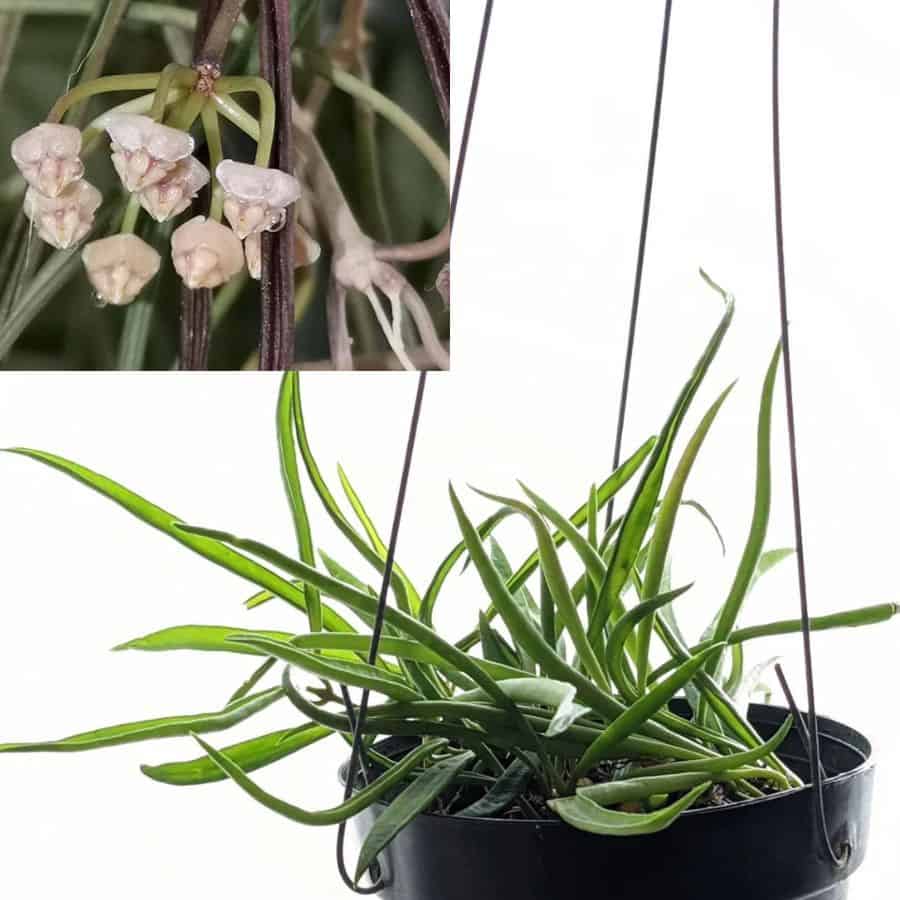
Hoya acicularis, also known as the porcupine hoya, is a species of flowering plant in the Apocynaceae family. It is native to Southeast Asia and is commonly found in the Philippines and Thailand. This plant is characterized by its delicate and intricate foliage, which is made up of small, slender, and needle-like leaves that are arranged in an attractive, spiral pattern. The leaves of Hoya acicularis are typically green and can grow up to 1 inch long.
In addition to its striking foliage, the plant also produces clusters of small, fragrant, and star-shaped flowers that are typically cream or pink in color. Hoya acicularis is a popular choice among plant enthusiasts due to its attractive appearance and ease of care, making it an ideal choice for those looking to add a touch of greenery to their home or office.
Hoya acuminata
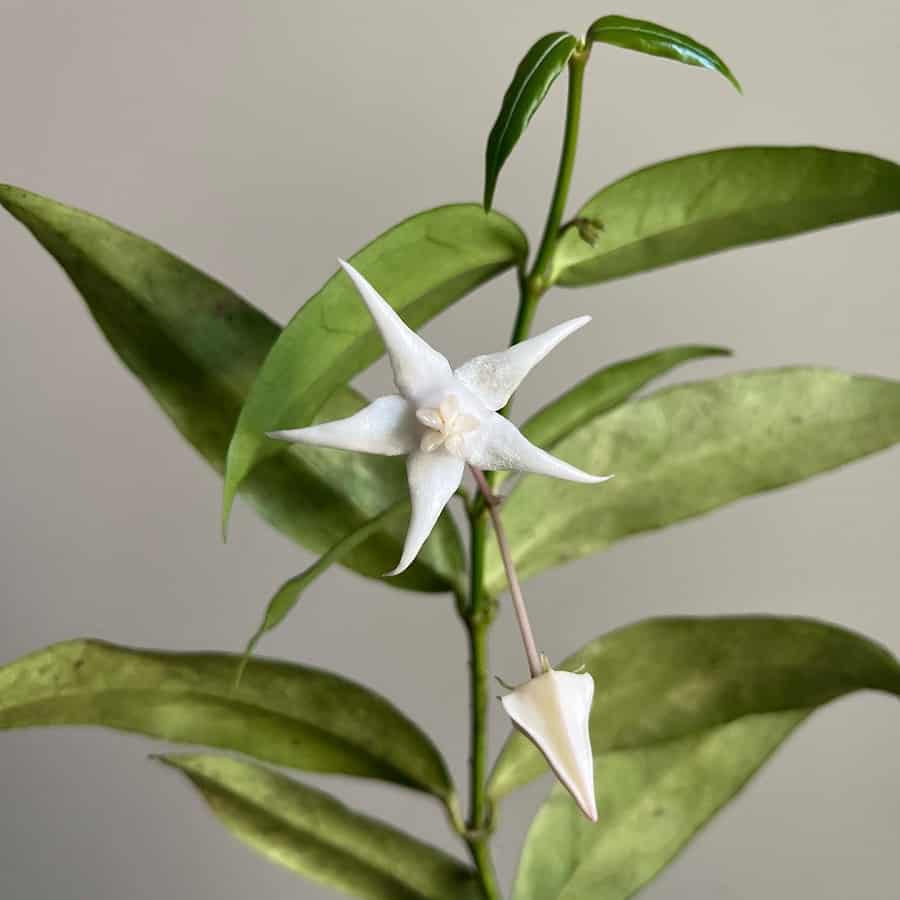
Hoya acuminata is a species of flowering plant found in Southeast Asia, including Bhutan, Sikkim, India, and northwestern Vietnam. It is an epiphyte and commonly grows on trees and mossy rocks in dense, moist forests at an altitude of 1600m. It has a strong stem and weakly rising branches, with leaves that are narrowly elliptical to elliptic-lanceolate and fleshy.
The plant produces large white flowers in the apical or axillary umbel, which have a not strong, pleasant smell and last for 5-7 days. The corolla lobes are long, narrowly triangular, and densely papillary-pubescent on the inside. Hoya acuminata is easy to care for and is a popular choice among plant enthusiasts due to its attractive appearance and fragrance.
Hoya acuta
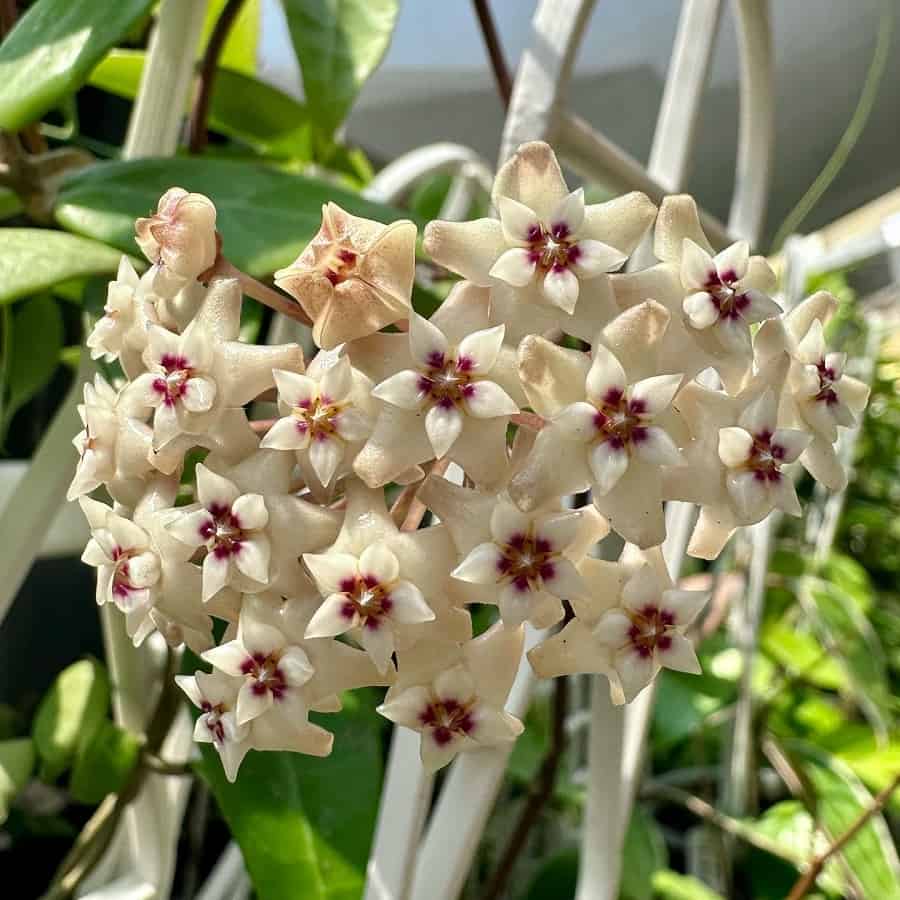
Hoya acuta is a vining epiphytic plant in the Apocynaceae family, native to Indonesia, Thailand, and Malaysia. It has attractive waxy foliage and produces sweetly scented, creamy white flowers with pink-purple centers. The flowers are star-shaped and produced in clusters, giving them a waxy appearance, and are covered in tiny hairs for a fuzzy look.
The plant flowers from spring to late summer and produces umbels of 10 to 40 flowers that mature gradually over 2 to 3 weeks on the same peduncle. The scent of the flowers is strongest in the early evening. Hoya acuta is easy to care for and its flowers are produced from spurs, which should not be damaged or removed, as they will continue to produce new flowers each season. H. acuta has highly glossy, intensely green leaves, making it an attractive addition to any collection.
Hoya acuta EPC 997
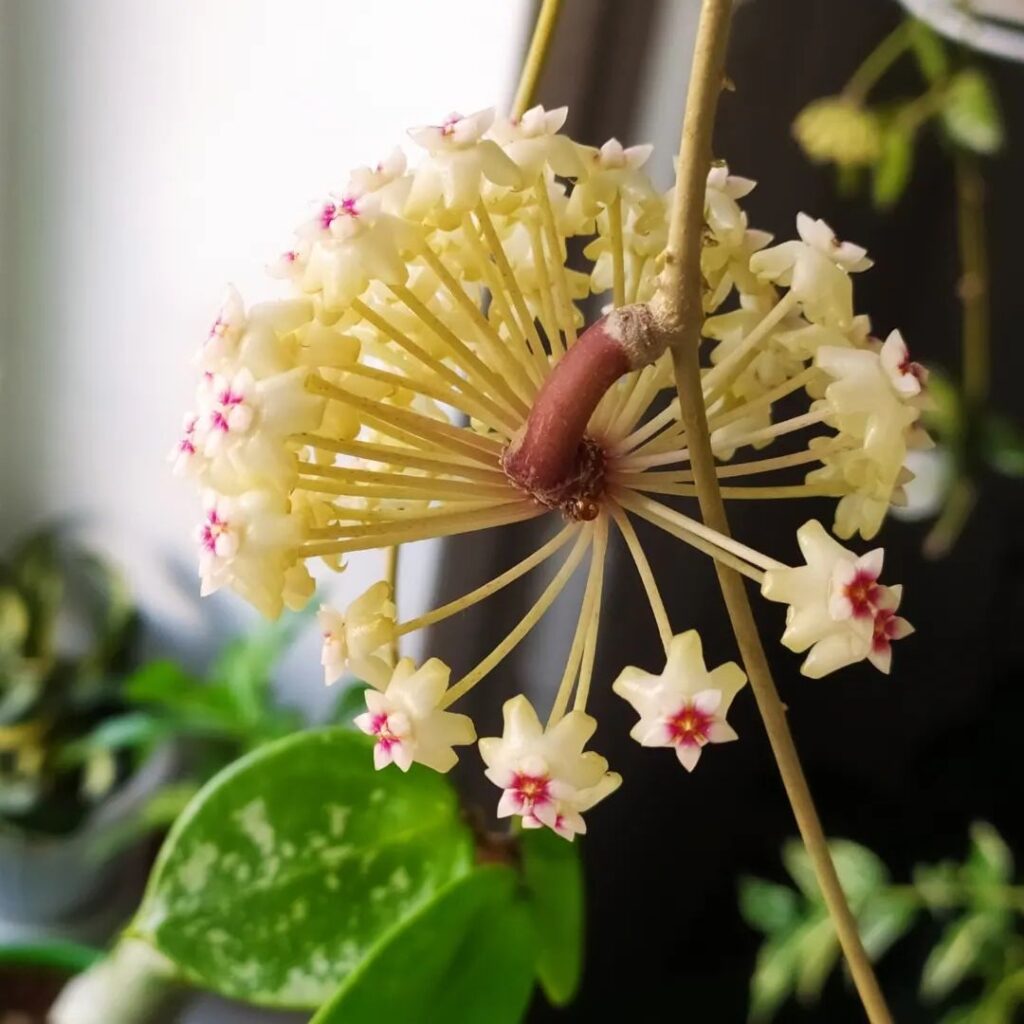
Hoya acuta EPC-997 (stable pink spot splash) features a unique splash pattern that appears pink under stronger light and turns silvery as the leaves mature. This characteristic makes it a visually striking addition to any plant collection.
Hoya aeschynanthoides
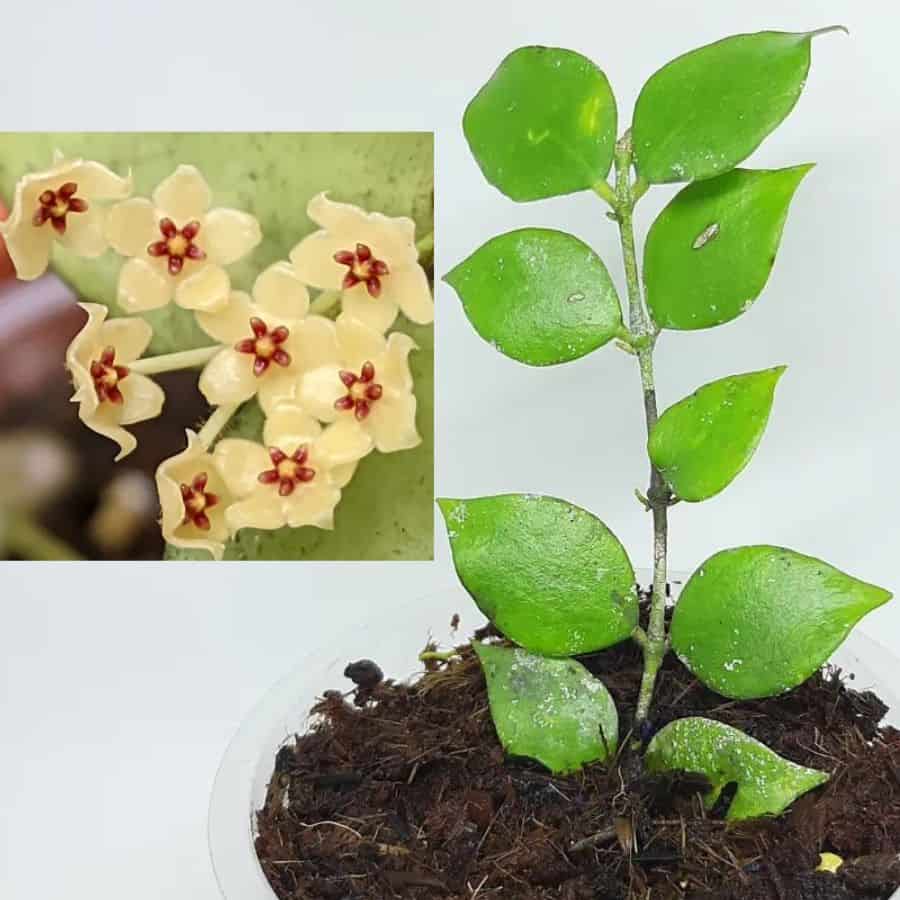
Hoya aeschynanthoides is an epiphyte plant that grows hanging or sprawling on tree branches. It has a dense foliage of leaves that are broadly ovate-elliptic in shape and have a felt-like texture on both sides. The pedicels, or flower stems, are covered in short stiff hairs and the corolla, or flower, has oval-triangular lobes with hairy margins on the inside and a curved shape.
Hoya affinis
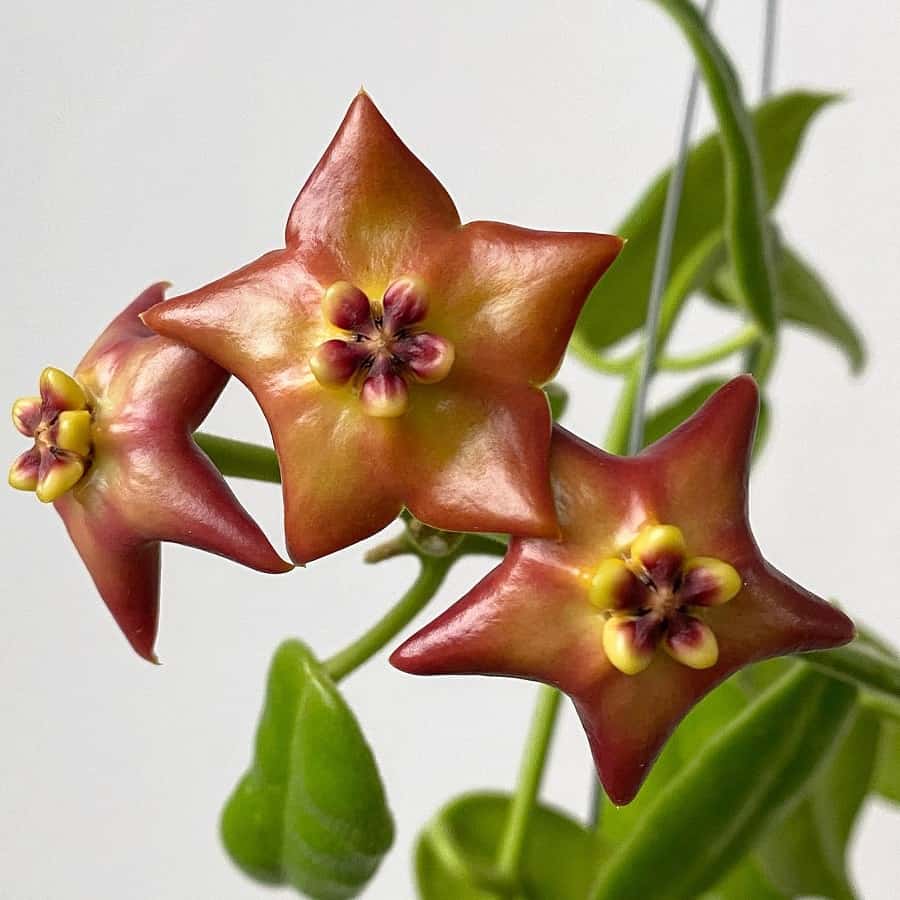
Hoya affinis is a plant native to the Solomon Islands that is known for its stunning and intense red flowers. The flowers grow in clusters and each cluster has about 10-12 blooms that shine brightly in the light. The plant is a vigorous grower and needs to be trained on a stake or trellis or wrapped around a basket for about 4-5 feet before it starts blooming. The flowers are waxy and shiny with a heavy texture, making them truly captivating to look at.
Hoya AH 074

Hoya AH 074 is a striking plant with large, deep green leaves adorned with splashes of silver variegation. Its vibrant pink, star-shaped flowers appear in spherical clusters, adding a touch of brilliance to its foliage.
Hoya alagensis

Hoya alagensis is a plant that has vines that are curly, smooth, and slightly fleshy, growing up to 6 meters long or more. Its leaves are oval-lanceolate, thin, with a rounded base and a sharp, hooked tip. They are 11 cm long and 4.5-5 cm wide, and both surfaces are smooth. The central vein is clearly visible from the underside of the leaf and is surrounded by 4-6 pairs of secondary veins that depart from it on both sides and smaller veins that create a mesh pattern. The flowers of Hoya alagensis are purplish and odorless, with corolla lobes that are broadly oval and have a sharp tip.
Hoya albiflora
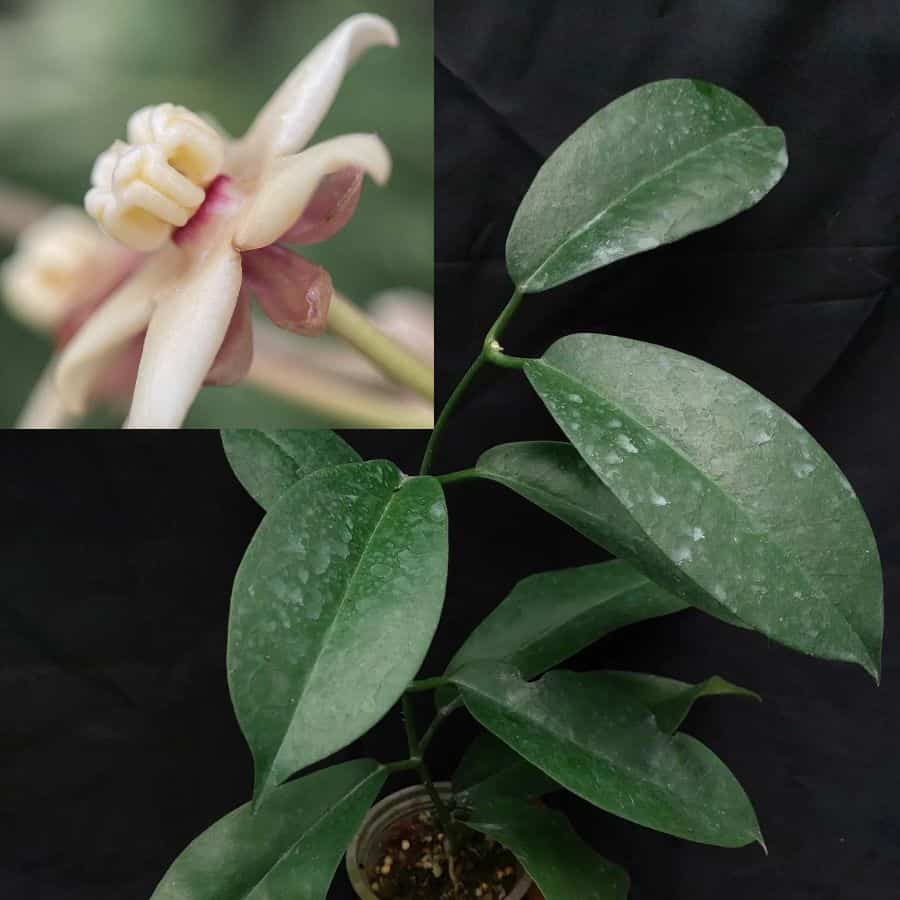
Hoya albiflora is a plant that grows in the rocky forests of East and New Guinea. It’s a climbing epiphyte with stems that are cylindrical, smooth, and a bit thicker at the nodes. The leaves are long and pointed with a fleshy texture and the main vein is more pronounced from the bottom. The flowers have a short stem and grow on a geotropic umbel. The flowers have a slightly pubescent calyx and corolla, and the corolla has a bell shape, is white with a reddish outside, and has a toothed pale crown with a spongy-fleshy consistency.
Hoya aldrichii
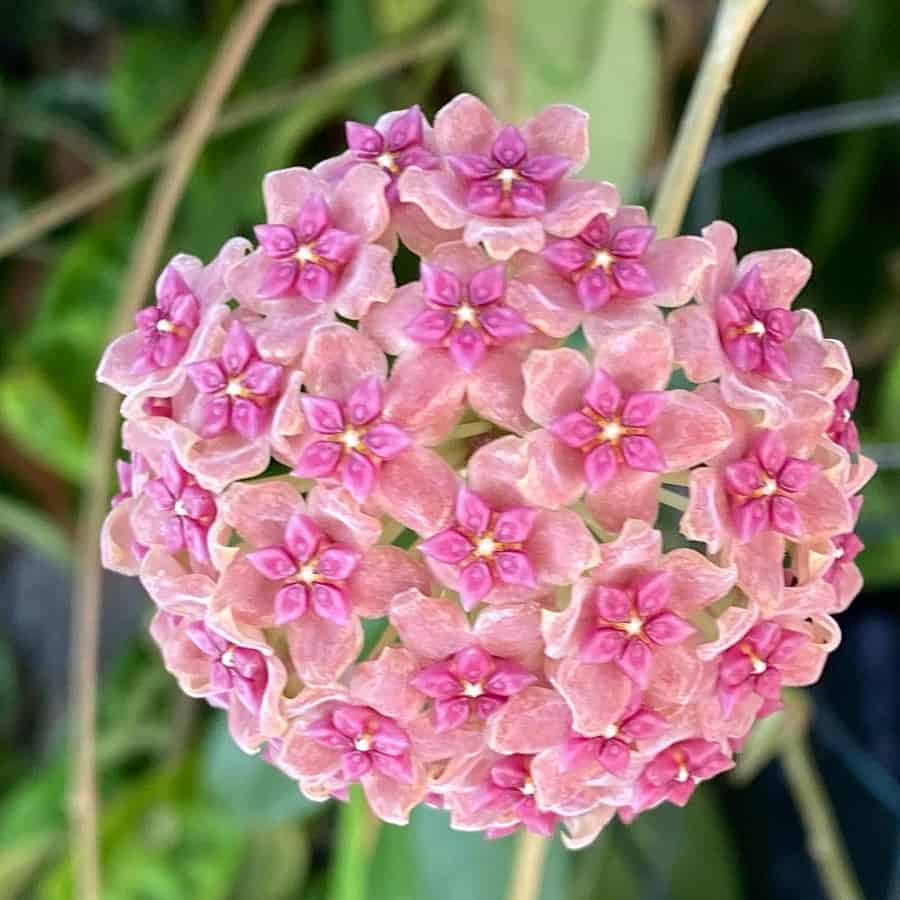
Hoya aldrichii is an epiphytic climbing plant found on the coastal terraces of Christmas Island, Australia. It has glossy leaves that are 8-12 cm long and 4-6 cm wide, with visible veins and no spots. The plant produces light pink flowers with bent-back corolla lobes and a dark pink crown. It has a mild fragrance at night and takes time to mature before flowering regularly.
Hoya alexicaca
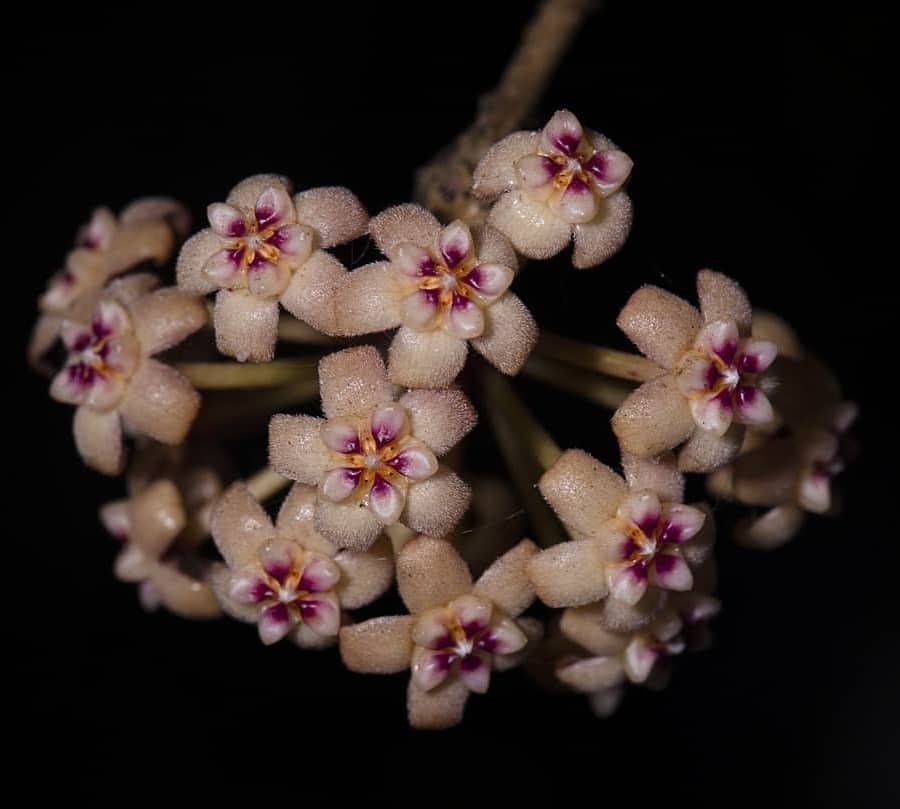
Hoya amoena
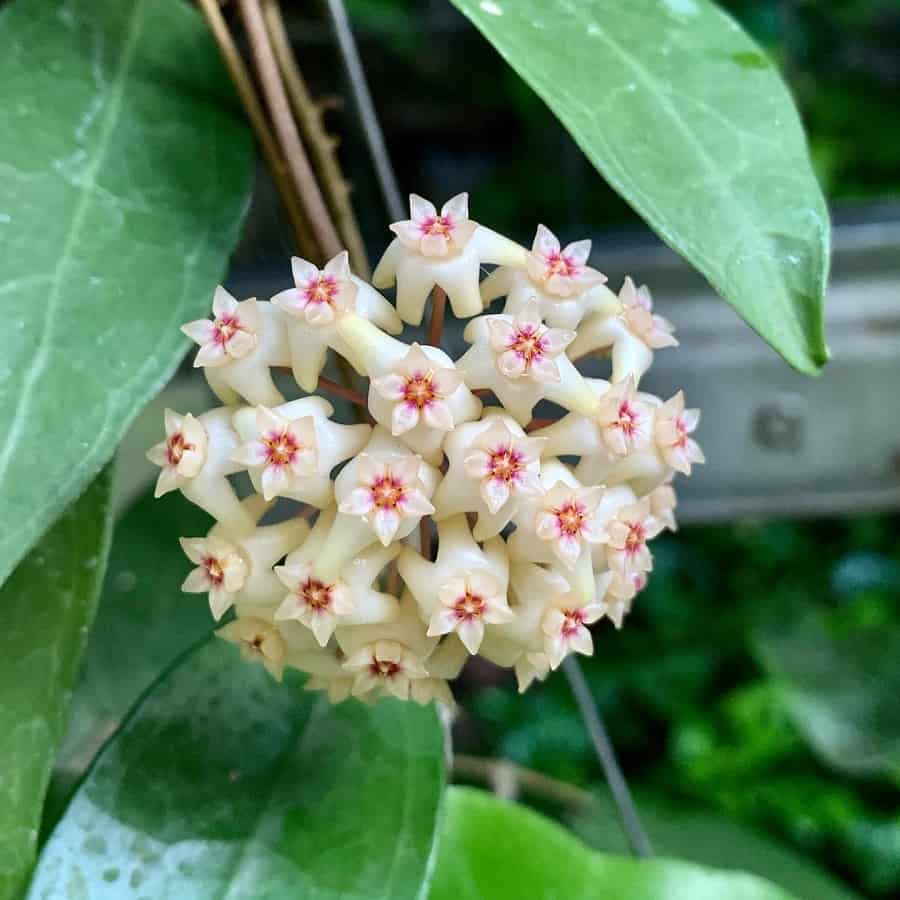
Hoya amoena is a climbing plant known for its distinctive foliage, which is dark green in color with pronounced veins and scattered silver speckling. The leaves are long and narrow, with a length of 8-15 cm and a width of 2-5 cm. The flowers are light pink in color and are said to be similar in appearance to those of Hoya verticillata. There is some confusion about the exact identity of Hoya amoena, as some sources suggest it may be a variety of Hoya sp. Bogor or Hoya verticillata.
Hoya amrita
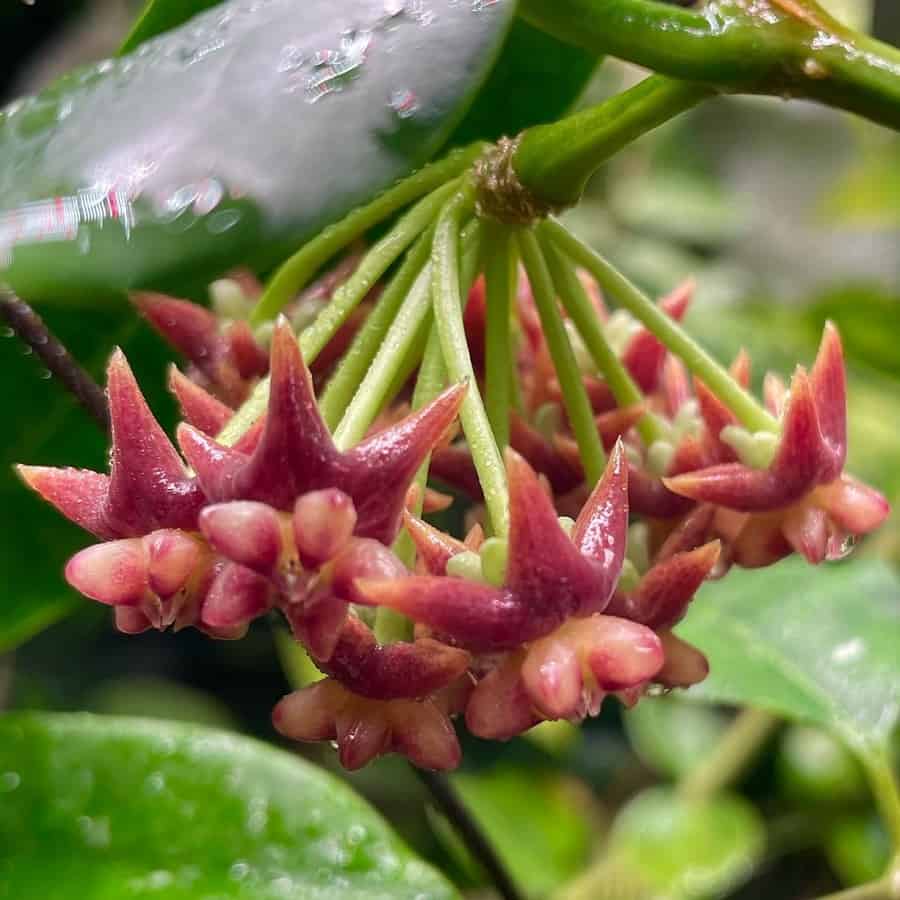
Hoya andalensis

Hoya andalensis is a climbing plant found in Sumatra, Indonesia. It has oval-shaped leaves that are 5 cm long and 2-3 cm wide with short hairs along the central vein. The leaves are bright green with a pale green underside and slightly bent inward edges. It produces 18-20 flowers in a flower umbel with a diameter of 4mm, with yellow-pink corolla lobes that are pubescent and turned back with a more pink central part and yellow edges. The crown is also yellow-pink but a more saturated shade. Some experts consider it to be a synonym for Hoya incurvula, which grows in Sulawesi.
Hoya angustifolia
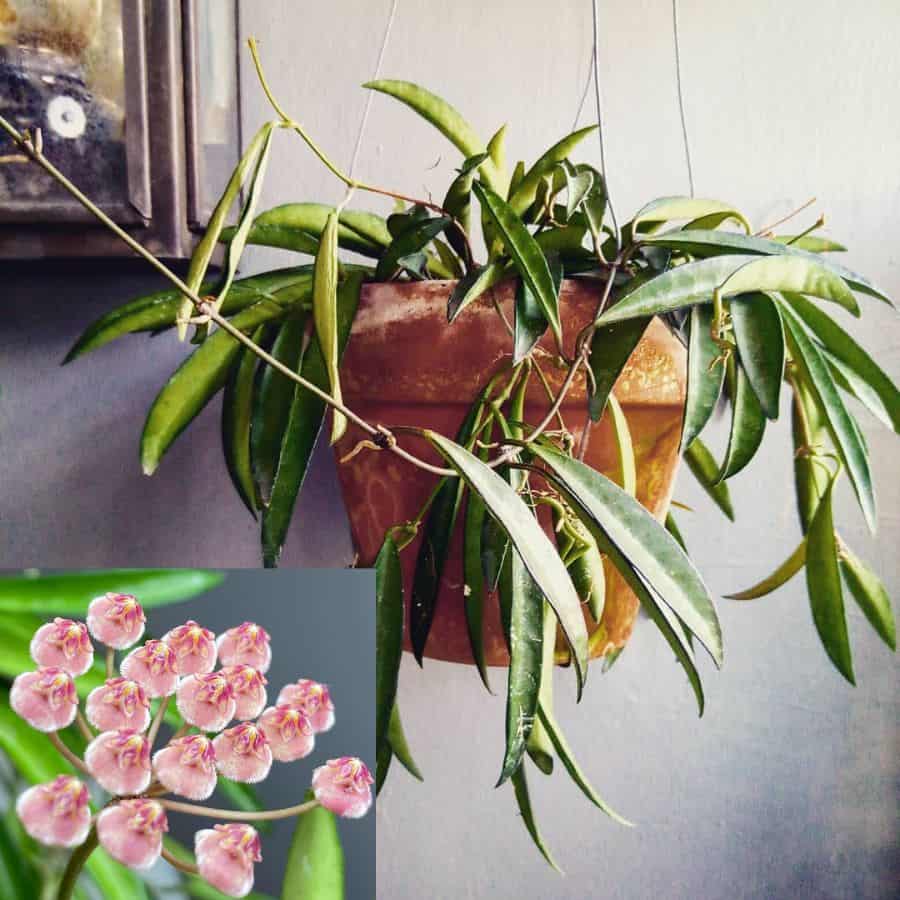
Hoya angustifolia is a type of Hoya plant that has narrow, cup-shaped leaves and stems that trail downward. It produces many red flowers in a cluster (umbel). The leaves are small in size.
Hoya anncajanoae
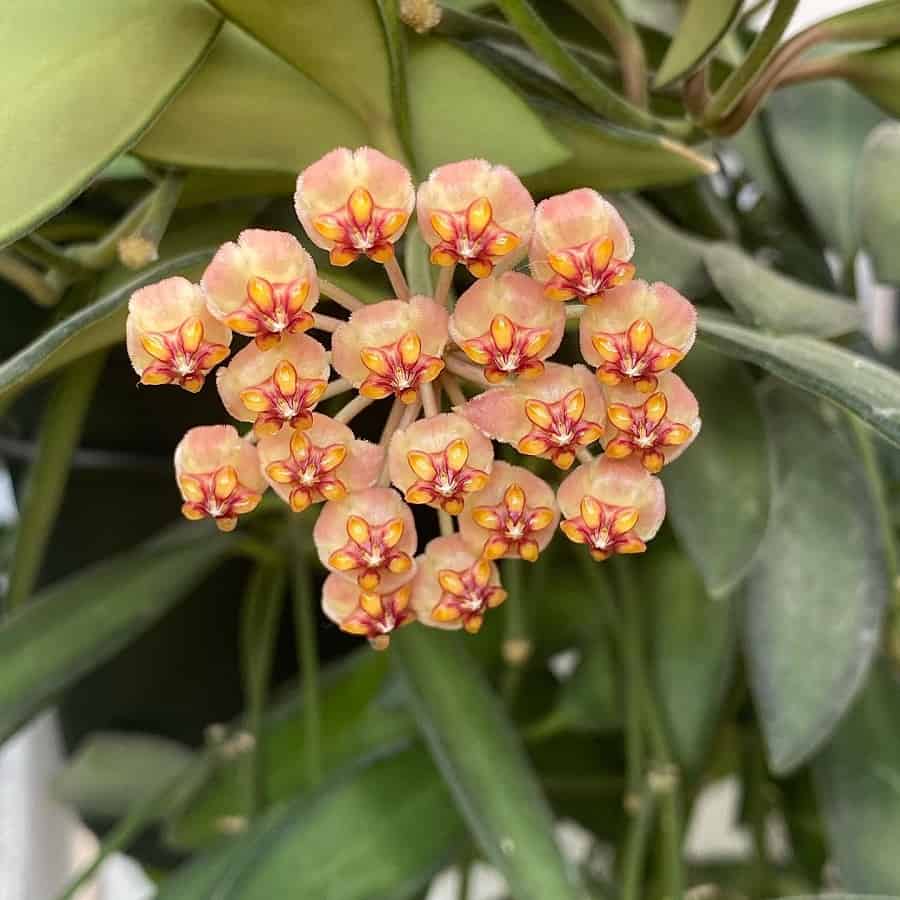
Hoya anncajanoae is a species of hoya native to the Philippines. It was named after Mary Ann Cajano, who was an assistant curator at a museum in the Philippines. The flowers of Hoya anncajanoae are slightly larger than those of other related species and are around 1.70 cm in size. The leaves are oval-shaped, thick, and fleshy, with a pointed tip. The young leaves are more hairy compared to mature leaves. The rest of the plant, including the pedicels and calyx, are covered in hairs.
Hoya anulata
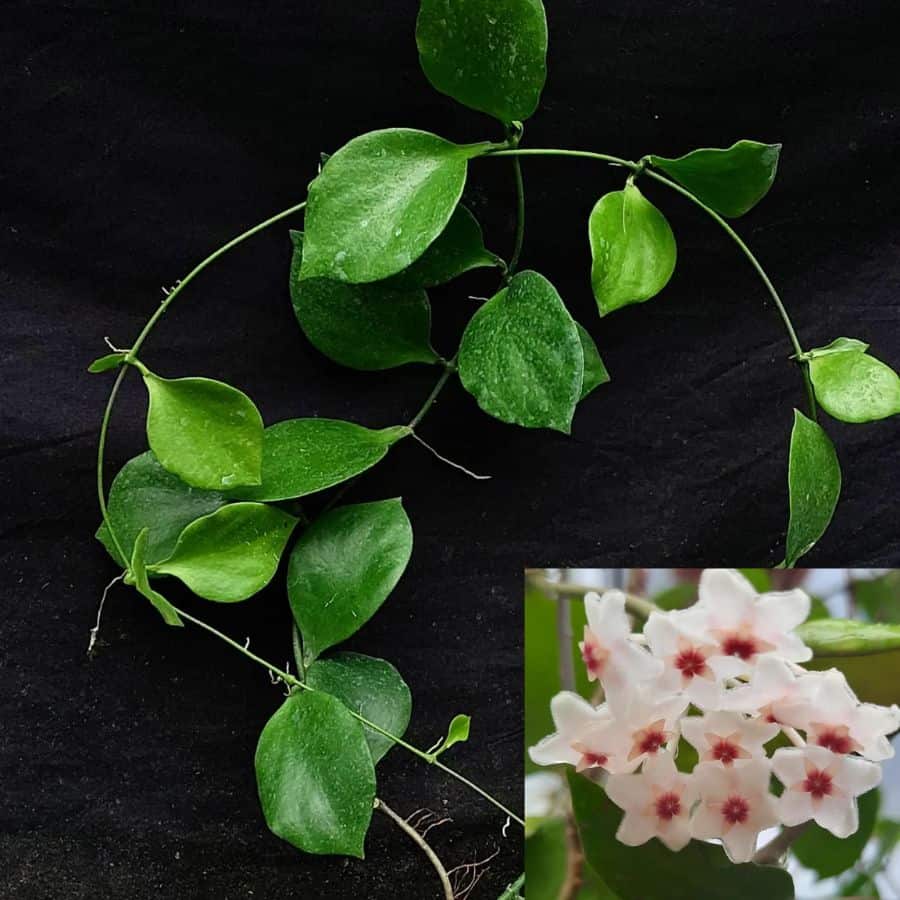
Hoya anulata is a plant that is native to Australia, Indonesia, and Papua New Guinea. It was first discovered in bloom by Schlechter in 1902 in the Nuru River area in Papua New Guinea and later found in other areas. It is a weak climber but has smooth shoots. The leaves are oval, fleshy, glossy, and light green, with a heart-shaped or rounded base and slightly inward-bent edges.
Direct sunlight can turn the leaves red. The plant produces 10-15 flowers with a diameter of 1.5 cm, which is pale pink to almost white in color, with a pink or almost red crown. The flowers have a coconut aroma and produce a lot of nectar but do not bloom frequently or abundantly.
Hoya apoda
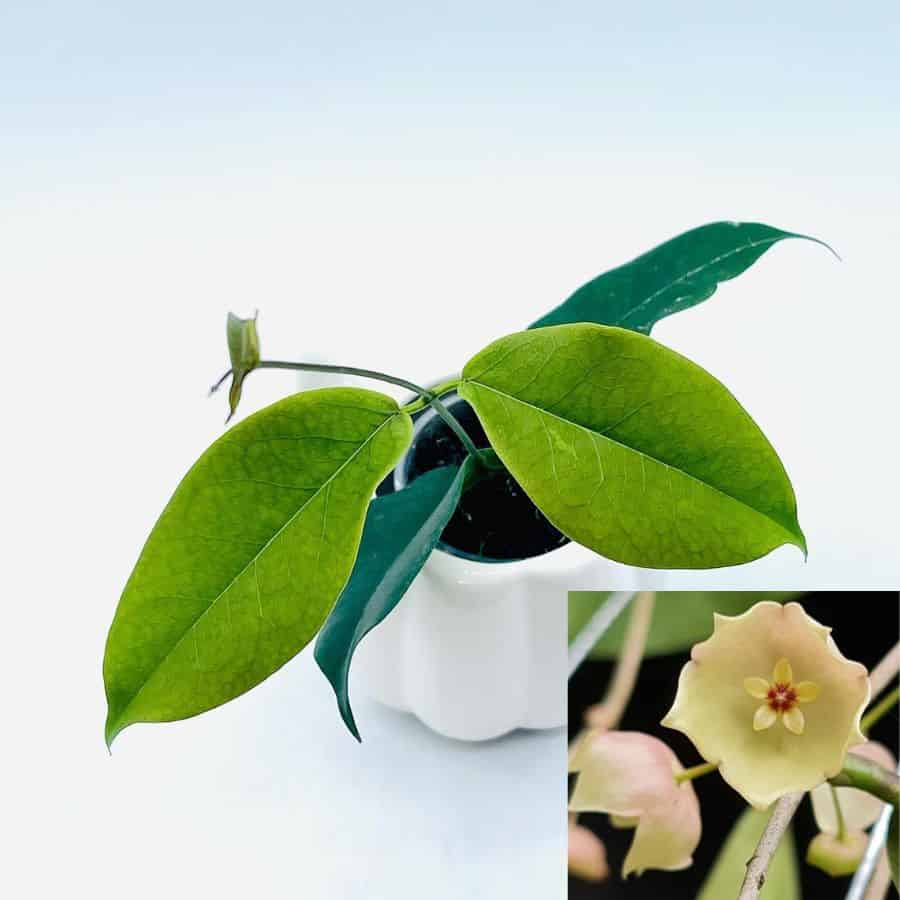
Hoya apoda is a plant that originates from Papua New Guinea. It is a shrub or semi-shrub with thin branches that can produce long, thin roots. The leaves of this plant are ovate-oblong in shape, thin-skinned, smooth and glossy, with a pointed top and obtuse base.
The flowers of Hoya apoda are solitary, bell-shaped, about 1 cm in diameter, yellowish-white with a reddish outer side and a dull purple center of the crown. The flowers are similar to those of Hoya mappigera or Hoya patella and fall off after flowering. This plant is related to Hoya papuana Schlechter, which has a different leaf shape, flowers with a larger calyx, a larger pink-red corolla, and a slightly different crown.
Hoya apoensis
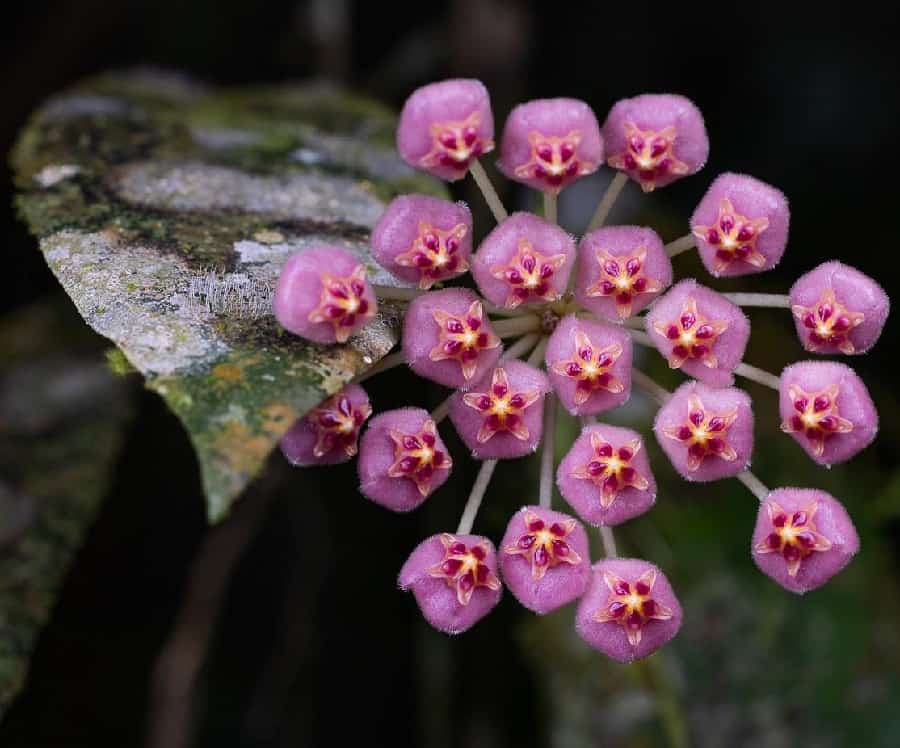
Hoya archboldiana
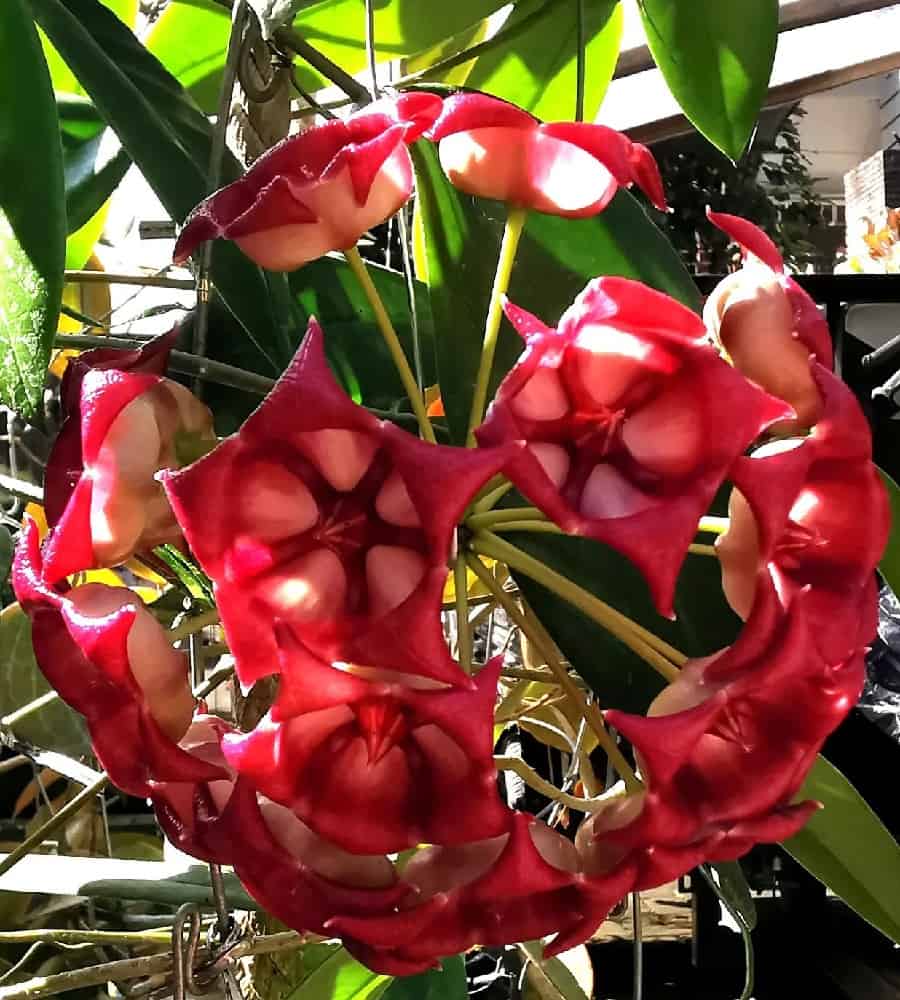
Hoya archboldiana is a plant that is commonly found in the humid jungles of the plains of New Guinea and the Indonesian island of Aru. It is a medium-sized plant with curly, smooth leaves that are dark green, large, and glossy. It takes 2-3 years for the plant to produce flowers, which come in the form of loose umbels of 10-20 bell-shaped flowers. The color of the flowers can vary from red to pale pink and have a strong, musky aroma in the evening. The plant prefers to grow in eastern and western positions and high temperatures and blooms in the summer.
Hoya ariadna
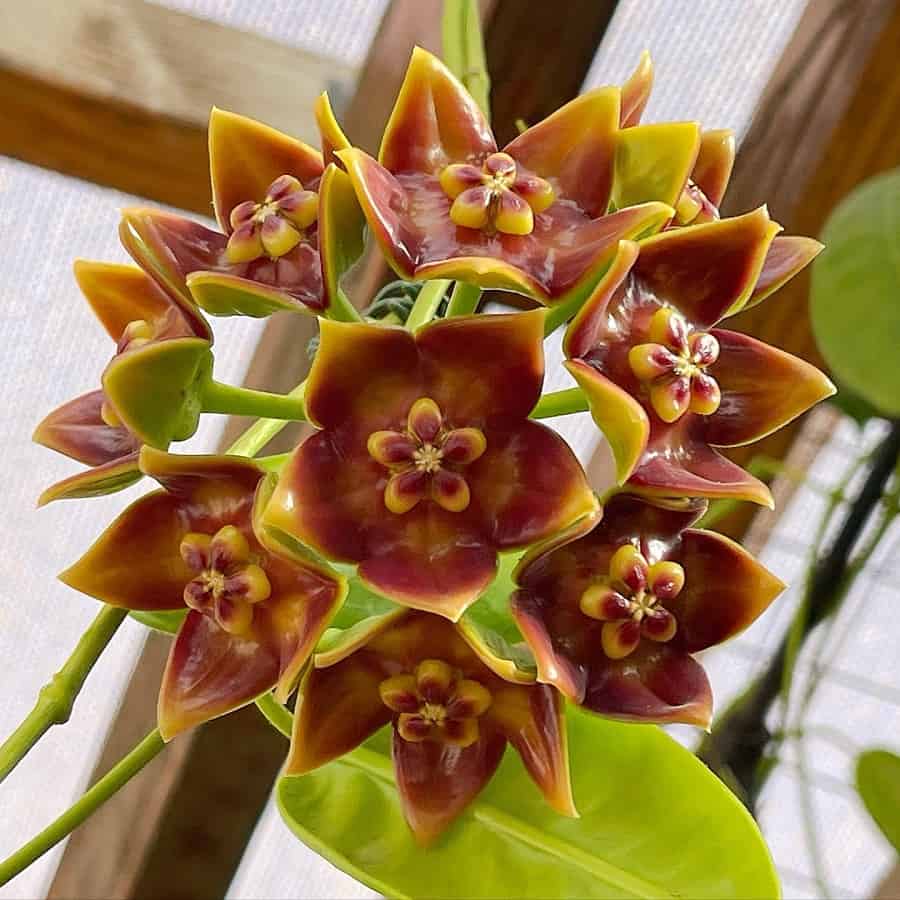
Hoya ariadna is a fast-growing plant with thick, green leaves that have a sunken central vein. The leaves are 10cm x 6cm in size. The plant produces stunning, waxy, cup-shaped flowers that are 50mm across and come in shades of orange/gold. The flowers have an orange center and gold corona and are arranged in umbels, with up to 5 flowers per umbel. The flowers have a fabulous musky fragrance. The plant produces clusters of 3 to 8 flowers, 4 to 5cm in size, during the warmer months, but they are not easily flowered.
Hoya arnottiana

Hoya arnottiana is a sub-tropical vining plant that is native to the Himalayan regions. It produces pale white or pale yellow flowers in clusters, each with an orange calyx. The plant has large, dark green, waxy leaves with a prominent vein. It can be grown on a pole or trellis or in a hanging pot, and is relatively easy to care for. The plant is known for its air-purifying abilities.
Hoya aurantiaca
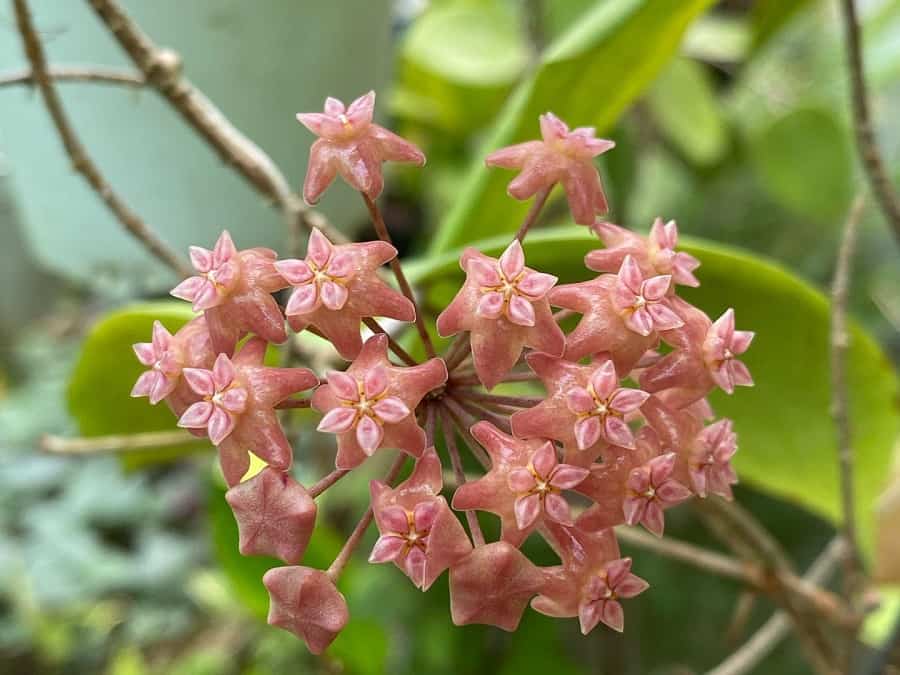
Hoya australis ssp australis

Hoya australis ssp australis is a plant that is highly variable and can have either smooth or hairy leaves. The plant produces a loose umbel of flowers that can be small or large in size. Most specimens in cultivation are believed to be this subspecies. The plant also has different leaf shapes. The flowers of Hoya australis ssp australis open from March to May in Australia, which is autumn in the northern hemisphere.
Hoya australis ssp lisa
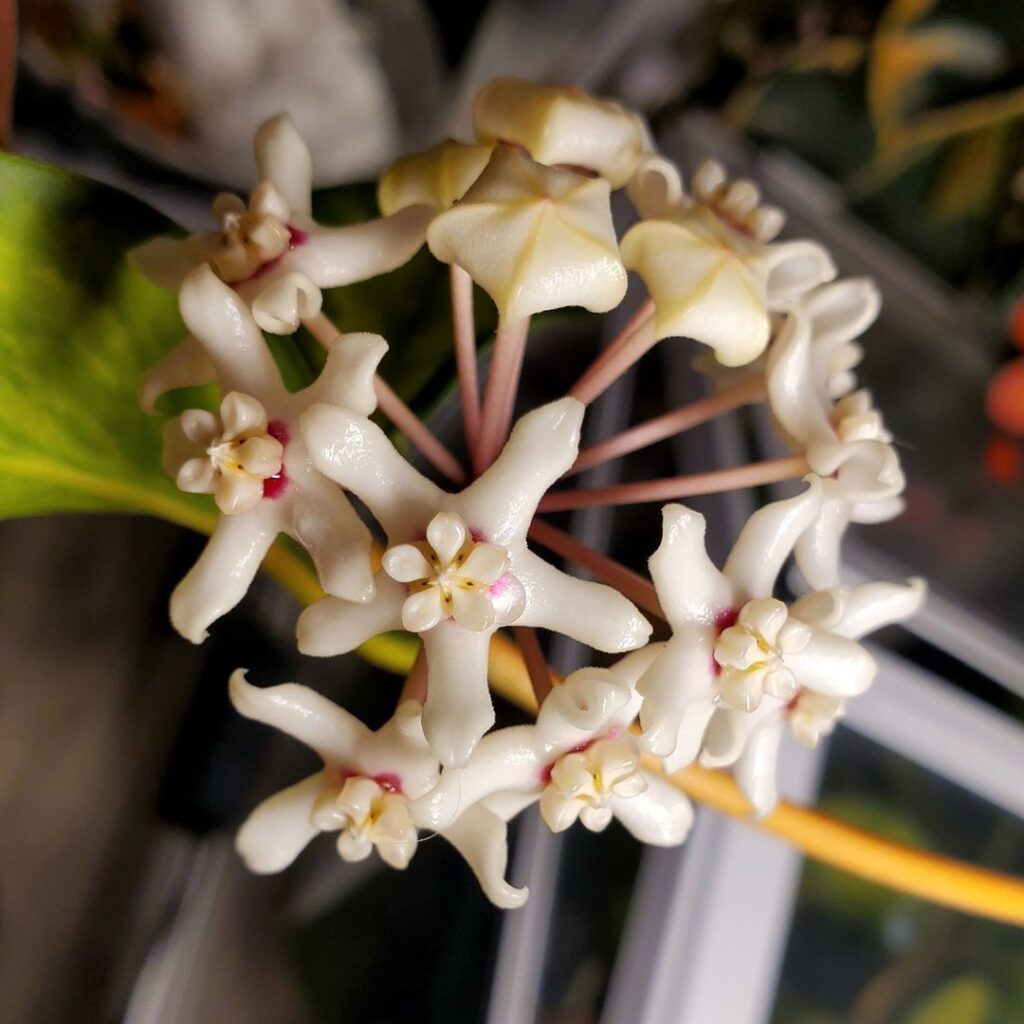
Hoya australis ‘Lisa’, also known as the variegated wax plant, is a stunning variety renowned for its heart-shaped leaves with green and creamy white or yellow edges, creating a glossy, waxy appearance. This low-maintenance plant, ideal for both indoor and outdoor settings, produces fragrant, star-shaped flowers typically white with a pink or red center. Originating from the northeast coast of Australia, it can grow up to 10 feet outdoors but usually reaches about 3 feet indoors. The plant’s spectacular colors, including dark green, lime green, creamy yellow, ruby red, and soft peach, along with its easy care and trailing growth habit, make it a prized addition to any collection.hoya macrophylla
Hoya australis ssp sana
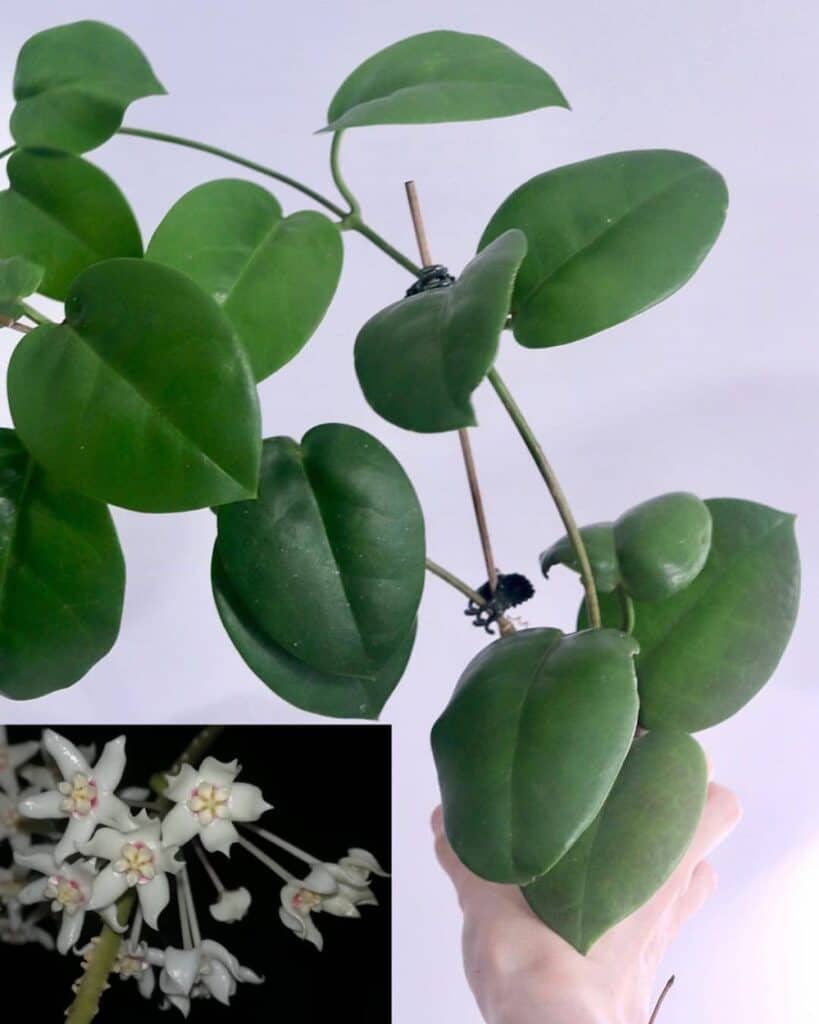
Hoya australis ssp sana is a xerophyte, which means that it is a plant that can survive in dry conditions. It is larger than the other two subspecies of Hoya australis and has adaptations that help it conserve water, such as a reduction in the permeability of its leaves and roots, and the ability to store moisture in its swollen tissue. The plant has small leaves with curved edges and blooms from May to July in Australia. It grows in sandy coastal areas.
Hoya australis ssp tenuipes
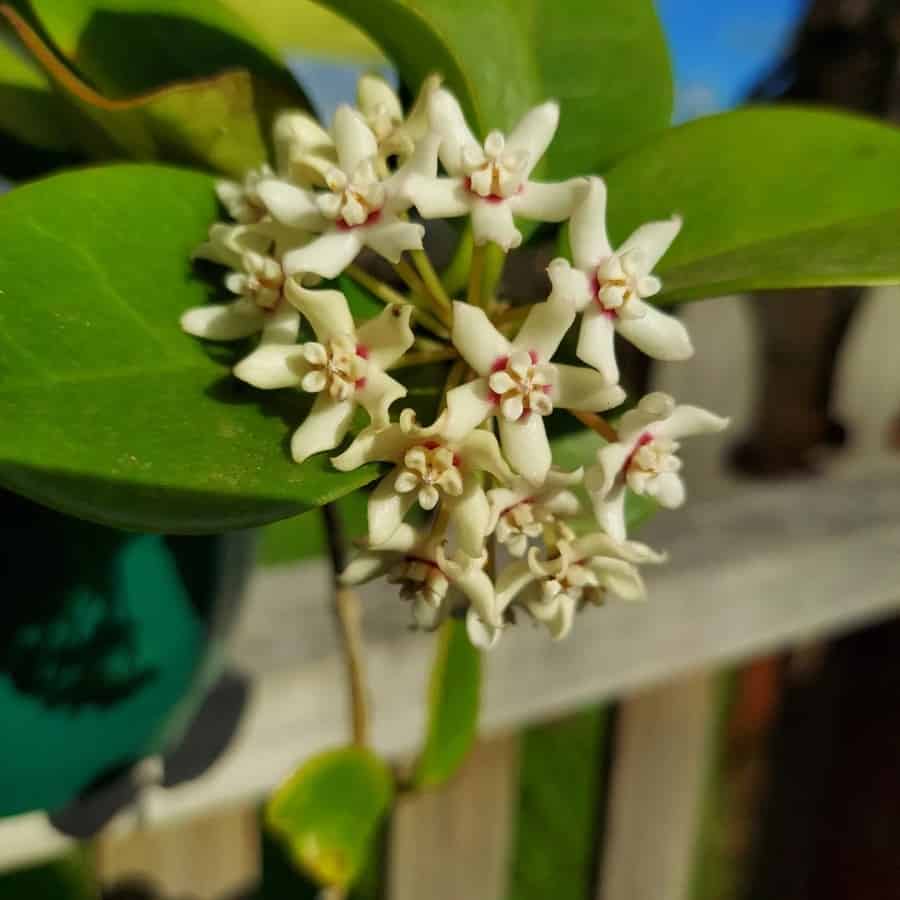
Hoya australis ssp tenuipes is a subspecies of Hoya australis that is native to a wetter area than other subspecies. It has smooth leaves and umbels (clusters of flowers) that are loose and contain star-shaped, pure white flowers that are smaller than those of the other subspecies. It blooms in Australia from September to October, which is spring in the northern hemisphere.
Hoya balaensis
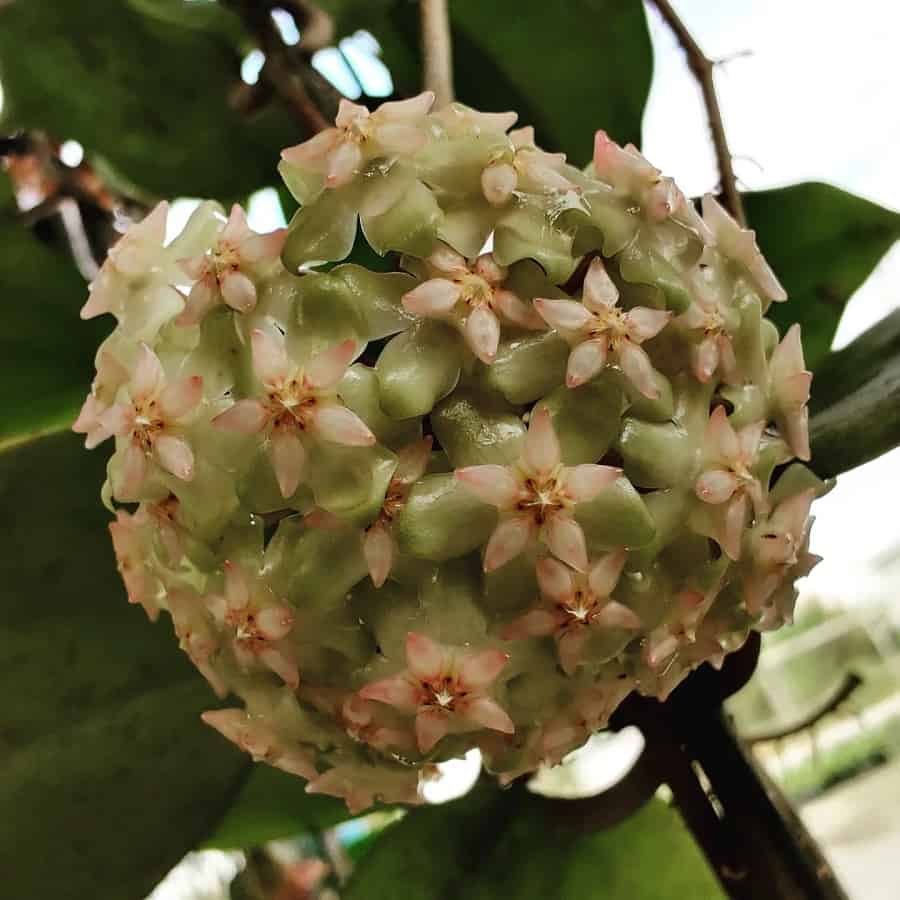
Hoya benguetensis
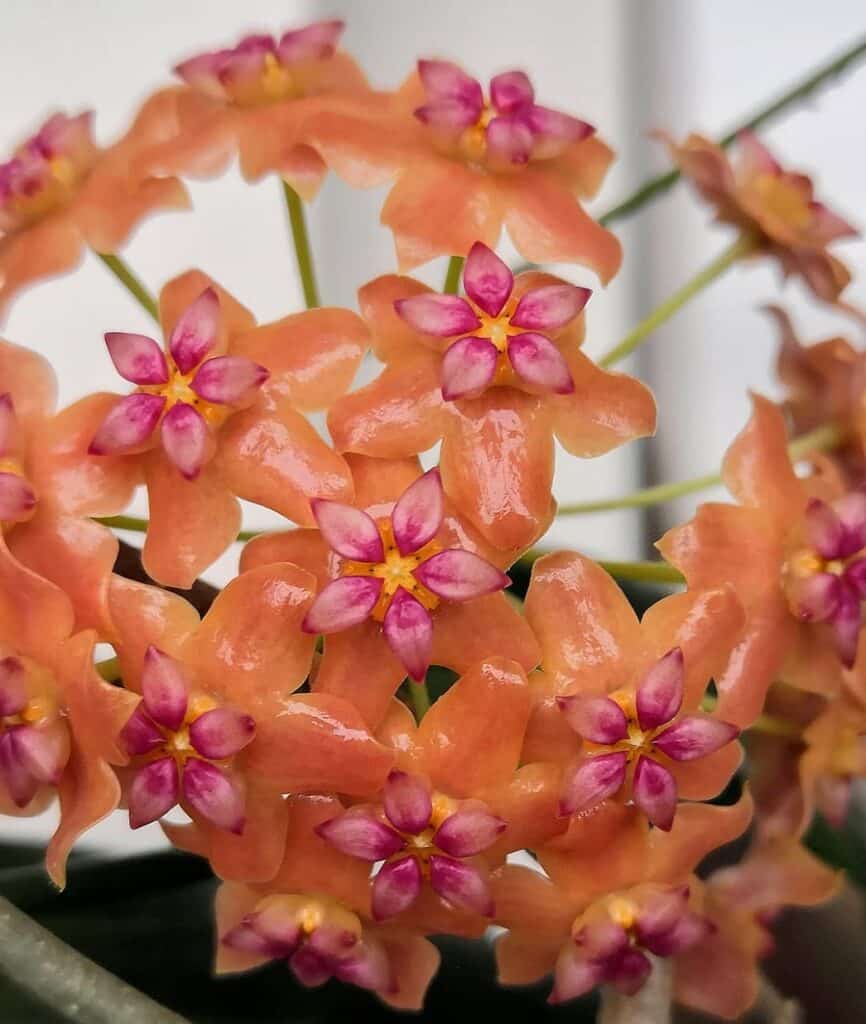
Hoya benguetensis is a type of plant that grows by attaching itself to other plants. It has flexible branches and smooth leaves that are 6-10 cm long and 2.5-4 cm wide. The flowers of Hoya benguetensis have a smooth, powdery appearance and are about 1 cm in diameter with wide-oval, sharp corolla lobes. The flowers are reddish in color and different from those of Hoya camphorifolia. The leaves of Hoya benguetensis are similar in structure to those of Hoya camphorifolia.
Hoya benitotanii

Hoya benitotanii is a type of plant native to the Philippines. It is named after Dr. Benito C. Tan and was collected from Matutinao, Badian, Cebu. The plant has thick, bare vines and requires support in culture. The leaves are light green, glossy, and 7-14 cm long and 3-5 cm wide, with light green veins. The new leaves have a slight rusty red tint, turning green with age.
The flowers of Hoya benitotanii are light yellow and up to 20 individual flowers are open in a flower umbel, which is about 8 mm in diameter. The corolla of the flowers is light yellow with blades that are strongly turned back, forming almost a ball. Hoya benitotanii was previously sold as Hoya gigantangensis but was later found not to fit the scientific description.
Hoya benvergarae
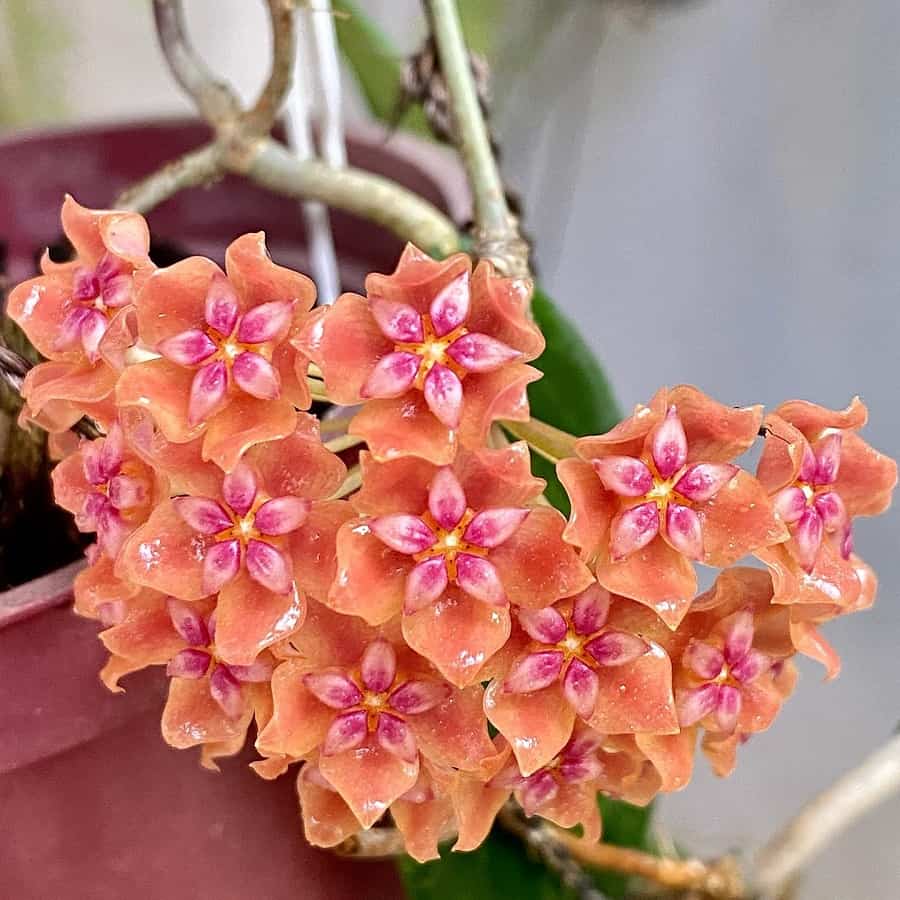
Hoya benvergarai is a type of plant named after Dr. Benito Vergara, a plant physiologist who worked at the International Rice Research Institute in the Philippines. The plant is a climbing liana with waxy, oval-lanceolate leaves that have 5 visible veins and are 9-13 cm long and 2-3 cm wide at their widest point. The leaves are spaced 4-8 cm apart with aerial roots growing randomly. The flowers of Hoya benvergarai are similar to those of Hoya benguetensis Schlechter, but with a loose flower umbel that opens 9-12 flowers. The corolla lobes of the flowers are pale yellow and bent back, and the crown is pale pink.
Hoya bhutanica
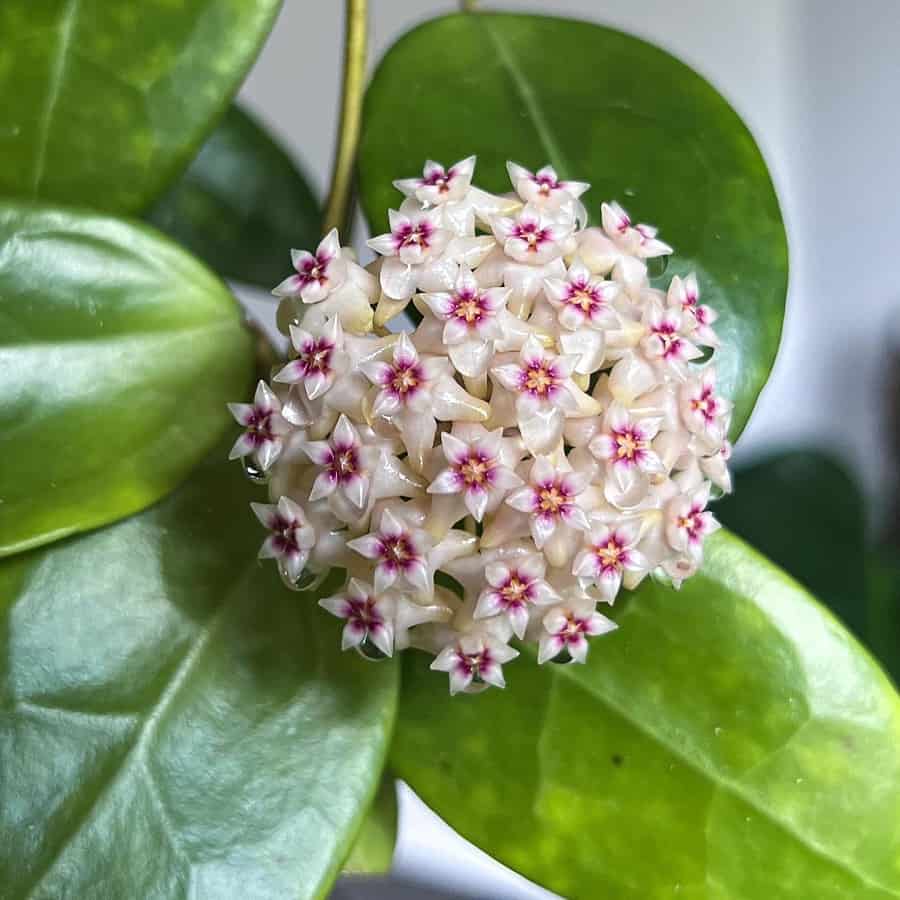
Hoya bhutanica is a type of plant that comes from Bhutan. It is an epiphyte with curly vines. The leaves of Hoya bhutanica are oval, thick, smooth, light green, and 12 cm long and 5 cm wide. The veins are lighter green and raised slightly above the leaf surface. The flowers of Hoya bhutanica open in a flower umbel with 25 flowers, each with a diameter of 1.4 cm. The corolla of the flower is light green and bent back, and the crown is milky white with a pink spot in the middle. There is almost no nectar produced. Hoya bhutanica is easy to grow and can tolerate short periods of drought.
Hoya bicknellii
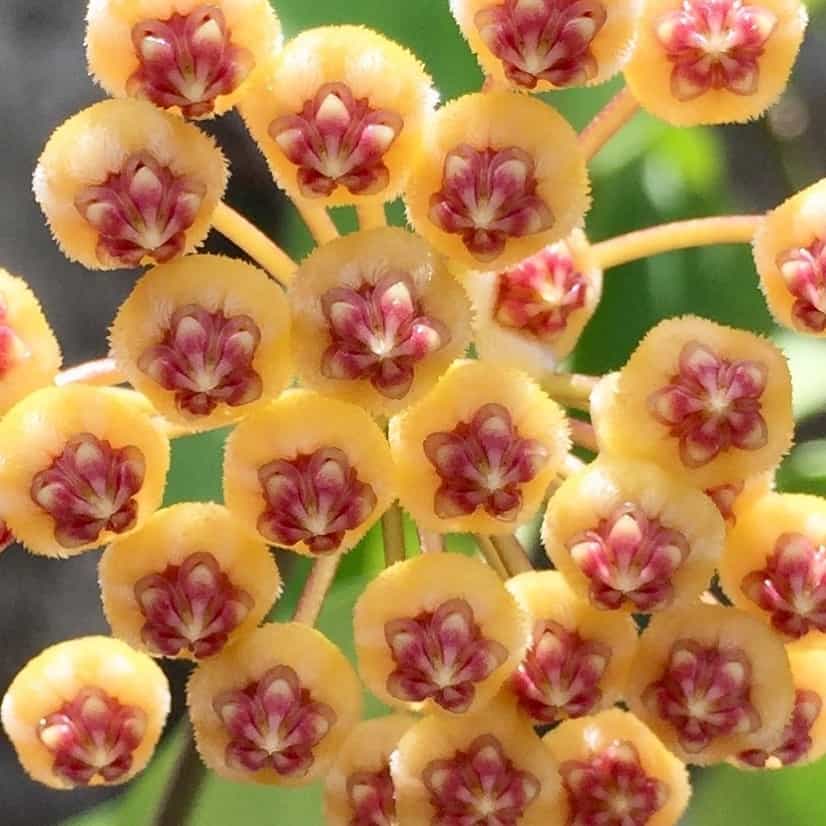
Hoya bicknellii is a plant native to the Philippines, named after collector David Bicknell. It is a climbing plant that requires support and has thick, hairless, and non-curly vines. The leaves are broad and elliptical, light green, glossy, and 8-14 cm long and 5-8 cm wide. The veins are slightly raised and young leaves have a rusty red tint that turns green over time. In the bright sun, the leaves can have a purple pattern. The plant produces 15-20 yellow corolla lobes that form a ball-like shape and have a pink-red crown, with a spicy aroma but little nectar.
Hoya bicolor

Hoya bicolor is a plant species that was first described in 2002. It is native to the Philippines and looks very similar to another species called Hoya incrassata. Growing Hoya bicolor is relatively easy, and it produces many clusters of flowers each season.
Hoya bilobata
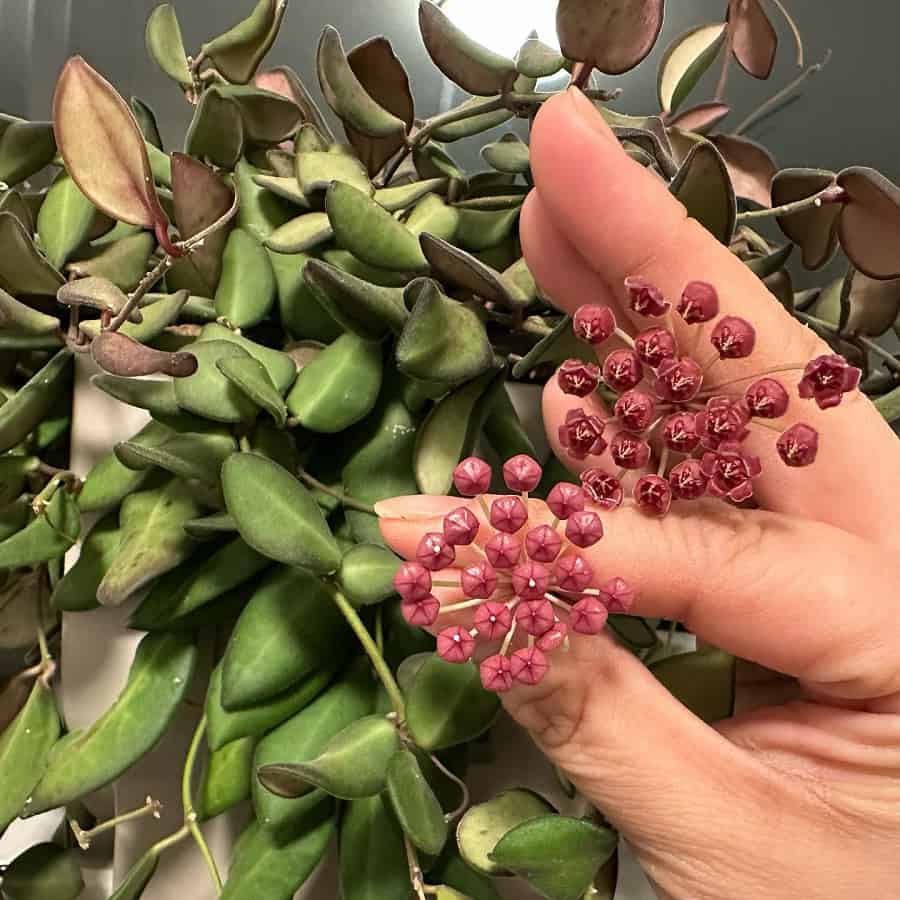
Hoya bilobata is a plant species that was discovered by a collector named Copeland on the island of Mindanao in the Philippines in March 1904. It is part of the section Acanthostemma. Hoya bilobata is a dense, leafy plant with small, round leaves that are covered in velvety hair. The leaves are dark green on the top and lighter on the bottom, and they can turn bronze-red in direct sunlight. The plant produces up to 25 small pink-red flowers in clusters, with a yellow crown and a dark red spot in the center. The flowers have a delicate, honey-like aroma.
Hoya blashernaezii
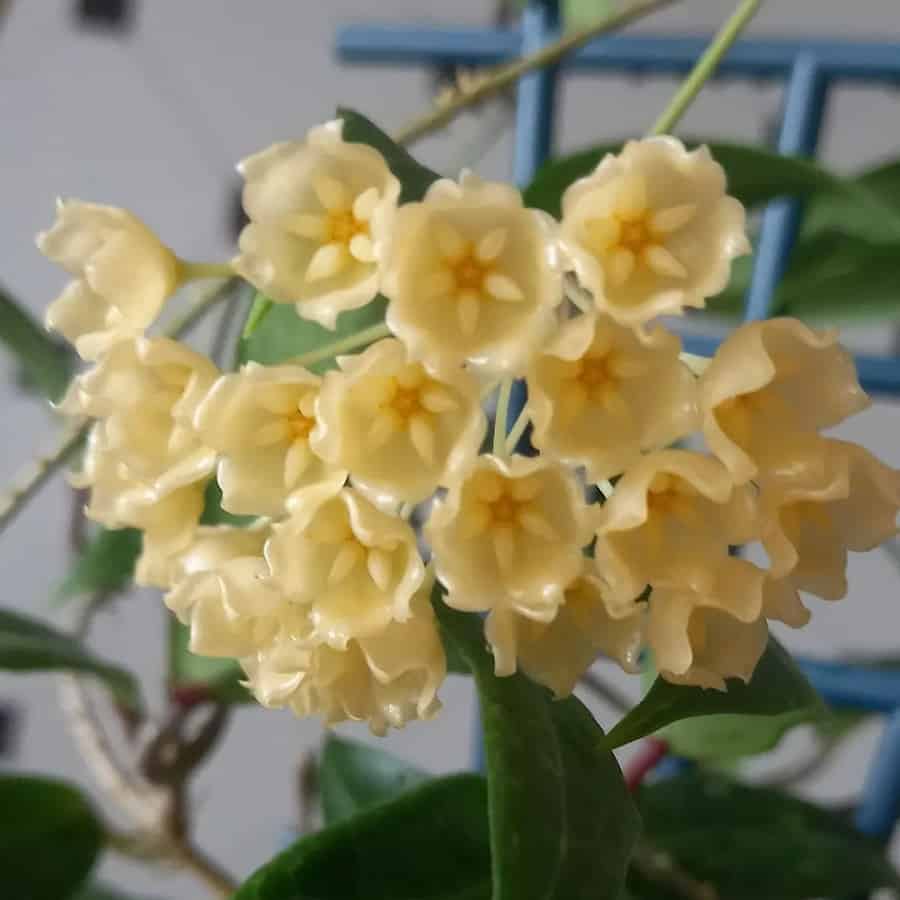
Hoya blashernaezii is a plant species that was found in Catandues, Luzon Province, Philippines and named after the Philippine botanist Blas Hernaez who discovered it. It can grow as an epiphytic liana, either climbing trees or hanging down like an ampel plant. The leaves of Hoya blashernaezii are thin, oblong-elliptical in shape with a rounded base and sharp tip. They are about 10-21 cm long and 4-5 cm wide, with a clearly visible central vein.
The pedicels, or flower stems, are thin and long, up to 12 cm, and they bear 15-30 pale yellow, translucent, bell-shaped flowers that are about 1.5 cm in diameter. The crown of the flowers is pale yellow and flowering lasts about a week, but there is no nectar or scent produced. For optimal growth and flowering, Hoya blashernaezii needs good light without direct sunlight, high humidity, and constantly moist soil.
Hoya bonii

Hoya bonii is a rare plant species that was first discovered blooming on Cat Ba Island in northern Vietnam over 100 years ago. It was described as a new species in 1912 by French botanist Costantin and was confirmed to still exist in 2016 by Vietnamese botanist Pham Van The.
Hoya bonii is an endemic species, meaning it only exists in Vietnam, and is found in a very narrow area in Cat Ba National Park. It is a climbing epiphyte with heart-shaped, thick and hard leaves that grows on limestone or clings to trees. Hoya bonii blooms in May with white star-shaped flowers with a pink center and belongs to the section Hoya carnosa. The researchers have suggested that the park administration take measures to protect this rare species from extinction.
Hoya bordenii

Hoya brevialata
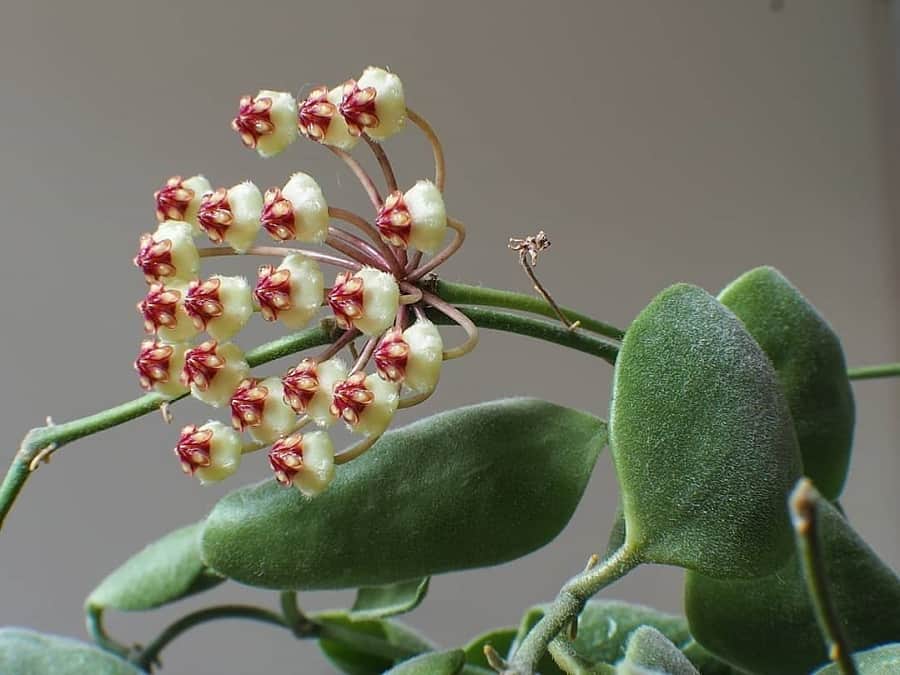
Hoya brevialata is a species of epiphyte native to Sulawesi. It is easy to cultivate, but takes several years to bloom. The leaves are round or oval, light green, and slightly pubescent. 20-30 flowers, which are whitish-beige in color with a yellow crown and dark red center, open in a loose flower umbel. Hoya brevialata has a heavy and sweet aroma. It grows well as an ampel plant, but its thick leaves can pull it down.
Hoya buotii
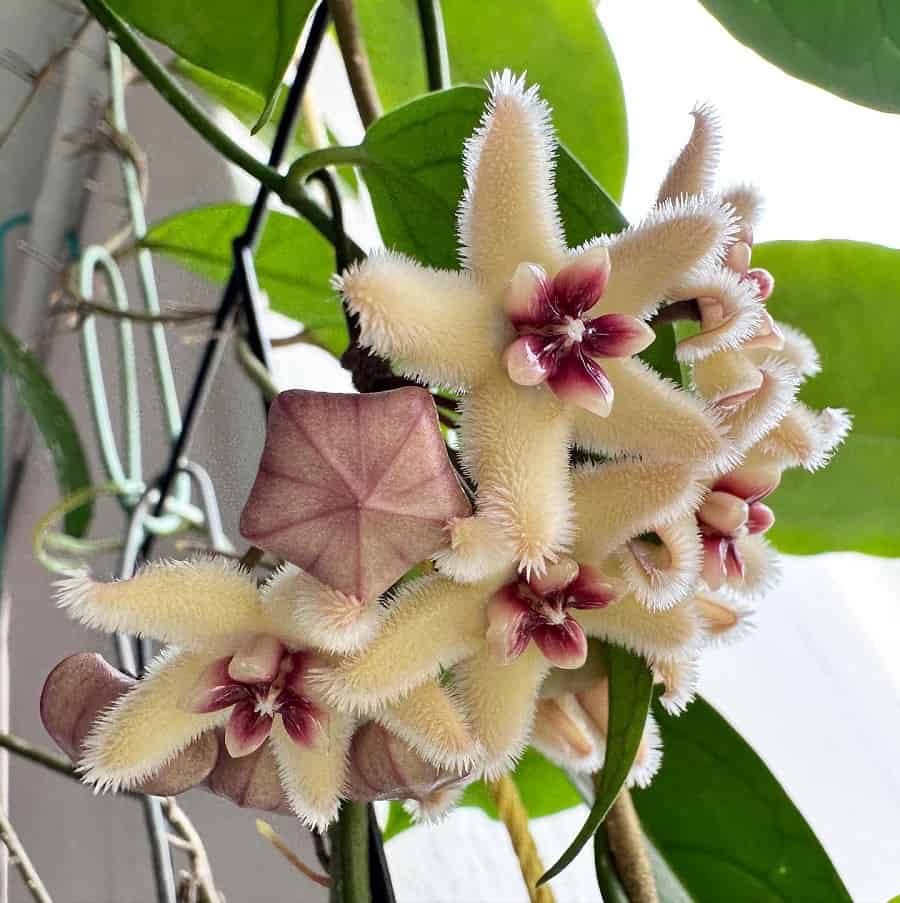
Hoya burmanica

Hoya burmanica is a species of plant that comes from Burma and can also be found in northwestern Vietnam, northeastern India, northern Myanmar (Burma), and northern Thailand. It is a cold-tolerant, weakly branching, bushy epiphyte that grows in moist evergreen forests in Vietnam and open woodland in Myanmar. The leaves are triangular or ovate-lanceolate, with a dark green or yellowish green upper surface and light green underside. It produces up to 12 light green or yellow, weakly fragrant flowers with a dull yellow crown and pink center that bloom for up to 7 days.
Hoya burtoniae
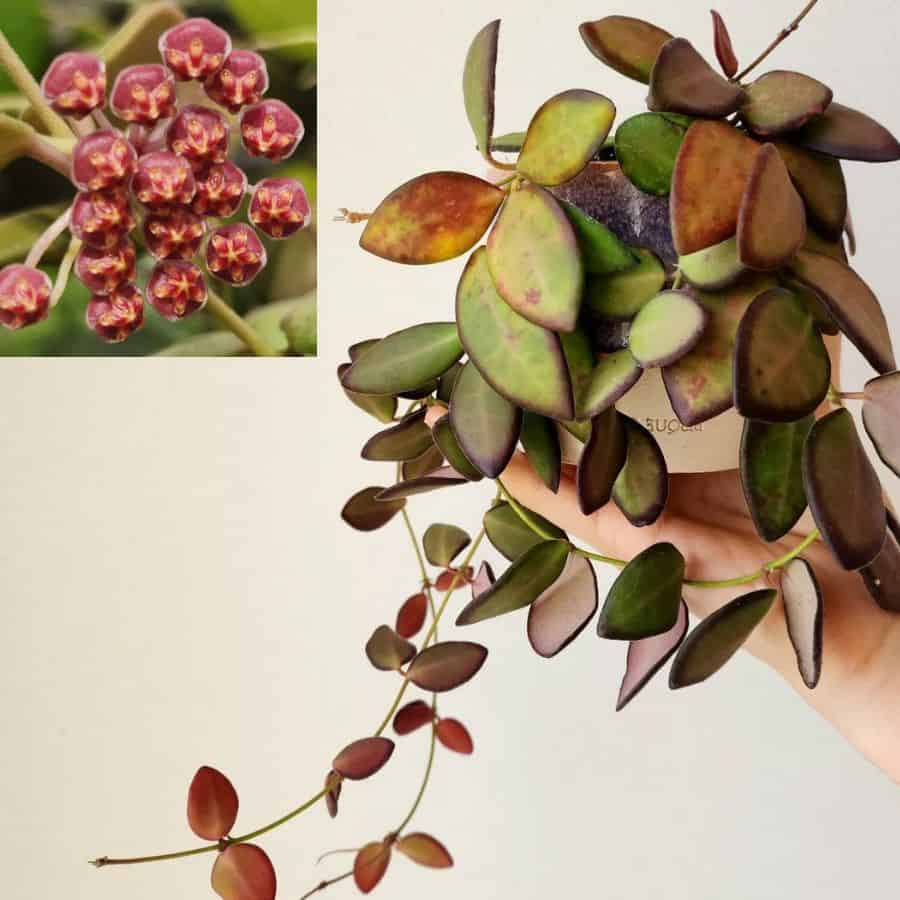
Hoya burtoniae is a species of Hoya plant that was named after Christine M Burton, an American hoya explorer who made significant contributions to the understanding of the taxonomy of the Genus Hoya. The plant is similar to another species called Hoya DS-70 but has distinct differences in terms of leaf and flower structure. The leaves of Hoya burtoniae are dark and almost black, with a velvety texture and have no visible veins, whereas Hoya DS-70 leaves are lighter in color, have visible veins and a stiff pubescence.
When in bloom, Hoya burtoniae has larger flowers (1.1 cm diameter) with corolla lobes turned back and a color closer to pink than red, whereas Hoya DS-70 has smaller rusty yellowish-red flowers. Both species have a mechanism of self-preservation where the undersides of the leaves turn red in low light to trap light and reflect it in a way that passes through the leaf twice, allowing more time to create chlorophyll during extended periods of rain or cloudy weather.
Hoya cagayanensis
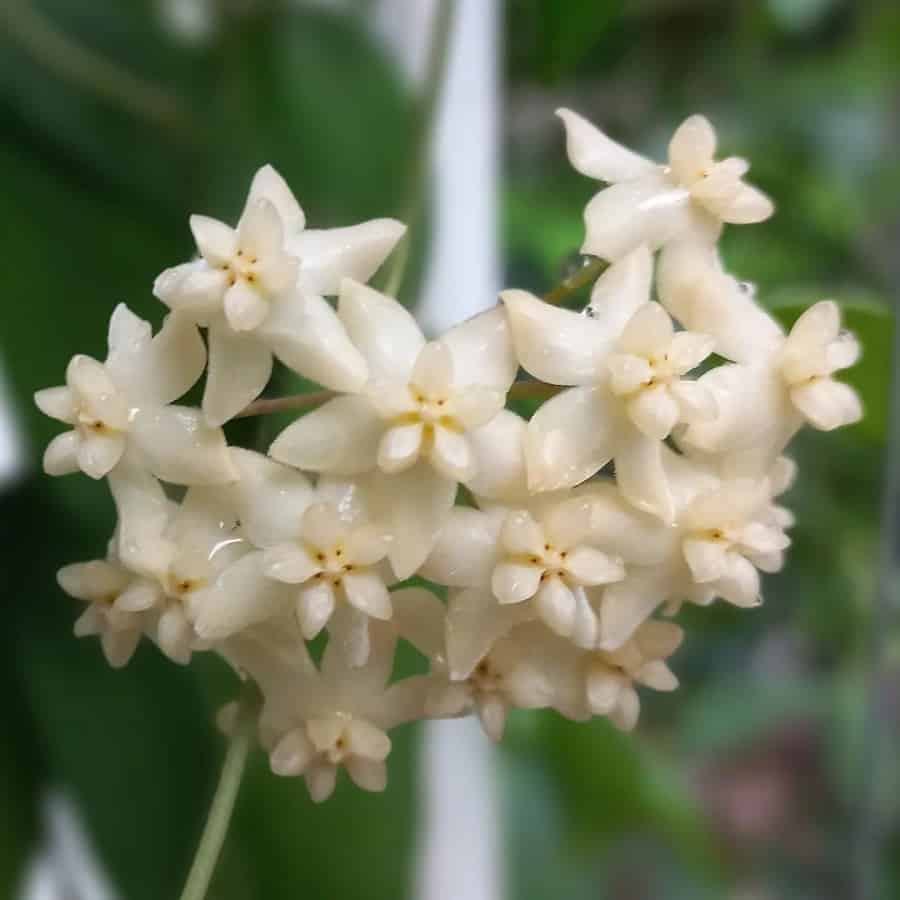
Hoya cagayanensis is a type of hoya plant with curly vines. The leaves are oval-shaped, leathery, and have no visible veins. They are 6 to 8 cm long and 2.5 to 3 cm wide. The plant has an umbrella-like cluster of flowers on stalks that are 4 to 8 cm long. The flowers have white petals that are 14 mm in diameter, smooth on the outside, and velvety on the inside. The center of the flower is also white.
Hoya callistophylla
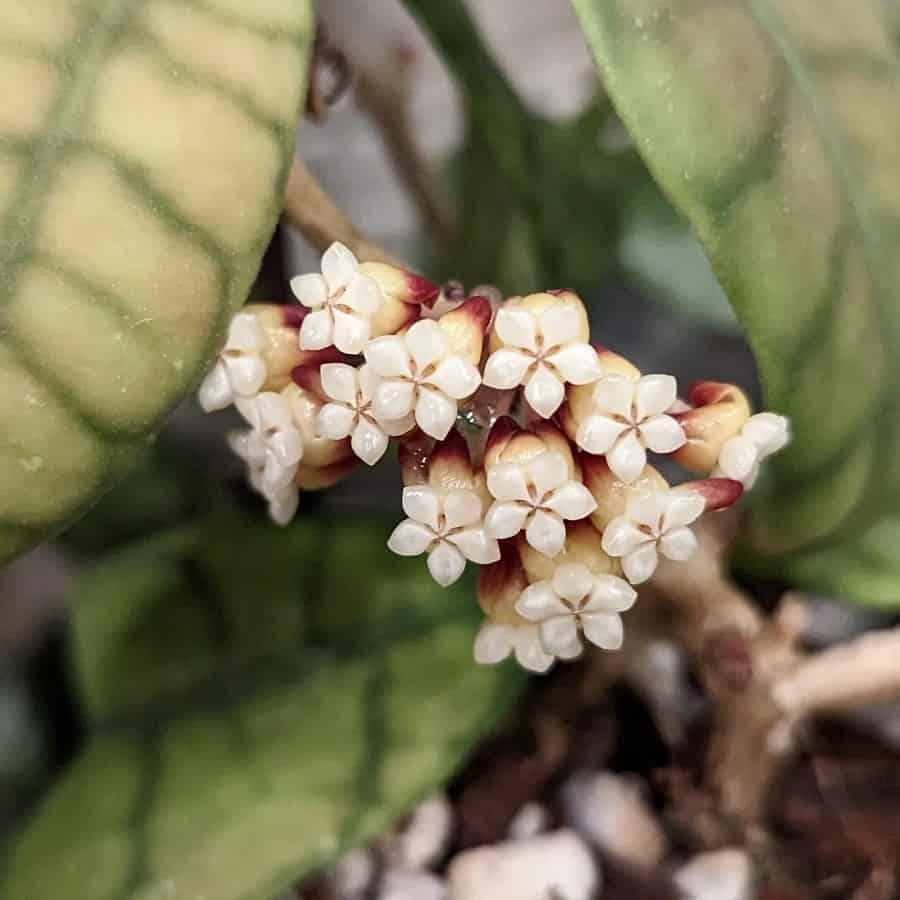
Hoya callistophylla is a type of hoya plant that got its name from the Greek word “Callisto” which means “most beautiful” and “phillum” which means leaf. It is known for its beautiful, large, and thick leaves that are elliptical-lanceolate in shape, and have a dark green, pinnately looped venation. The leaves are rough on the surface, and the veins are slightly elevated.
The plant also has a flower umbel that can have 20 to 40 individual flowers that are 8-10mm in diameter. The corolla lobes are smooth, yellow-brown, and turned back while the crown is white or yellowish. Hoya callistophylla prefers a bright, but not direct sunlight place and needs to have moist soil to prevent drying.
Hoya calycina
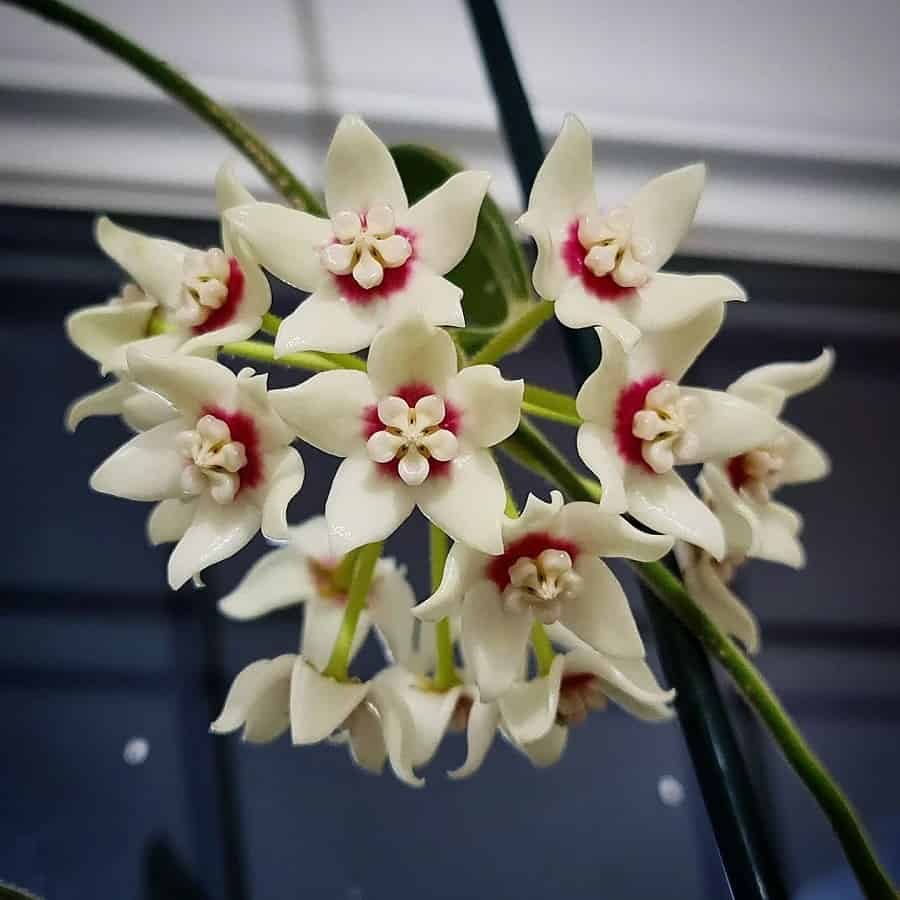
Hoya calycina is a type of plant that is similar in appearance to Hoya australis and Hoya albiflora. It has branches that climb up trees, and large, oval leaves that are 16-20 cm long and 9-11 cm wide. The flowers are white with red edges at the base of the crown and are smaller than those of Hoya albiflora. The crown is creamy and milky, and the flowers have a strong, sweet smell like hyacinth. They bloom in umbels with up to 10 flowers and last for about 10 days.
Hoya campanulata
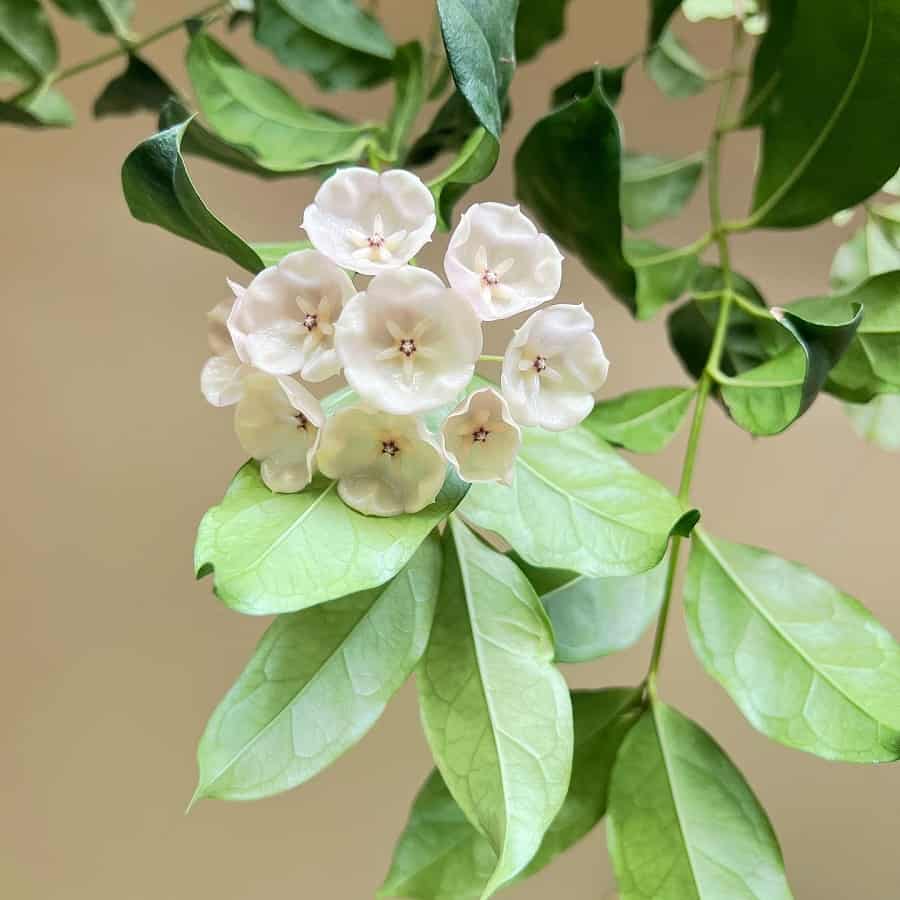
Hoya campanulata is a type of plant native to Indonesia, Peninsular Malaysia, and Singapore. It grows in warm and moist environments and likes loose soil. The plant can grow up to 3 meters long, with thin stems that become woody with age and lose their leaves. The leaves are dark green, leathery, smooth, and oval-shaped. The flowers are bell-shaped, creamy white inside and with a slight purple color outside, and hang on thin peduncles. The flowers have a white or cream-colored waxy crown and can last up to 8 days. This plant prefers to grow in mountainous areas and requires warm and moist conditions.
Hoya camphorifolia
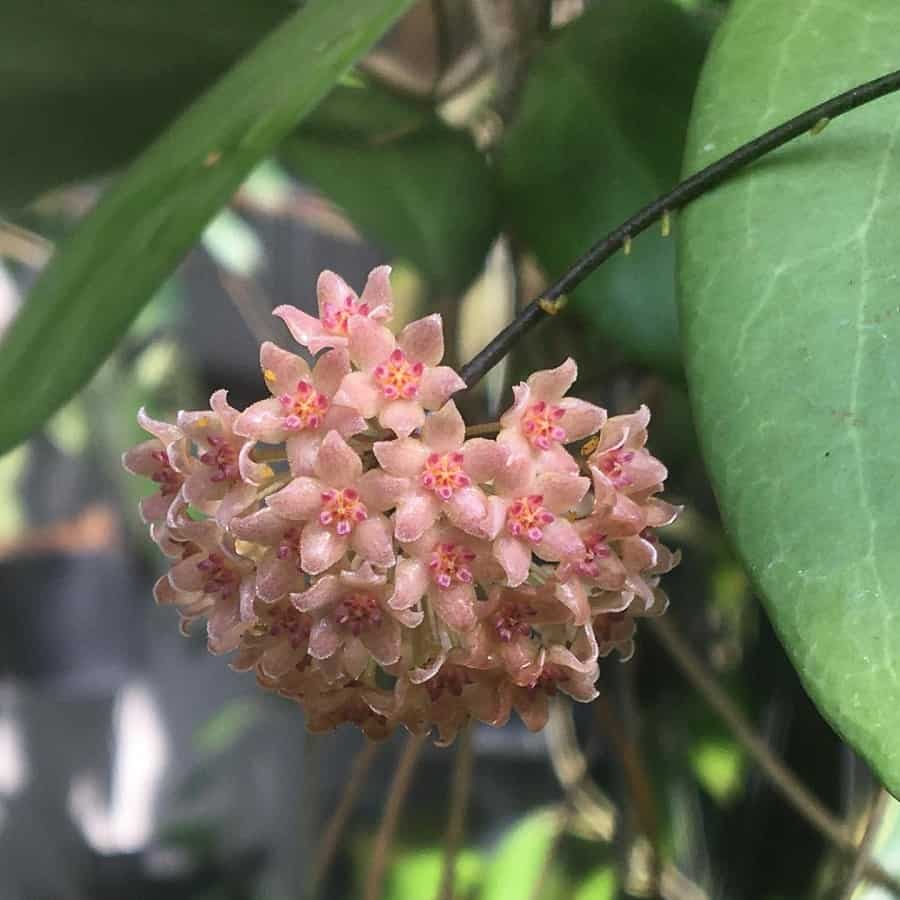
Hoya camphorifolia is a species of flowering plant that is native to the Philippines, specifically found in the Central Luzon region of the largest island in the country. It is a slender and graceful climbing plant that can grow up to 3 meters long, and is commonly found growing in rainforests. The leaves of Hoya camphorifolia are pale green, oblong-oval in shape, 6-9 cm long and 2.5-3.5 cm wide in the middle, with a smooth surface and sharp tips curving down. The leaves also have a fine reticulate pattern, with 2-3 primary veins on either side of the midrib and a network of secondary veins.
The plant produces 19-23 small flowers in a convex umbrella shape, which open in the morning and close in the evening. The corolla of the flowers is 0.6 cm in diameter, pale pink in color, and has broad triangular lobes. There is also a dark red spot in the center of the flower crown. This species is easy to grow and blooms without difficulty, making it an ideal variety for indoor cultivation. However, it requires plenty of water, loose, permeable soil, and good drainage to thrive.
Hoya cardiophylla
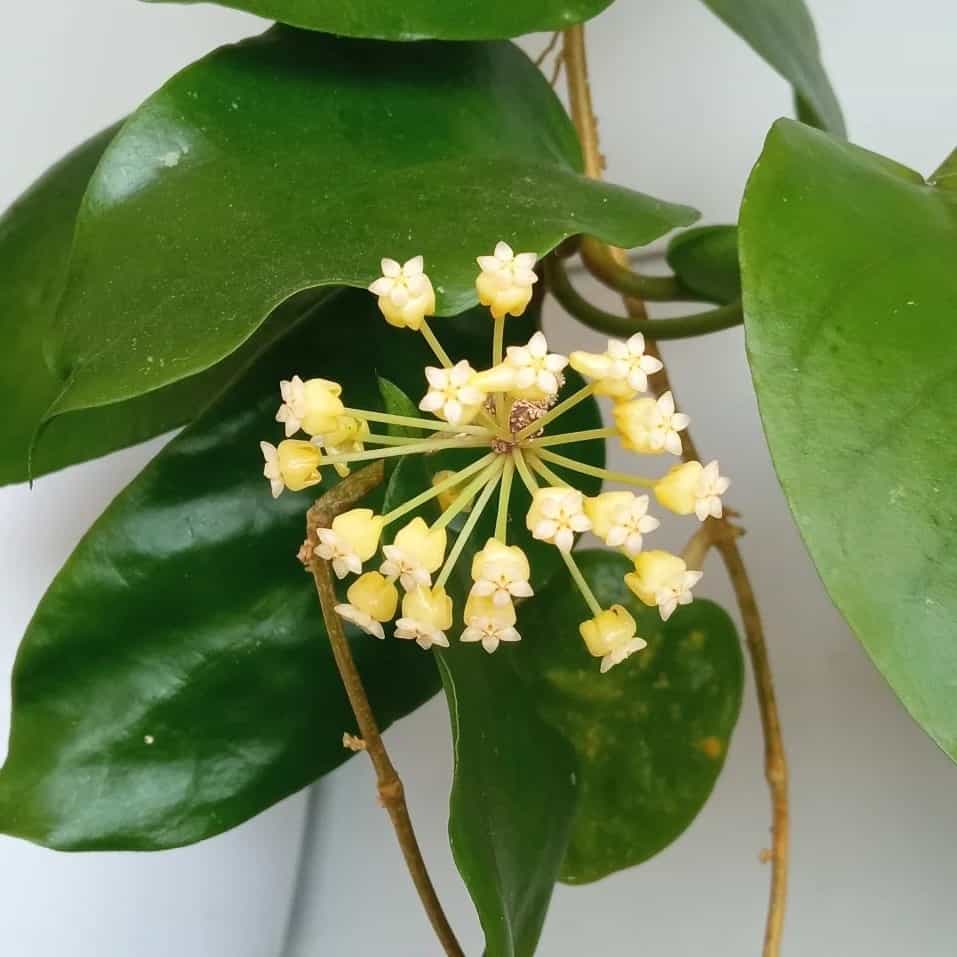
Hoya cardiophylla is a plant that is native to the Philippines and can be found growing on trees in the lower parts of forests. The plant has light green, slightly hairy stems when young, which become woody and brown with age. The leaves are glossy, heart-shaped at the base, 10-15 cm long, and 3-8 cm wide.
The flowers of Hoya cardiophylla are yellow, glossy, and ball-shaped, with a light beige crown and yellow spots. The flowers have a strong and pungent odor and last about a week. This plant grows quickly and requires support, as well as high humidity and regular watering without over-drying. It also benefits from a small amount of lime in the soil.
Hoya carmelae
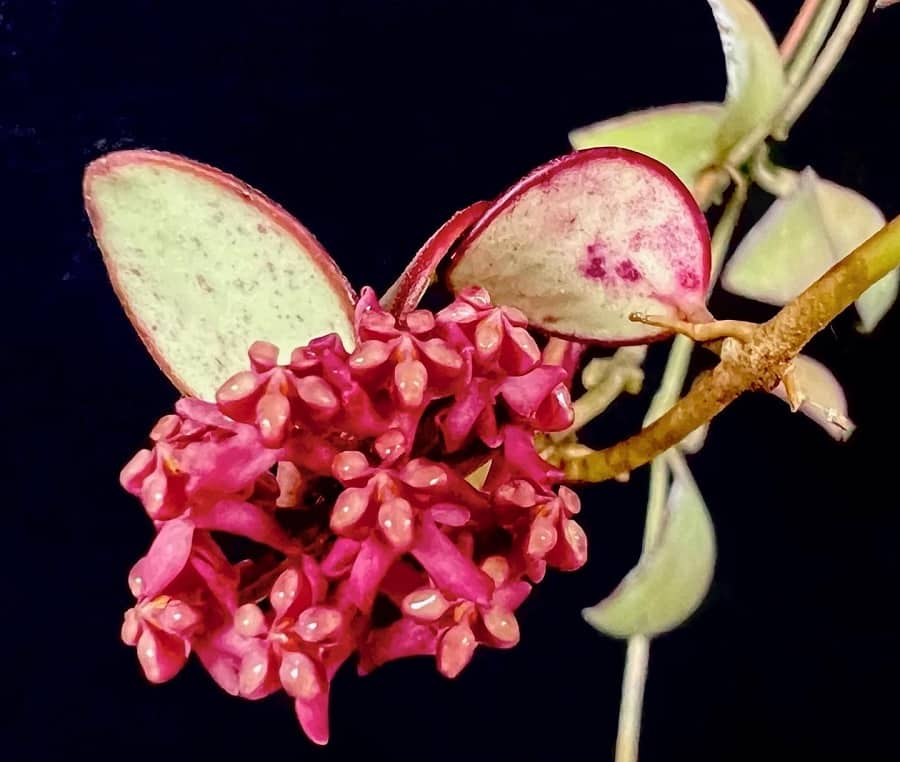
Hoya carmelae is a species of plant native to the island of Luzon in the Philippines. It was discovered in 2010 and named after a leader of an expeditionary group named Carmela Española who is a well-known birdwatcher in the Philippines.
The leaves of Hoya carmelae are almost round and dark green in color, but can turn bright crimson in sunny conditions. The flowers are bright crimson and are small in size, with 7-25 individual flowers on each umbrella-shaped cluster. The corolla lobes are deeply dissected and turned back.
Hoya carnosa
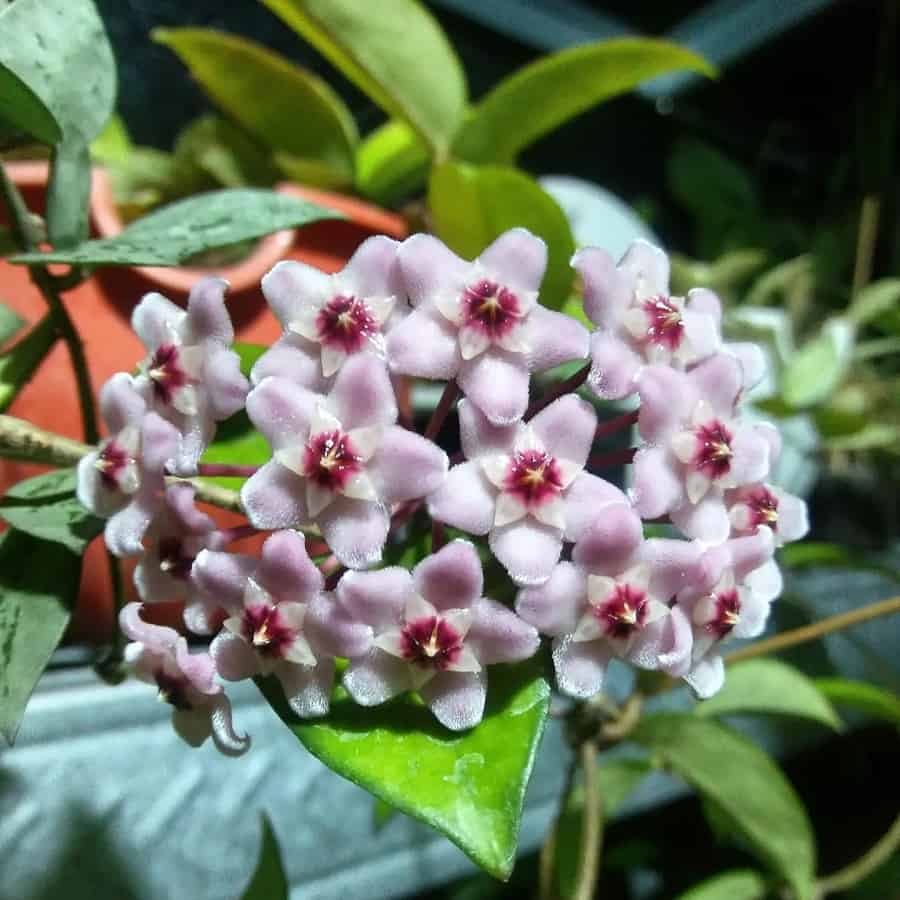
Hoya carnosa is a species of plant from the Hoya genus that is native to Asia and found in countries like Laos, Vietnam, India, China, Taiwan, and Japan. It is a popular houseplant due to its attractive appearance, easy care, and hardiness. Hoya carnosa has oval-shaped leaves that are glossy and green with silver spots, and it produces umbels of pale pink flowers with red spots in the center and a fragrant smell. The flowers are pubescent and have a lot of stamina, meaning they bloom many times on the same stem. The plant is hardy and can grow up to 6 meters long.
Hoya carnosa Nova Ghost
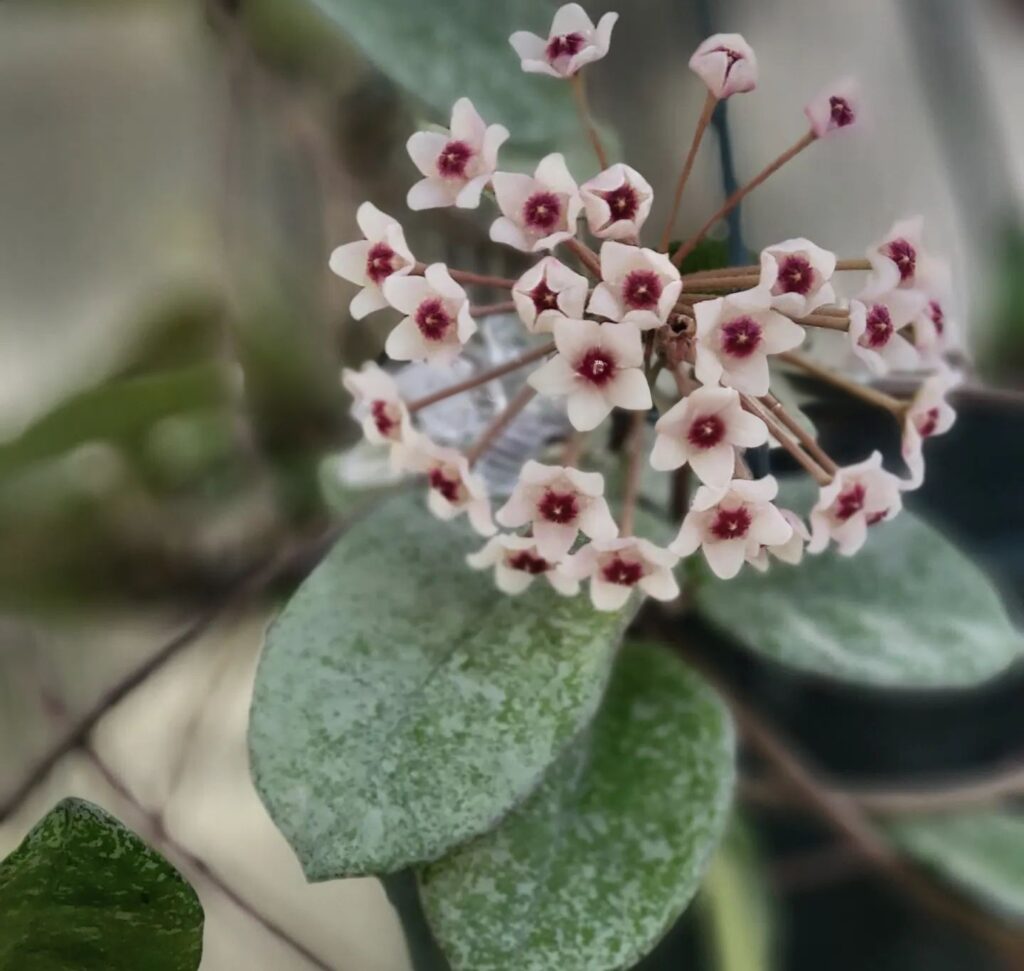
The Hoya carnosa ‘Nova Ghost’ is a houseplant with thick, waxy, silvery-green leaves that have a light shine, giving it a mysterious, ghostly appearance. It produces small, star-shaped, fragrant flowers in the spring and summer. This hybrid, developed from species native to tropical regions of Southeast Asia, is a reverted version of the Hoya ‘Argentea Princess’. Unlike the Hoya carnosa ‘Grey Ghost’, the ‘Nova Ghost’ has a faster growth rate and shorter leaves with closer spacing between them.
Hoya carnosa Grey Ghost
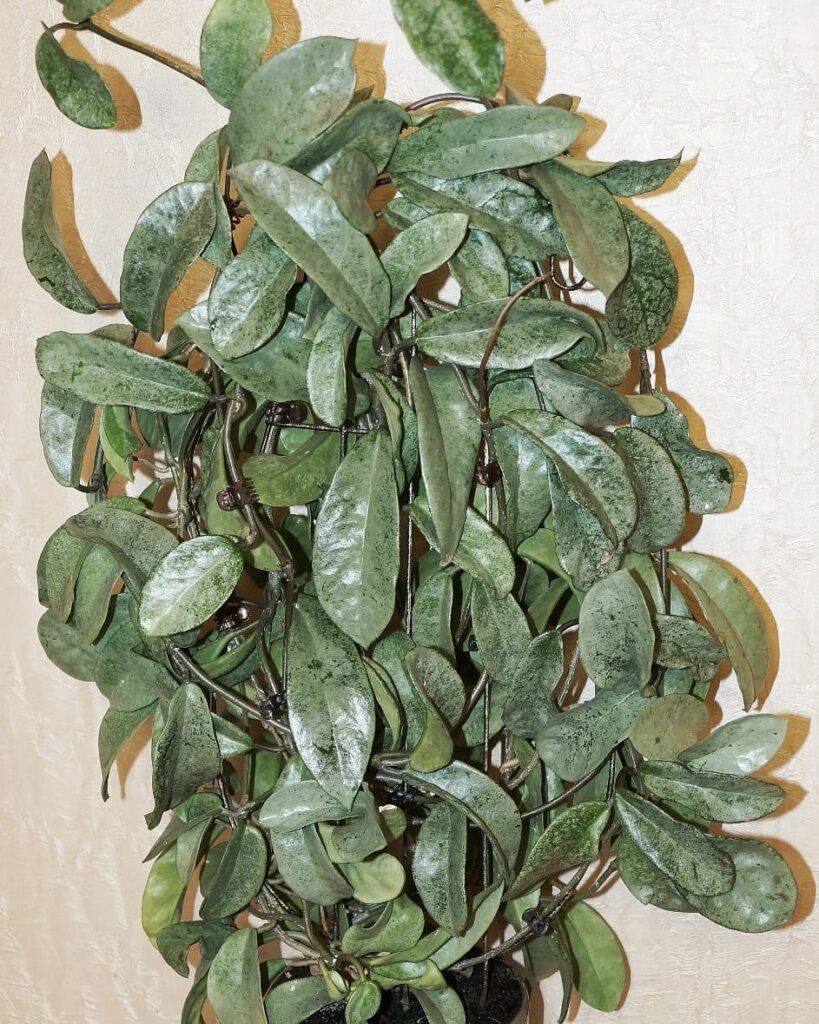
Hoya carnosa ‘Grey Ghost’ is known for its show-stopping silver foliage. This carnosa cultivar produces star-shaped baby pink flowers, up to 20mm in diameter, with plum-centered pink coronas. Each umbel can hold up to 25 flowers, which are nectar-producing and emit a strong, sweet fragrance. The blooms last up to 7 days, adding a touch of beauty and scent to any space.
Hoya caudata
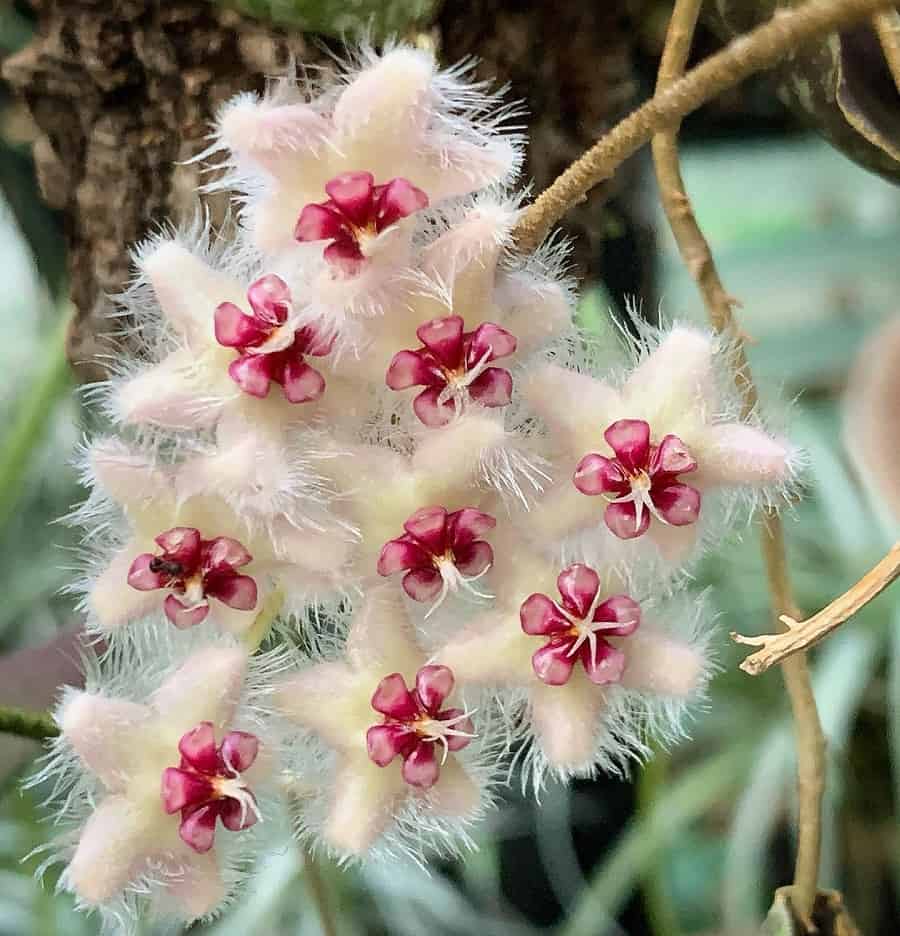
Hoya caudata is a type of plant that is native to Southeast Asia, including countries like Malaysia, Thailand, and Singapore. It grows by climbing up trees or rocks and has long curly stems that can reach up to 5 meters in length. The leaves are dark green and can turn red in sunny conditions, and the plant produces small pale pink flowers that last up to two days.
The plant prefers sunny locations and can grow in a variety of climates, but it is more tolerant of cool temperatures. It thrives in areas with little soil and is found mainly on tree trunks and rocks in direct sunlight, where it is exposed to intense heat, wind, and light. The flowers attract large flies for pollination.
Hoya cembra
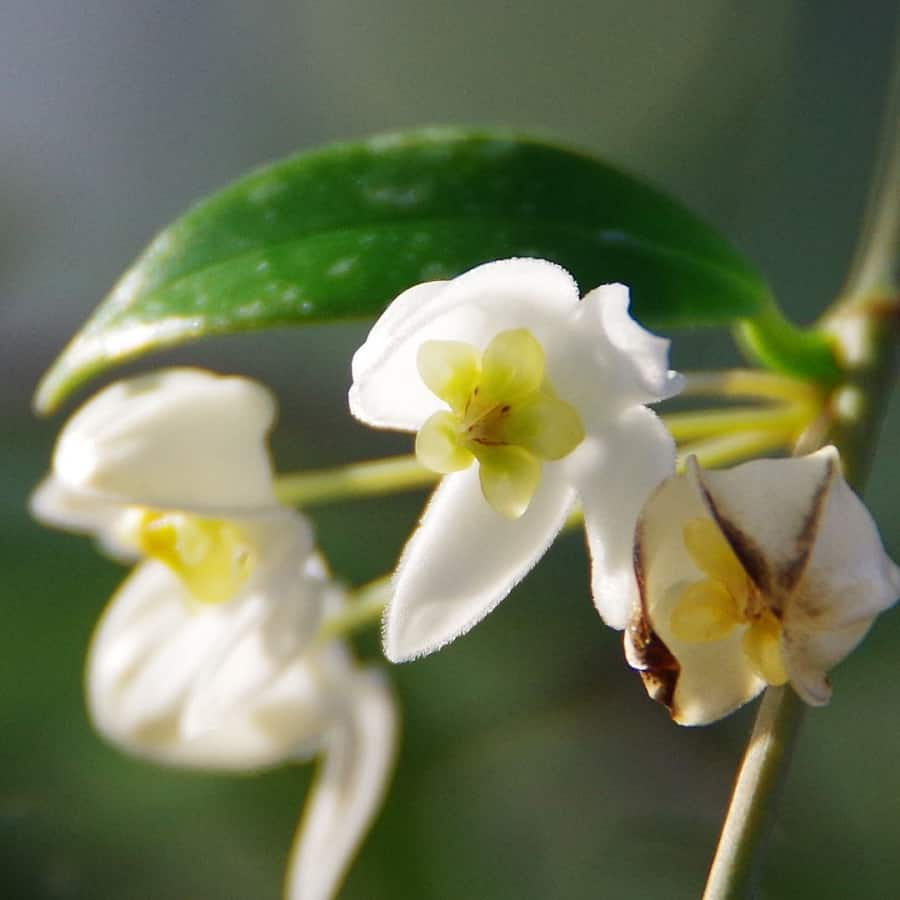
Hoya cembra is a type of hoya plant that grows upright and bushy with thin, woody stems. It looks best when the pot is hung higher and the stems are allowed to cascade down, showing off the flowers. The leaves are dark green and glossy, with a shape that is long and narrow, and sometimes with silvery spots.
The plant produces 4 to 16 star-shaped flowers that are white with a pale yellow-green crown. The flowers have a delicate citrus scent and last for about 9 to 10 days. Hoya cembra is related to another hoya species called Hoya odorata, but it has different features such as longer leaves, cilia on the sepals, and a pubescent inner surface of the corolla, which is not present in Hoya odorata.
Hoya chinghungensis
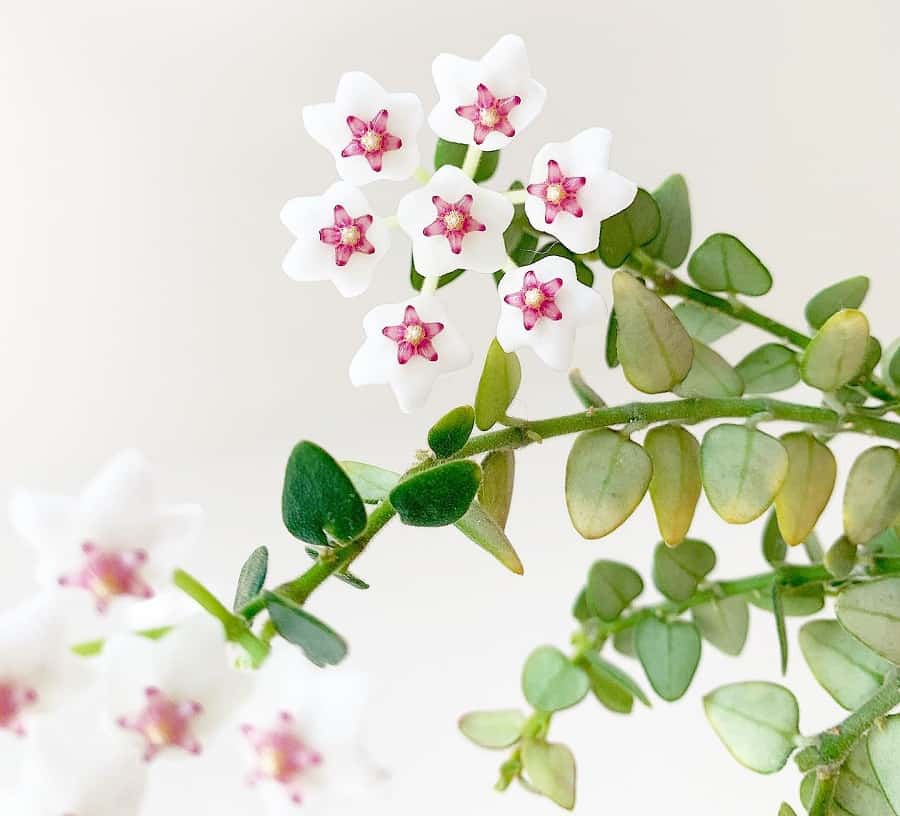
Hoya chinghungensis is a type of plant that grows in dense, green forests and is often found on mountain peaks at an altitude of 700-1500 m. This plant likes to grow on rocky limestone soil and can be found in several countries in Southeast Asia including Laos, Vietnam, China, Thailand, and Myanmar. It’s a type of epiphyte or lithophyte, which means it grows on rocks or other plants instead of soil.
This plant has stems that can reach up to 2 meters long and branches near the base. The leaves are oval and around 1-1.5 cm long and 0.7-1.1 cm wide, with a rounded base and a sharp tip. It has white flowers that are about 1-1.2 cm in diameter with pink crown lobes. The flowers bloom from April to August.
Hoya chlorantha
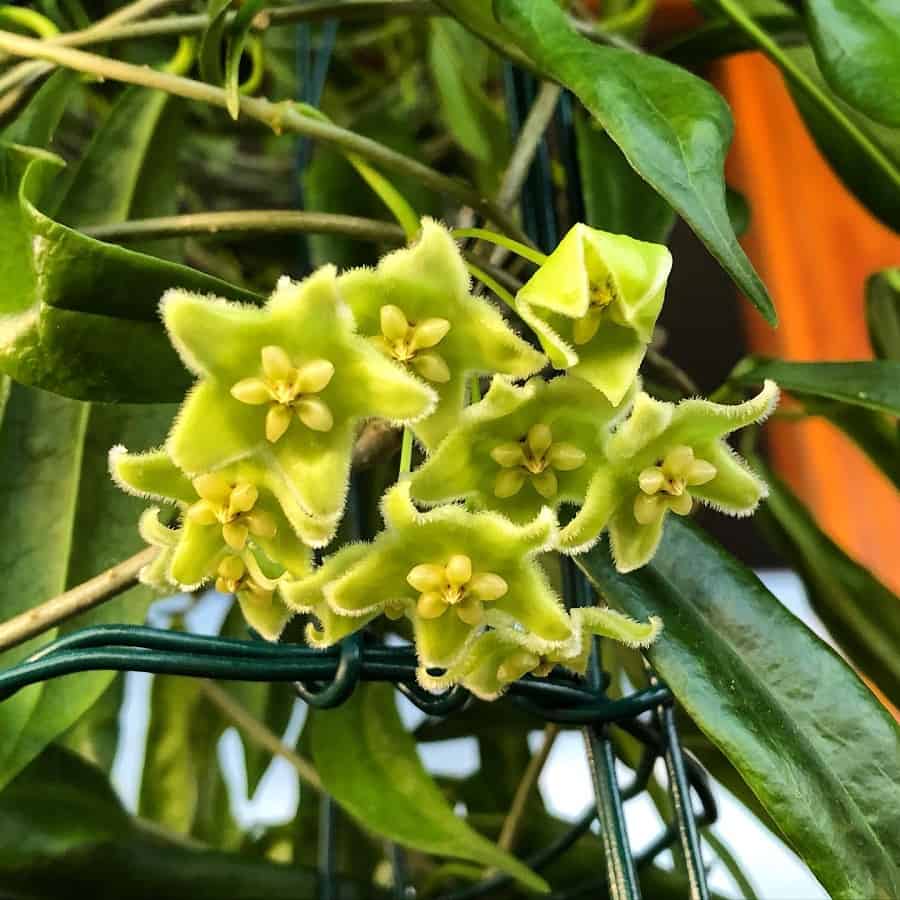
Hoya chlorantha is a plant species that is native to Samoa. It is known for its distinctive curly stems and smooth, thin leaves that are grassy green in color. The plant produces clusters of star-shaped flowers that are light green in color with a yellow-green crown.
There are two forms of Hoya chlorantha, one with green flowers and the other with lilac-red flowers. The plant is known for producing a lot of nectar and having a weak aroma. Hoya chlorantha var. tutuilensis, with lilac-red flowers, has been available in the American trade longer than the type form.
Hoya chunii (Hoya chuniana)
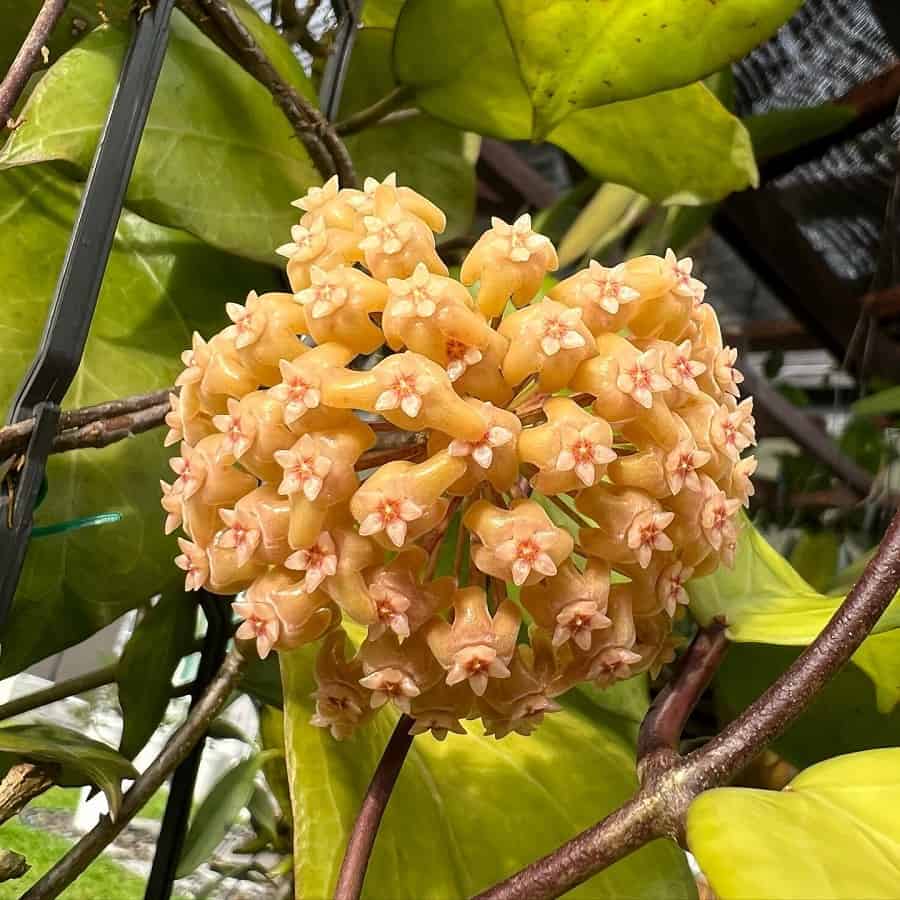
Hoya chuniana is a species of epiphytic climbing vine that is native to the rainforests of Papua New Guinea. It has thick vines that are 0.3 cm in diameter and glossy, dark green leaves that are dense, leathery and have wavy edges. The leaves can grow up to 8-15 cm long and 5-10 cm wide, and turn red when young and exposed to sun, but turn green when ripe.
Hoya chuniana produces up to 30-40 flowers in a round flower umbel, which are apricot in color and have a slightly lighter pinkish-white crown. The flowers are small, only 0.6 cm in diameter, with corolla lobes that are strongly recurved. The aroma of the flowers is sweet and they only last for 3 to 4 days. This species prefers high humidity and a bright location without direct sunlight, as the leaves are easily sunburned in the sun.
Hoya ciliata

Hoya cinnamomifolia
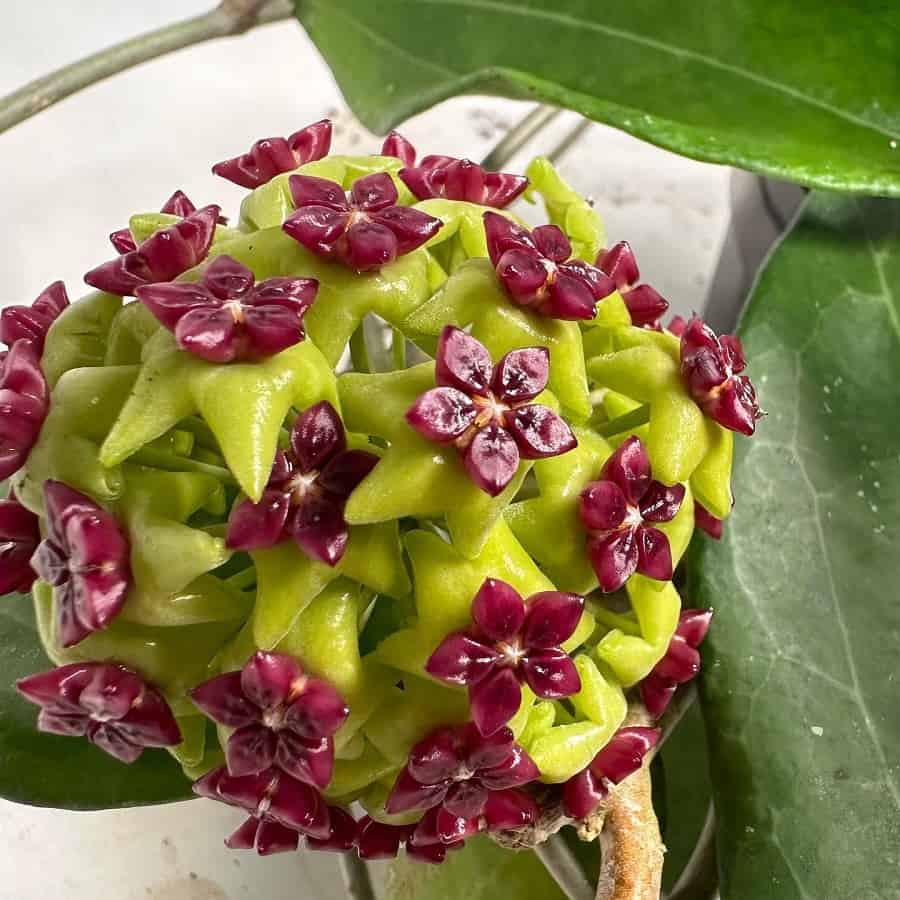
Hoya cinnamomifolia is a plant species found in the wild. It has long and curly stems that can branch out and have short roots growing out of them. The leaves of Hoya cinnamomifolia are large and oval-shaped, with five veins visible on the surface. They grow on a thick stem and are slightly leathery to the touch.
When the plant blooms, it produces an umbel of 20-40 large flowers. These flowers are about 2 cm in diameter and have yellow-green corolla lobes that are bent back at the tips. The crown of the flower is fleshy and a rich purple-purple color. Hoya cinnamomifolia blooms in spring and summer and the flowering lasts up to 5 days.
Hoya citrina
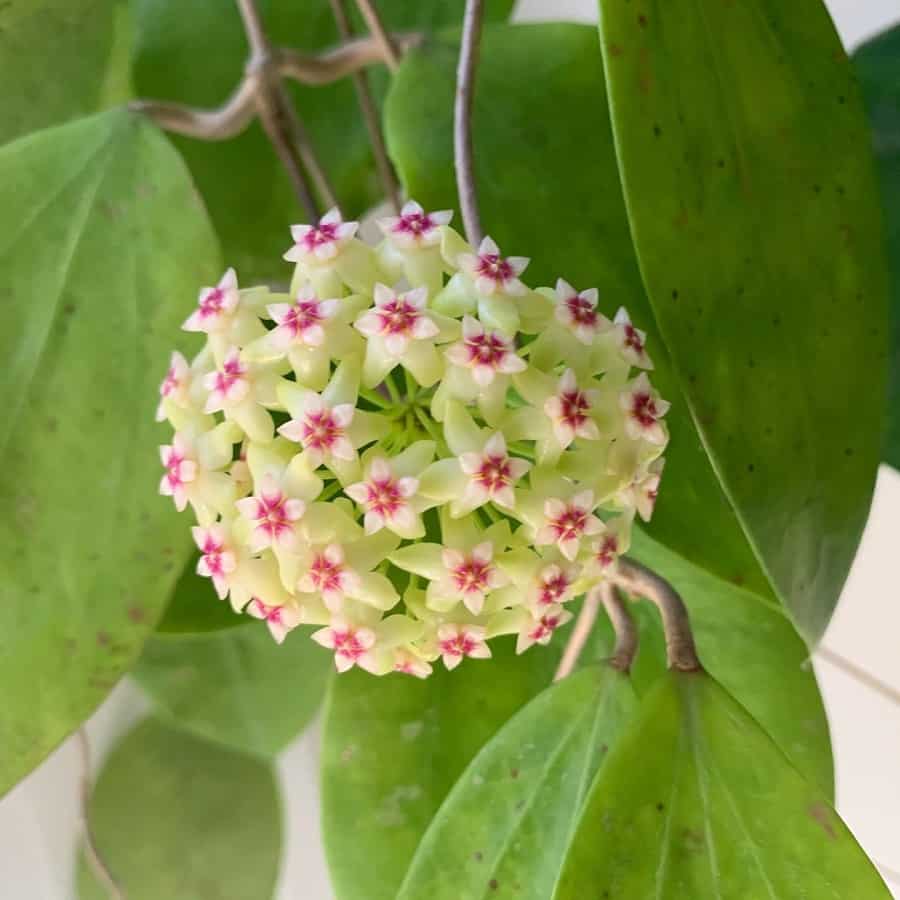
Hoya clemensiorum
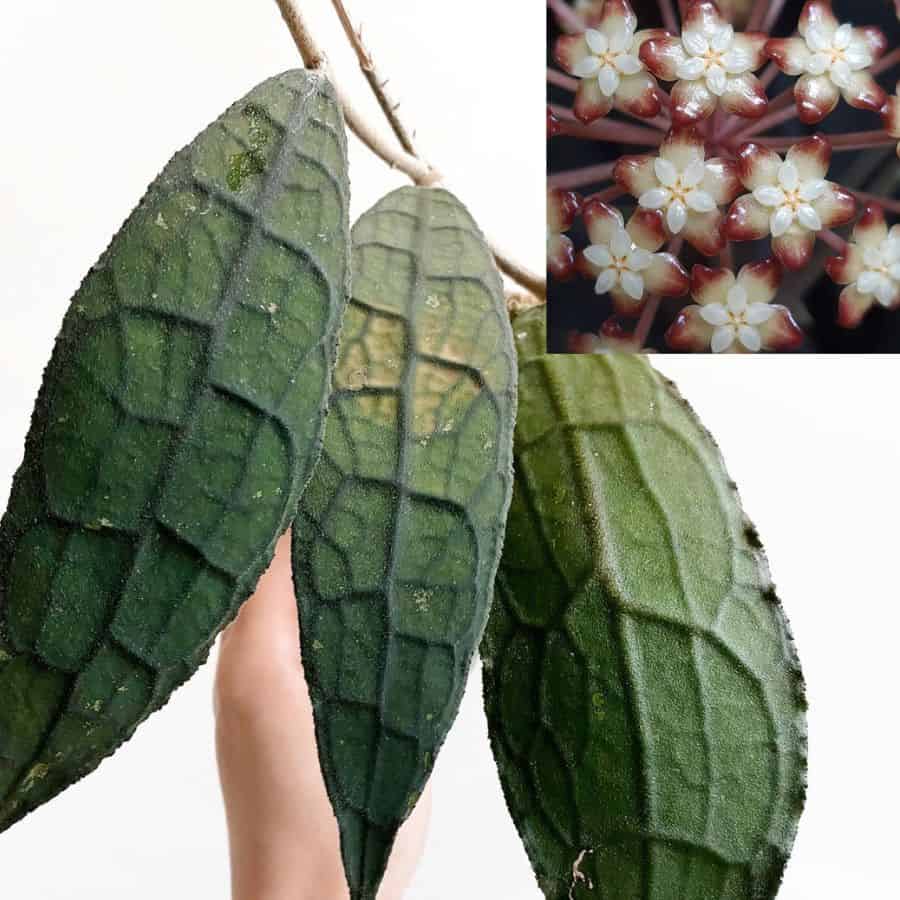
Hoya clemensiorum is a type of flowering plant that is related to another plant called Hoya finlaysonii. This plant is known for its large and beautifully veined leaves that can turn purple around the edges when they mature. Hoya clemensiorum is a climbing plant that forms a lot of aerial roots in humid environments.
The leaves of the plant are large, stiff and dense, measuring 20 to 35 cm long and 7 to 10 cm wide. They are light green in the shade and dark green with a red tint when exposed to sunlight. The flowers of Hoya clemensiorum are found in umbels of 10 to 20 blooms with a diameter of 1.2 to 1.4 cm. The corolla of the flowers is brown-red and turned back, while the crown is white. The flowers of this plant do not last very long, only about three days, but they bloom in large numbers during the summer months.
Hoya collina
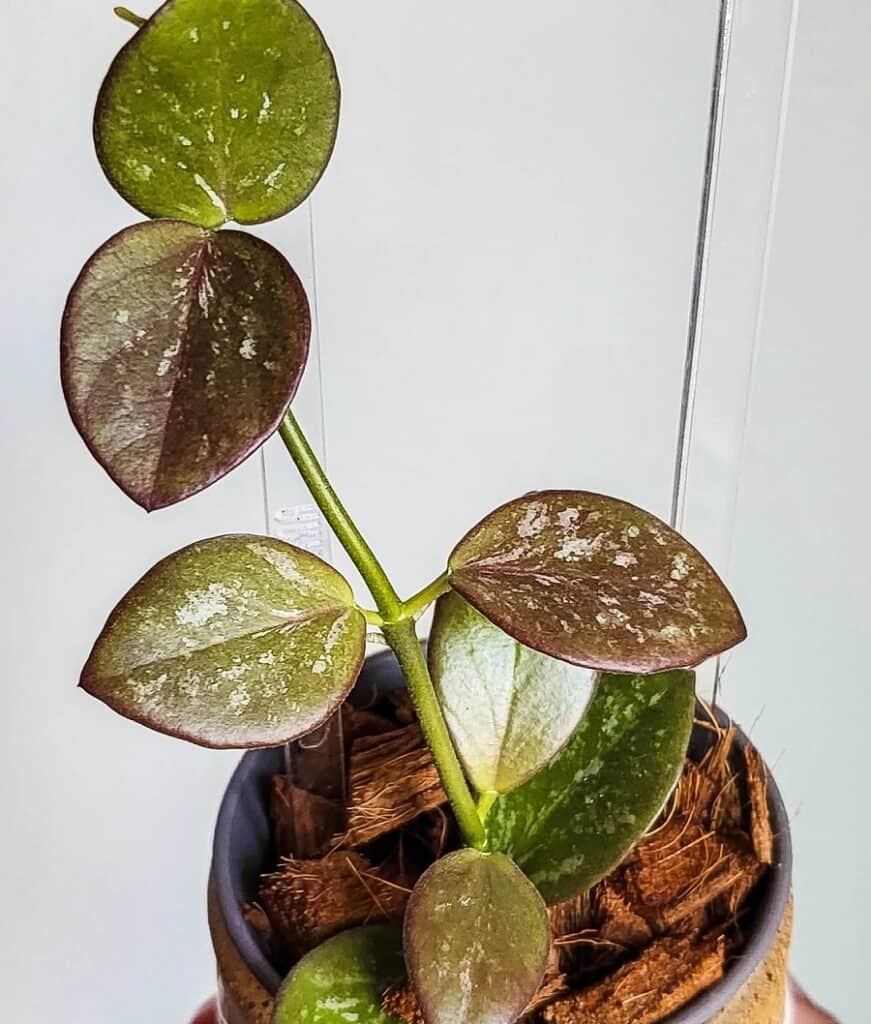
Hoya collina is a species of epiphytic climbing plant that is native to the hills of northeastern New Guinea, where it was discovered blooming in the trees and bushes in a forest. As the plant ages, the stems become stiff at the base. The leaves of Hoya collina are fleshy, smooth, round, and come in a size of 3.5-5.5 cm long and 1-3 cm wide.
The flower umbel opens up with 6 to 12 flowers, which are small, pale yellow in color, and about 0.8 cm in diameter. These flowers produce a lot of nectar and have a sweet aroma. There is a common clone of Hoya collina called “New Guinea Biak Island IPPS 4526”, which has deep green leaves that are speckled with silver.
Hoya cominsii
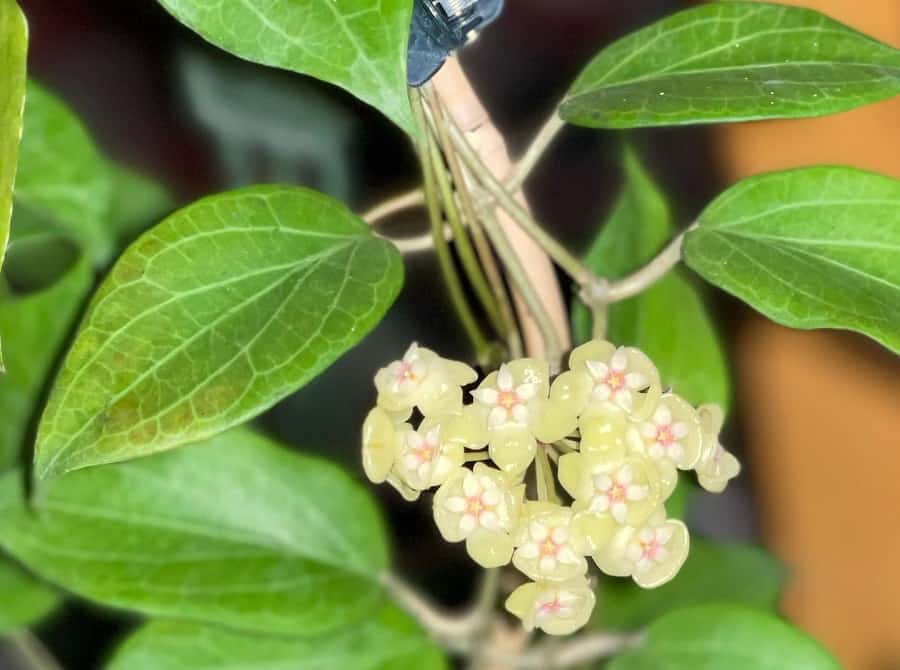
Hoya compacta
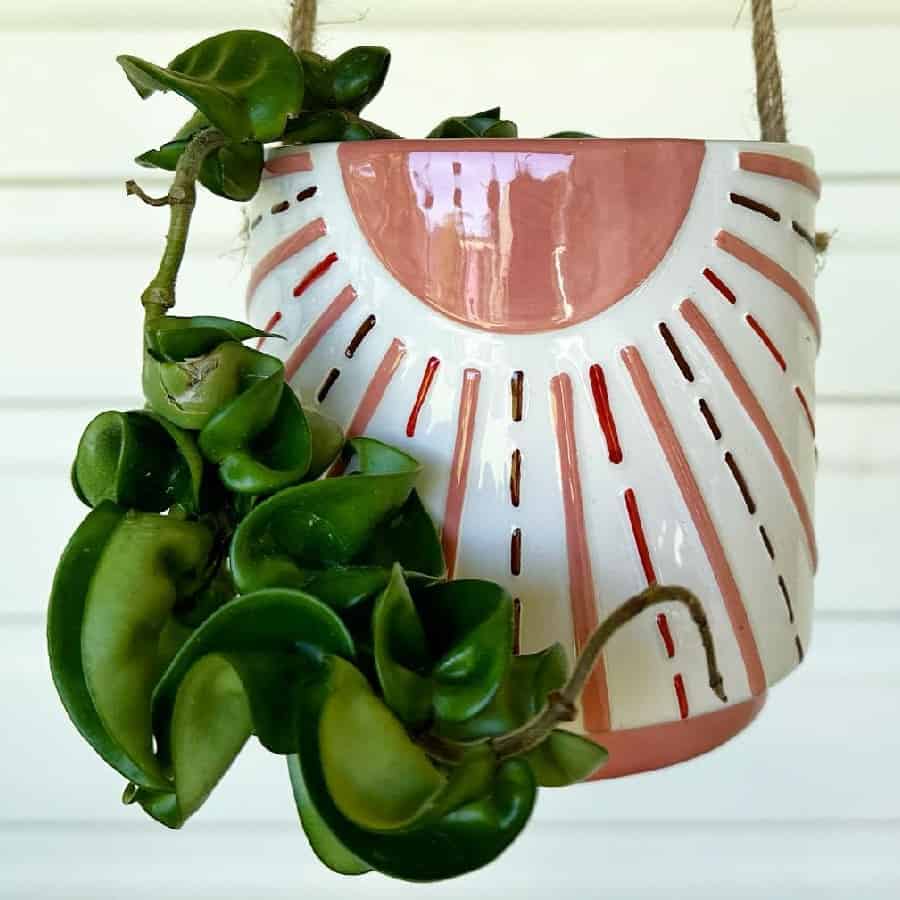
Hoya compacta is a cultivar of Hoya carnosa that comes from East Asia and Australia. It is an evergreen vine that grows on other plants, and is known for being a chubby plant with leaves that grow closely together. The flowers of this plant are pale pink, which is a common color for Hoya carnosa.
Hoya coriacea
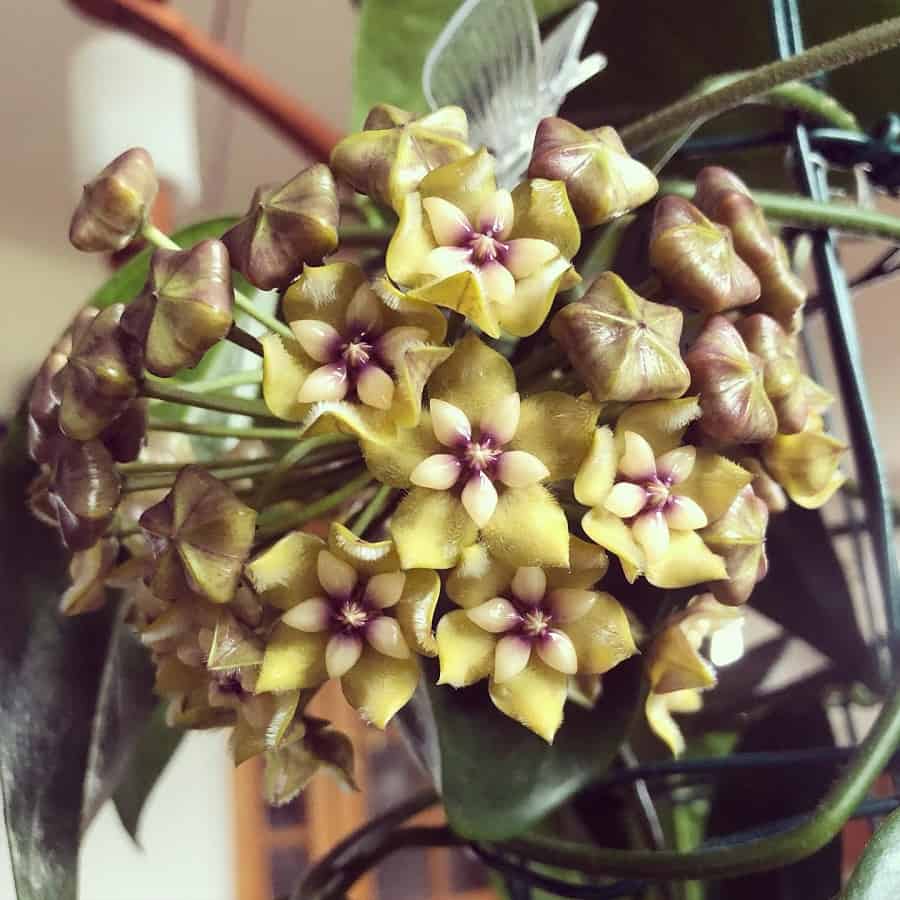
Hoya coriacea is a plant native to Southeast Asia. It got its name from the structure of its leaves which are leathery and hard like skin. The plant can grow large in size and needs support, but it can also grow on other plants or in the ground. The leaves are large, thin, glossy and grassy green.
The flowers have 20-40 individual light yellow or cream-colored blooms with a purple center, and they have a weak sweet aroma. This plant needs warm temperatures, a lot of light, and high humidity to grow well and bloom. It likes moist soil but can tolerate a little drying.
Hoya coronaria
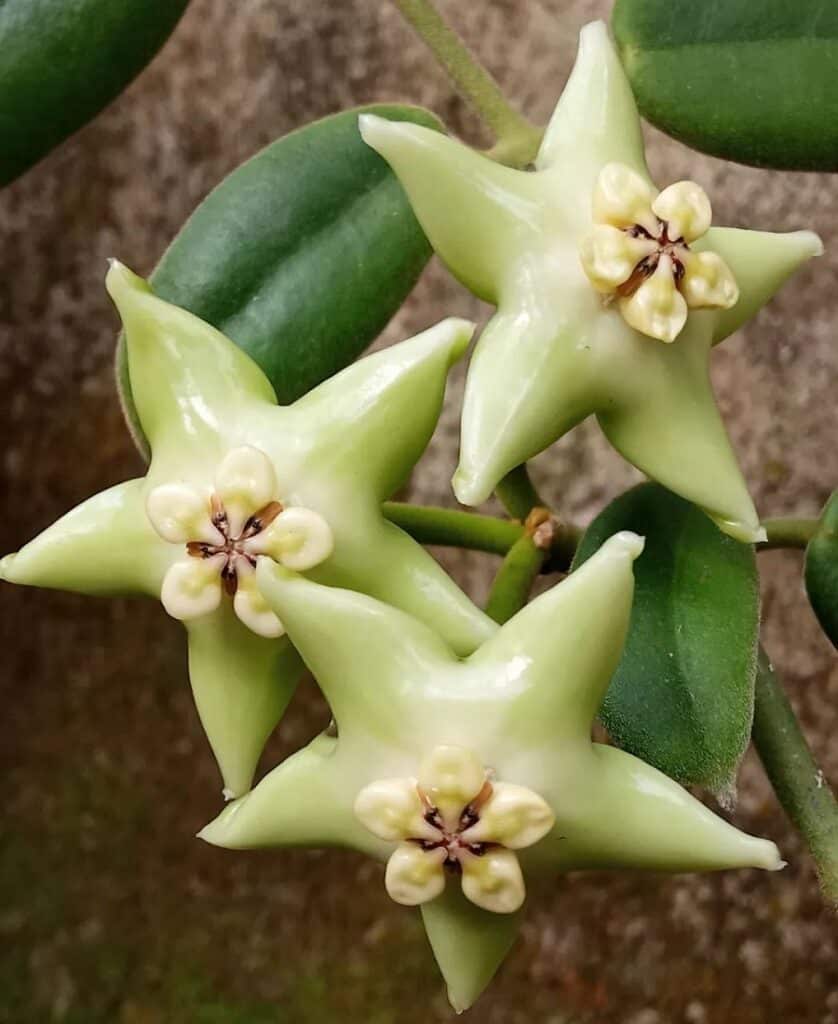
Hoya coronaria is a plant with greenish-blue leaves that are very fuzzy. It is a bit rare. The buds are green, and the flowers start as lime green and turn white. The flowers are big and shaped like stars, and they are long-lasting and fragrant. The plant is easy to enjoy even without flowers. However, it doesn’t like cold weather.
Hoya crassicaulis

Hoya crassicaulis is a type of plant that grows on other plants and has thick branches. As the plant grows older, the branches become knobbly and stiff. The leaves are smooth, shiny, and shaped like ovals or long points. They are leathery and have a visible central vein and 4 other veins that spread out from it. The plant produces ball-shaped clusters of 60-125 fragrant flowers that are pale yellow with purplish brown tips. The flowers have sharp, smooth blades that are turned back. This type of plant is similar to another plant called Hoya incrassata, but the two are not exactly the same.
Hoya crassifolia
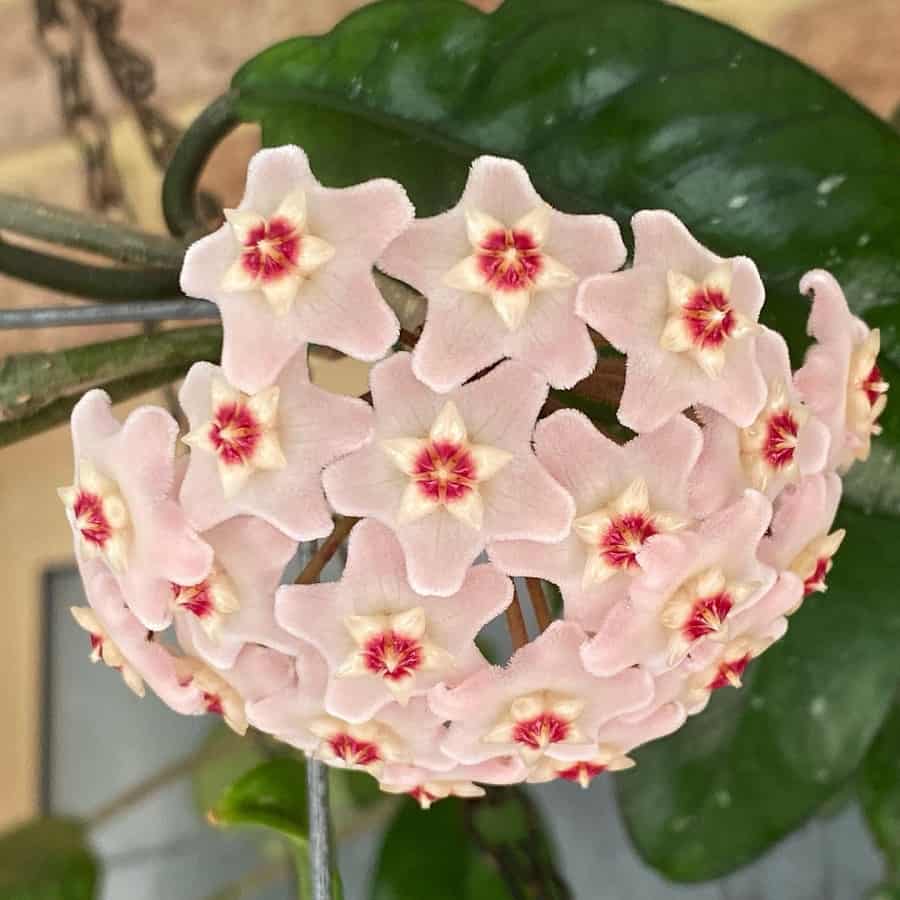
Hoya crassifolia is a plant that is native to China and grows in a vining way, like it is hanging from a basket. It has thick, round, waxy leaves that look attractive, and it produces light pink flowers that have a sweet fragrance. The flowers are star-shaped, baby pink, and have a dark pink center with a cream corona.
This plant is easy to take care of and can grow well in pots or hanging baskets, making it a great option for a houseplant. It is similar to Hoya carnosa, but its leaves tend to be more rounded. The flowers can last up to 7 days.
Hoya cumingiana
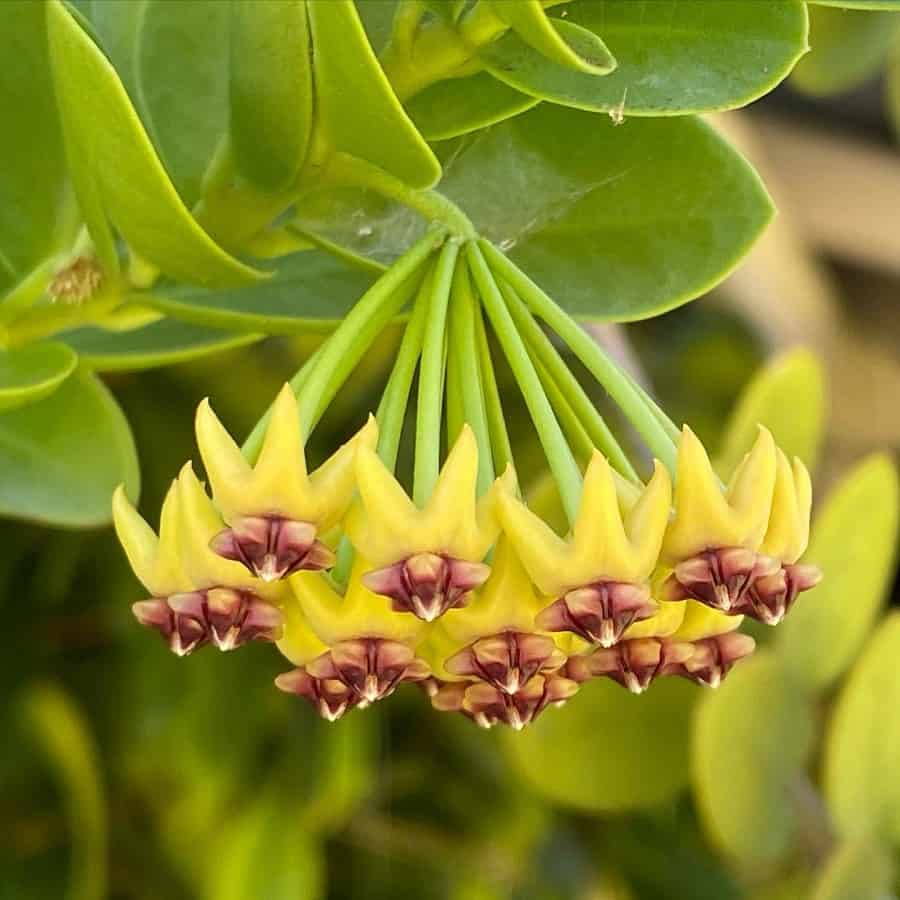
Hoya cumingiana is a plant species found in the Philippines, Java, and Borneo. It’s named after a plant collector named Hugh Cuming who discovered this species on the island of Mindoro. This plant is a semi-shrub that can grow on cliffs, boulders, and roadsides in its natural habitat. It has drooping and rising stems that are green when young and turn woody as it matures. The leaves are oval-cordate and can vary in size, shape, and texture. The flowers have greenish-yellow petals and a bright dark red crown, and the plant prefers limestone in its substrate to grow well.
Hoya curtisii
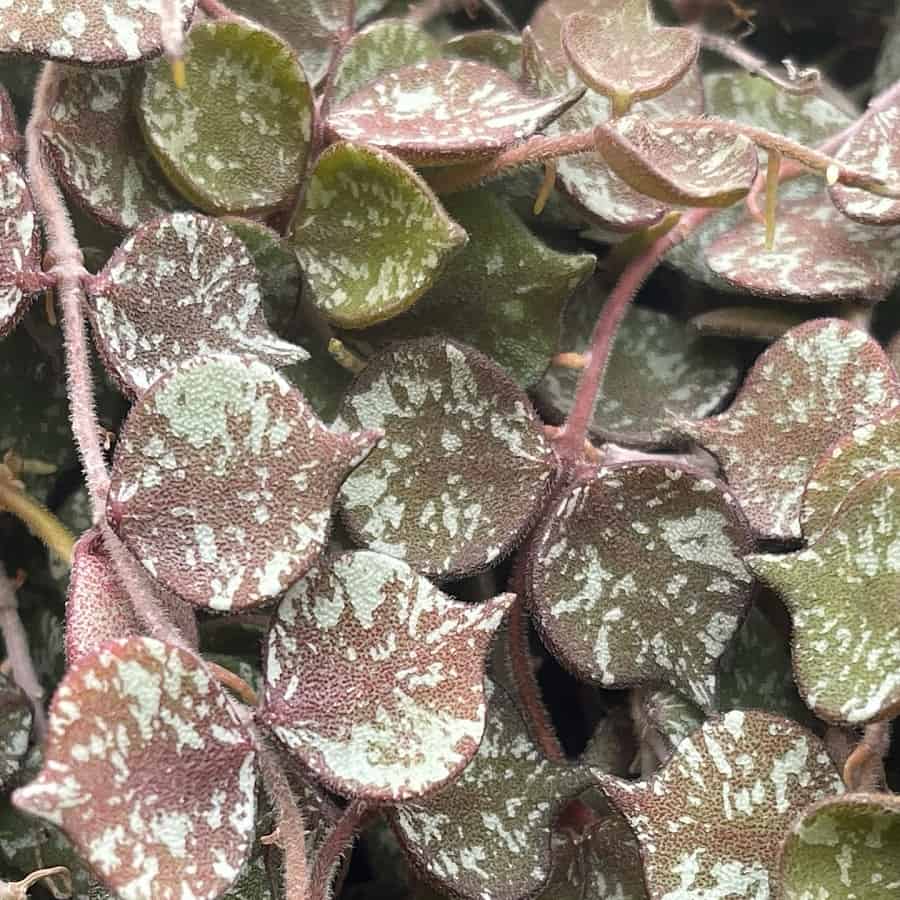
Hoya curtisii is a small-leaved plant that grows as an epiphyte in the tropical forests of Thailand, Peninsular Malaysia, the Philippines, and Borneo. It clings to the bark of trees or rocks with aerial roots and has thick, mottled leaves that are plump and triangular in shape.
The flowers of Hoya curtisii grow in a convex umbel with pedicels 2.5 cm long, consisting of 5-20 fairly large flowers that are sometimes pinkish-violet on the outside. The corolla is bent back with spatulate lobes that are covered in short hairs, and the crown of the flower is pink with a bright pink spot in the center.
Hoya cystiantha
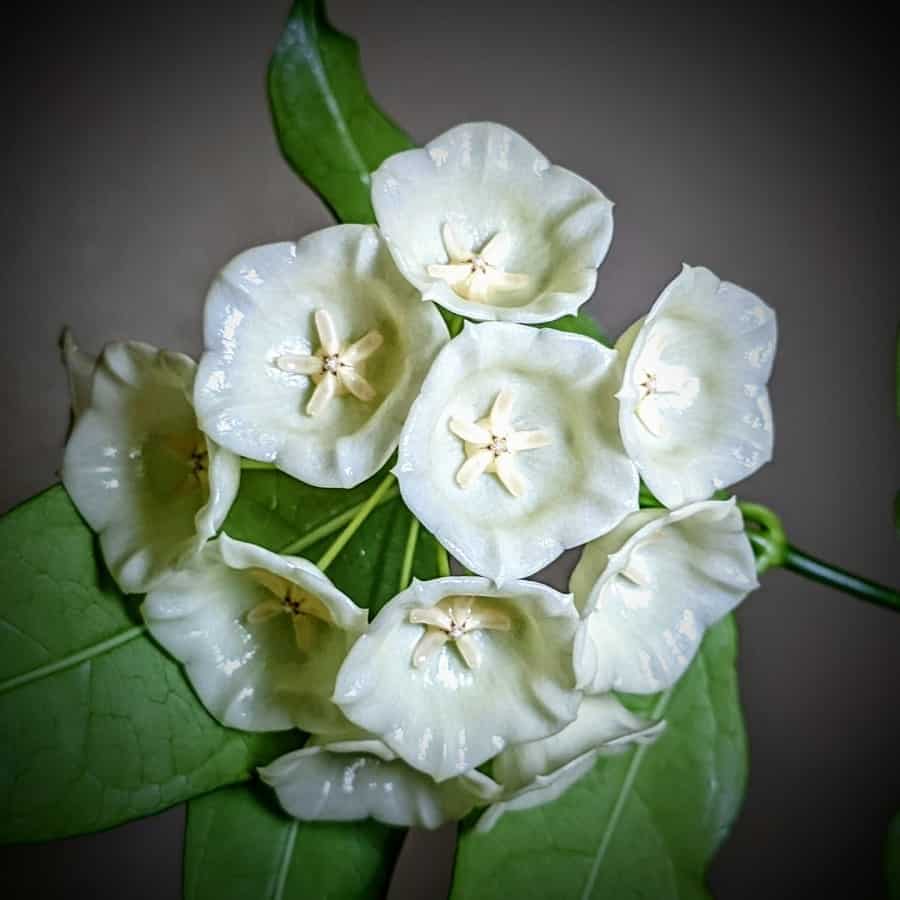
Hoya danumensis
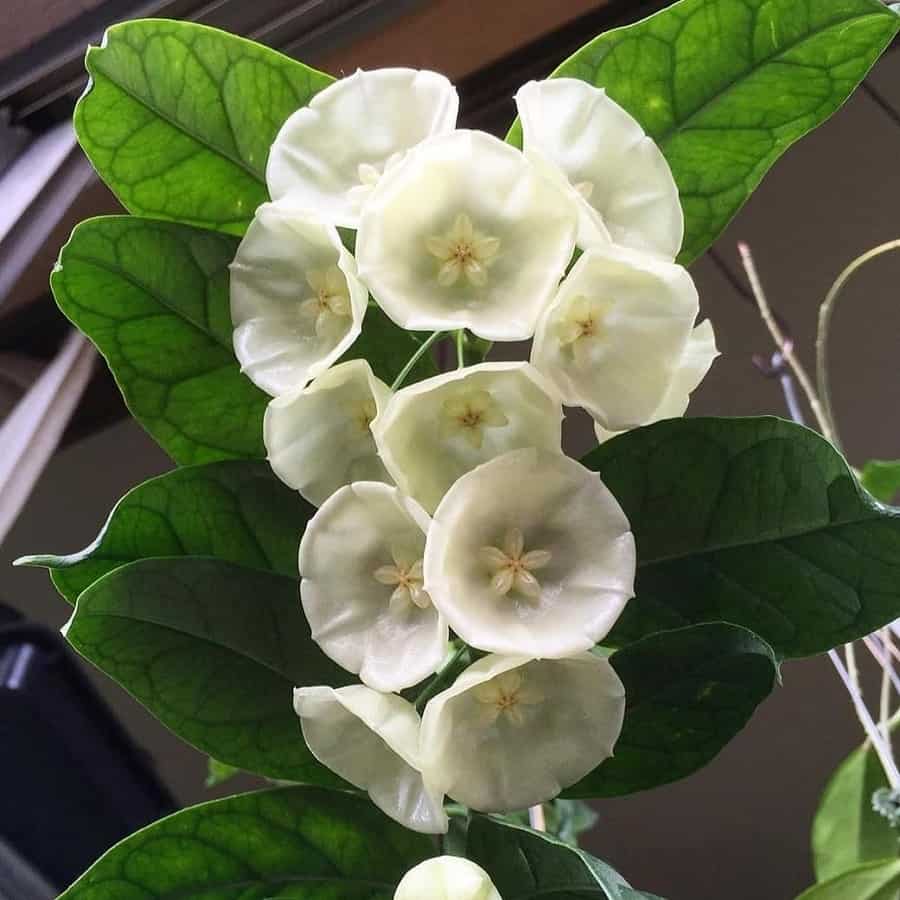
Hoya danumensis is a unique plant species found in the lush jungles of Borneo. It was discovered in the Danum Valley of Sabah, Borneo on September 3, 2008, and got its name from its natural habitat. It grows as a shrub and tries to wrap itself around objects with its long vines. Its leaves are dark green and thin with pinnate venation. It produces beautiful, white, bell-shaped flowers that have a citrus-like aroma, and they bloom for only three days. To keep Hoya danumensis healthy and blooming, it’s essential to keep the soil consistently moist.
Hoya darwinii
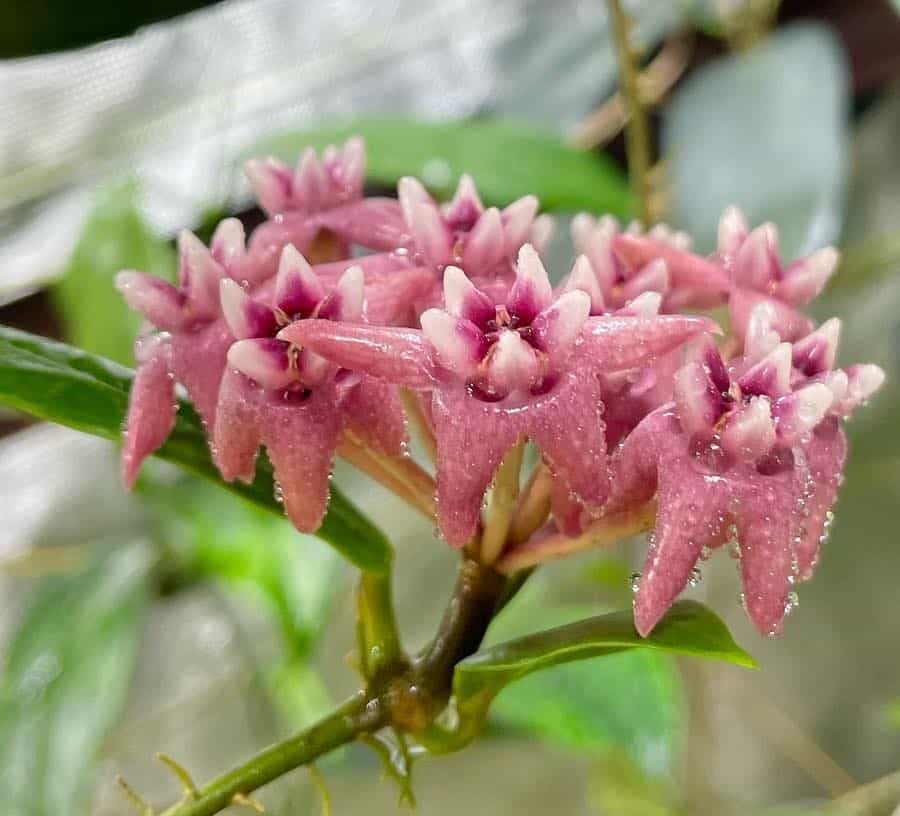
Hoya darwinii is a unique and interesting plant that grows in the Philippine archipelago and Sabah. It has a symbiotic relationship with ants and forms an ant nest from its leaves. The leaves grow into a ball shape and change color to create a porous, dark green cavity for the ants. The plant has smooth, silky leaves and produces beautiful pink flowers with a dark red spot in the center. It can flower all year round and there are different versions of the plant with varying shades of pink.
Hoya dasyantha
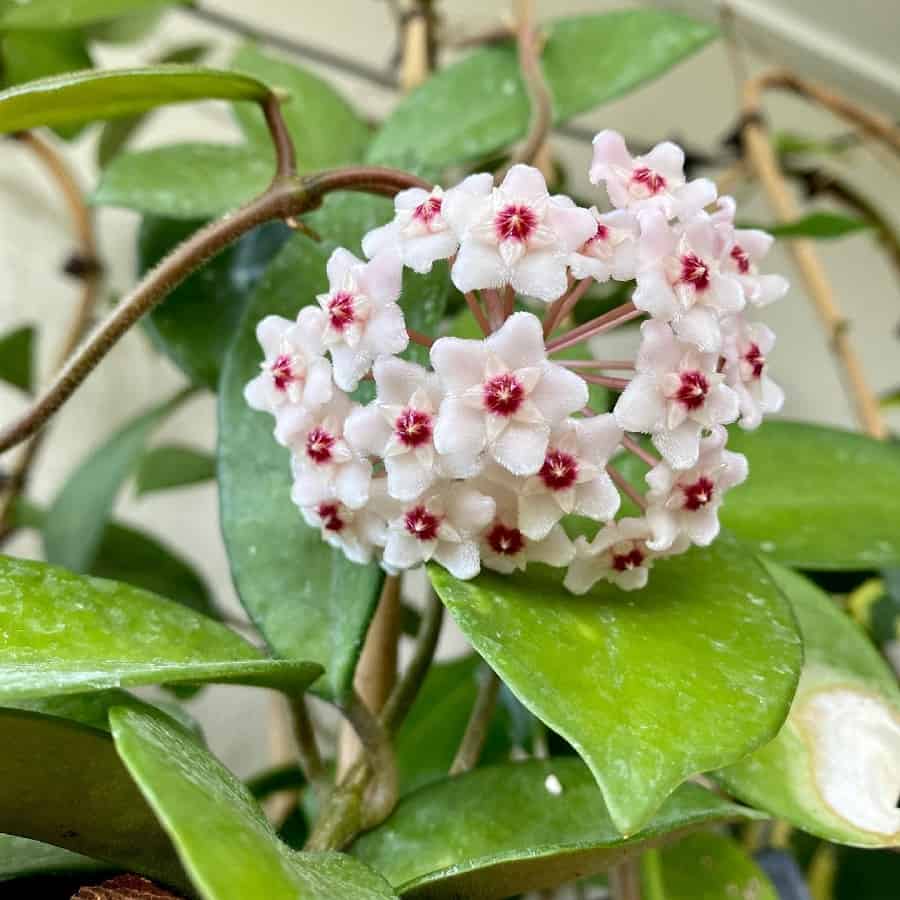
Hoya dasyantha is a beautiful, easy-to-care-for houseplant from China. Its leaves are glossy and its flowers are white with yellow and red centers, and resemble wax. They grow in clusters and are heavily scented, with the scent being strongest in the evening. The flowers bloom from spring to late summer and can last for several weeks. This plant is perfect for a hanging basket or a pot and will provide you with a lovely fragrance and unique beauty.
Hoya davidcummingii
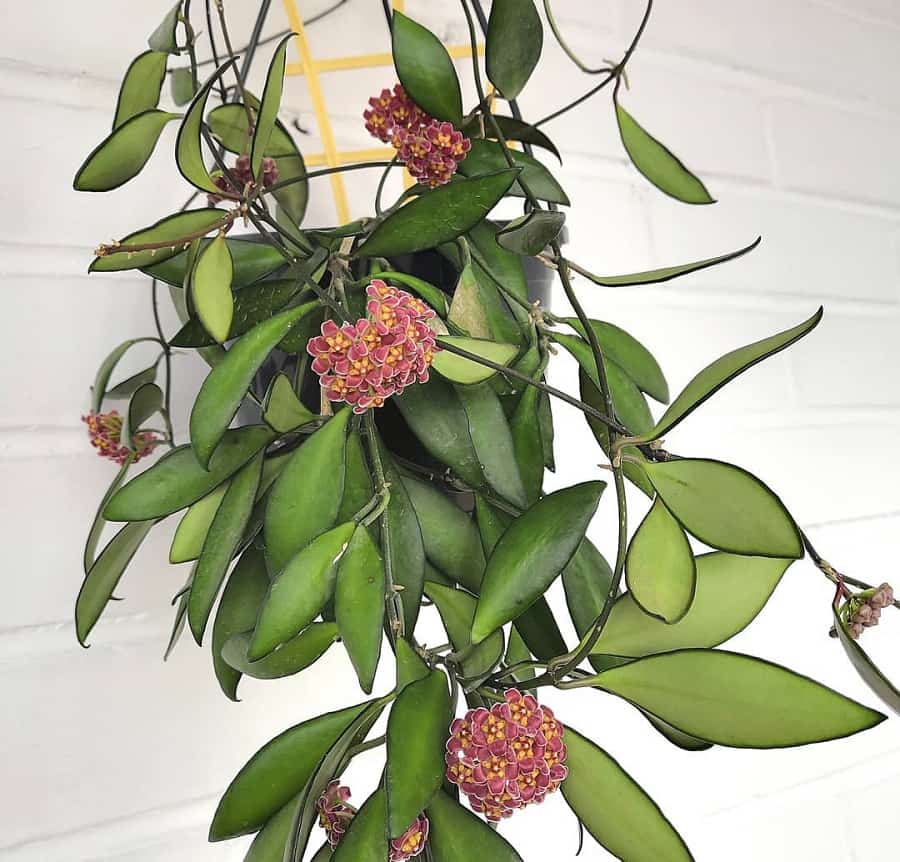
Hoya davidcummingii is a rare and beautiful plant named after the Australian collector David Cumming who found it in the Philippines. It is known for its lanceolate-oval leaves and salmon-pink flowers with a contrasting yellow center. The flowers are unique and beautiful, with partially folded back corolla blades. This plant is easy to grow, blooms quickly, and tolerates drying of the soil. It requires a lot of light for normal growth, and has a caramel-like scent in the evenings. If you are a plant collector, Hoya davidcummingii is a must-have for your collection!
Hoya dennisii
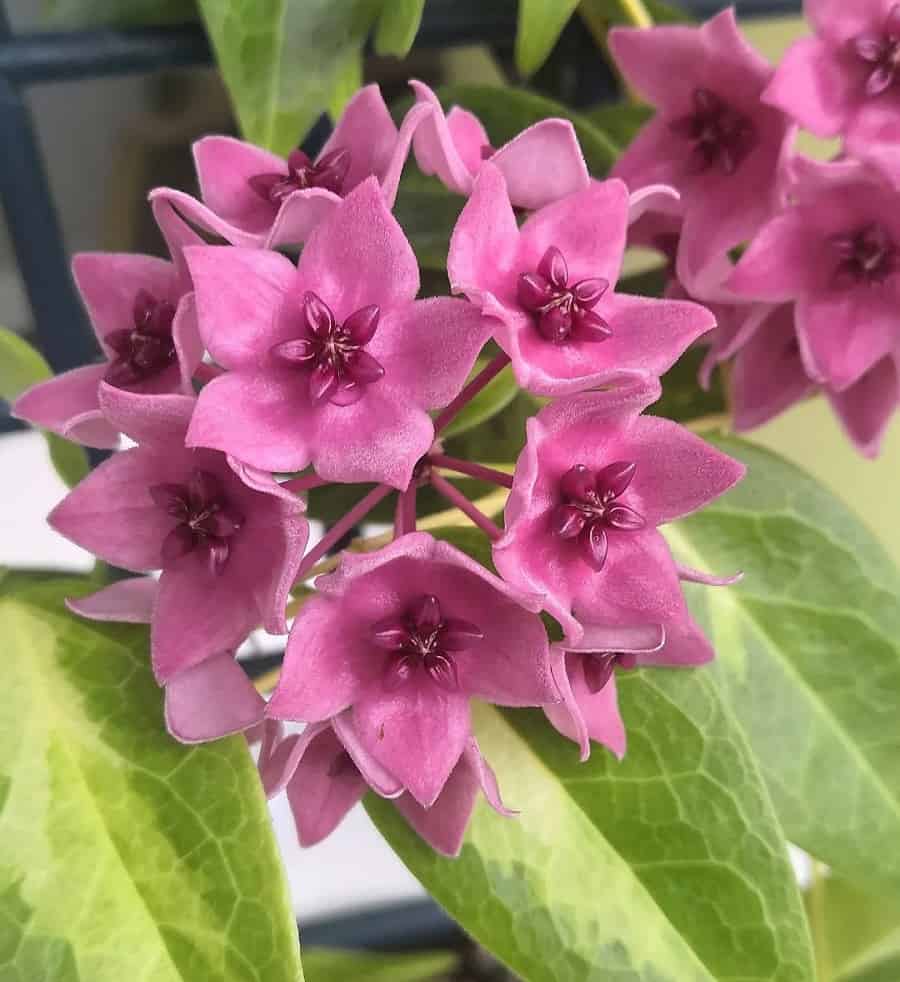
Hoya dennisii is a beautiful epiphytic plant native to the Solomon Islands, growing on the trunks and branches of rainforest trees. Named after Geoff Dennis, it has tough, dark green leaves with lovely pinnate venation and blooms 12-15 individual bell-shaped flowers that are bright pink with a dark pink crown. The corolla petals are papillose and pubescent inside, and the flowering lasts for 10-12 days with a weak, sweetish fragrance that is noticeable only at night. Found by Timothy Whitmore in the mountains at an altitude of over 1500 meters above sea level, Hoya dennisii is a unique and stunning addition to any collection.
Hoya densifolia
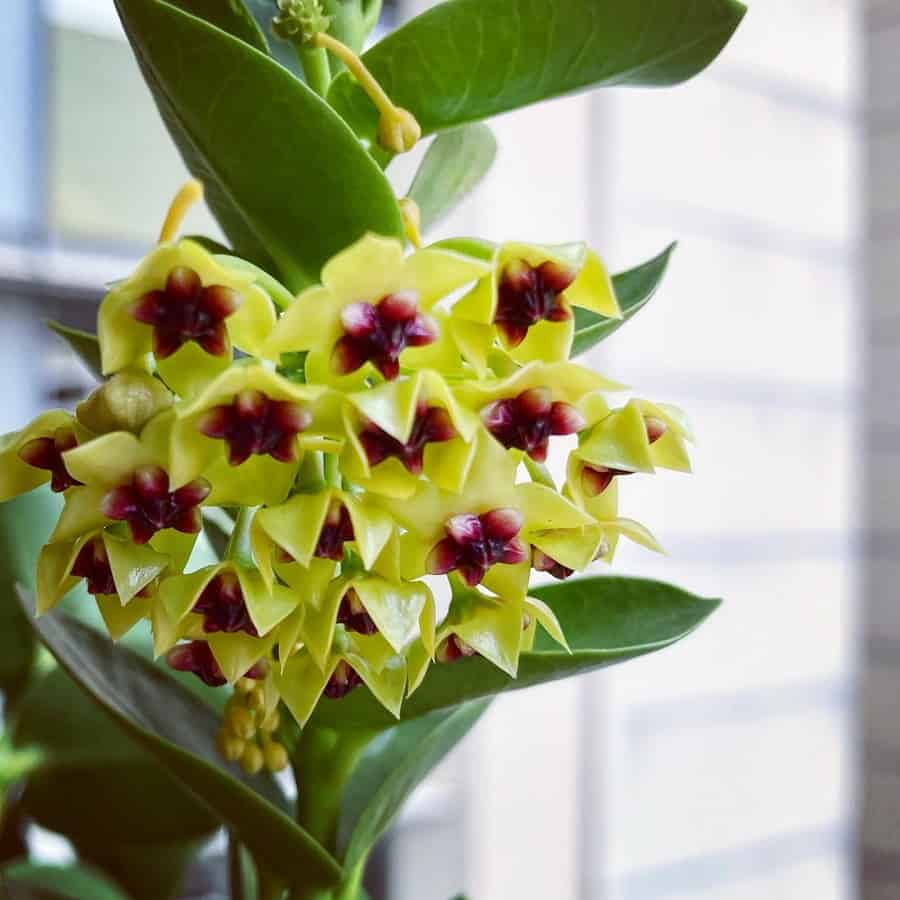
Hoya densifolia is a stunning plant with beautiful lemon-yellow flowers that have red centers. It grows like a shrub with upright stems that can reach 1 meter in length. The leaves are ovate and light to mid-green, measuring up to 6cm long by 4cm wide. They have a mid-rib on the upper surface that is sunken and light green.
The flowers have a heavy, gardenia-like scent and the corolla is reflexed and incurved at full bloom, with a pale green to yellow color. The corona is very pale pink and flushed with red-dark red towards the center of the flower.
Hoya densifolia is relatively easy to grow and does best in filtered light or lots of bright indirect light. It likes a good airy mix and should be watered when dry. This plant can withstand high temperatures and won’t complain even if the temperature goes above 95°F. Note: Some experts are still reviewing the identity of Hoya densifolia and Hoya cummingiana and consider them to be synonymous.
Hoya deykeae
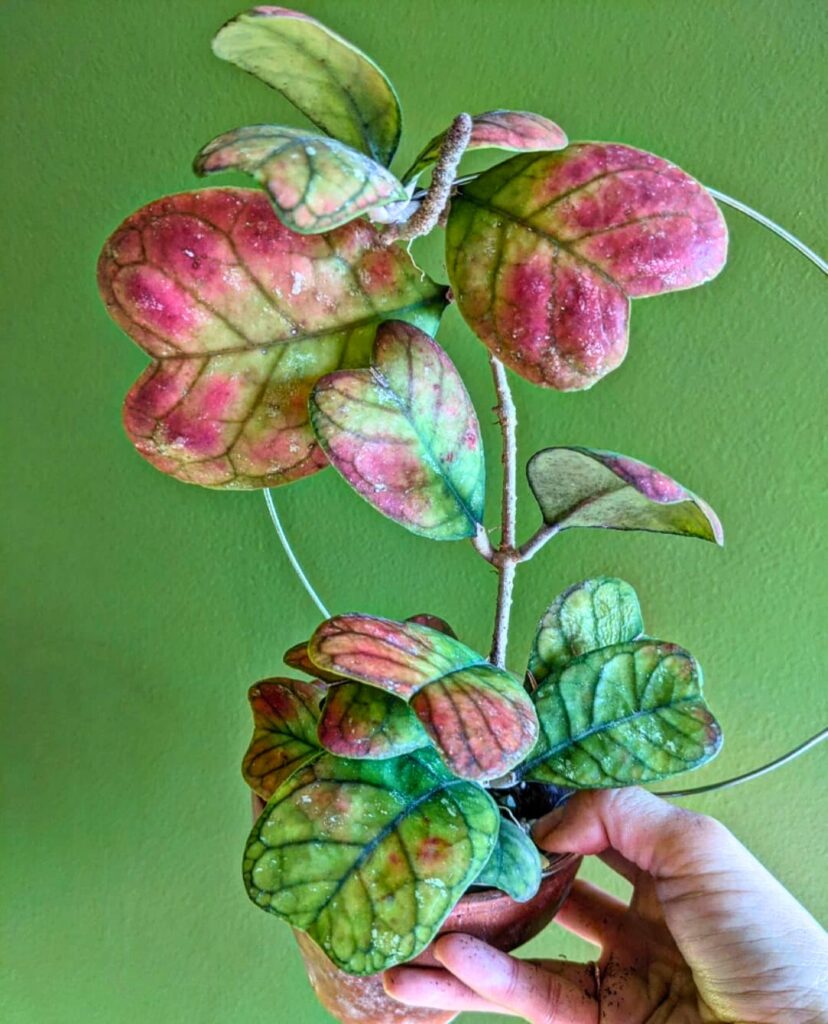
Hoya deykeae, native to Sumatra, is an exceptional Hoya variety with flowers that are lightly perfumed, typically cream-white or yellow, and bloom in clusters. Originally named Hoya Dekei in honor of Deyke van Donkelaar, the name was altered to comply with ICFN rules. This plant takes on the shape of Hoya kerrii but has vein colors reminiscent of Hoya callistophylla, while genetically sharing more characteristics with Hoya vitellinoides. Deykeae is rare and not commonly available for purchase due to its obscurity. It prefers a slightly drier environment to avoid overwatering, which can quickly yellow the leaves. Despite its sensitivity, Deykeae is relatively straightforward to care for and blooms easily, making it a prized plant for enthusiasts.
Hoya deykei
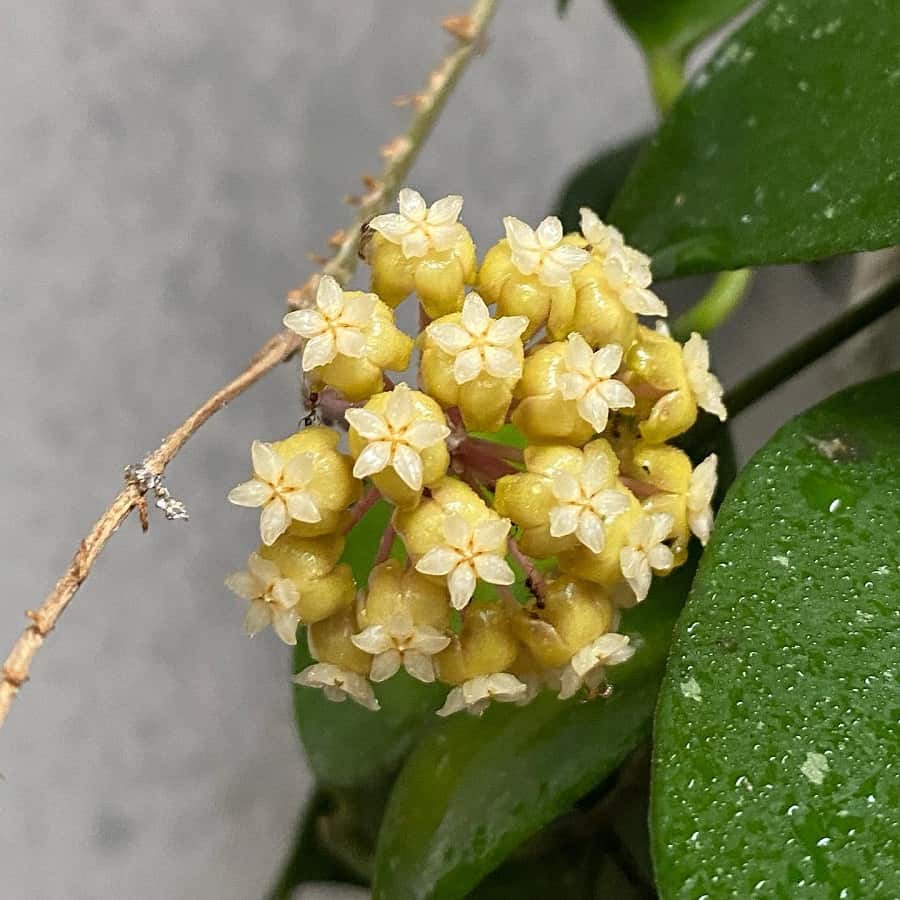
Hoya deykei is a stunning vining plant that hails from the island of Sumatra in Indonesia. This epiphytic beauty belongs to the dogbane family, Apocynaceae, and is known for its attractive waxy foliage and sweetly scented flowers. Botanist Ted Green discovered this plant and originally intended the name to be H. deykeae, however a mix-up with Latin grammar resulted in the name H. deykei.
This plant is a true feast for the senses, with its clusters of star-shaped flowers that look like they are made of wax. The flowers are light creamy yellow in color with peach centers and a smooth surface, lacking the tiny hairs found in many other species of Hoya. The scent of the flowers is what really sets H. deykei apart, with a heavy lime fragrance that is strongest in the early evening.
Like all species of Hoya, H. deykei flowers from spurs that emerge from the axils of the leaves and stem. It may take some time for the buds to emerge, but once they do, the plant produces clusters of 15 to 30 small flowers that mature gradually over a period of 2 to 3 weeks. The plant flowers from spring to late summer, and it is important to leave the spurs undamaged so that new flowers can be produced each season.
Hoya dickasoniana
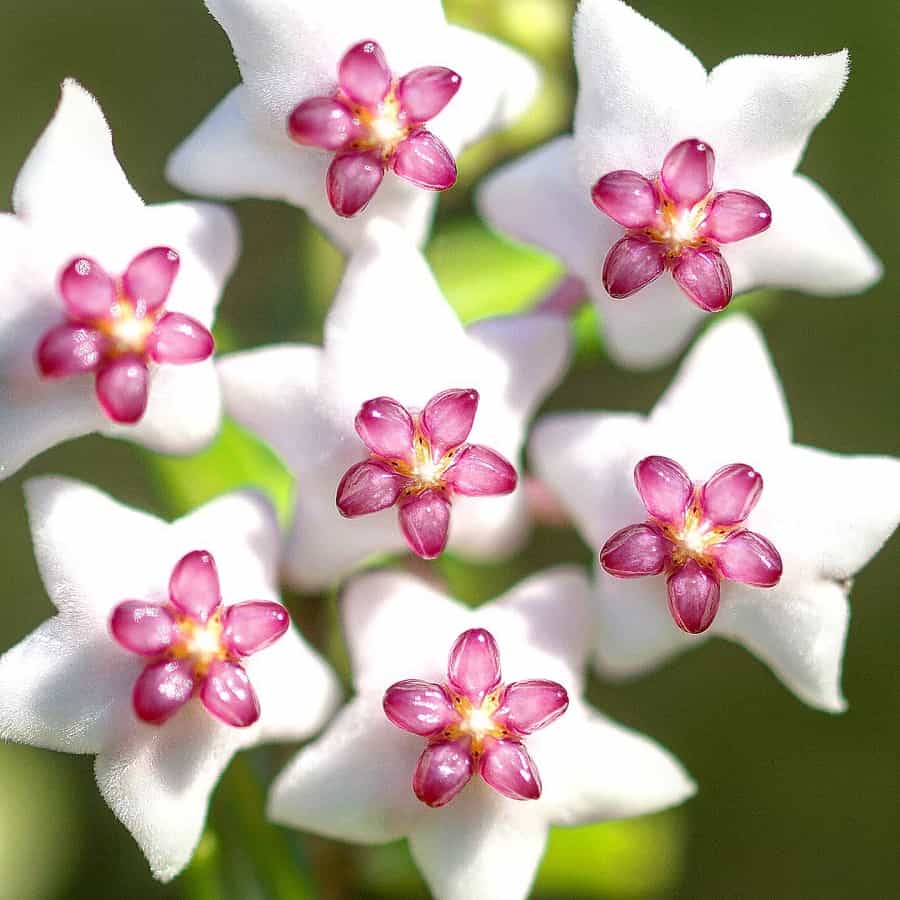
Hoya dimorpha

Hoya dimorpha is a mysterious beauty from the island of New Guinea that is often mistaken for other hoyas. Despite the lack of information available on the web, this hoya is truly a gem. The leaves of this slow-growing plant are a striking dark green with visible veins, becoming lighter and shinier as they grow. The leaves can also turn red when exposed to the sun.
The flowers of Hoya dimorpha are a true work of art. They are almost flat and come in a variety of shades, ranging from mostly yellow to a peachy color with a touch of red in the center. With 15 to 25 flowers in each umbel, this hoya truly transforms into a stunning bouquet. Although the flowers produce little nectar, they last for 4 to 5 days and emit a soft, unidentifiable fragrance.
Despite its elusive identity, Hoya dimorpha remains a rare and exquisite plant to have in your collection.
Hoya diptera
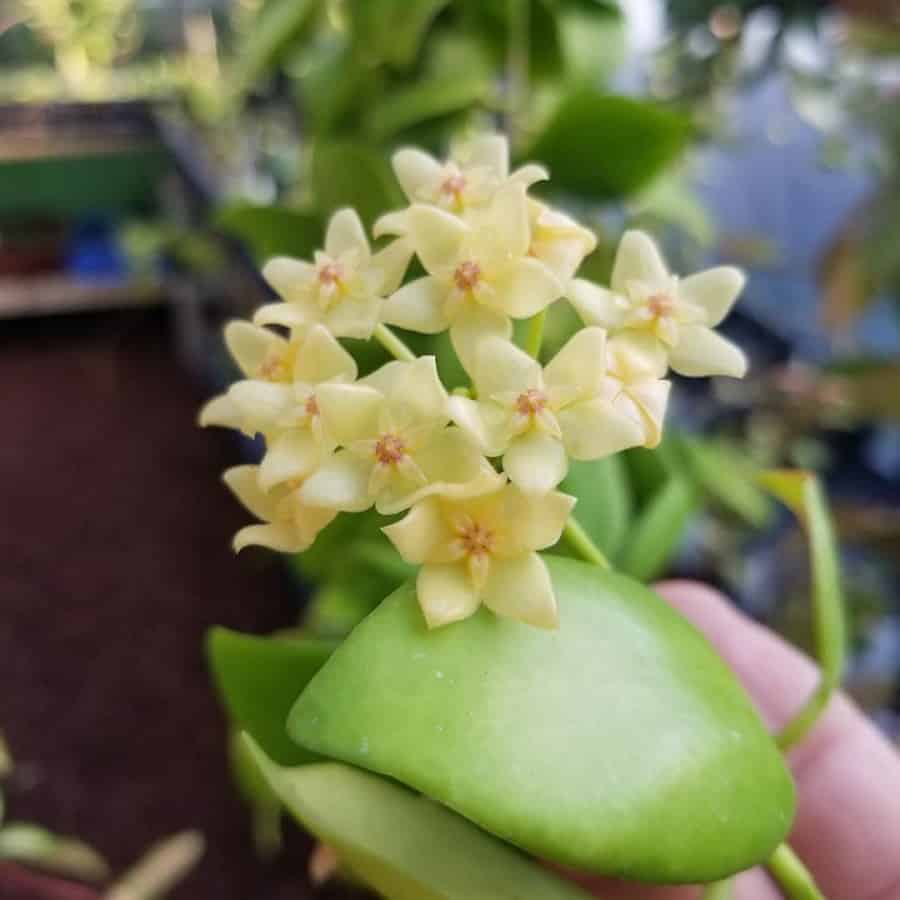
Hoya diptera is a captivating climbing plant, native to the beautiful Fiji Islands. With its long, slender stems, it weaves its way through the branches of trees, hanging down gracefully like a green waterfall. Its leaves are light green, oval-shaped and with a matte surface, giving it a natural, earthy vibe. The veins on the leaves are hard to distinguish and the occasional speck is a rare sight.
The flowers of Hoya diptera are a standout feature. It produces 5-15 flat flowers, about 2 cm in diameter, with color that varies from light yellow to yellow-green. The crown of the flower can be completely yellow or with a red center, adding an extra pop of color to the already stunning plant. Although it is believed to be an easy-flowering hoya, flowering cases in indoor environments may be scarce. Regardless, Hoya diptera is a fast-growing plant and in ideal conditions, it will quickly gain green mass.
Hoya dischorensis

Hoya dischorensis is a climbing plant with wiry branches and dark green, smooth leaves that can grow up to 12cm x 6cm. Young leaves are bronze-colored. Flowers are 12mm in diameter, golden-colored with reflexed petals and a matching darker corona. With up to 35 flowers in each umbel, Hoya dischorensis offers a sweet fragrance and frequent blooms. Native to Papua New Guinea, this intermediate grower requires warmth in cooler climates.
Hoya diversifolia
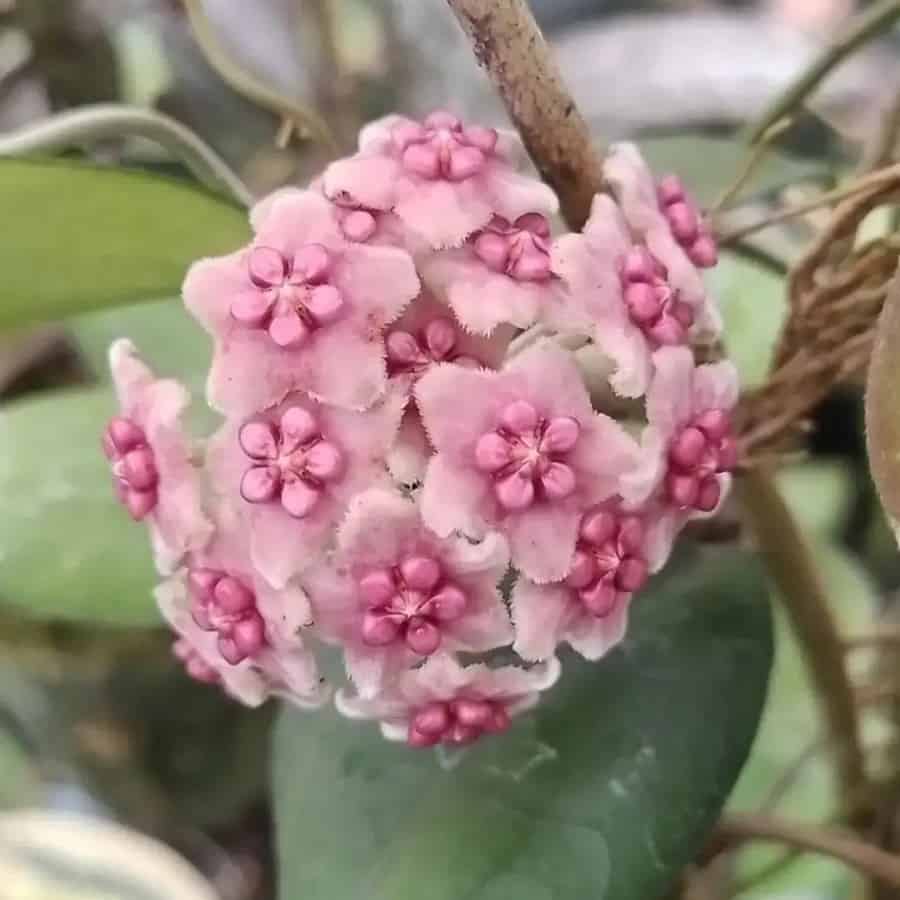
Hoya diversifolia is a versatile plant that grows both as an epiphyte on trees and as a terrestrial vine near the sea. It can be found in many places, including Singapore, Malaysia, and Java, with local names like Akar Sesudu Bukit. With a thin and smooth stem, it produces adventitious roots along its entire length.
The leaves are oval or oval-oblong, fleshy and smooth with rounded or wedge-shaped base and blunt or pointed tip. The plant produces 1 to 20 flowers per inflorescence, which are creamy pink or lilac pink with a pale pink crown. To make it bloom, it’s necessary to maintain at least 50% humidity in the room.
Hoya dolichosparte
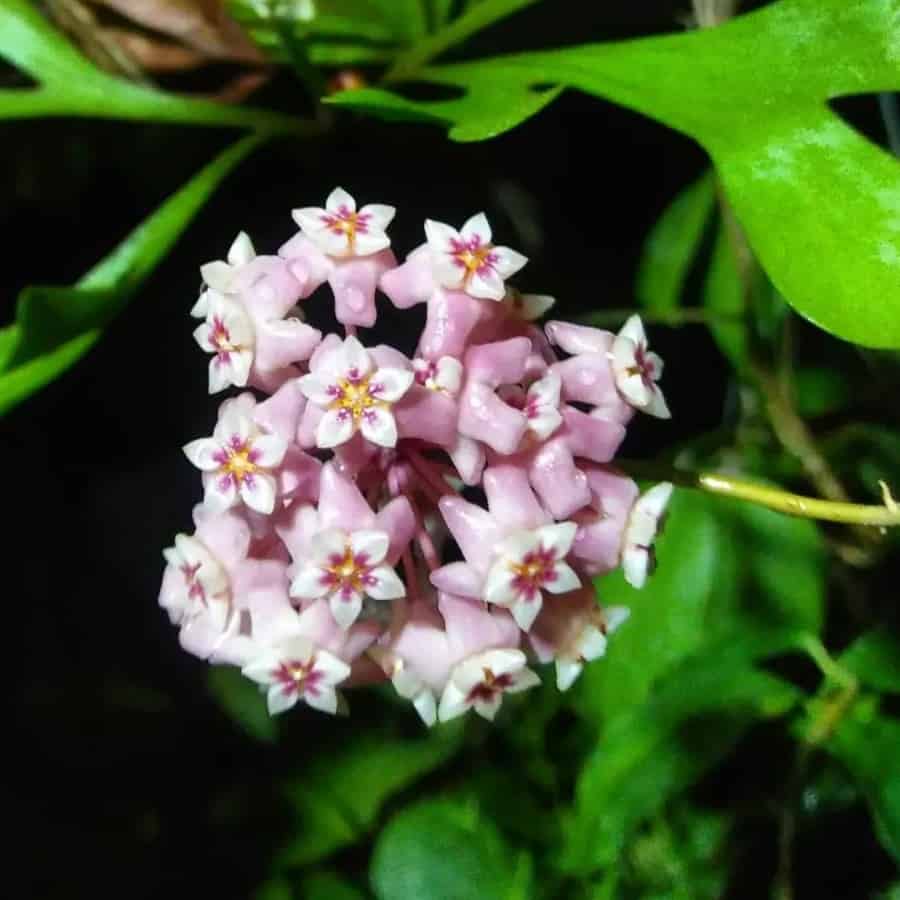
Hoya dolichosparte is a fascinating plant, hailing from the Indonesian island of Sulawesi. It features a unique combination of star-shaped flowers in pale green-yellow, with crimson-centered white coronas that produce sweet-smelling nectar. The leaves are dark green, stiff and glossy, and turn a beautiful tan color in bright light. With up to 30 flowers per umbel, Hoya dolichosparte is a stunning addition to any indoor garden.
Hoya DS-70 Variegata
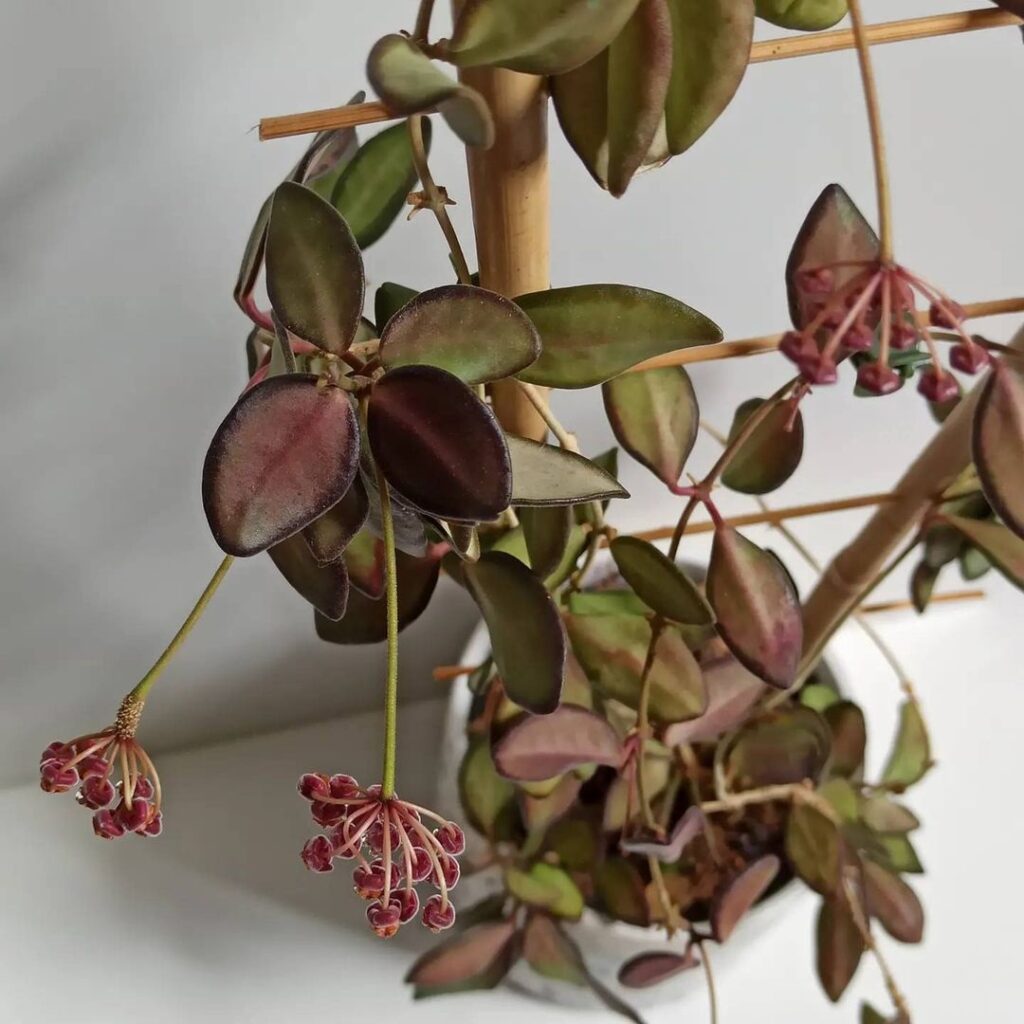
Hoya DS-70 Variegated, also known as Hoya DS-70 ‘Variegata’, is a rare and visually captivating variety native to the Philippines. It features olive green, pubescent leaves that can display stunning red coloring and maroon edges when exposed to high light levels, with a prominent center vein setting it apart from similar species. The variegated version is particularly striking, with a bold yellow streak down the middle of the leaves. This trailing plant is ideal for hanging baskets or high shelves, where its vines can drape gracefully. It blooms with clusters of wax-like flowers, adding an extra layer of beauty to its already impressive foliage.
Hoya edanoi
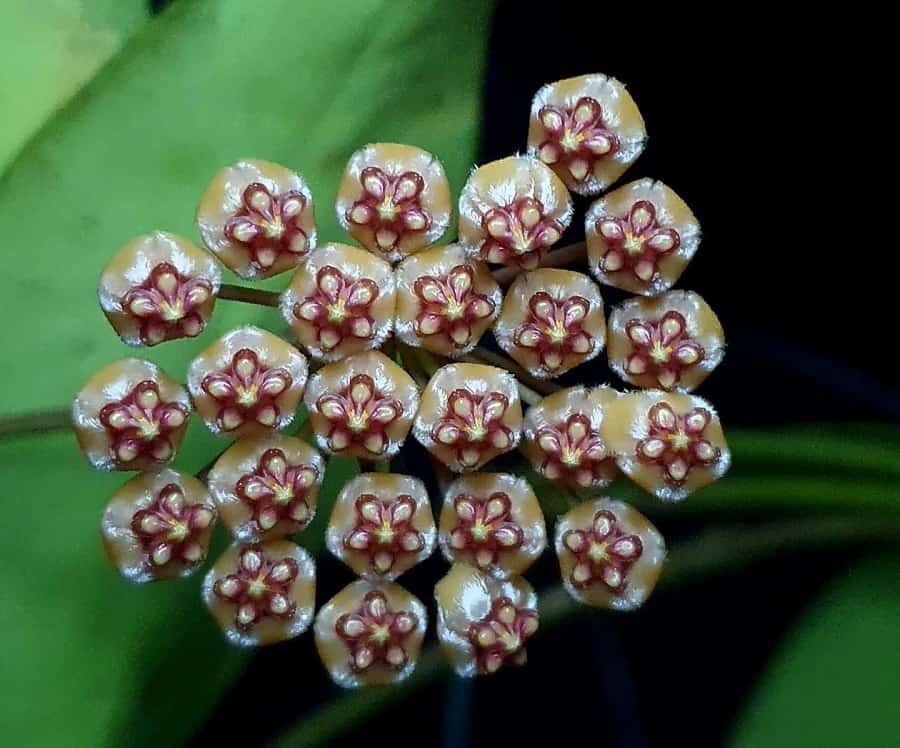
Hoya eitapensis
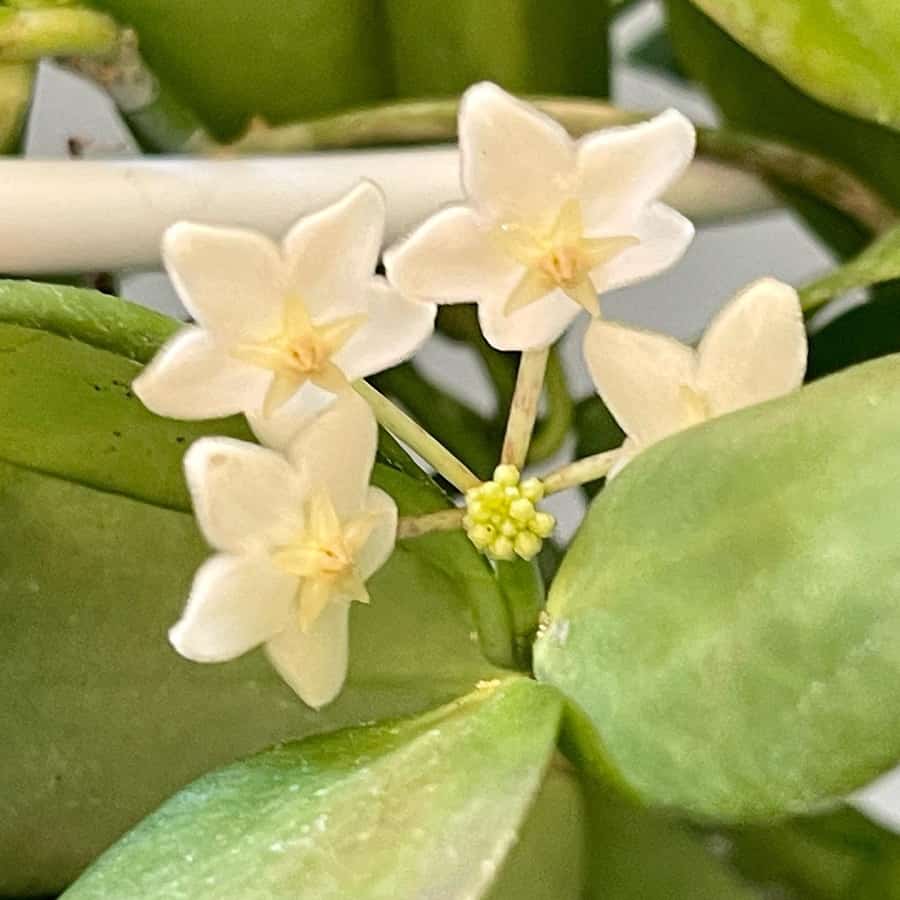
Hoya eitapensis is a unique climbing hoya from New Guinea with dainty light green leaves. The leaves change to a beautiful red hue when exposed to bright light. The star-shaped flowers resemble those of Hoya anulata, with white corolla and yellow corona, and have a delicate fragrance that lasts for a week. Despite its twining limitations, this hoya is a charming addition to any collection.
Hoya elliptica
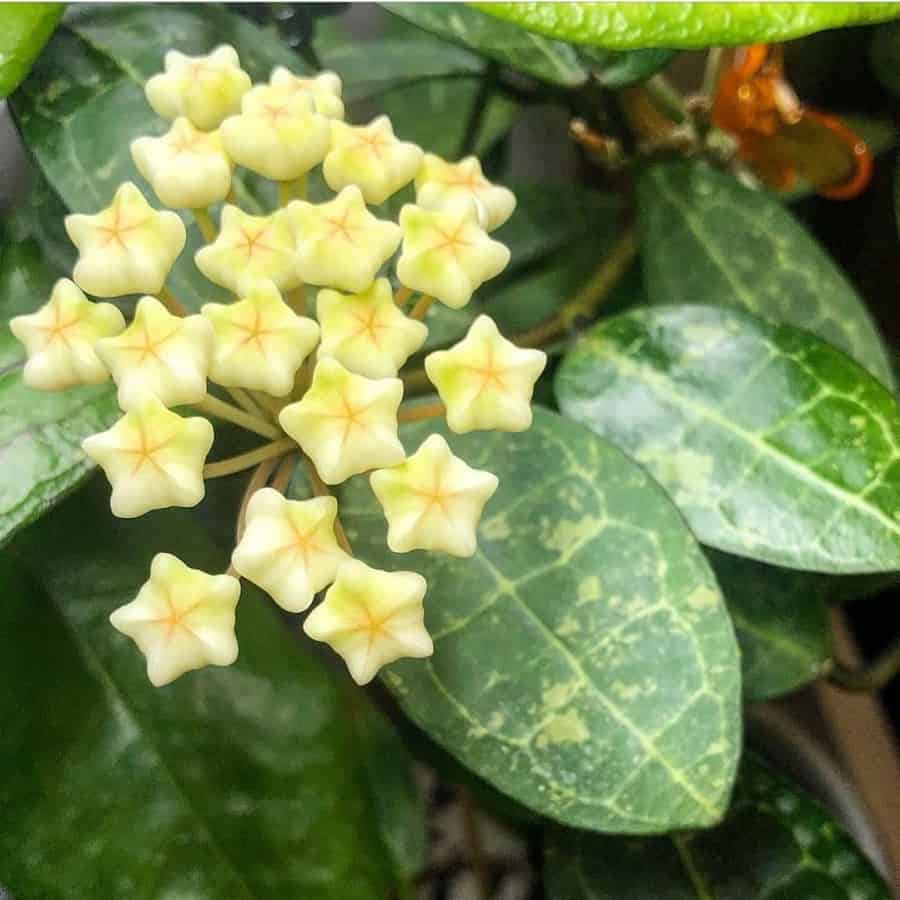
Hoya elliptica is a rare but widespread species native to Southeast Asia. This medium-sized epiphyte features elliptical, fleshy light green leaves with a clear pinnatiform venation. The white, bent back corolla of the flowers have a white crown with elongated lobes and a purple center with bright yellow anthers. Umbels are 4-7 cm in diameter and contain 10-35 individual flowers that are 9-12 mm in diameter. Hoya elliptica is a beautiful addition to any collection and adds a touch of grace with its unique leaves and delicate flowers.
Hoya elmeri
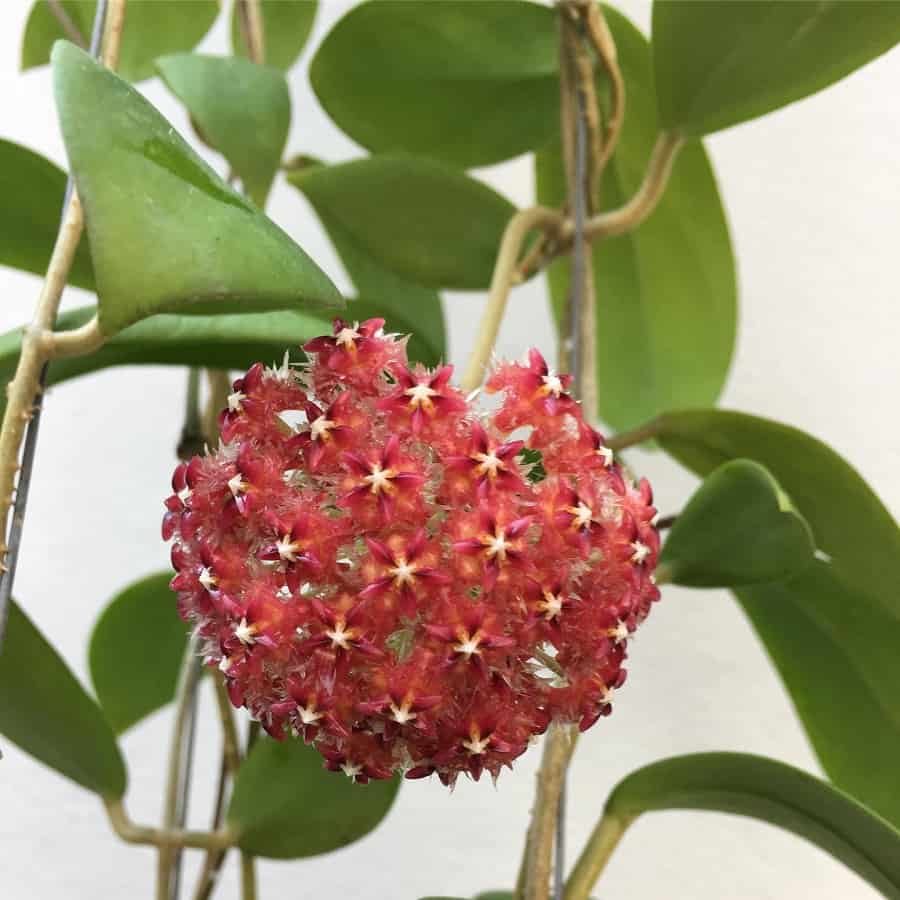
Hoya elmeri is a rare and fascinating hoya species, named after the American botanist ADE Elmer. Found in the lowland forests of Sabah and Luzon, this plant is often seen growing along streams and rivers. With its glossy, dark green leaves measuring 11-15 cm x 5-6.5 cm, Hoya elmeri adds a touch of lush tropical beauty to its surroundings.
During the flowering season, Hoya elmeri produces inflorescences of 15-50 bright red or orange flowers, measuring 8-11 mm in diameter, with a crown of the same color. The flowers have dense hairs on the inside of the petals and are a feast for the eyes and nose, as they emit a lovely fragrance. Despite the loss of the type specimen during World War II, duplicates can still be found in herbariums worldwide.
Hoya endauensis
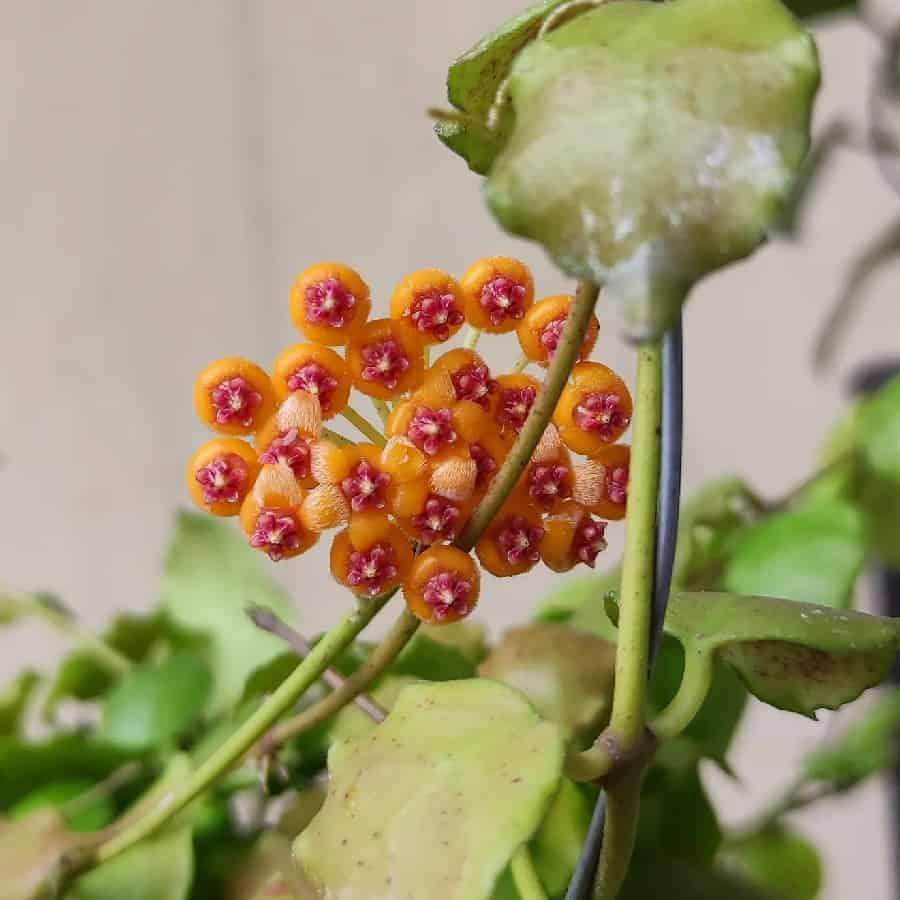
Discover the beauty of Hoya endauensis, a rare species found in the shady areas of the Ulu Endau river in Malaysia. Named after its unique habitat, this epiphytic plant clings to tree trunks with its numerous adventitious roots.
With its smooth stem and ovate-heart-shaped, corrugated leaves, Hoya endauensis stands out from the crowd. Its leaves are yellowish-green with indistinct venation and press against the bark of its host tree in its natural habitat.
Experience the stunning floral display of this plant with its peduncles that hang down, bearing delicate pale green corollas that turn purple towards the center and crowned with a small crown.
Hoya engleriana
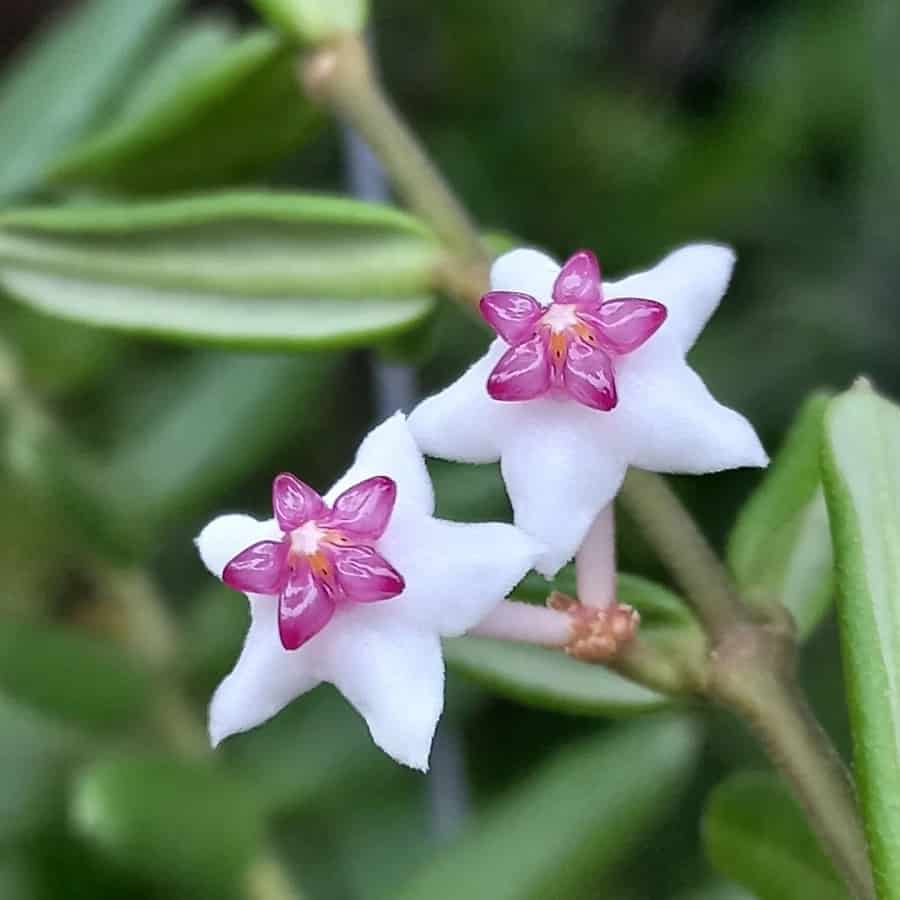
Hoya engleriana is a unique and challenging plant species, native to the high altitudes of Thailand. With its small, spruce-needle-like leaves and upward-growing vines, Hoya engleriana makes for a stunning addition to any plant collection. However, due to its high altitude origins, it requires consistent moisture and cool nighttime temperatures to thrive. The flowers of Hoya engleriana are also a showstopper, with large 2 cm white blooms with pink crowns and a subtle, perfumey aroma. Despite the difficulties in cultivating this variety, the reward is well worth it for the true plant enthusiast.
Hoya erythrina
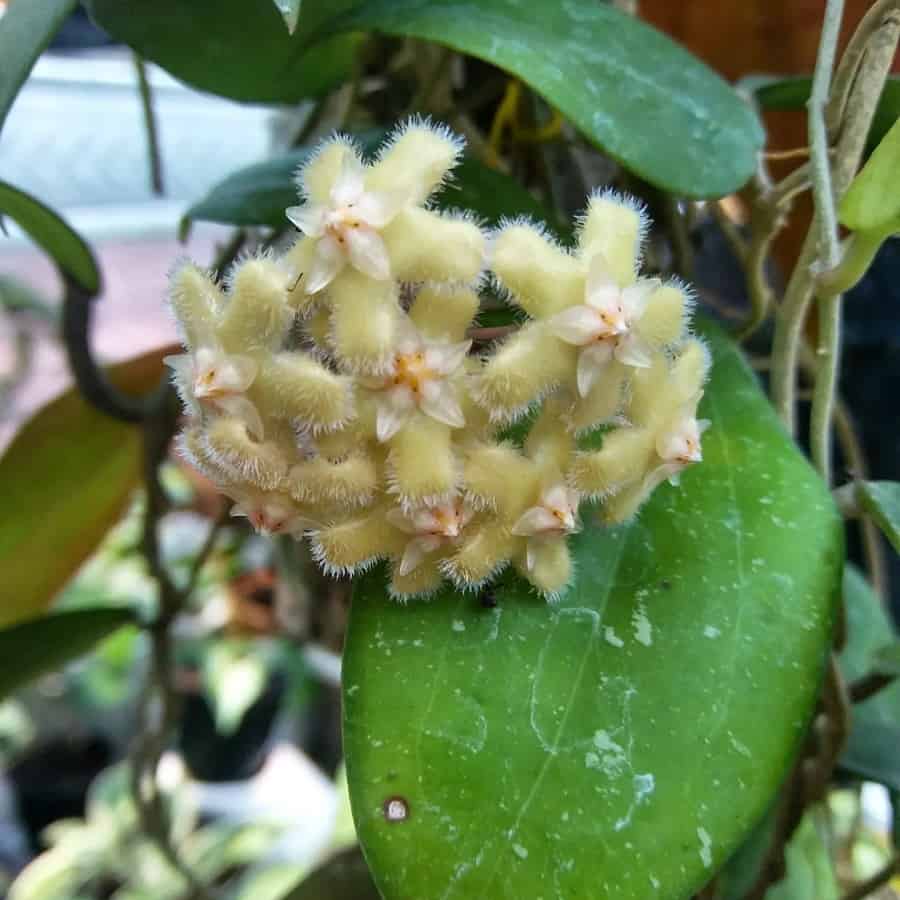
Hoya erythrina is a rare and stunning plant species, native to Vietnam, Thailand, and southern Malaysia. With its gorgeous foliage, characterized by elongated, wavy, silvery green leaves speckled with silver, pink, white, and deep silvery green, this plant is a true beauty in the Hoya world. The delicate pale orange flowers with a white crown may not be particularly showy, but they have an understated beauty all their own.
This species blooms easily and often, with umbrellas of 5-16 small 1.4 cm diameter flowers. Although it is not a fast grower, Hoya erythrina will adapt to any loose, quick-drying substrate. It prefers a slightly shaded area and early morning sun, and flowering lasts up to 4 days with no aroma. Whether grown for its foliage or its flowers, Hoya erythrina is a true gem in any plant collection.
Hoya erythrostemma
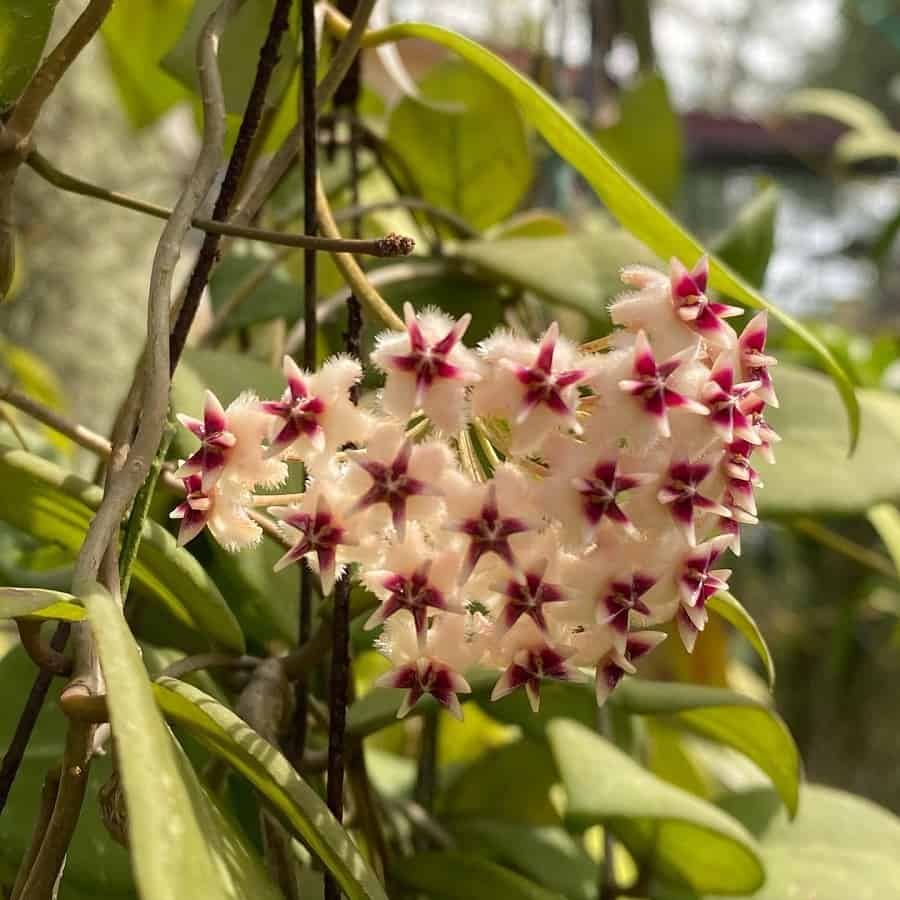
Hoya erythrostemma is a truly unique and captivating species, native to several Southeast Asian countries including Malaysia, Indonesia, Vietnam and Thailand. This climbing epiphyte is often seen lushly draping trees along low-lying rivers, clinging to its surroundings with its slightly angular vines and adventitious roots.
Its leaves are an equally intriguing feature, with their oval shape and gentle point at the top, framed by 5-6 pairs of lateral veins extending from the central vein at a 60-degree angle. When in bloom, the Hoya erythrostemma displays a stunning display of white flowers, sometimes with a touch of yellow or pink, arranged in a convex hemisphere and held aloft on smooth pedicels. The crowns of these flowers are particularly noteworthy, with a wide, pink base and a thin, rich red upper lobe.
Hoya excavata
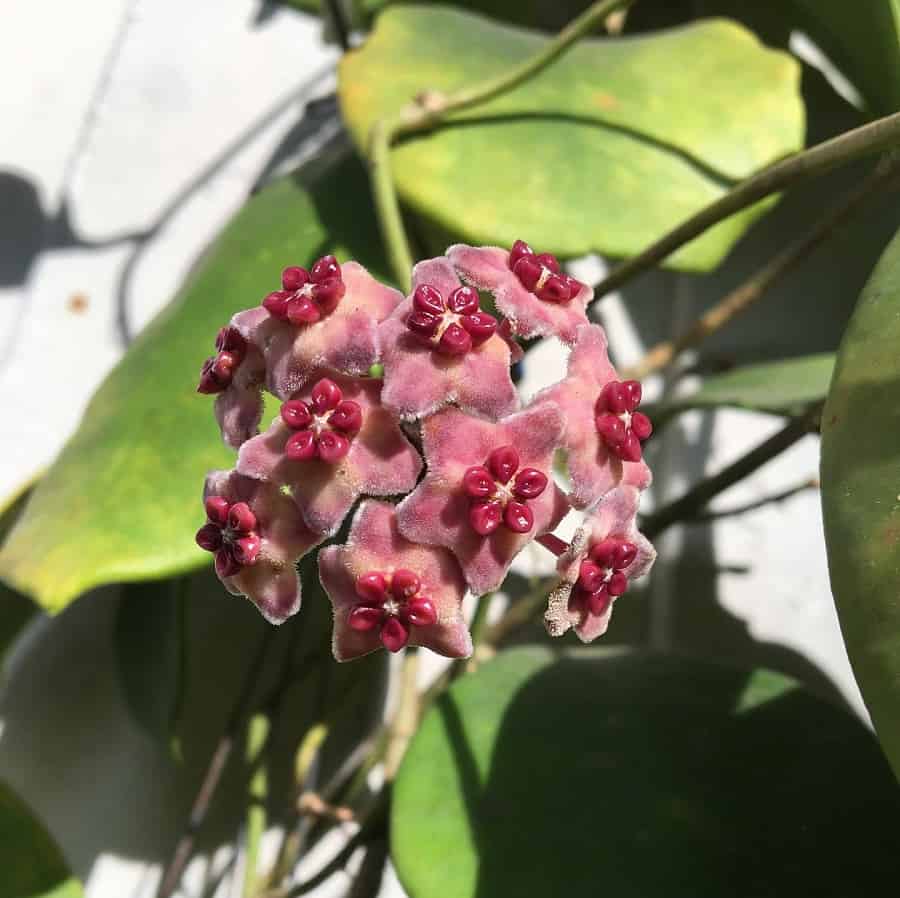
Hoya excavata is a force to be reckoned with in the world of vines. This vigorous species is native to the Borneo island, Okie region, and Molucca archipelago, where it thrives in its natural habitat.
What sets Hoya excavata apart is its striking foliage – large, thick, fleshy leaves that are smooth, glossy, and oval-oblong in shape. These leaves can grow up to 15 cm long and 9 cm wide, making them a true standout feature of the plant.
But the real showstopper of Hoya excavata is its velvety, fleshy flowers. Soft yellow in color and approximately 2 cm in diameter, these blooms feature bluish-white hairs near the base and pale pink tips on the corolla blades. The crown of the flower is fleshy, leathery, and concave on top, with a rich red color that adds to the overall impact.
As a member of the Amblyostemma group, which includes other notable species such as Hoya diversifolia, Hoya meliflua, and Hoya kerrii, Hoya excavata is known for its hardiness and resilience. In fact, it can even recover from being without moisture for 20 days! So if you’re looking for a vine that’s both beautiful and tough, look no further than Hoya excavata.
Hoya exilis
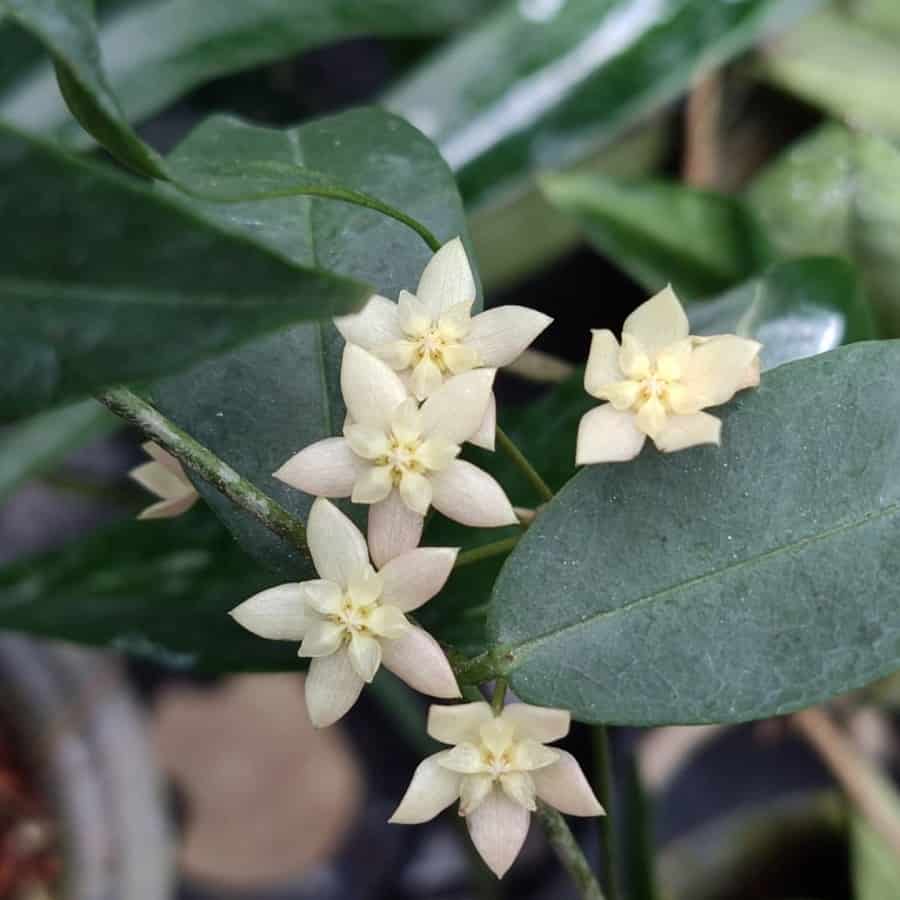
Hoya filiformis
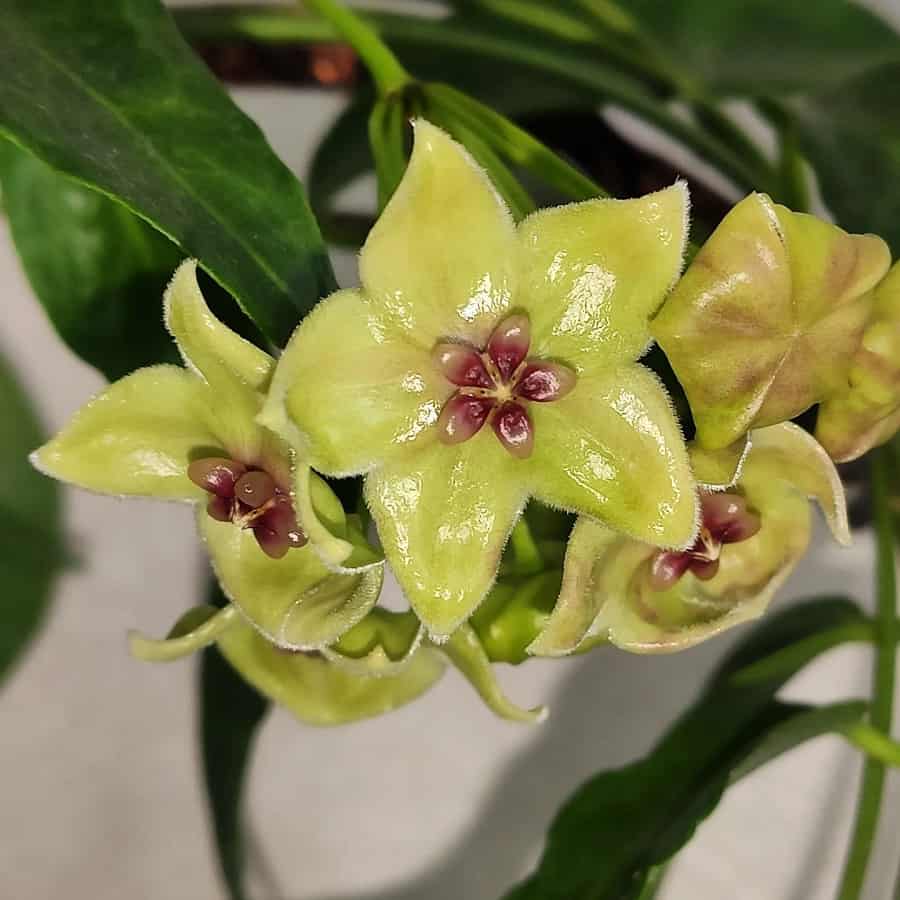
Hoya finlaysonii
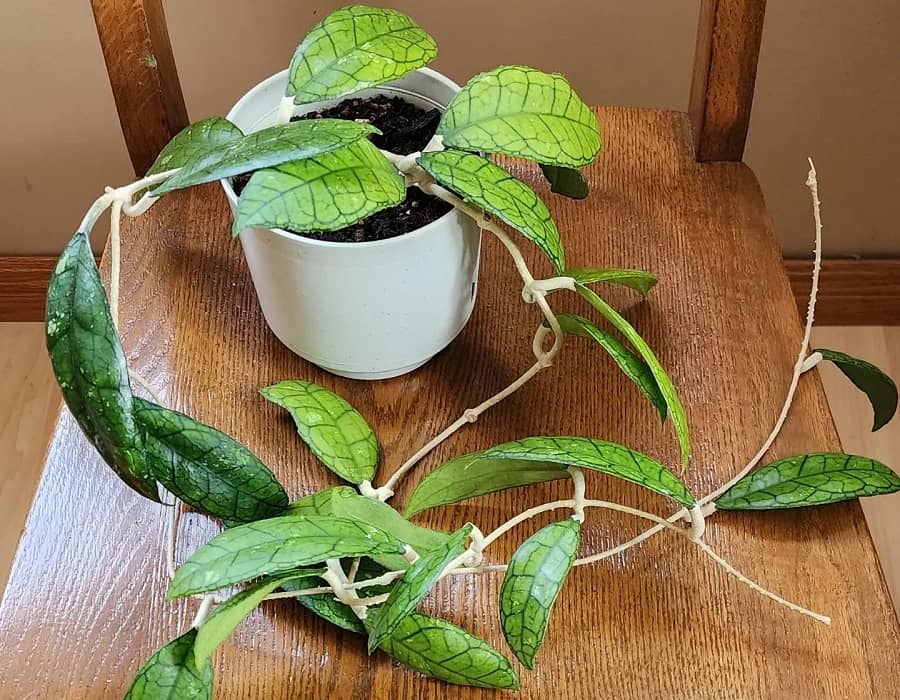
Hoya finlaysonii is a captivating species of epiphyte, named after the botanist Robert Wight who discovered it in the lush forests of Malaysia. Found in the wooded lowlands along rivers and streams, this species boasts a remarkable history and geography, stretching from Penang and Perak in West Malaysia, to Kota Tingri and Johor in the South, all the way to Singapore.
Its stems are long and fluid, reaching up to 5 meters, and adorned with lush, thick, and hard leaves that are oblong-lanceolate, with a deep dark green venation that stands out on the surface of light green leaves. Its unique pinnate venation with 7-9 secondary veins departing from the central vein gives the leaves a stunning appearance that sets it apart from others.
Hoya finlaysonii blooms into stunning, creamy white and yellowish corolla blades with a hint of bronze, and exudes a spicy aroma. These delicate blooms only last for 24 hours, making them a rare and fleeting sight. The presence of long internodes allows the vines to be wound around itself, creating a compact and elegant plant that is perfect for any indoor garden.
Hoya finlaysonii EPC 318
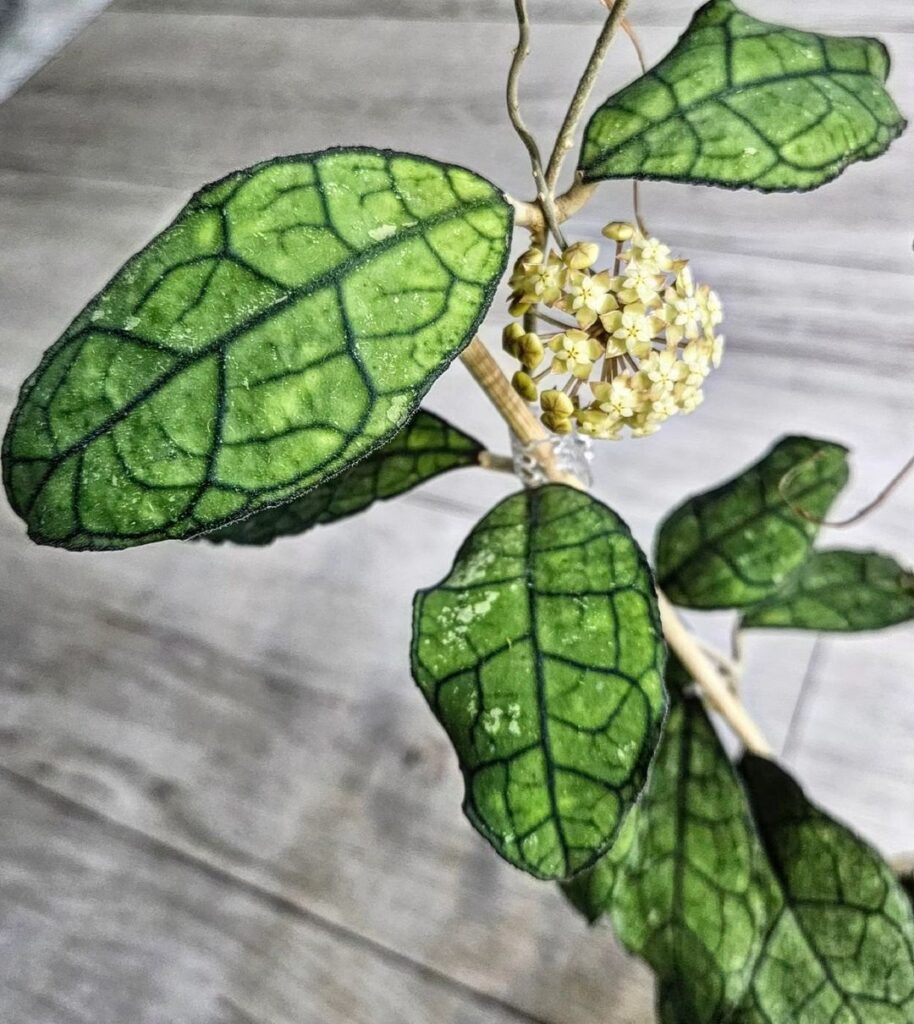
Hoya finlaysonii EPC-318 is a highly sought-after plant, admired for its wide, uniquely shaped dark green leaves with veins and deep maroon undersides. The foliage features silver flecks that add to its distinctive beauty.
Hoya fischeriana

Hoya fitchii
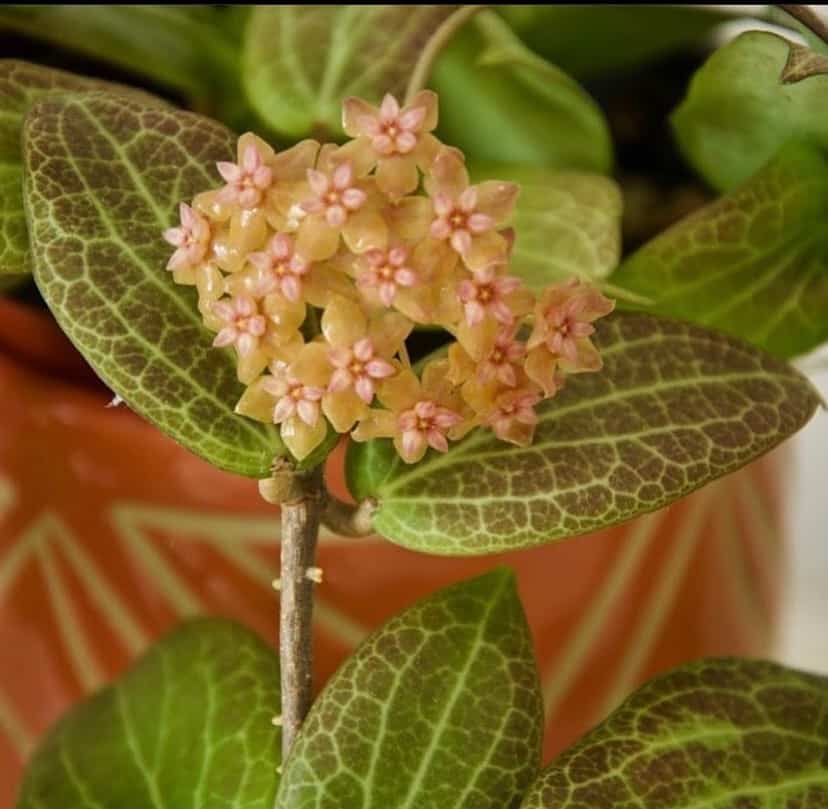
Hoya fitchii is a stunning hoya vine that was first discovered by the talented photographer Charles Marden Fitch in the lush landscapes of Northern Luzon, Philippines. This special hoya was mistakenly named for many years, but was eventually corrected and rightfully named in 2008.
With its smooth and glossy leaves that measure 4-6 cm long and 2.5-3 cm wide, Hoya fitchii adds a touch of elegance to any room. Its leaves are beautifully adorned with a mesh of veins that make it stand out. This hoya flourishes in windows facing east, south or west, and during its flowering season, it produces delicate and colorful blooms that can range from pale cream with pinkish undertones to bright pink. Each flower is 1.2 cm in diameter and arranged in clusters of 10-15, lasting for 4-5 days. Hoya fitchii is a unique and attractive addition to any plant collection.
Hoya flagellata
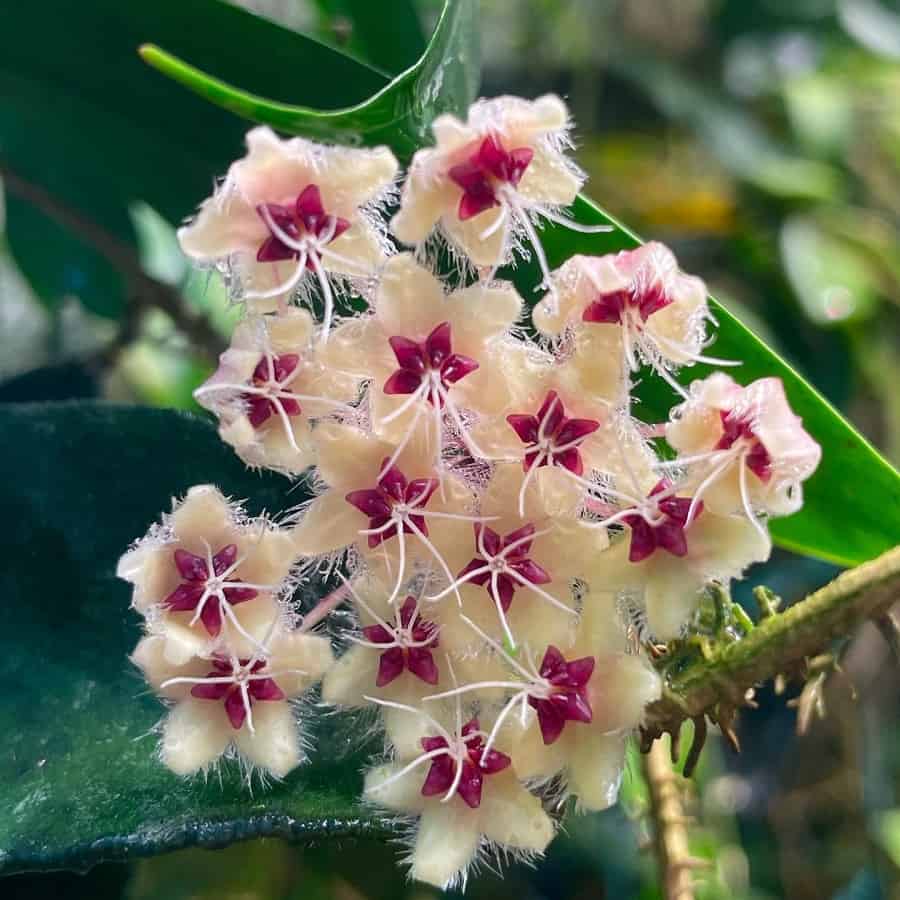
Hoya flavescens
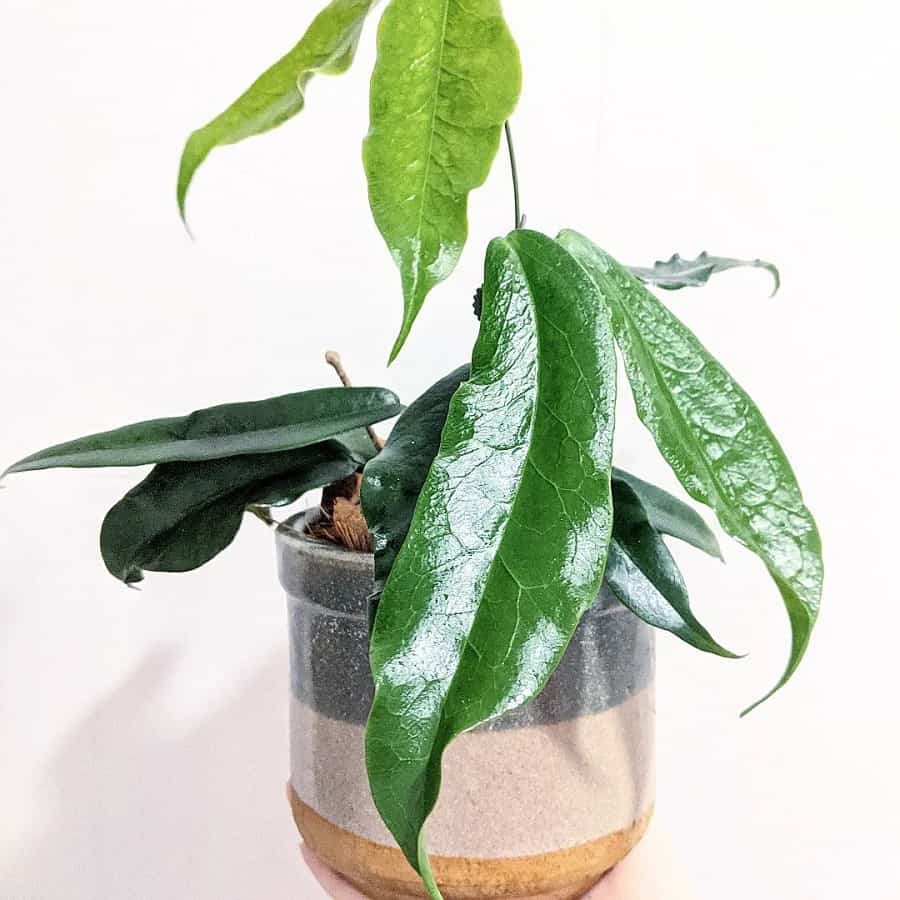
Hoya flavescens is a rare and exotic species of hoya found in the lush forests of the Kani Mountains in Papua New Guinea. With its long, smooth leaves and vibrant yellow flowers, it adds a touch of tropical beauty to any collection. This epiphytic plant prefers to grow on trees, its scourges curling and covered in leaves.
During the blooming season, clusters of 10-20 yellow flowers can be found, each with pubescent corolla lobes and a dark yellow crown. It is also related to two other fascinating hoya species, Hoya ischnopus and Hoya kenejiana. With its unique features and elusive beauty, Hoya flavescens is sure to be a showstopper in any green collection.
Hoya flavida
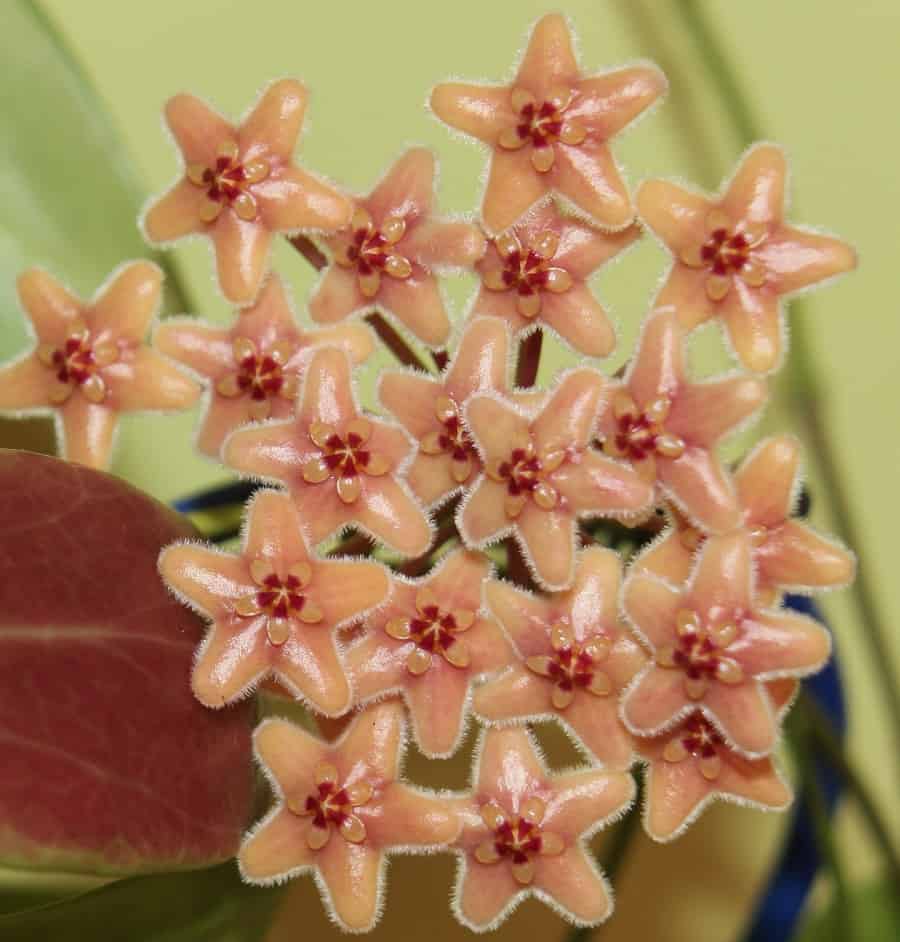
Hoya flavida is a unique and stunning hoya species found in the shady forests of the Solomon Islands. It was first discovered by David Liddle in 1992 and is known for its milky sap and curly branches. The leaves are dark green on top and light green on the bottom, turning red in strong sunlight and featuring a noticeable central vein and barely noticeable secondary veins.
When in bloom, Hoya flavida produces 20-30 flat, pink-orange and white corolla flowers with a yellow crown and red spot in the center. It prefers a light but not sunny location and requires regular irrigation, making it a beautiful and low-maintenance addition to any plant collection.
Hoya forbesii
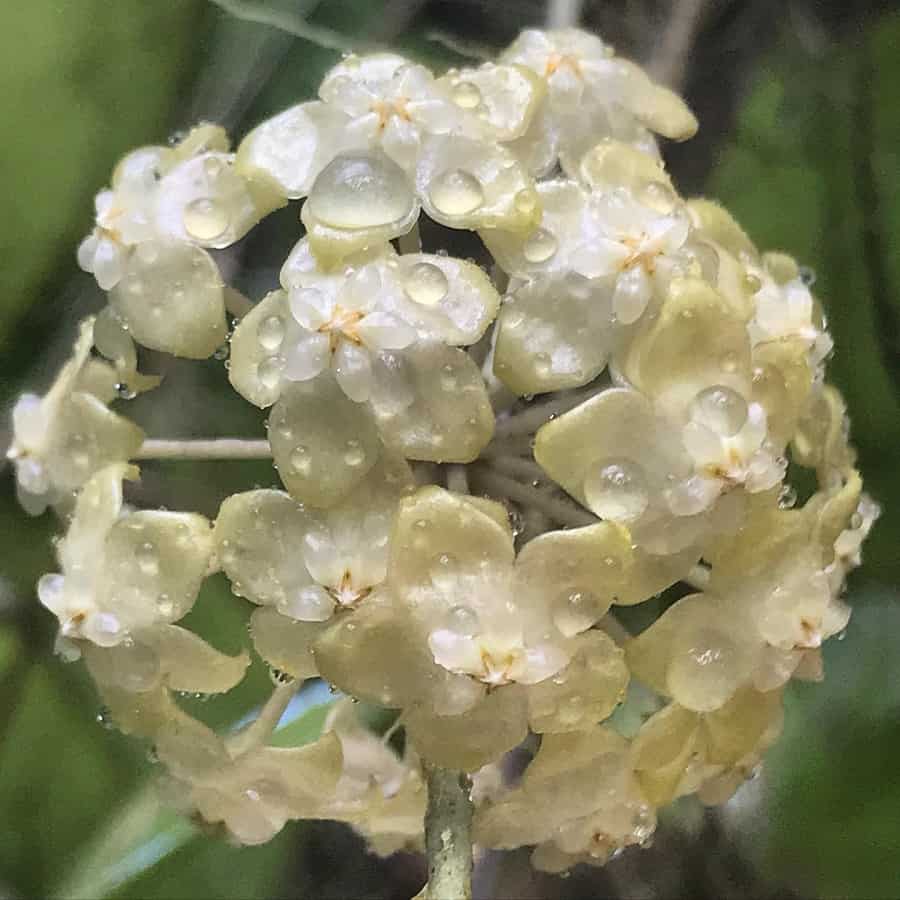
Hoya forbesii is a fascinating epiphytic vine native to the forests of peninsular Malaysia, Sumatra, and Borneo. It was discovered by Henry Forbes and named in his honor. The plant has shoots with a pale brown color that becomes brighter with age as it climbs trees. The leaves are leathery, oval-oblong or obovate, with a pointed top, rounded base, smooth and shiny upper surface, and papillary-pubescent lower surface.
Hoya forbesii has 10-15 individual flowers, about 1 cm in diameter, that open in a flower umbel. The corolla is flat, the corolla lobes are smooth and glossy, greenish-yellow with slightly bent tips, and the crown of the flower is yellowish-white. Although it does not produce nectar or have a smell, the plant is still a unique and interesting addition to any collection.
Hoya fraterna

Hoya fungii
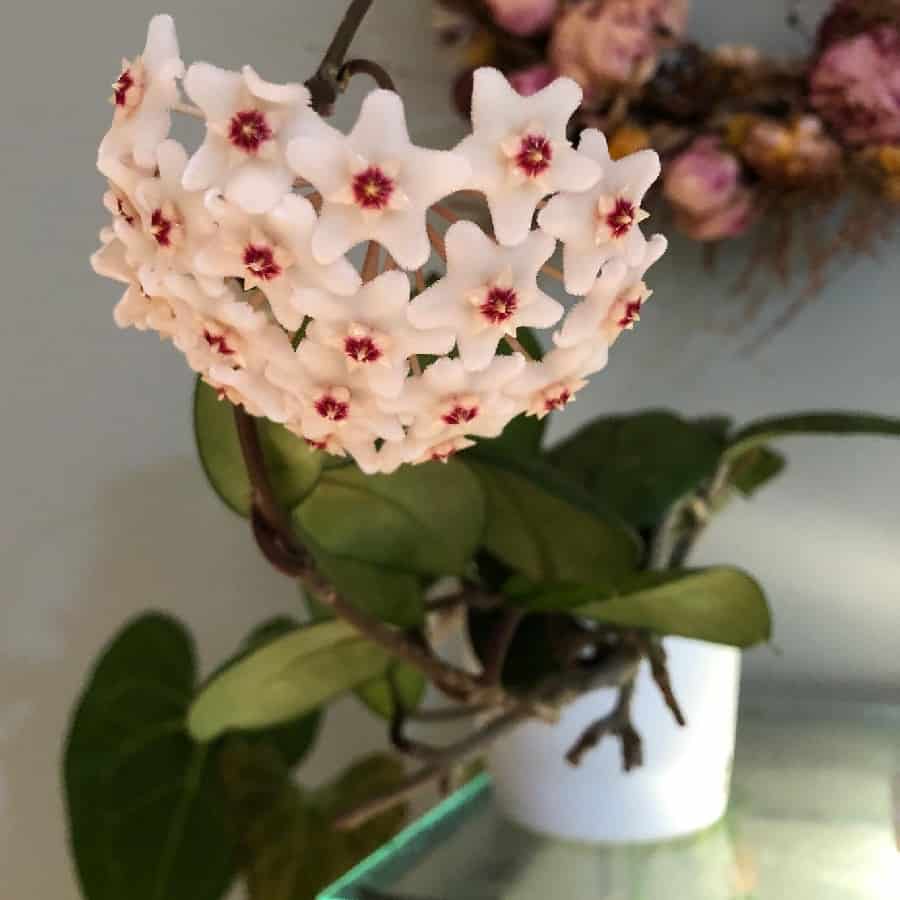
Hoya fungii is a unique species of plant that hails from China and was first discovered in the Hainan area by botanist Hing Kwai Fung during an expedition organized by Lingnan University in 1932. The species is named after the collector, Hing Kwai Fung. This climbing vine grows very fast and can reach up to 10 meters long. It’s an epiphyte that loves to grow in primary and secondary broad-leaved evergreen forests on any kind of rock, especially on rocky limestone, along streams and small rivers.
The leaves of Hoya fungii are large and green, with darker veins, ranging from 17 to 25 cm long and 10 cm wide. They have a rounded base and sharp or shortly pointed top, with pinnate venation and a slightly pubescent underside.
Hoya fungii’s flowers are wheel-shaped, with 20 flowers about 2 cm in diameter, opening in a flower umbrella. The beige-pink corolla of the flowers is pubescent, and the yellowish-white crown has a red spot in the center. The aroma of the flowers is weaker than that of Hoya carnosa and more pleasant.
If you’re interested in growing Hoya fungii, note that it prefers cool conditions and a temperature range of 18-20°C. This species is an easy plant to grow and tolerates drought well, blooming even in shady places.
Hoya fusca
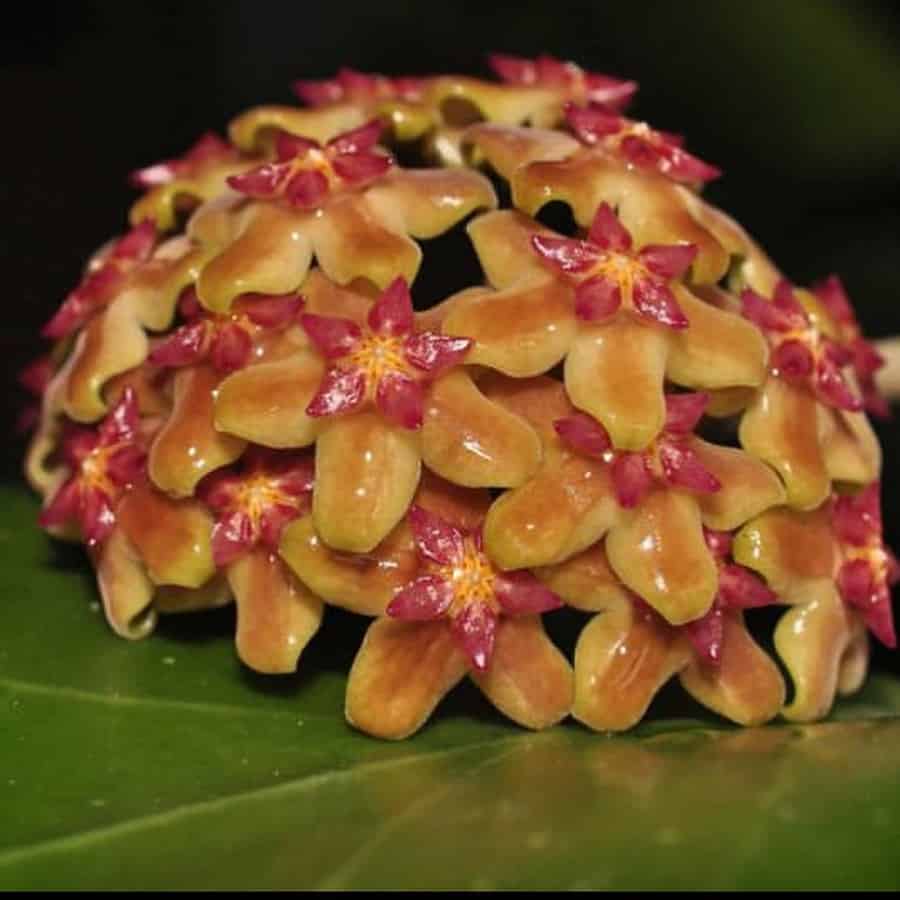
Hoya fusca is a magnificent plant native to Bhutan, Cambodia, India, Laos, Myanmar, Nepal, Thailand, and Vietnam. It grows in damp mountainous forests at elevations of 500-2600 meters above sea level and is known for its bushy growth habit, hanging from tree branches parallel to the ground. The leaves of H. fusca are dark green, oblong-oval or lanceolate, and are leathery with convex lateral veins. The underside of the leaves is a grey-green color.
Hoya fusca produces 20 individual brownish-yellow flowers in a flower umbel, with a corolla that is about 1 cm in diameter and often bent back. The crown lobes are pink and short, with a weak aroma that is not very pleasant. H. fusca blooms from May to December, with flowering lasting up to 2 weeks.
This is a very large plant that requires a lot of space, and it will take many years before it will reward its grower with its magnificent blooms. It is not recommended for those with limited space.
Hoya gigas
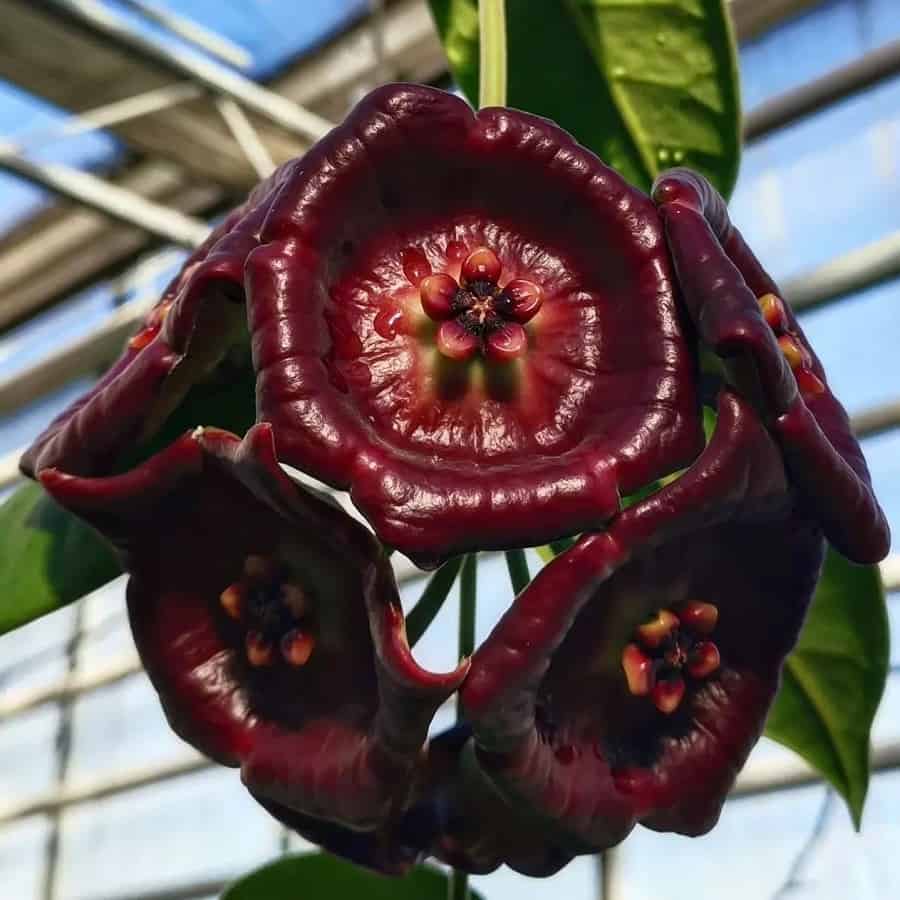
Hoya gildingii
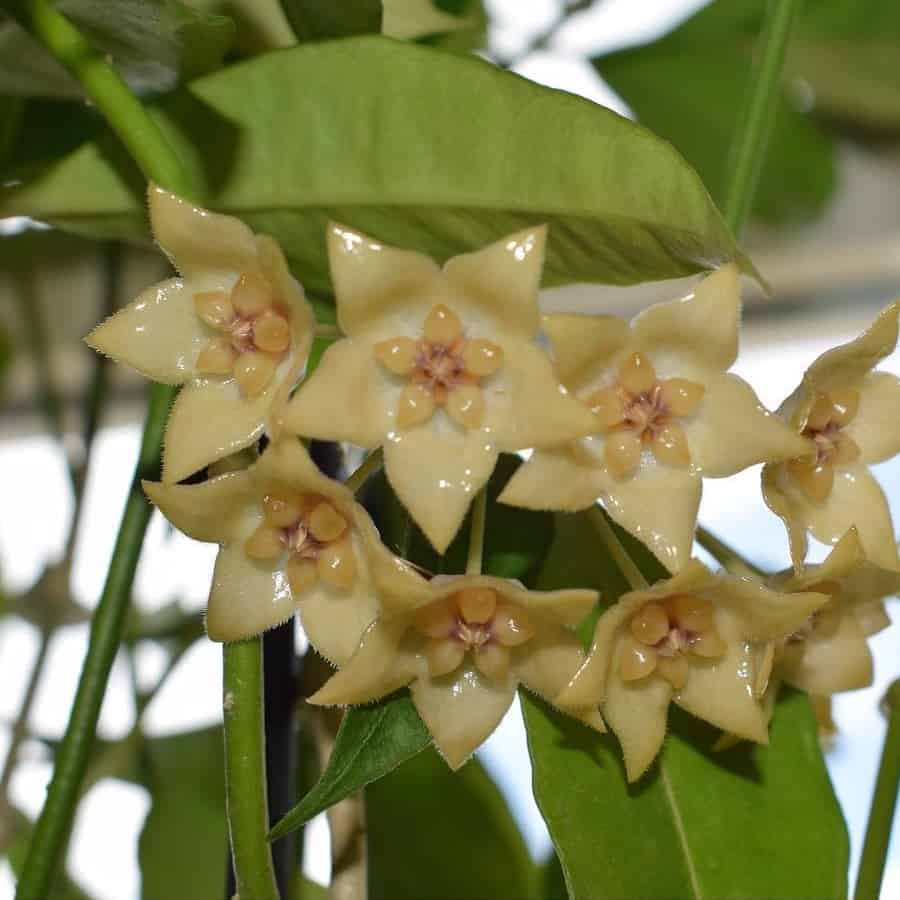
Hoya gildingii is a rare and beautiful climbing vine native to the mountain forests of Borneo, Malaysia. It was named after the famous plant collector, traveler, and hybridizer Edward Kalani Gilding. This liana can grow up to 6 meters long and has old stems that can reach up to 2 cm in thickness.
The leaves of Hoya gildingii are smooth, dark green, and oblong-oval in shape with a sharp tip. The central vein is prominently visible, making the leaves look striking and unique.
When in bloom, Hoya gildingii produces 7 to 15 yellowish-white flowers that are 2.5 cm in diameter. The corolla of the flowers is almost flat, with slightly raised tips and sparse pubescence. The crown is also yellowish-white with a purple spot in the center. The flowers bloom for about a week and are truly a sight to behold.
Hoya gildingii is a cool plant that prefers the humid and equatorial environment of a mountain slope. It is not for beginners, as it is difficult to grow and requires special care. However, if you’re up for the challenge, Hoya gildingii will reward you with its stunning beauty.
Hoya glabra
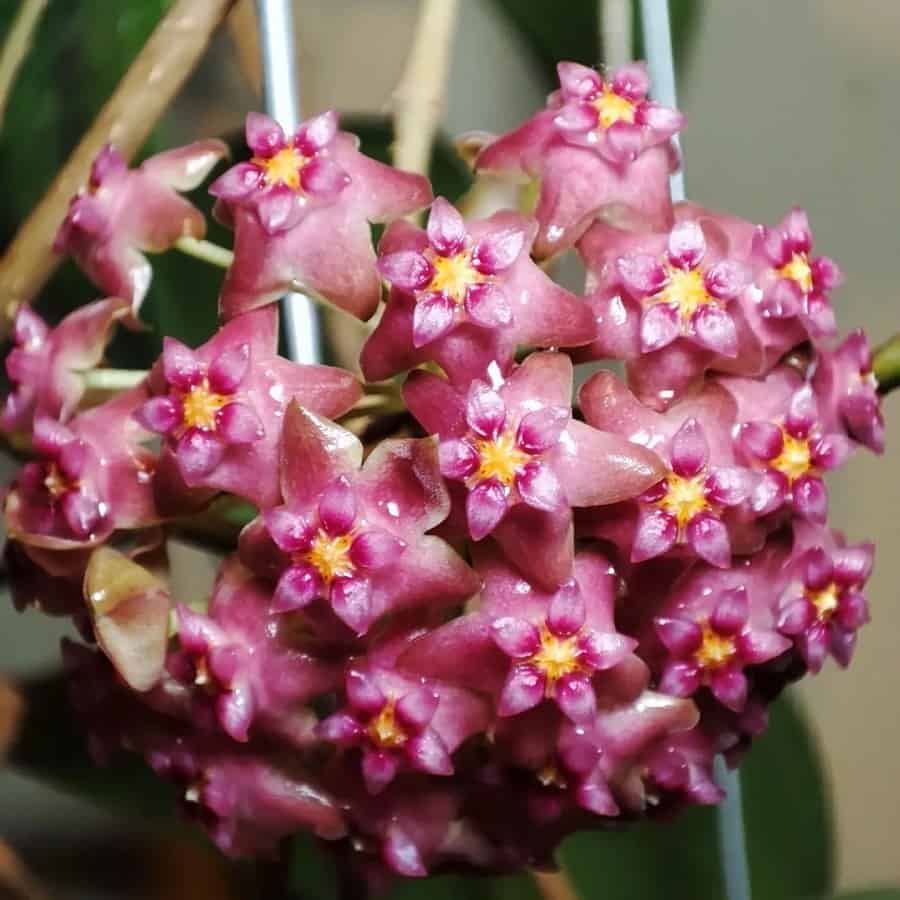
Hoya glabra is a climbing liana that is characterized by its smooth and glossy leaves, with pointed tips and noticeable veins that are palmate and basal in the middle of the leaf. This plant is known for its delicate and sweet aroma when it is in bloom and its beautiful pale purple-purple flowers with a bright golden yellow spot in the center of the crown.
Growing up to 8 meters long, Hoya glabra thrives in warm and humid conditions with plenty of light but no direct sunlight. Although it may grow slowly at first, once the root system is established, the growth rate accelerates, resulting in large leaves up to 18-20 cm in length. This plant is closely related to Hoya macrophylla and is perfect for those who are looking for an attractive and unique houseplant to add to their collection.
Hoya globiflora
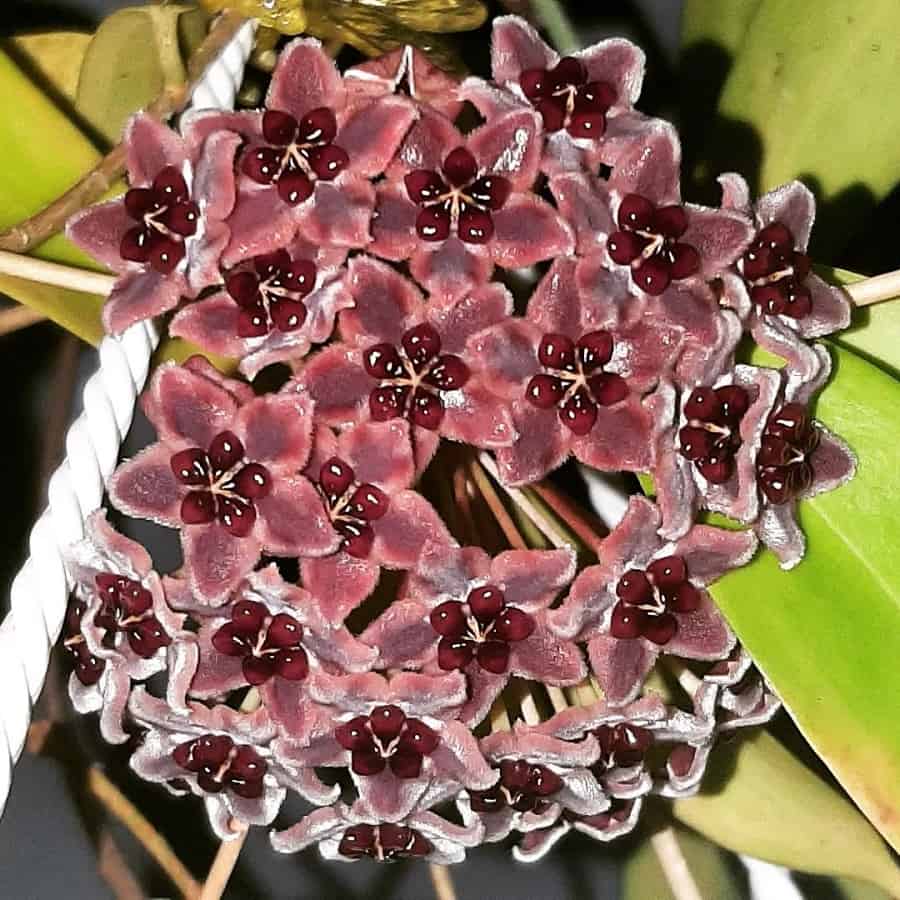
Hoya globulifera
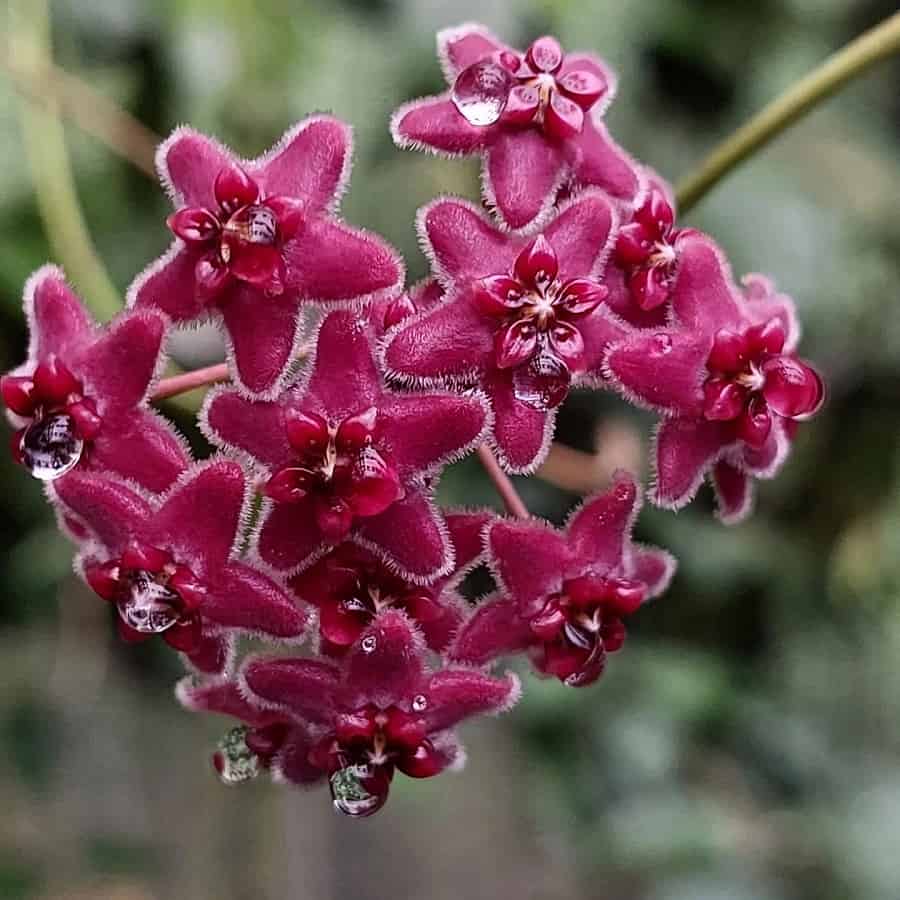
Hoya globulifera is a unique and fascinating plant native to Papua New Guinea. It is an epiphyte with ovate or elliptical leaves that are rounded at the base and can grow up to 3-10 cm long and 2-5 cm wide.
This plant is known for its spherical flower umbels, consisting of 10-20 individual flowers with corollas that are wheel-shaped, about 1.5 cm in diameter, and brownish-purple in color. The inside of the corolla is covered in short hairs that give it a silky appearance, and the crown is a deep purple. This species of Hoya is known for its love of light and its ability to withstand long dry periods. It is currently known by three different names, but Hoya globulifera is the official name in this case.
Hoya globulosa
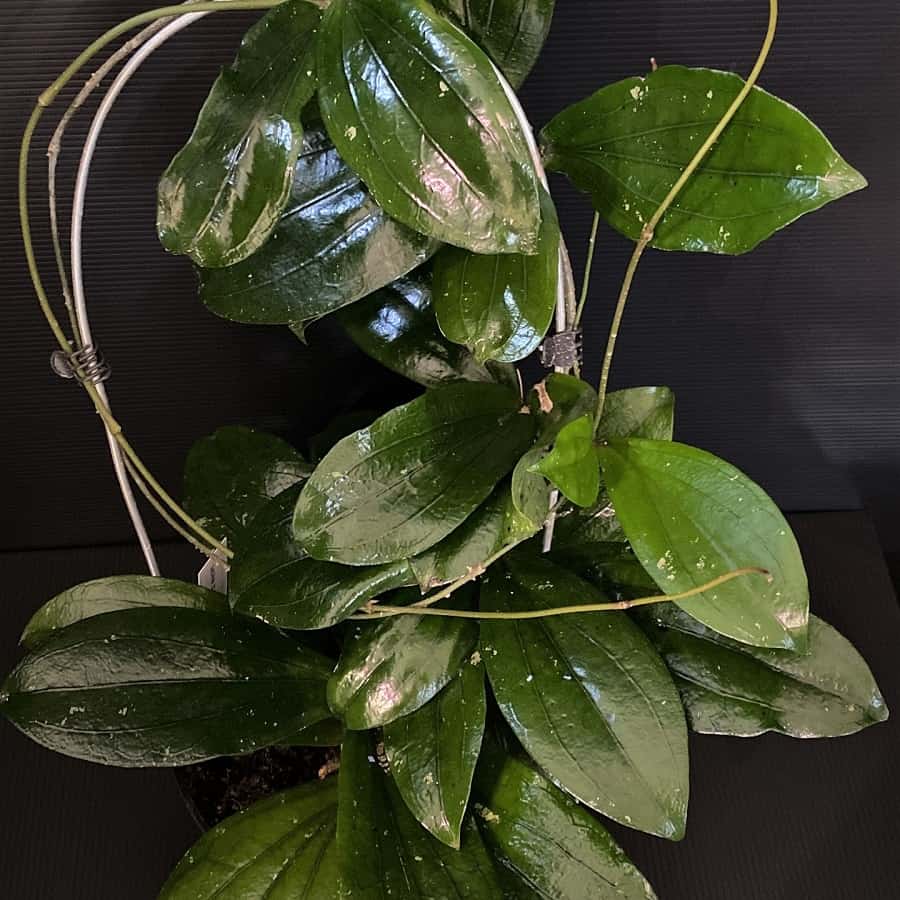
Hoya globulosa is a large-leaved climbing plant that lives an epiphytic or lithophytic lifestyle and can grow up to 3 meters long. This hoya is found in primary and secondary broad-leaved evergreen forests and on various types of rocks, especially karst limestones, at an altitude of 800 to 950 meters above sea level. The stem and leaves of Hoya globulosa are covered with pubescence, making them soft to the touch.
The beautiful grassy-green leaves can reach up to 13 centimeters in length and 5 to 9 centimeters in width, with clearly defined veins and wavy curved edges. Over time, the pubescence on the upper side of the leaves fades and the edges become smooth, and the veins become less distinct.
Hoya globulosa produces large, spherical, yellow-white flowers in umbels. Each flower is about 1.3 centimeters in diameter, and the pedicels are 7 to 10 centimeters long. This hoya blooms from March to April. It is known for doing better when kept in cooler temperatures.
Hoya golamcoana
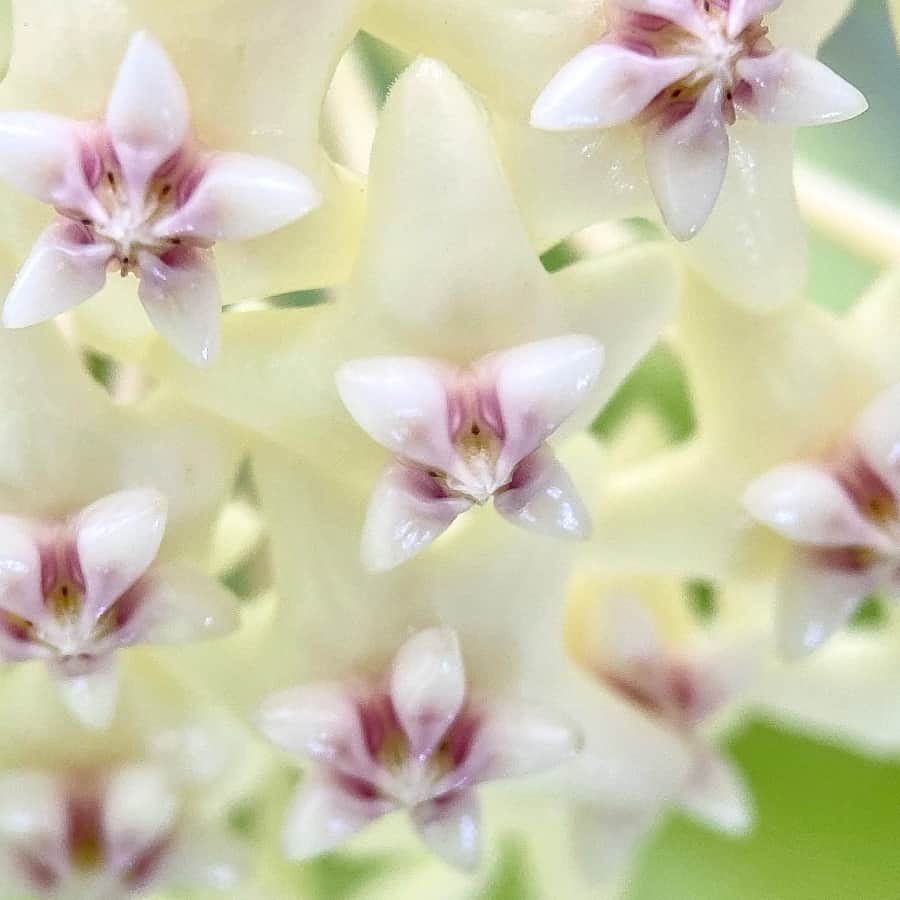
Hoya gongshanica
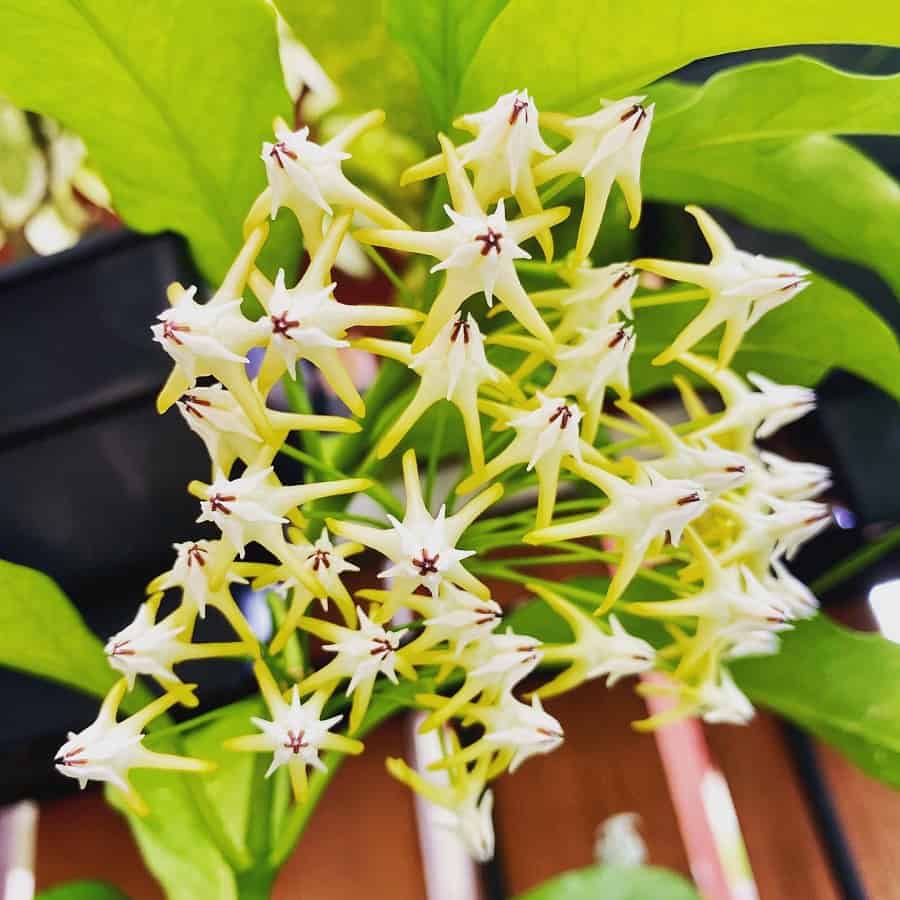
Hoya GPS 7240

Hoya sp. GPS 7240 is a rare find in the US, known for its distinctive look with small, oblong leaves and beautiful salmon-colored flowers. The tiny, plump, oval-shaped leaves turn a deep purple and have a faint grape-like appearance when exposed to the sun. While it is slightly easier to grow than Hoya sigillatis, it still requires careful attention to thrive.hoya heuschkeliana
Hoya GPS 88
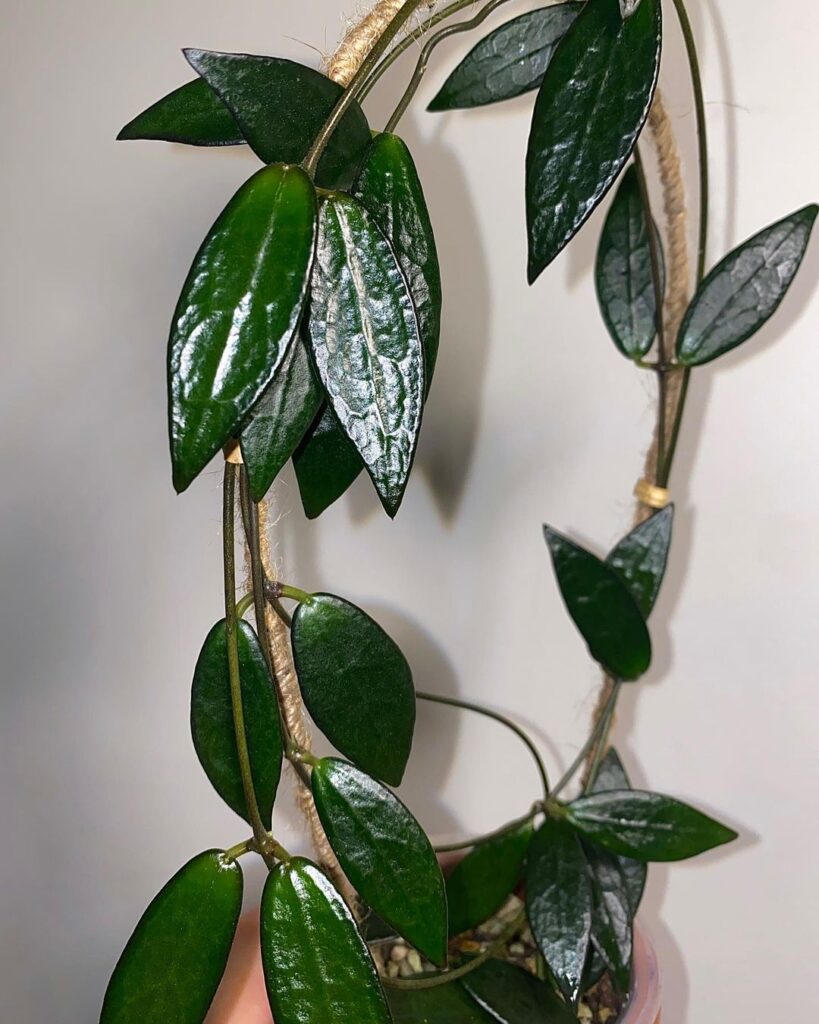
Hoya gracilis
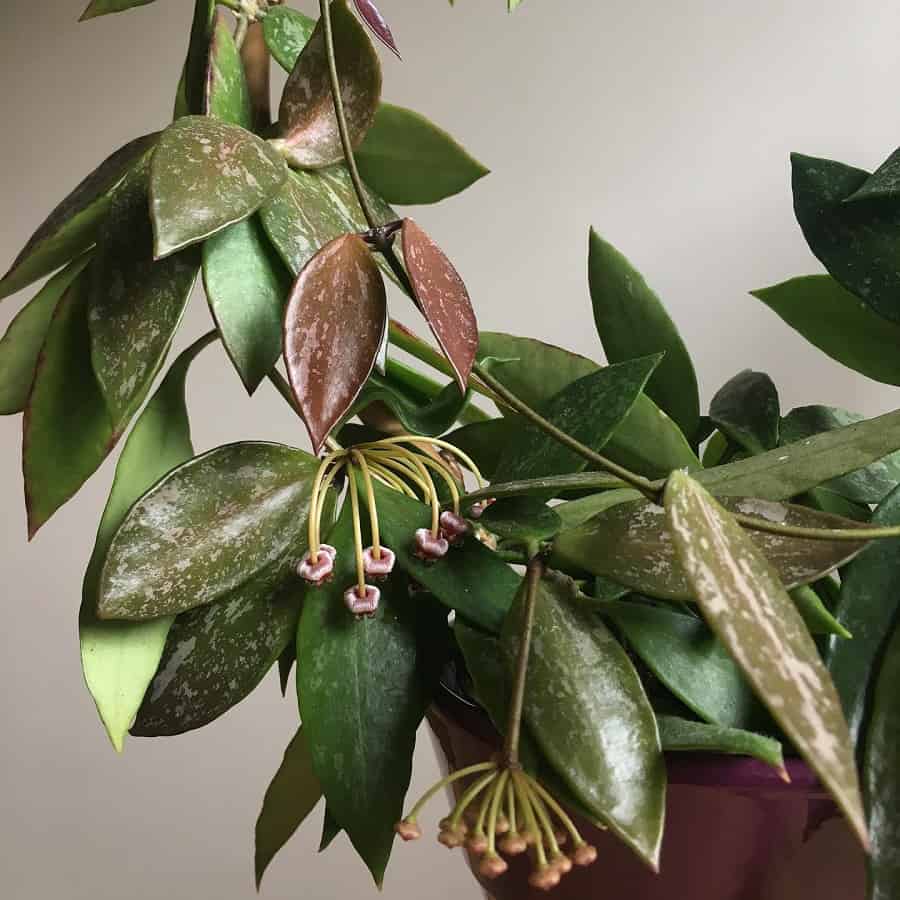
The Hoya Gracilis (now known as Hoya Memoria) is a rare and sought-after beauty that is sure to catch the eye of any plant enthusiast. Its delicate leaves are adorned with speckles of silver that sparkle in the light, making it a truly unique addition to any collection. With the potential to produce scented pinkish-red flowers, this hoya is a true feast for the senses. And don’t let its good looks fool you, the Hoya Gracilis is also low maintenance and thrives in conditions that suit its tropical origins, such as bright, indirect light and high humidity. If you’re lucky enough to get your hands on one of these, be prepared for it to be the star of your collection!
Hoya graveolens
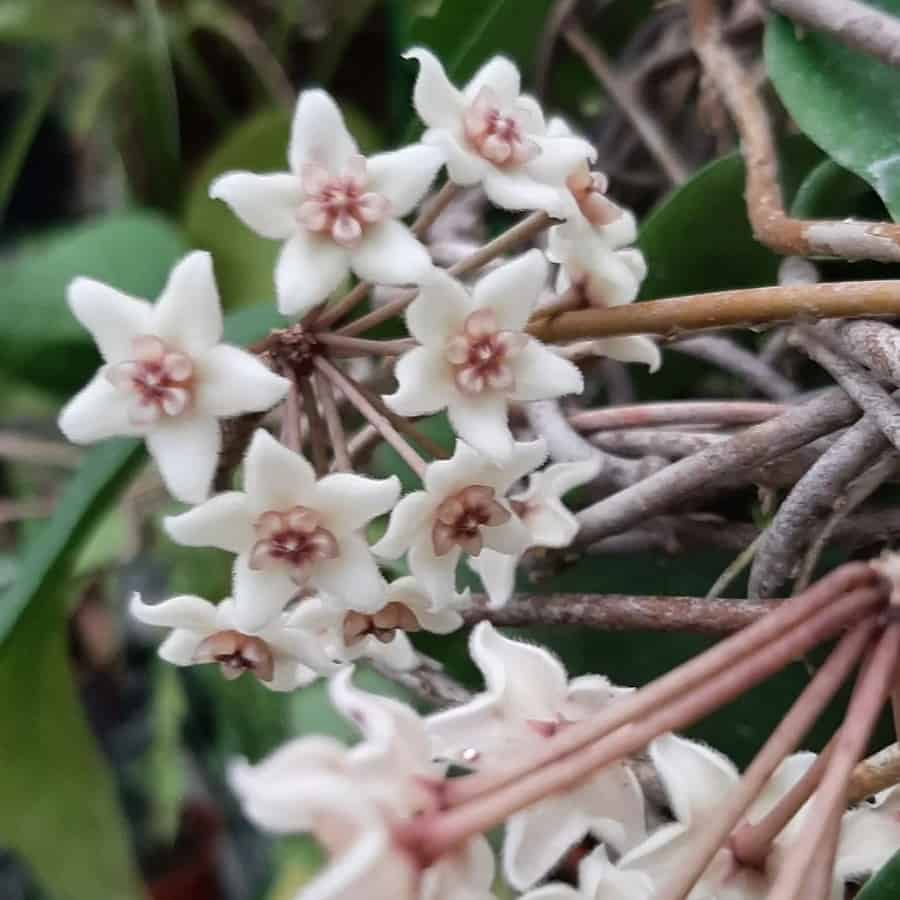
The Hoya graveolens is an enigmatic beauty from Thailand. This fast-growing epiphyte boasts of delicate curly vines and dark green leaves with silvery specks that are oval and matte. The thin umbrella pedicels add to its charm. The creamy white pubescent corolla with pink crown and dark pink spot in the center measures 1.5 cm in diameter and has a slightly unpleasant aroma, hence the name “graveolens” meaning “strong aroma” in Latin. While it thrives in bright light, direct sunlight must be avoided to prevent leaf burn. Moist soil is key to keeping this captivating Hoya thriving.
Hoya greenii
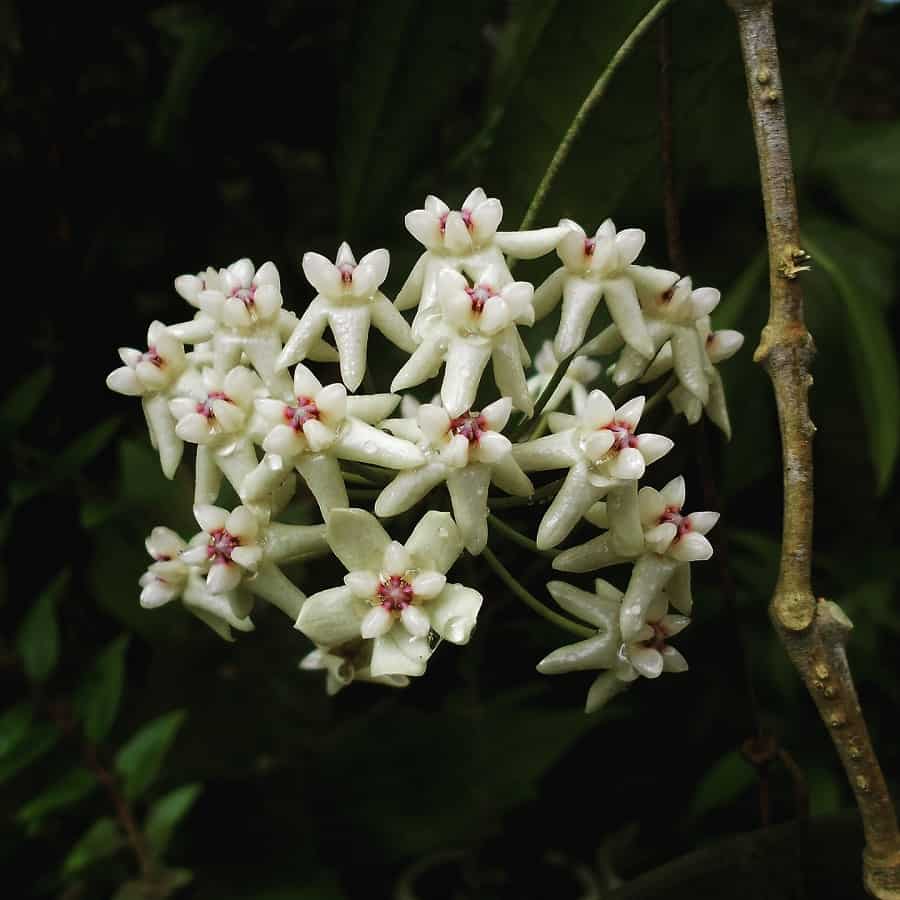
Discover the beauty of the Hoya greenii! This ornamental climbing vine is a prized addition to any plant collection with its dark green leaves and intricate reticulate vein pattern. The leaves are smooth and matte, and the flower structure sets it apart from the Hoya darwinii with its intertwined apex and charming pubescence on the inside of the corolla.
The crown is strongly raised and glossy-smooth, adding to its unique charm. Some consider it to be synonymous with the Hoya darwinii, while others argue it is a distinct species. Regardless, the Hoya greenii is a must-see for any plant enthusiast.
Hoya griffithii
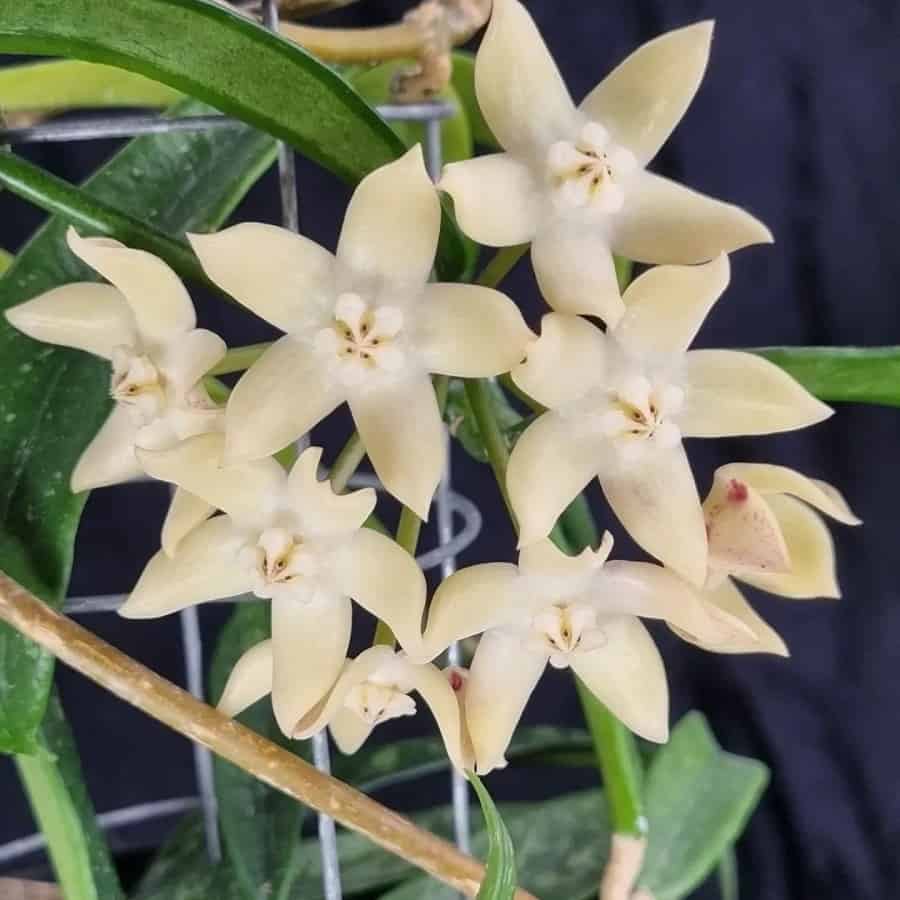
Hoya griffithii is a stunning, green liana found in the Indian and Chinese Himalayas, and named after botanist William Griffith. Its leaves are dark green with silver speckles and its umbrella-like clusters produce 4-10 separate, flat flowers with ivory corolla and crown.
This epiphytic plant appreciates a cooler environment and moist mountain forests, and is known for its sharp musky aroma during flowering, which occurs twice a year. Living in its natural habitat at altitudes between 900-1400 meters, Hoya griffithii is a unique and beautiful addition to any collection.
Hoya Gunung Gading
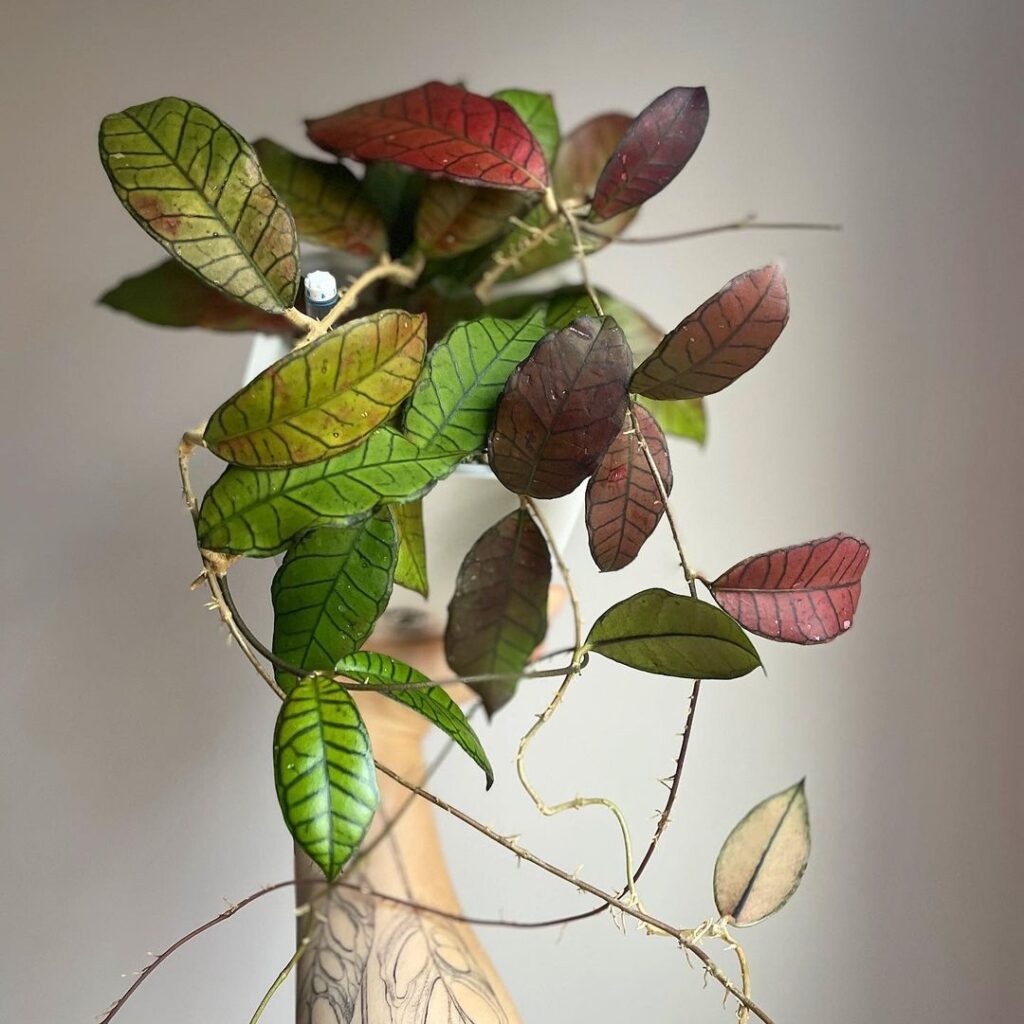
Hoya Gunung Gading, discovered in Gunung Gading National Park in Sarawak, Borneo Island, Malaysia, is renowned for its decorative leaves within the finlaysonii complex of Hoyas. This plant features much more prominent veining on its leaves, which remain visible as the leaves mature. The leaves are thinner compared to other Hoya callistophylla clones, giving them a distinct, card-like texture.
Hoya halconensis
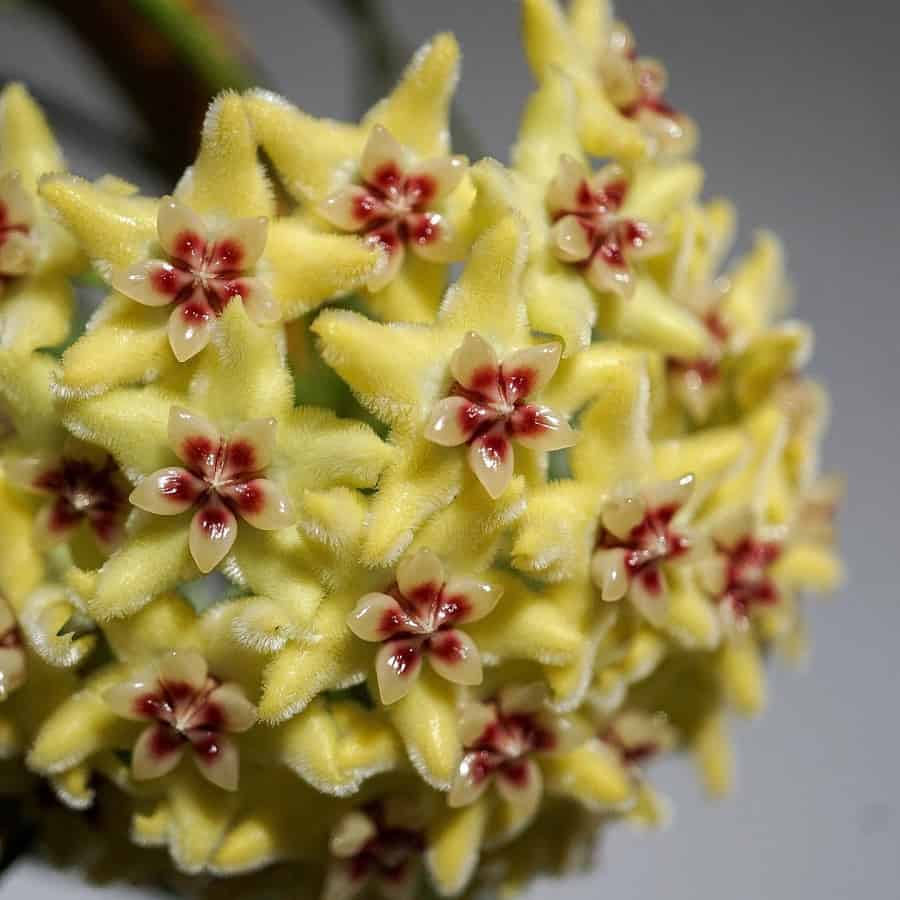
Hoya halconensis is a rare beauty, hailing from the lush forests of Mindoro Island in the Philippines. This epiphytic climbing vine boasts thin, leathery leaves that are 9-12.5 cm long and 4-6 cm wide, with a central vein that stands out.
During the blooming season, up to 10 creamy yellow flowers with pale-yellow or lilac-tinted corolla lobes open in an umbrella shape, giving the plant an ethereal feel. The crown of the flower is white with a red center, and the scent of the flowers is reminiscent of sweet vanilla. Despite its delicate appearance, Hoya halconensis is a tough plant that requires proper care to thrive. It prefers bright locations with some shading and requires consistent moisture levels to avoid dehydration.
Hoya halophila
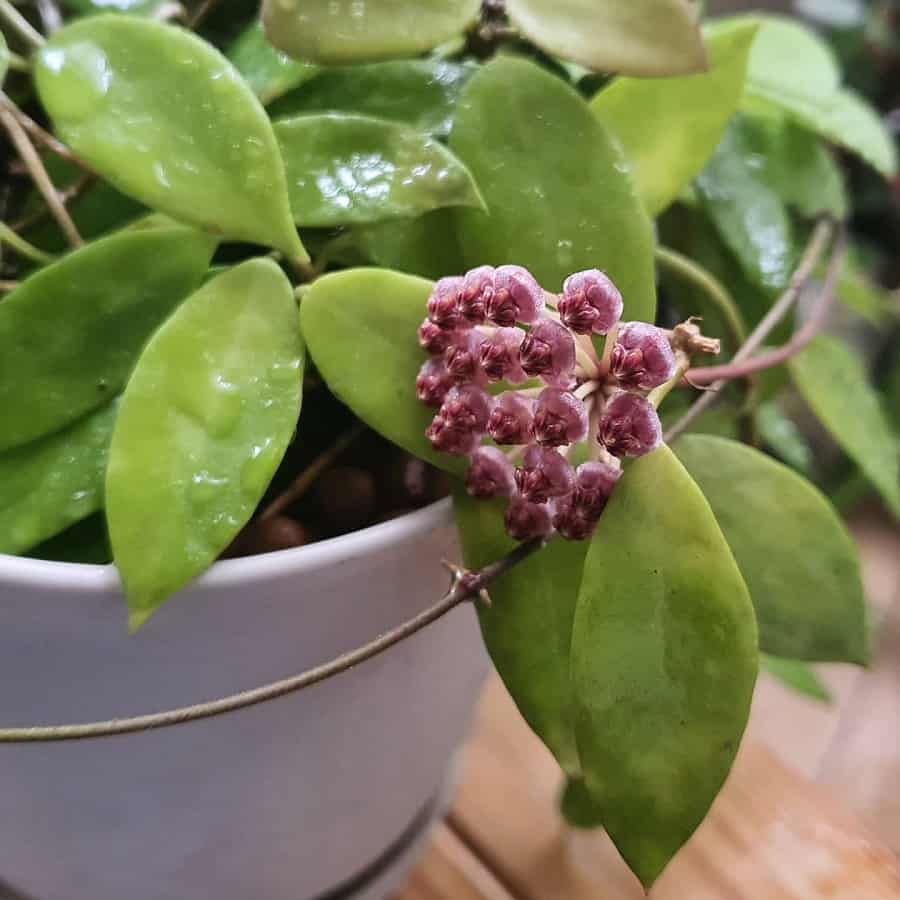
Hoya hellwigiana

Hoya heuschkeliana

Hoya heuschkeliana is a unique and captivating plant that hails from the lush rainforests of the Philippines. This epiphytic climbing vine is named after Dexter Heuschkel, an avid plant collector and Vice President of Manila Memorial Gardens. With delicate thin vines and juicy, slightly leathery leaves, this hoya is often grown as an ampel plant.
The flowers of Hoya heuschkeliana are a standout feature, with 2-7 urn-shaped blooms that are 0.5 cm in diameter and have a pink corolla and pink crown with a yellow spot in the center. With a slightly sweet, caramel aroma, this variety is a fast-growing and easy-rooting plant that thrives in light conditions without direct sunlight. During the summer months, Hoya heuschkeliana produces an abundance of flower umbels at each leaf node, making it a beautiful and low-maintenance addition to any plant collection.
Hoya heuschkeliana Variegata
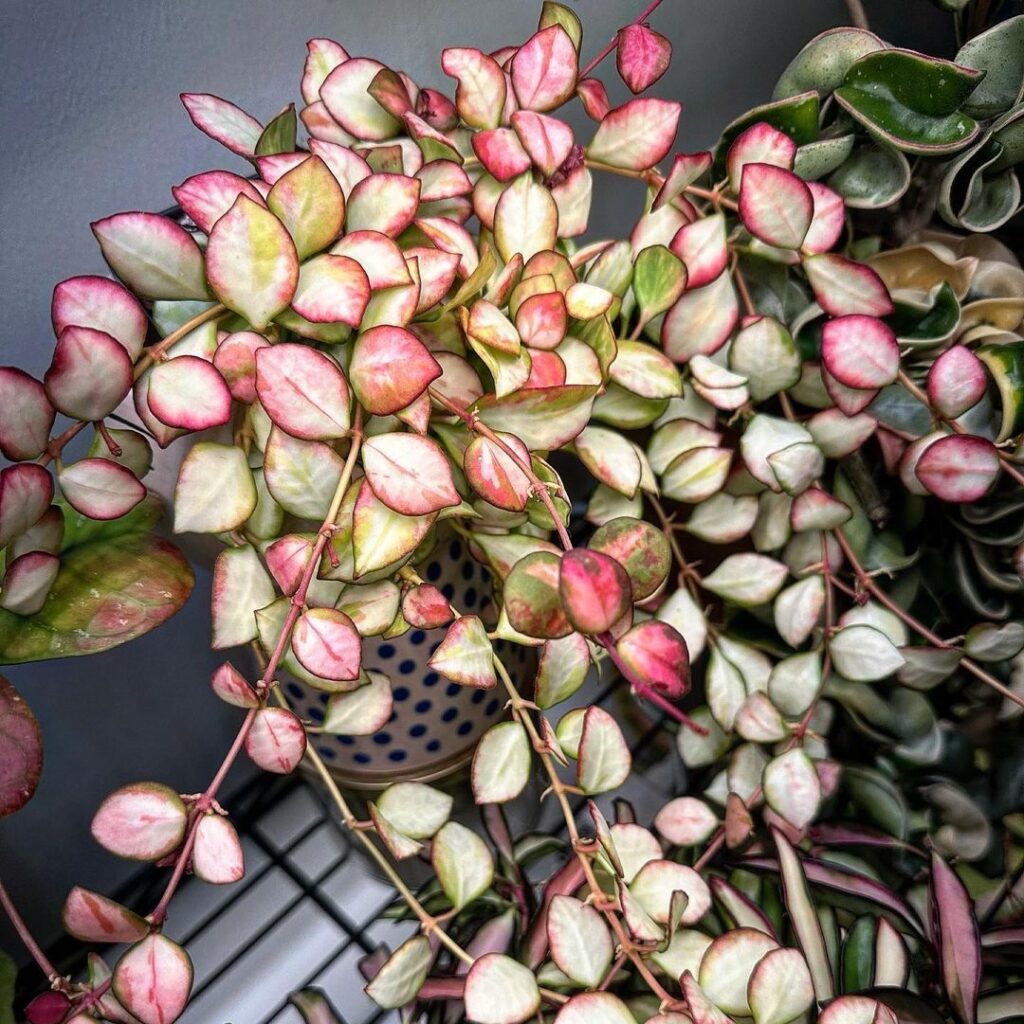
Hoya hypolasia
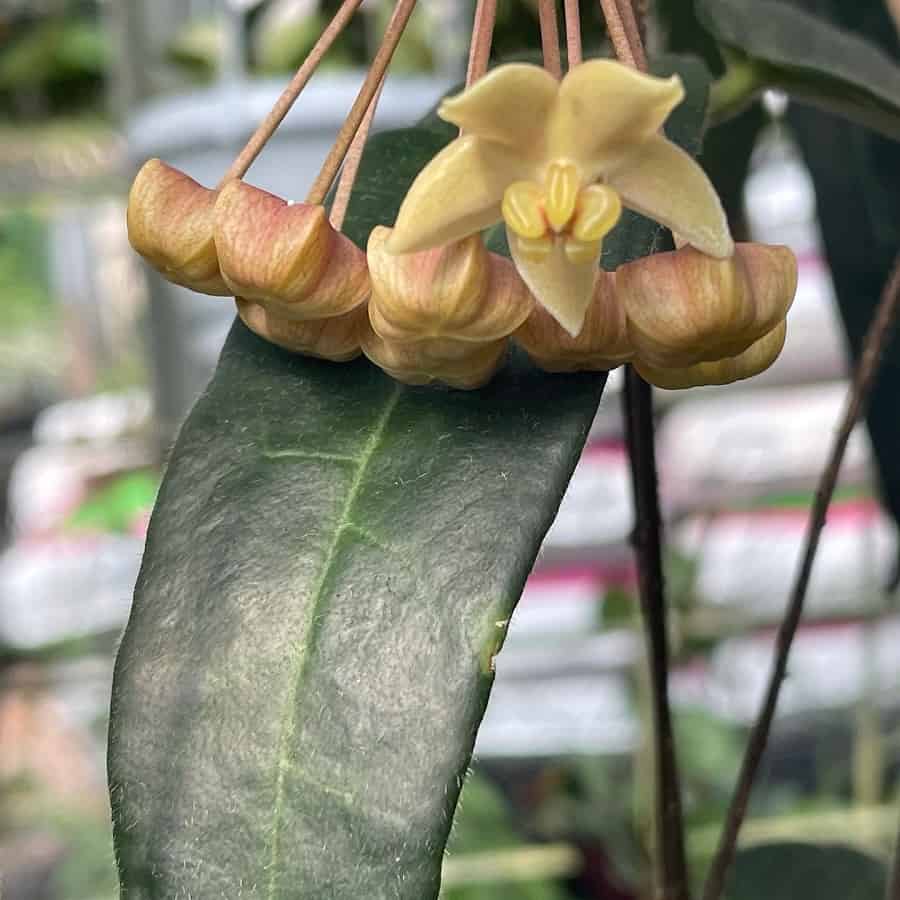
Hoya hypolasia is a true beauty in the world of hoyas. With its striking dark green leaves and bluish tint, it adds a touch of sophistication to any collection. But this variety is not just a pretty face, it is also resilient, surviving and thriving with the right conditions. This climbing vine is sure to turn heads with its long, delicate filiform vines and numerous star-shaped flowers in a pale yellow hue.
Although it is not known for its scent, the leaves are covered in sparse, grayish hairs that give it a unique, textured appearance. If you’re looking for a showstopper to add to your collection, Hoya hypolasia is definitely one to consider. It prefers a sunny location with moderate moisture levels and daily temperature fluctuations for optimal growth and flowering.
Hoya IM-08

Hoya IM-08 is known for its vigorous and prolific growth, featuring tiny round leaves reminiscent of Hoya serpens but without the challenging growing requirements. Although it produces numerous peduncles, flowering can be sparse, potentially influenced by changes in day length. Its starfish-shaped flowers add charm to this new discovery, which is expected to be named a new species in 2024. Despite its unusual smell, Hoya IM-08 is a highly recommended plant for its ease of cultivation and attractive foliage.
Hoya imbricata
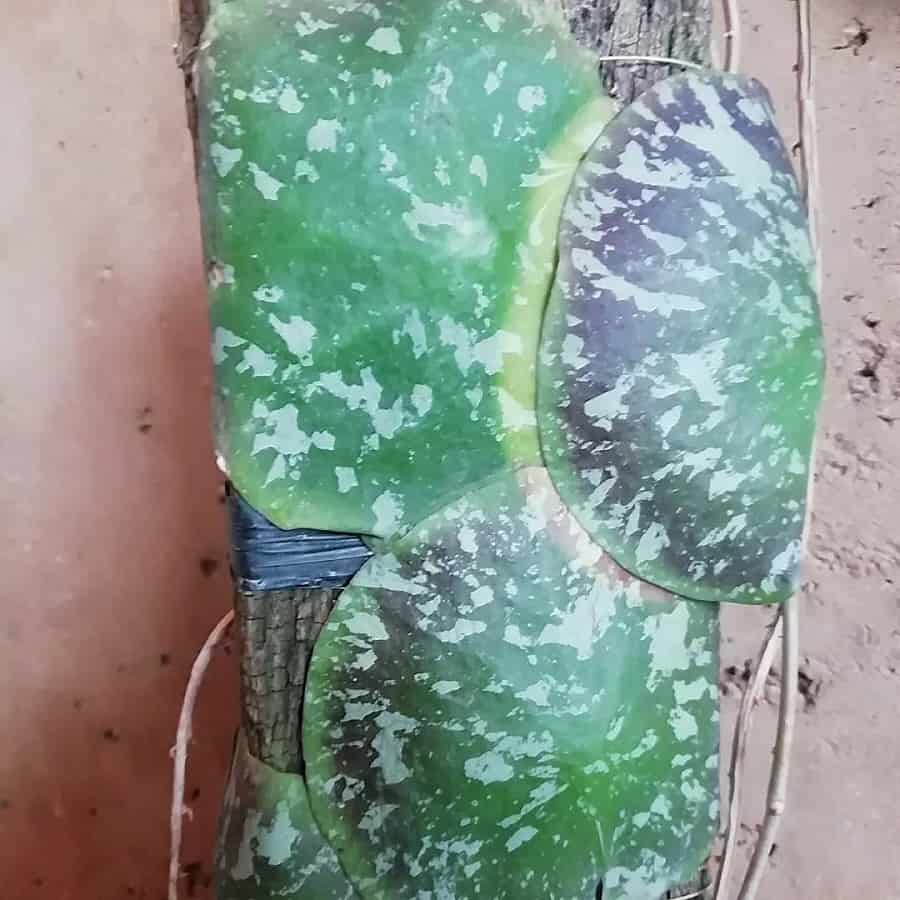
Hoya imbricata is a unique and fascinating epiphytic climbing vine that calls the rainforests of Southeast Asia home. Its leaves are round or shell-shaped with a mix of dark green to grey-green, speckled with silver and accented with reddish spots. The underside of the leaf has a captivating purple hue. With its overlapping leaves and a network of aerial roots growing into the bark of trees, Hoya imbricata forms a cozy home for ants who help provide it with necessary nutrients.
In the center of these leaves, 6 to 12 individual flowers bloom in a flat flower umbrella for 4 to 5 days, with corolla lobes that range from yellow to light yellow or almost white and a crown that often matches the rim with a red spot in the middle. Hoya imbricata is a challenging plant to cultivate, often requiring an orchidarium to thrive, but its unique beauty and fascinating biology make it a must-have for experienced hoya collectors.
Hoya imperialis
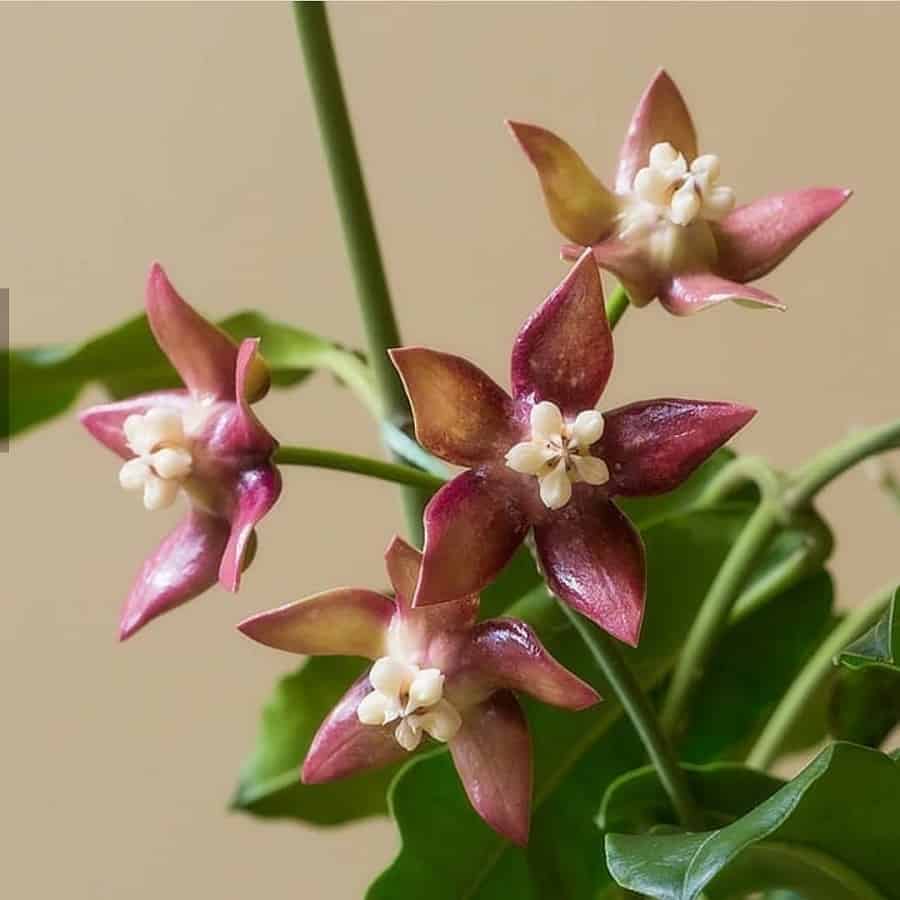
Hoya imperialis is a stunning plant that made its grand debut at the Regent-park exhibition in England in 1848, where it received a medal for its beauty. This liana, native to northern Malaysia and Thailand, boasts strong and fleshy green vines that can grow up to 8 meters long.
The oblong-oval leaves of Hoya imperialis are deep green with a noticeable central vein and paler undersides, while its flower umbrella consists of 8-10 dark red star-shaped flowers with a milky white crown. The petals can range in color from red to pale pink, yellow, or greenish white, and the flowers exude a pleasant fragrance in the evening and at night. Although it is easy to grow with proper care, Hoya imperialis does not tolerate cold and damp conditions.
Hoya inconspicua
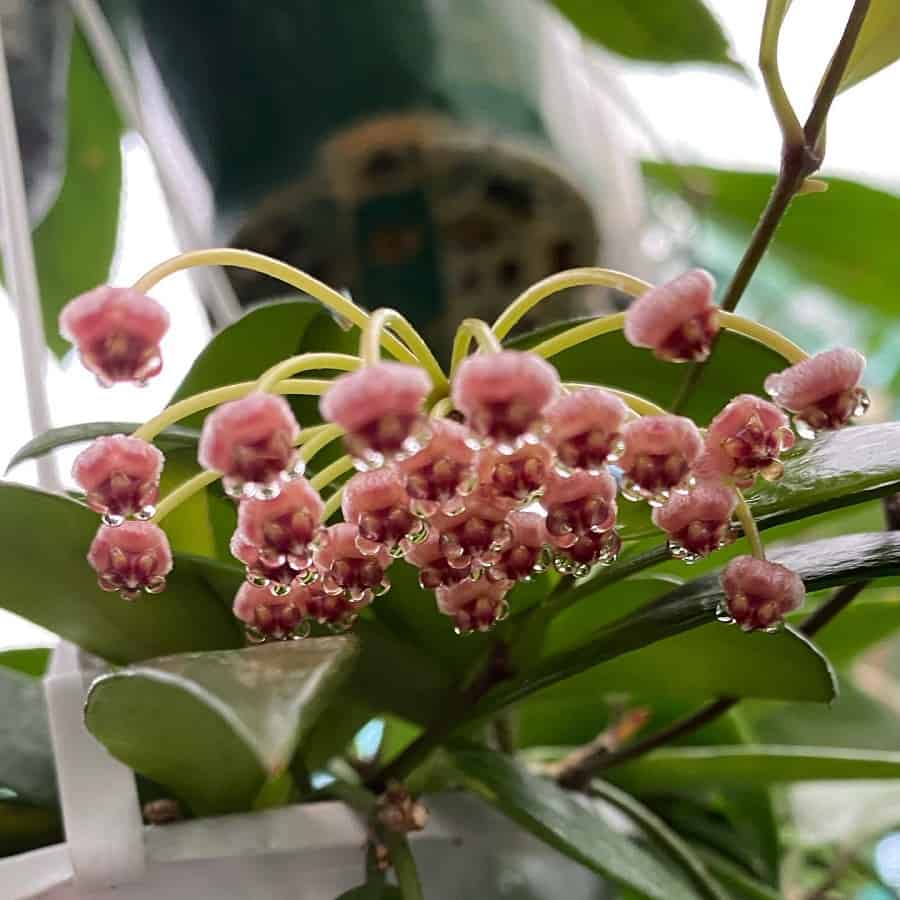
The Hoya inconspicua is a captivating plant species that thrives in lowland coastal areas. This climbing epiphyte is known for its aerial roots that form at the internodes and just below the nodes, adding to its unique beauty. The branches are filiform and light green, with internodes ranging from 3-8 centimeters in length. The leaves of Hoya inconspicua are fleshy and vary in shape, but are generally ovate or lanceolate with a bright green color and smooth texture.
One of the most remarkable features of Hoya inconspicua is its stunning flowers. The flowers bloom in a flat or slightly convex umbel, with a stalk that is positively geotropic and 3-10 centimeters long. The flowers are 7-8 mm in diameter and can range in color from yellow-pink to maroon. The corolla lobes are triangular and pubescent inside, with a smooth tip and a yellow crown with a dark purple spot in the center.
Hoya incrassata
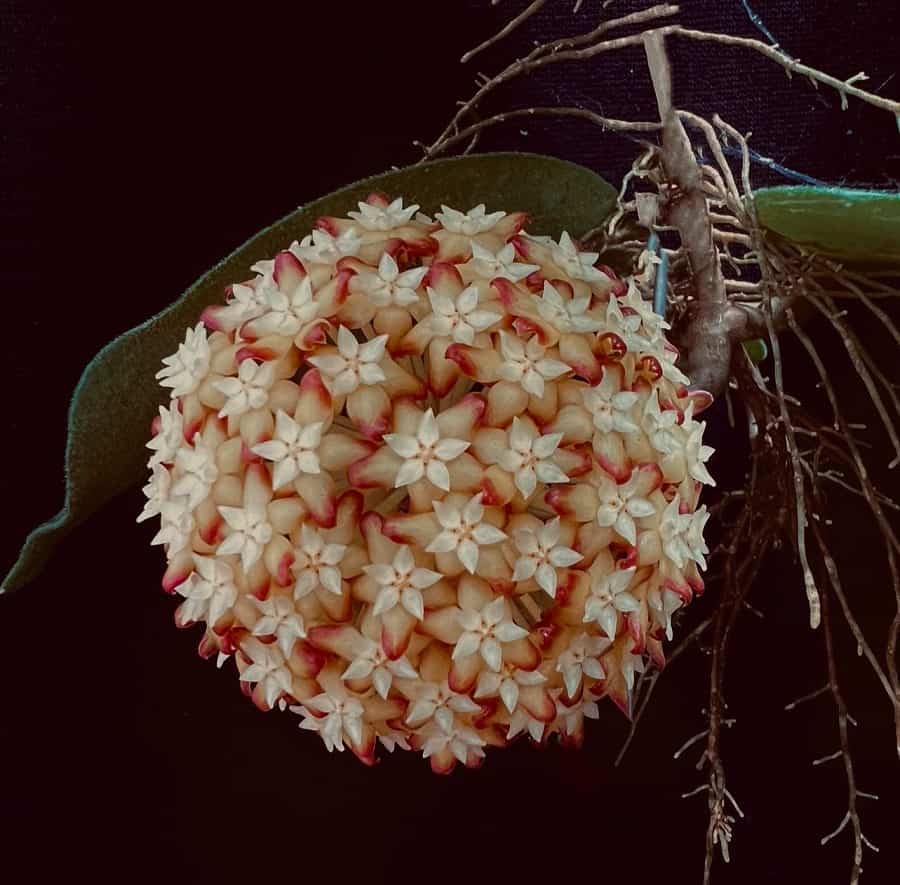
Hoya incrassata, with its thick and leathery leaves, is a unique beauty in the world of hoyas. Its leaves are oblong-oval, measuring 9-14 cm in length and 5-6 cm in width, with a smooth and shiny texture. The well-defined midrib, along with the 4-5 lateral veins on either side, creates a mesmerizing pattern on the leaves. The base of the leaves is rounded or slightly heart-shaped while the tips are pointed, adding to its aesthetic appeal.
This hoya variety boasts a compact and rounded umbrella, with up to 60 flowers blooming in a group. The inside of the corolla is smooth, while the corolla lobes are turned back, making the flower even more alluring. The crown of the flower has a diameter of 0.8 cm, adding to the charm of Hoya incrassata.
Hoya incurvula
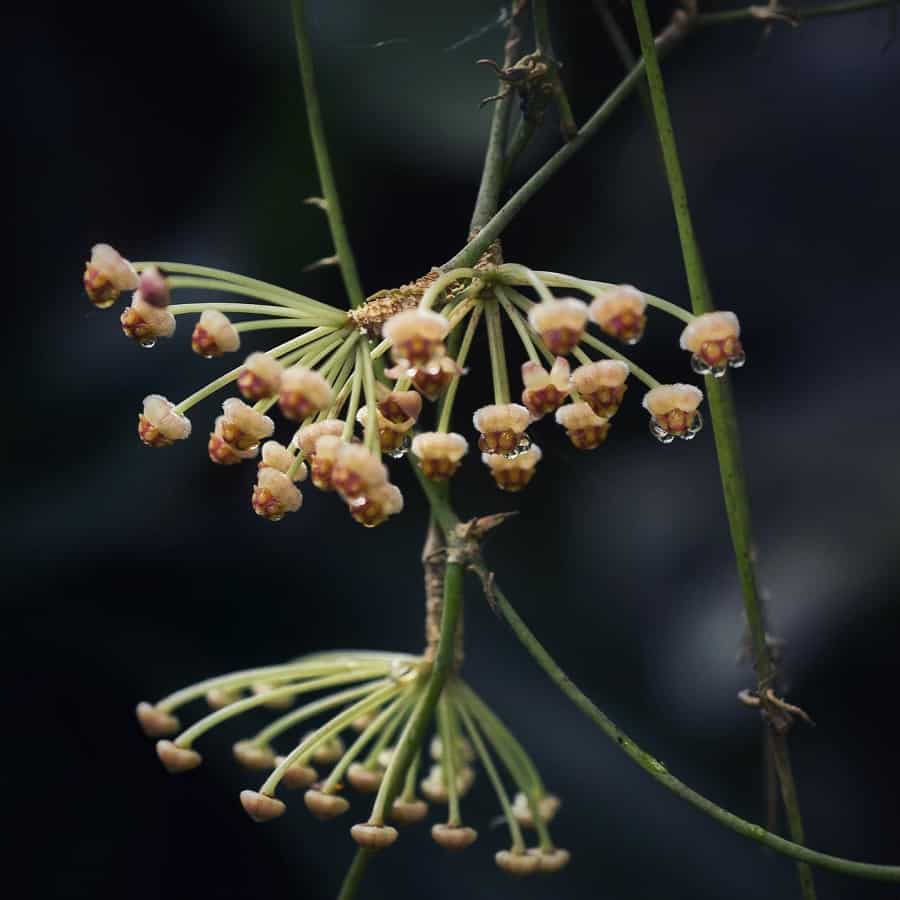
Hoya inflata
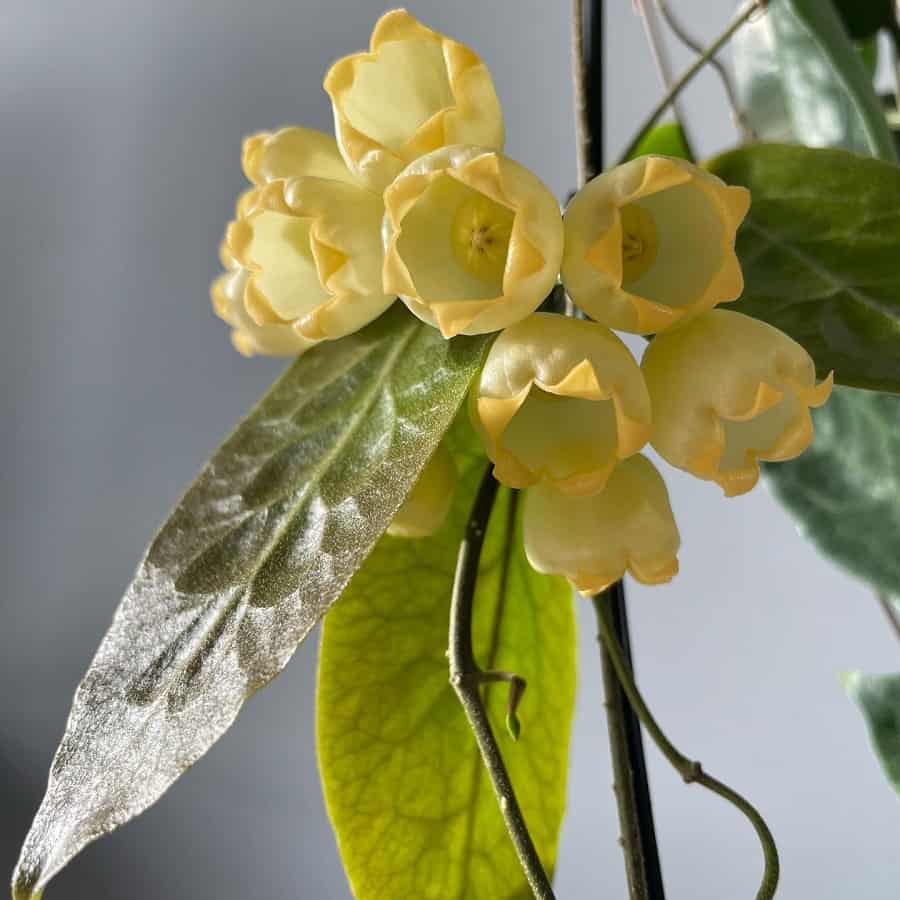
Hoya inflata is a rare and intriguing plant native to the remote forests of Madang Province in Papua New Guinea. It was first collected by IM Liddle and later reclassified as Hoya inflata by the highly respected Swedish botanist Dr. Livia Wanntorp. This plant is one of three urn-shaped flower hoyas and is known for its characteristic broad, green, matte leaves with a sharp tip and distinct venation.
Hoya inflata is a challenging plant to grow, and it requires special care, with warm temperatures, ample light, and high humidity. Any changes in its conditions could result in the dropping of its leaves, making it a plant for only the most experienced horticulturists.
Hoya insularis
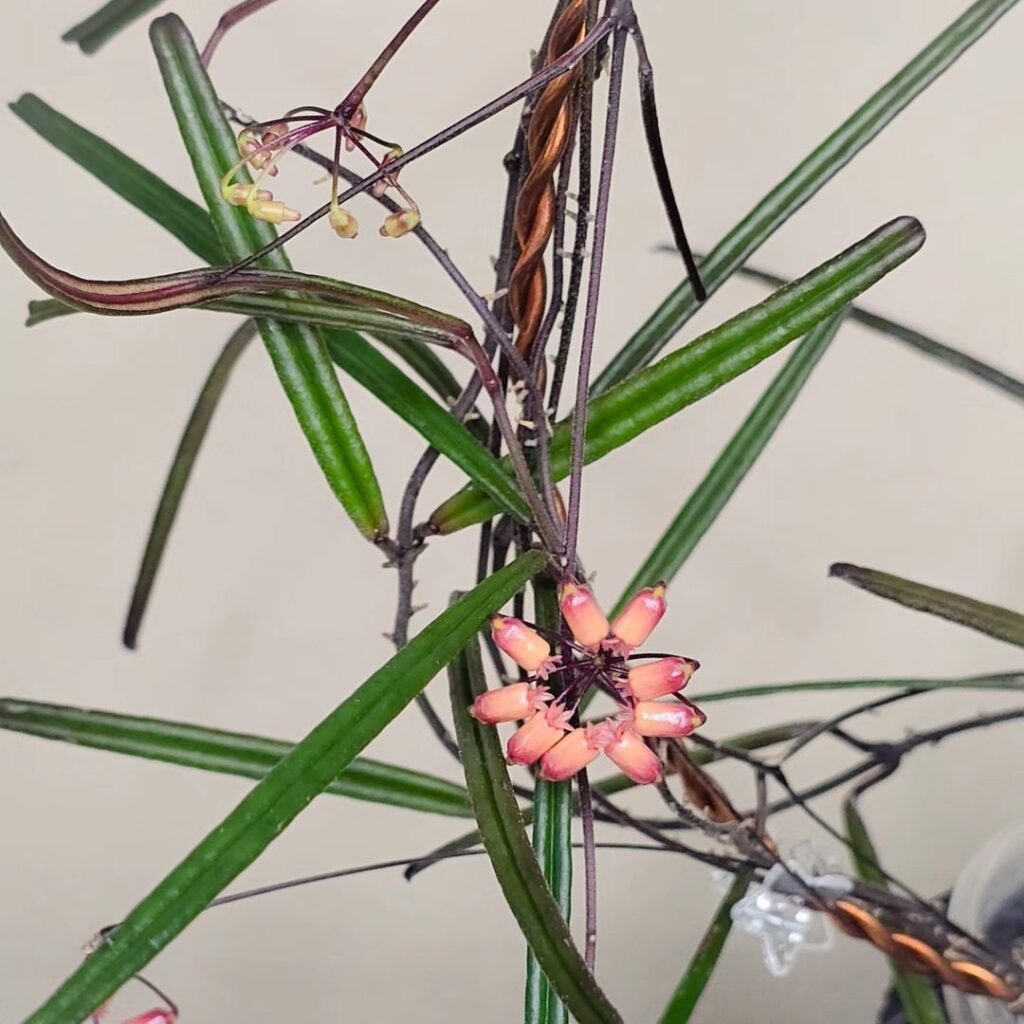
Hoya insularis is an extremely rare plant known for its characteristic long and thin leaves. This unique Hoya species produces very unusual and distinctive pink flowers, making it a highly sought-after addition to any plant collection.
Hoya IR 26
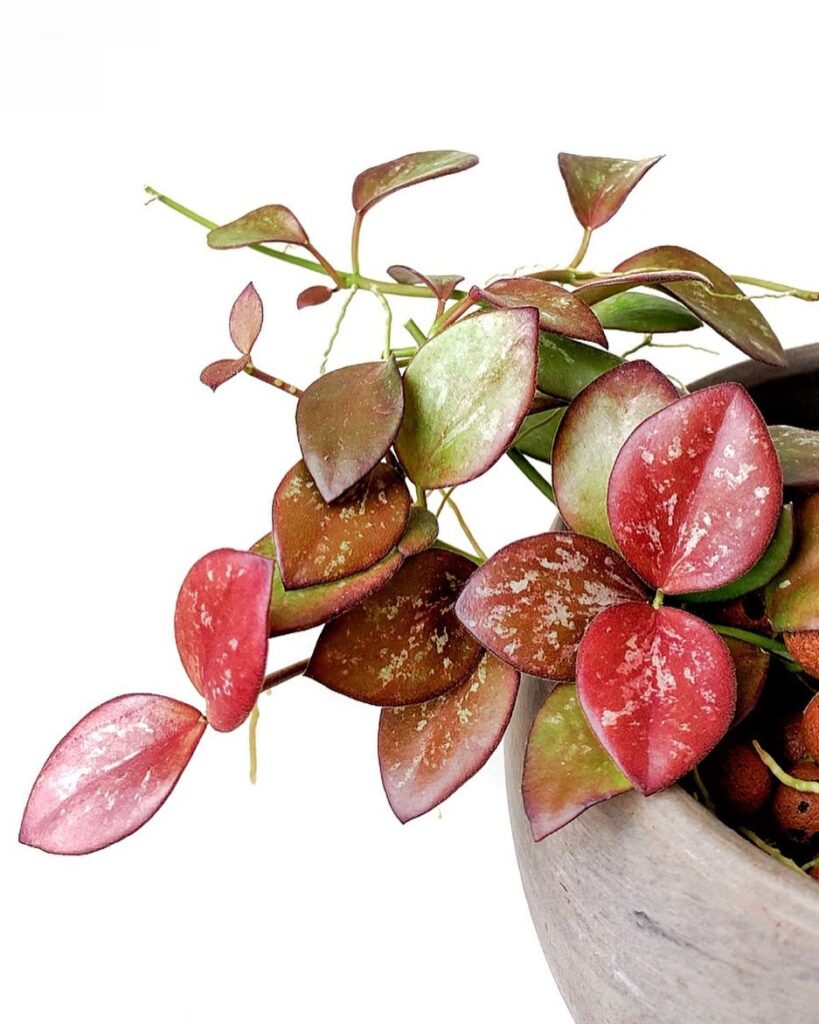
Hoya collina IR-26 is known for its ability to develop splashes and sunstress in bright light, making it a popular variety. It features small to medium-sized leaves that turn red and get splashed under high light conditions. The leaves typically grow in pairs or singles, making it ideal for hanging baskets. This plant can take one to two years to mature enough to bloom, depending on the starting size and growing conditions. Its flowers resemble yellow starfish with red centers and are said to have a light butterscotch fragrance.
Hoya ischnopus
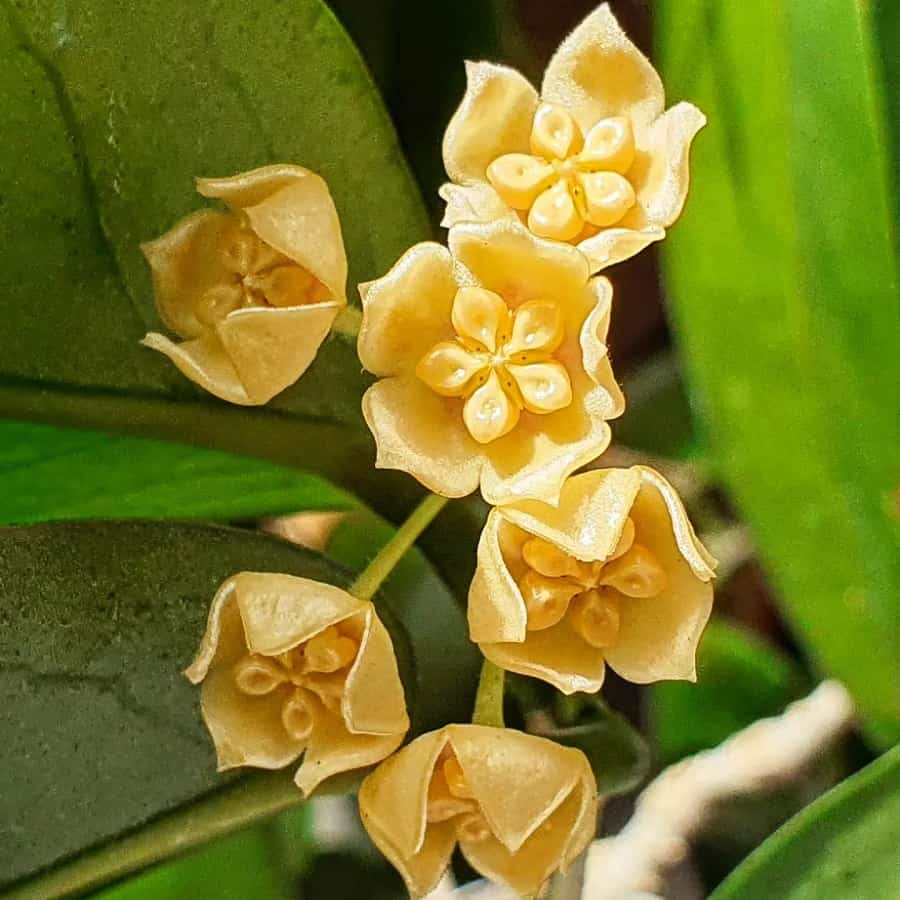
Hoya javanica
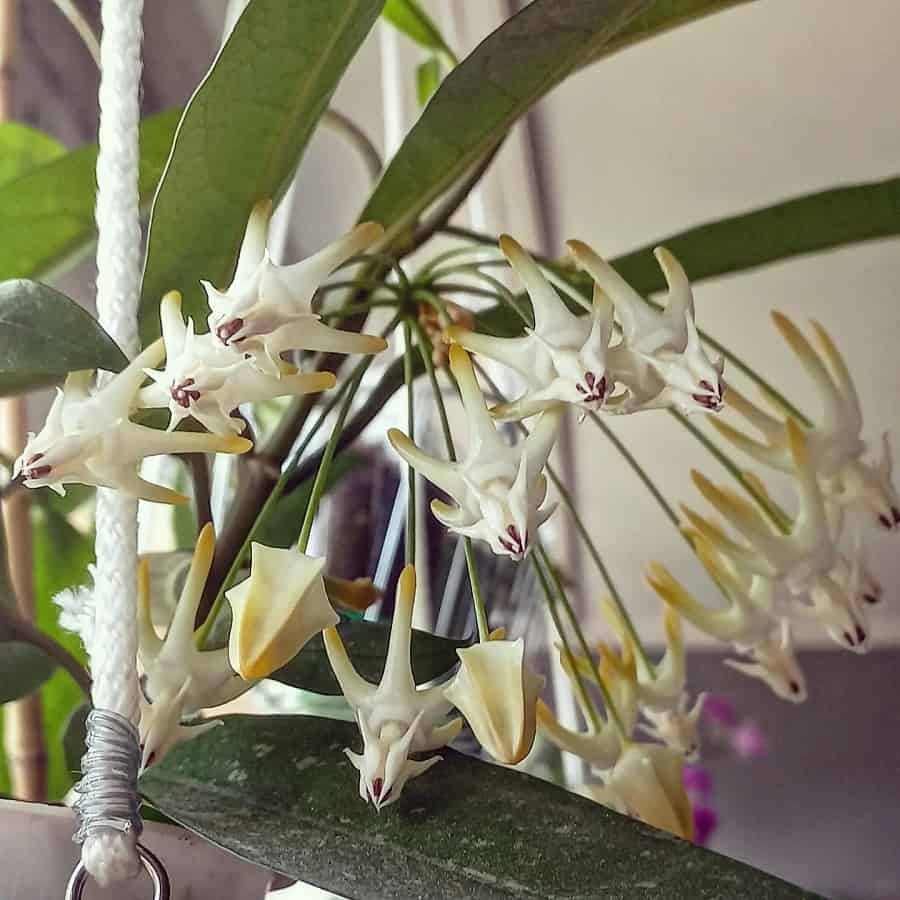
Hoya Jennifer
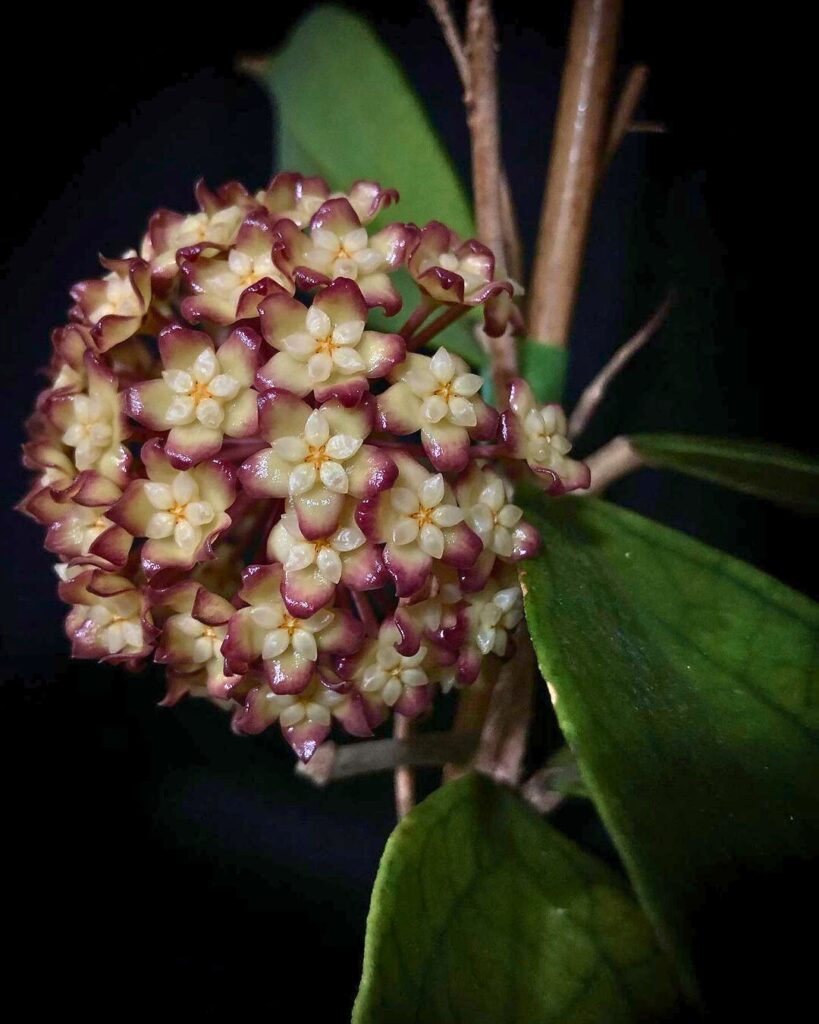
Hoya Jennifer, a rare and beautiful hybrid suspected to be a cross between Hoya incrassata and Hoya finlaysonii, was hybridized by Michael Miyashiro in Hawaii in 1995. This plant features dark green leaves with a rough surface and darker green veins, with slightly fuzzy undersides that are lighter green. The leaves, varying in size from 10-18 cm long and 3-6 cm wide, can grow up to 20 cm.
Hoya Joy
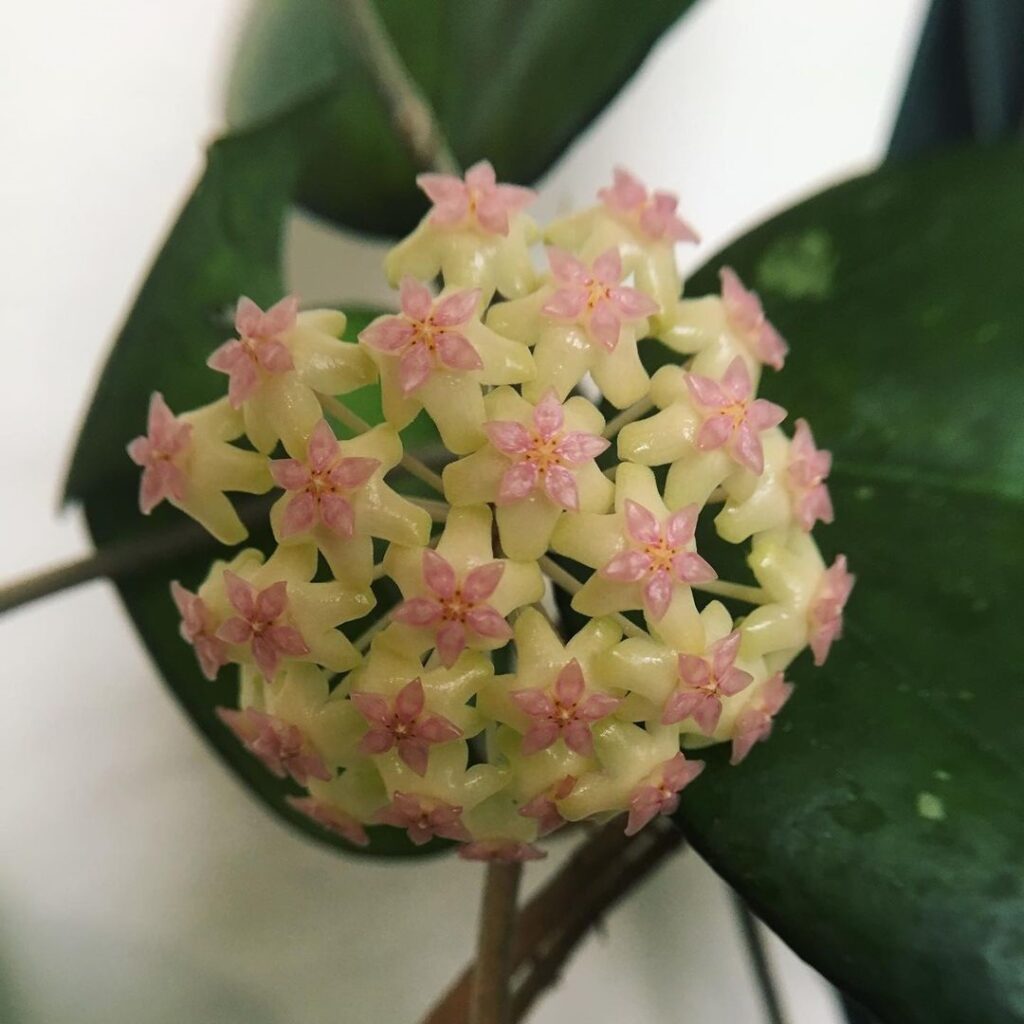
Hoya Joy is a stunning hybrid of Hoya sp. Laos and Hoya Vitellina, known for its large, glossy foliage that resembles a turtle shell. Occasionally, the leaves exhibit random splashes, adding to its visual appeal. This remarkable plant is one of the easiest and most forgiving Hoyas to grow, thriving even in low humidity conditions. Its robust nature makes it an excellent choice for both novice and experienced plant enthusiasts.
Hoya Joy Splash
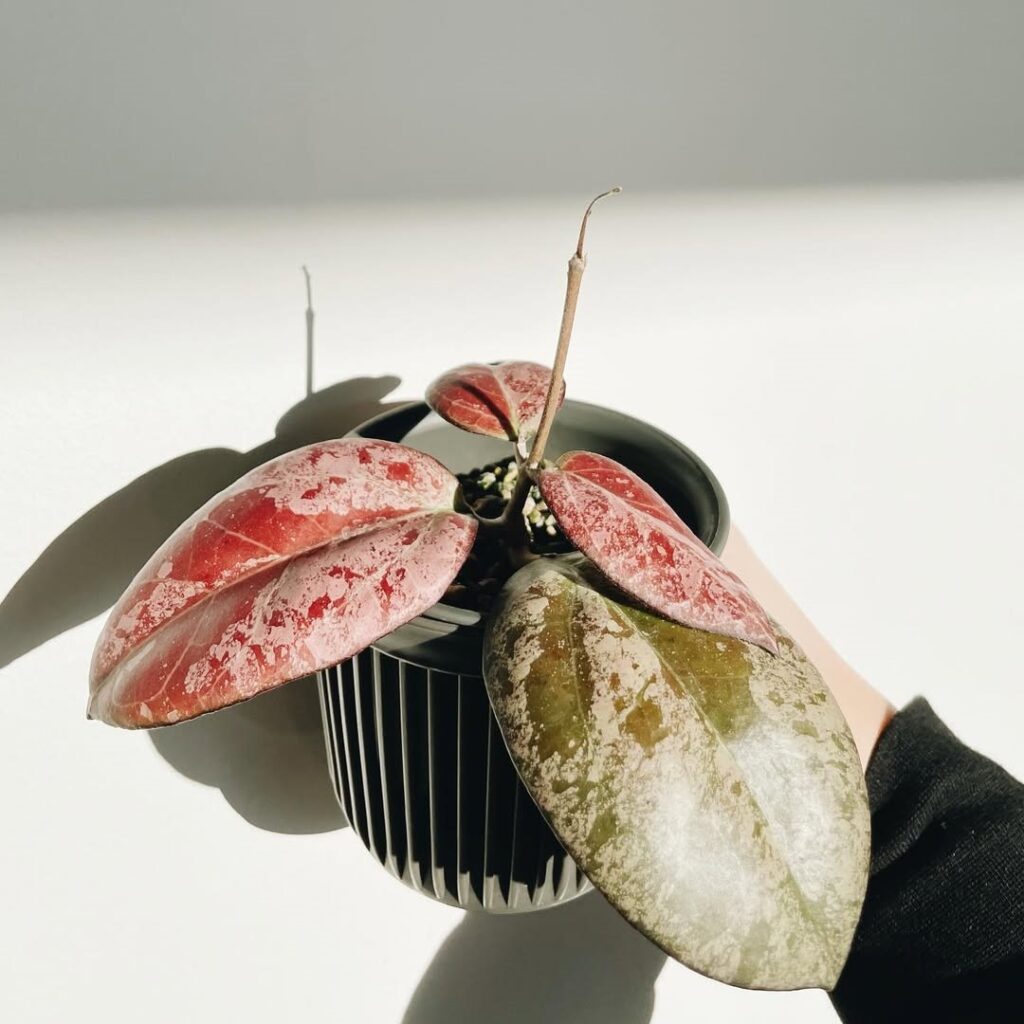
Hoya juannguoana
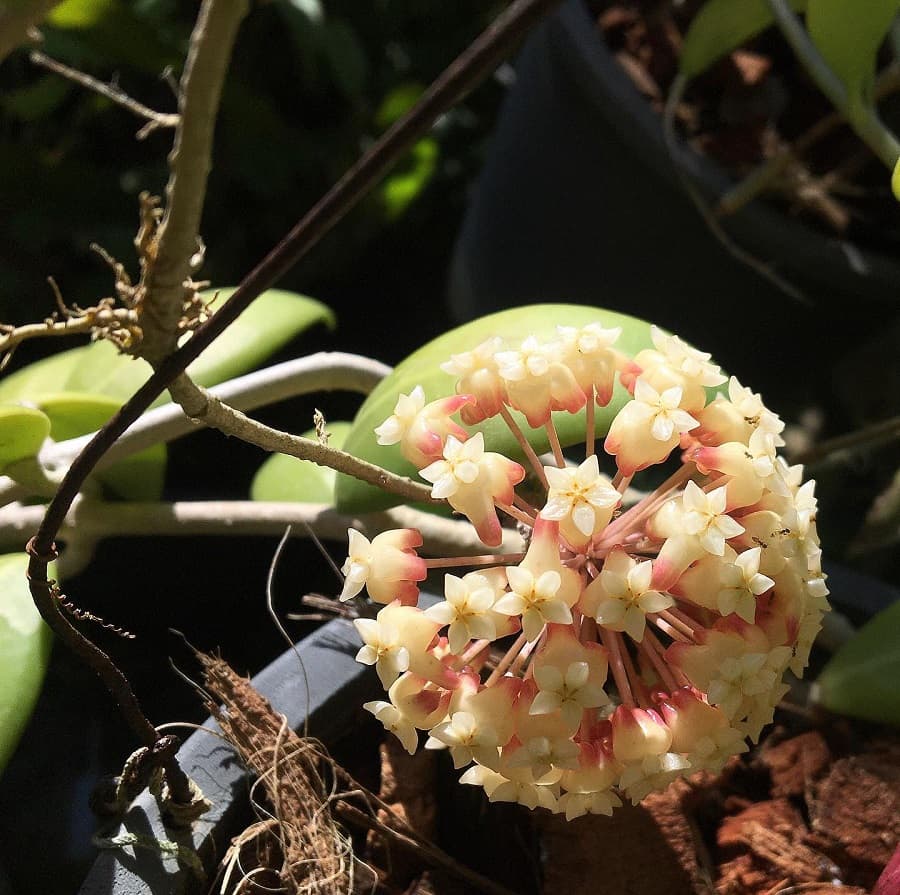
Meet Hoya juannguoana, a rare and stunning species of hoya named after the plant-loving Ju Ann Guo, who hails from Beijing, China and currently resides in the San Francisco Bay Area. This epiphytic vine is a true beauty, with milky sap flowing through all its vegetative parts, pink-bronze new growth, and medium green leaves with a waxy surface and sharp apex.
With creamy yellow corollas that fade to pink-bronze and a thickening dome in the center, Hoya juannguoana is sure to attract hummingbirds and butterflies, just like its namesake interests. This species was collected from the St. Paul’s Underground River in the Sabang Bay Area of the Philippines and is a true gem for experienced horticulturists to care for.
Hoya kanyakumariana
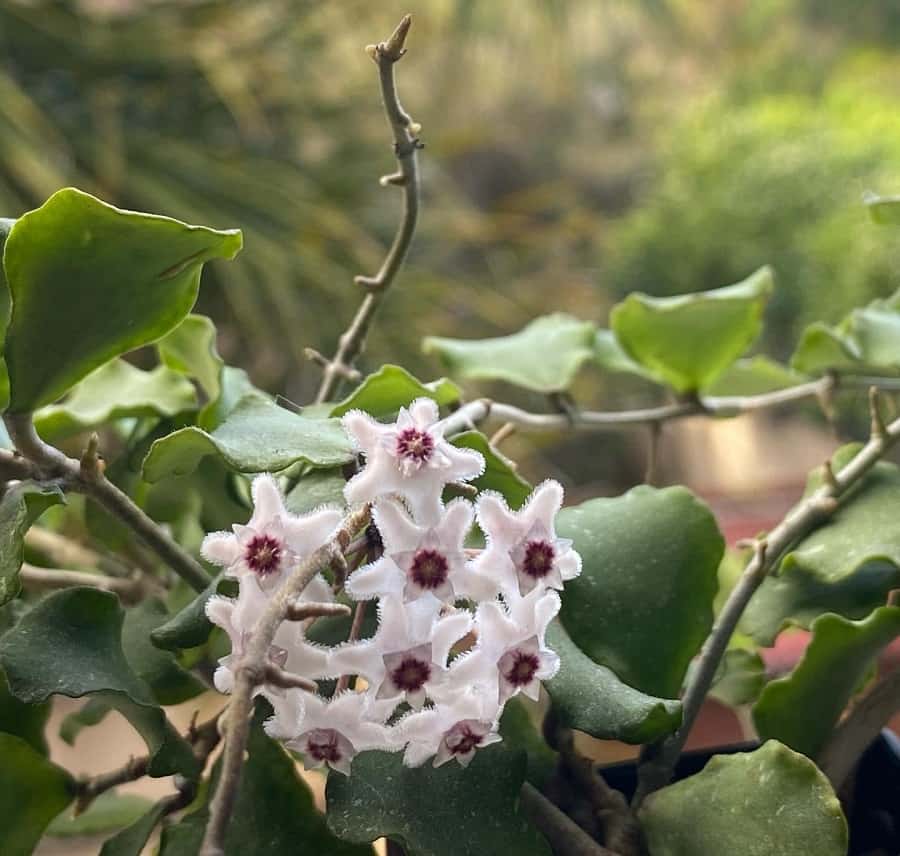
Hoya kanyakumariana is a unique and rare species of hoya, found only in the lush and low-lying region of Kanyakumari in Tamil Nadu, India. This fascinating plant grows as an epiphyte, attaching itself to trees and other plants for support, and boasts a distinctive gray, warty appearance. Its leaves are fleshy, irregularly shaped ovals with a smooth and wavy edge, giving the plant an alluring texture.
When it comes to flowering, Hoya kanyakumariana is a true beauty. The delicate pinkish-purple-white corolla with a pinkish crown and red spot in the center is sure to catch the eye of any nature enthusiast. The blooms are typically about 1-1.2 cm in diameter and last for an impressive 7 days, producing some nectar for visiting pollinators. With 10-20 flowers in each umbel, this hoya is truly a sight to behold!
Hoya kastbergii
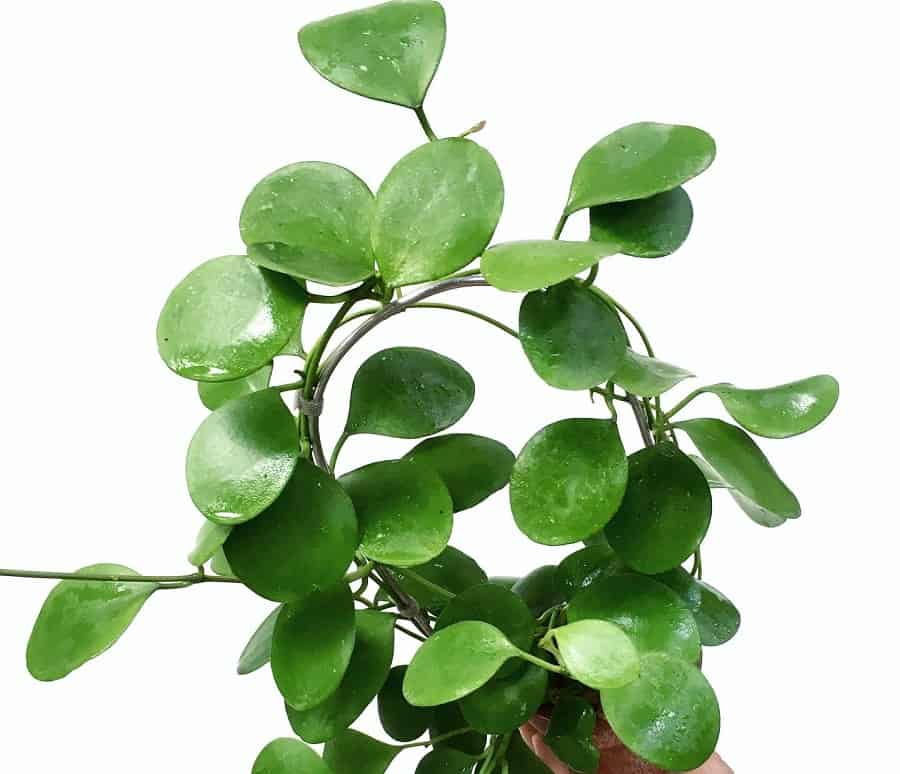
Hoya kastbergii is a rare and unique species of hoya that calls the lowlands of Sulawesi and Borneo in Sarawak its home. It is named after collector Arne Kastberg, who runs the Stenasa Garden Center in Sweden and discovered the species during one of his trips to Borneo. This hoya grows as an epiphyte or lithophyte, and its smooth vines can be found flourishing in shady trees 4-5 meters above the ground.
The leaves of Hoya kastbergii are light green, oval or round in shape, and boast smooth surfaces with veins that are not visible to the naked eye. The plant produces star-shaped flowers in a loose umbrella, with creamy or pale yellow corolla lobes and a light crimson crown. This hoya is related to Hoya diptera and adds a touch of rarity and beauty to any horticultural collection.
Hoya kenejiana

Hoya kenejiana is a rare and beautiful hoya that was discovered in the lush forests of Galerie Kenejia in northeastern New Guinea by the botanist Schlechter. It’s a curly vine with thin, dark green leaves that are 6-10 cm long and 2-2.8 cm wide, giving it a delicate and elegant appearance.
The flowers of Hoya kenejiana are a highlight of this species, and they bloom in umbrellas of 15-25 individual blooms on bare pedicels 2-3.5 cm long. The bright greenish-yellow flowers are approximately 1.4 cm in diameter, and the crown is small at just 3 mm from the apex to the outer end.
Despite its similarities to Hoya ischnopus, Hoya kenejiana has shorter stems and narrower, smaller leaves, making it a unique and interesting addition to any plant collection. This hoya is a true gem of the plant world and a must-have for any hoya enthusiast!
Hoya kentiana
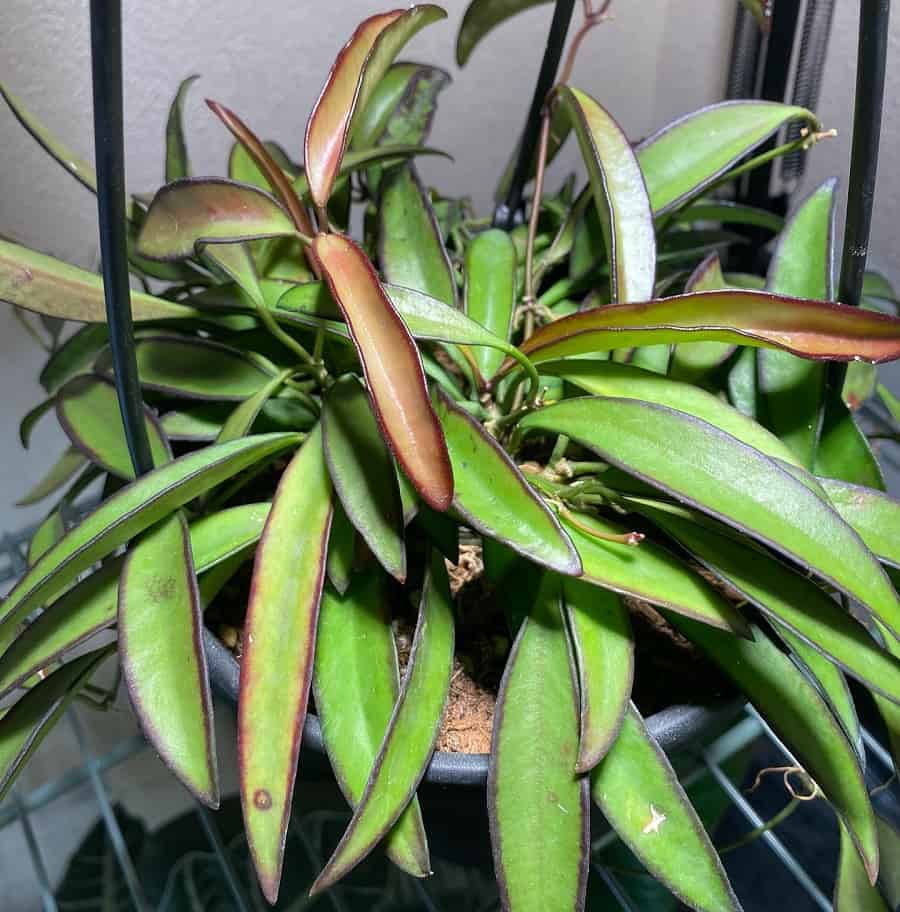
Hoya kentiana is a stunning ampelous hoya, native to the Philippines. This plant is a juicy beauty, with dark green leaves that are 15 cm long and 5 cm wide. The leaves are so dark green that the veins are barely visible. When it blooms, up to 20 sweet-smelling, red flowers open in a gorgeous flower umbrella. Despite being similar to Hoya wayetii, Hoya kentiana can be distinguished by its narrower leaves and paler underside. This plant is an easy-to-grow beauty that blooms regularly, making it a perfect addition to any collection.
Hoya kerrii
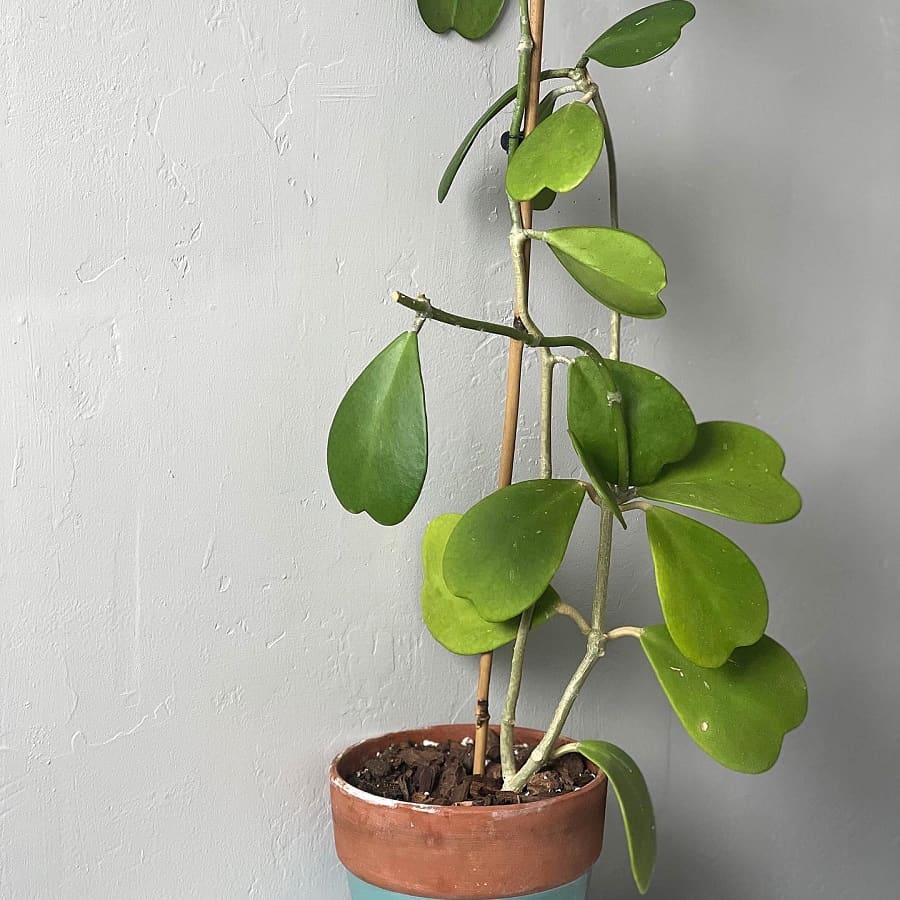
Hoya kerrii, discovered by AFD Kerr in the jungles of Northern Thailand, is a heart-shaped beauty that is both sturdy and versatile. Its strong, smooth stems can reach lengths of 2 to 3 meters, while its thick, succulent leaves are obovate and come in sizes of 5 to 15 cm in length and width. Its flowers, which come in an impressive spherical umbrella of 15 to 25, bloom in various shades of white, yellow, pink and red-brown, changing color as the flowers mature.
This fascinating species can also be found in countries such as Laos, Cambodia, China, South Vietnam and Indonesia’s Java. With its pubescent leaves and flowers, Hoya kerrii is a unique and captivating plant that is a joy to grow.
Hoya keysii
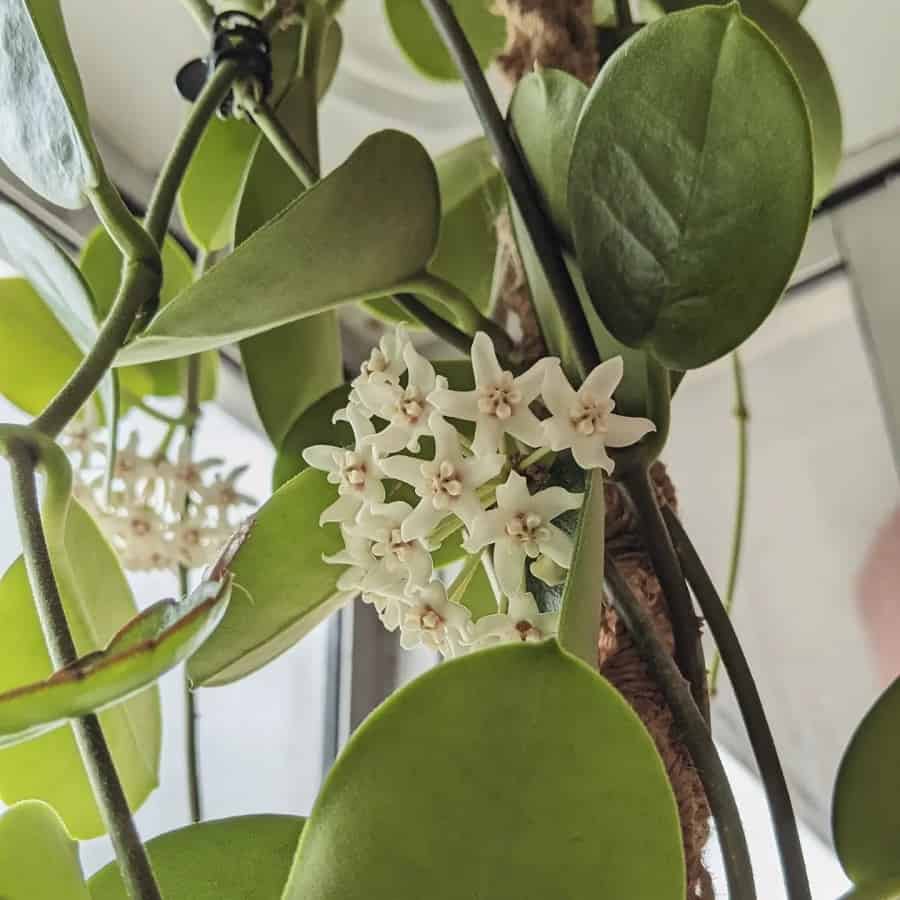
Hoya kloppenburgii
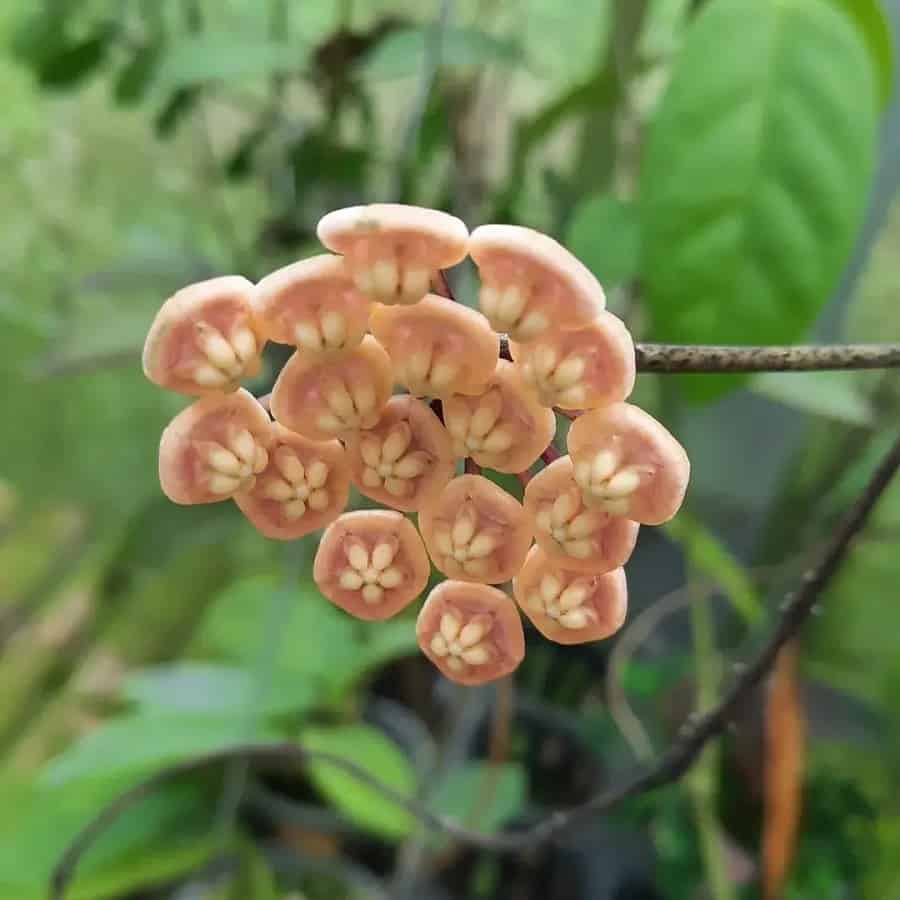
Hoya kloppenburgii is a unique species of Hoya with a fascinating history. It was named after Dale Kloppenburg, a Hoya explorer, by Ted Green and was originally found in Rundum, Sabah, Malaysia, at an altitude of 1,000m above sea level. This climbing epiphyte is known for its hard, “wire” vines and air roots that grow randomly along the length of its vine.
The leaves of Hoya kloppenburgii are oblong-oval, dark green, and have a silvery speck on the upper side, with torn, thickened edges that turn red in the summer under the active sun. In the summer, 10-20 golden yellow flowers about 1 cm in diameter open in a slightly concave flower umbel, with thin pedicels up to 2.5 cm long. The crown of the flower is yellow, forming a “skirt” at the base, and the aroma is pleasant. This species is a unique hybrid of two Hoya sections, Acanthostemma and Otostemma, and is closely related to Hoya sp. Sabah SBH35, which has a bright yellow-red crown and a reddish “skirt.”
Hoya Krimson Princess
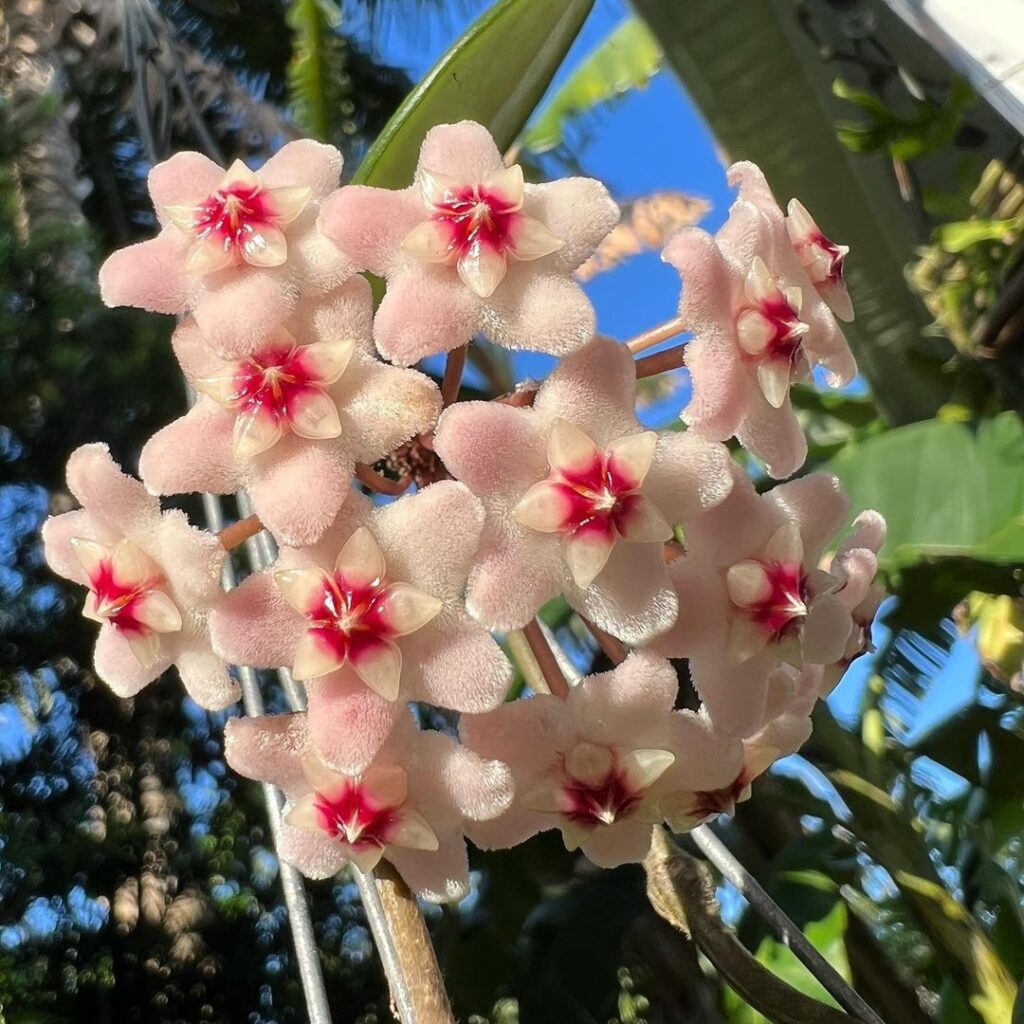
The Hoya Krimson Princess, also known as Hoya carnosa Krimson Princess or Hoya Rubra, is a tropical houseplant admired for its thick, lanceolate leaves with creamy yellow to white variegation in the center and new leaves often tinged with reddish pink. It produces small, round clusters of up to 30 waxy flowers, ranging from white to pink with red centers, that emit a fragrance reminiscent of chocolate, vanilla, and honey. Native to Central Asia, the Pacific Islands, and Australia, this low-maintenance plant from the Apocynaceae family thrives indoors, whether grown on a trellis or in a hanging planter.
Hoya Krimson Queen
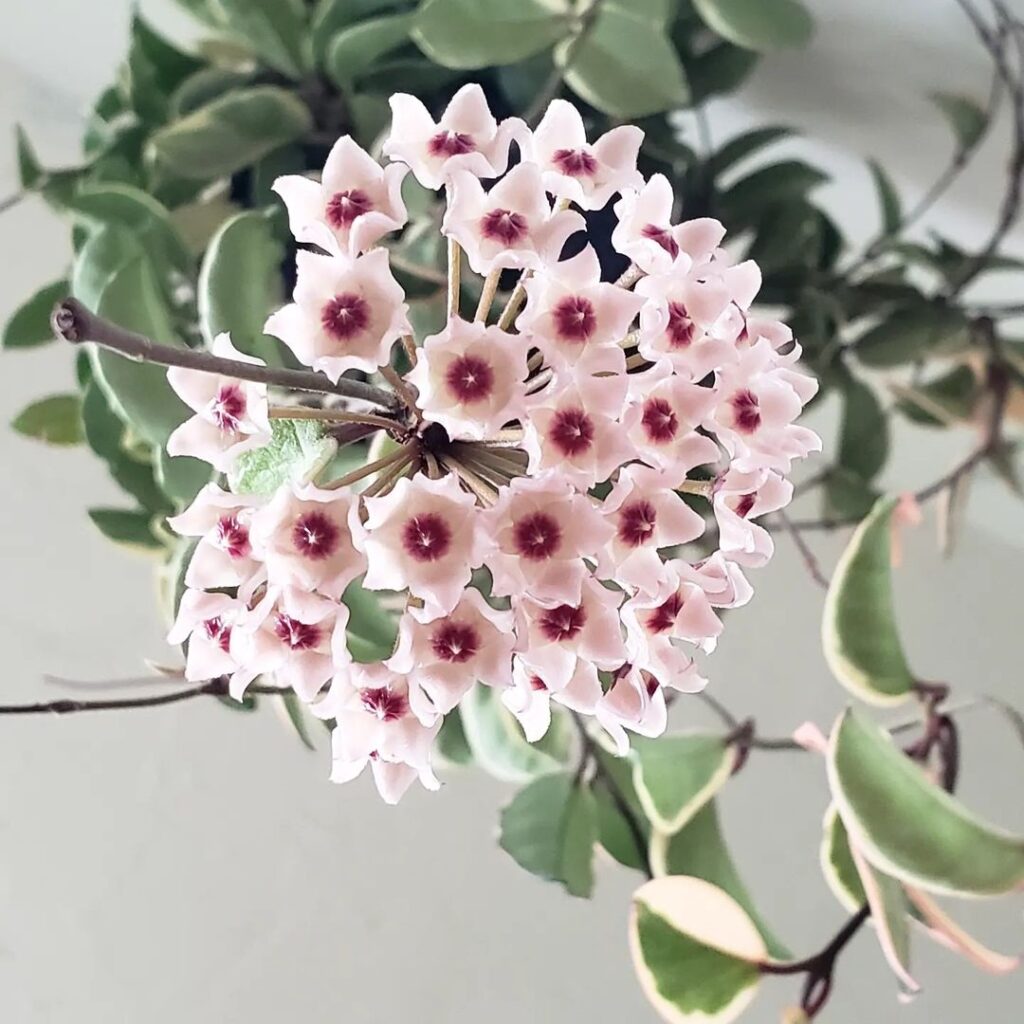
Hoya Krimson Queen, also known as Hoya carnosa ‘Tricolor’, is a popular houseplant with variegated green, waxy leaves edged in white and pink. It produces star-shaped flowers with a reddish-pink center and thrives in bright, indirect light, temperatures between 60 and 85 degrees, and well-drained, slightly acidic potting soil. This plant typically grows 3–6 feet indoors.
Hoya krohniana

Hoya krohniana is a charming and unique epiphyte hailing from the Philippines, named after Phillip Krohn. This hoya is an ampelous variety, meaning it has a tendency to grow as a trailing vine. The leaves are small, with a deep green color, and are shaped like an oblong heart. They are no more than 4 cm long and grow opposite each other on the stem.
The flowers of Hoya krohniana are its defining feature, with a larger corolla and crown compared to its close relative, Hoya lacunosa. The corolla measures 1.20 cm in diameter and the crown lobes have an apex-to-apex distance of 0.25 cm, making it easy to distinguish from its cousin. The peduncle of Hoya krohniana is also longer, at 1.4 cm, making this variety truly one-of-a-kind.
Hoya kuhlii

Hoya lacunosa

Hoya lacunosa is a fast-growing and abundant flowering hoya native to Southeast Asia and India. It is an epiphyte, meaning it grows on other plants, and has a symbiotic relationship with ants that live among its roots and leaves. This hoya requires a loose substrate and constant humidity to thrive, and is known for its small, deep green leaves with characteristic depressions between the veins.
The flowers of Hoya lacunosa are small and fluffy, with white corolla blades dotted with purple and a white or light yellow crown. The flowers emit a pleasant fragrance that changes from clove-like during the day to frankincense-like in the evening, and can last for up to three days. Overall, Hoya lacunosa is a unique and beautiful plant that makes for a great addition to any collection.
Hoya lambii
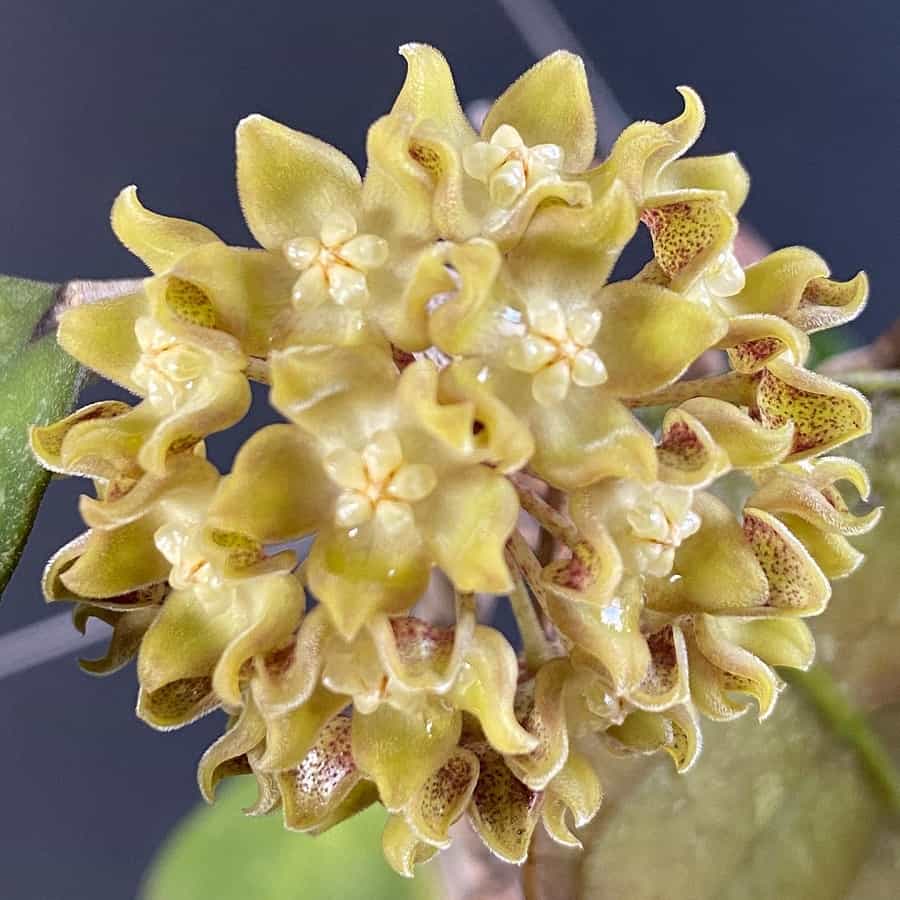
Hoya lambii is a unique and remarkable hoya that was discovered in Borneo (Sabah) by Tony Lamb and Ben Wallace. With its thick, juicy stems that can grow up to 30 meters long, Hoya lambii is a strong and sturdy plant that can thrive as a terrestrial or epiphytic hoya.
The leaves of this hoya are large, with a round to elliptical shape and a pinnate venation. They are arranged in groups of two at each node, with up to six leaves forming a funnel-like shape. These leaves have a matte, paper-like appearance and are perfect for directing water and debris into their trap, making a wonderful home for ants.
The flowers of Hoya lambii are a stunning sight to behold. The umbel grows against the Earth’s gravity, and consists of 35-60 greenish-white flowers that are 1.7-1.8 cm in diameter. The petals are raised up, creating a bowl-like shape, with an ivory crown. The aroma of the flowers is light and pleasant.
Hoya lamingtoniae
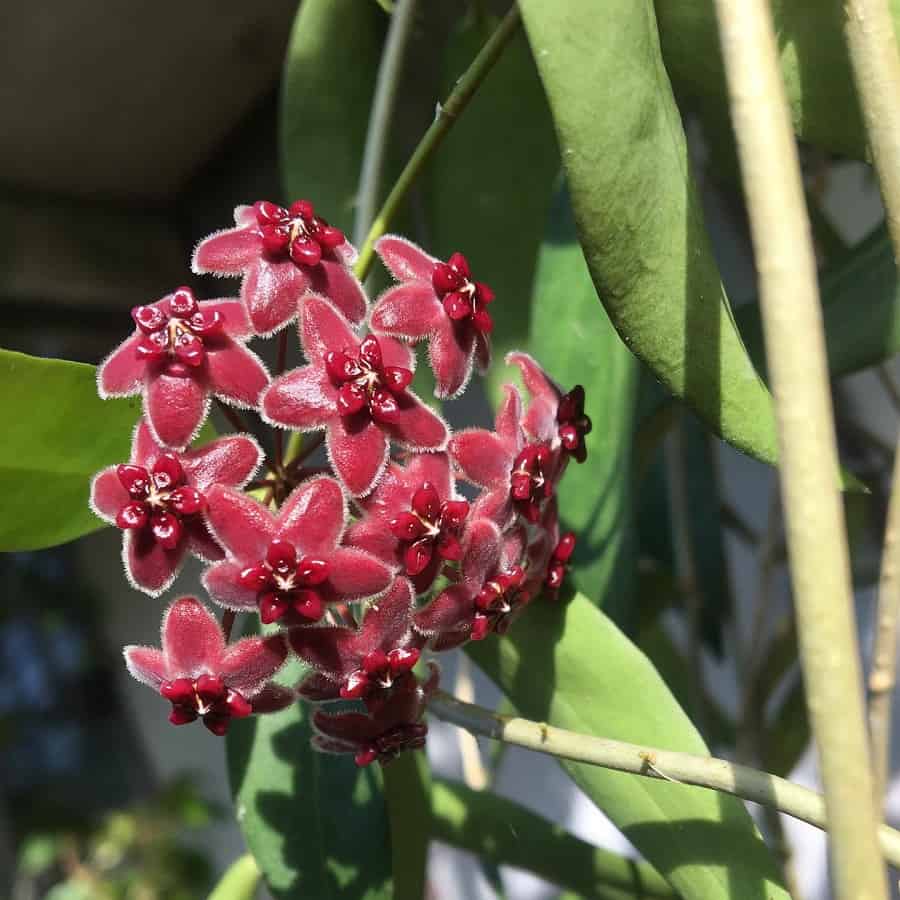
Hoya lamingtoniae is a slow-growing, beautiful hoya native to Oro Province in Papua New Guinea and named after the wife of the governor of Queensland, Australia. This medium-sized, epiphytic hoya is known for its striking leaves, which are lanceolate, dark green and smooth with 3 fanning main veins. At a young age, its leaves are a unique red-brown color.
When it blooms, it displays 10-25 individual cherry-colored flowers with a stellate corolla and a crown that is darker than the corolla with a yellow spot in the center. Its flowers have a very weak scent and last for 4-5 days. To maintain optimal health, Hoya lamingtoniae prefers to keep its soil constantly moist, but can tolerate short drying spells. It thrives in a bright place without direct sunlight.
Hoya lanceolata ssp bella
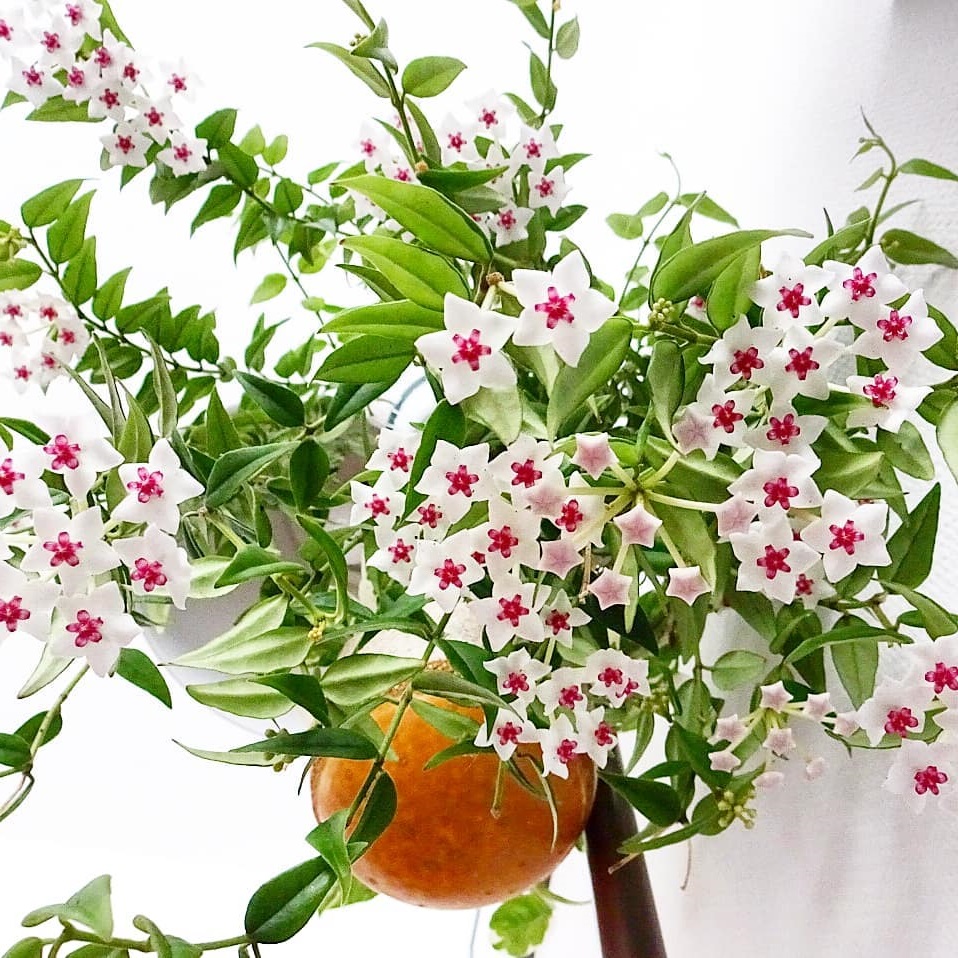
Hoya lanceolata ssp. bella is a type of hoya plant that is found in several countries including Vietnam, Nepal, India, Myanmar, and Thailand. It grows as a shrub-like herb with shoots up to 0.5 meters long in evergreen forests at the foot of mountains. Its leaves are narrow and lanceolate, with pointed tips and green color. It produces white flowers with a light pink crown that are collected in small umbels. The plant needs good lighting, but not direct sunlight, and a loose and moderately moist substrate to grow well.
There are two cultivars of this plant: Hoya lanceolata ssp. bella variegata (left) and Hoya lanceolata ssp. bella albomarginata (right).

Hoya lanceolata ssp lanceolata

Hoya lanceolata ssp. lanceolata is a unique subspecies of the Hoya lanceolata plant that showcases distinct differences from the subvariety bella. Despite having similar-looking flowers, the crown of Hoya lanceolata ssp. lanceolata has a pale hue and a pagoda-like shape in profile. Unlike Hoya lanceolata ssp. bella that only blooms once a year, Hoya lanceolata ssp. lanceolata produces multiple flower umbels along the stem, adding to its beauty and charm.
Hoya lasiantha
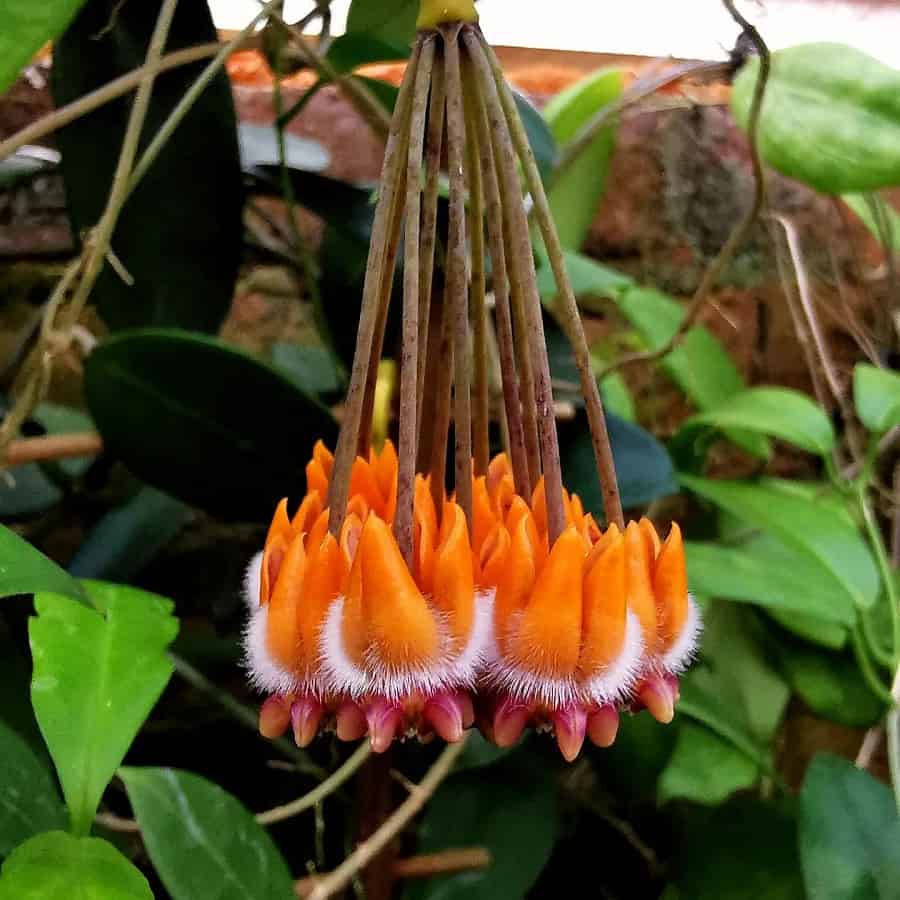
Hoya lasiantha is a luscious and lanky epiphyte that boasts glossy yellow or light orange flowers with dense white pubescence around the crown, giving it its scientific name meaning “hairy flower”. This hoya variety is not just easy on the eyes, it’s also a dream to care for with its basic requirements of loose soil, moderate moisture and a bright place with some shading.
The best part? Hoya lasiantha is a repeat bloomer that flowers throughout the year, making it a delightful addition to any collection. Its tropical fruit aroma and impressive size distinguish it from its close relative, Hoya praetorii. Hoya lasiantha is the perfect choice for beginner hoya enthusiasts.
Hoya latifolia
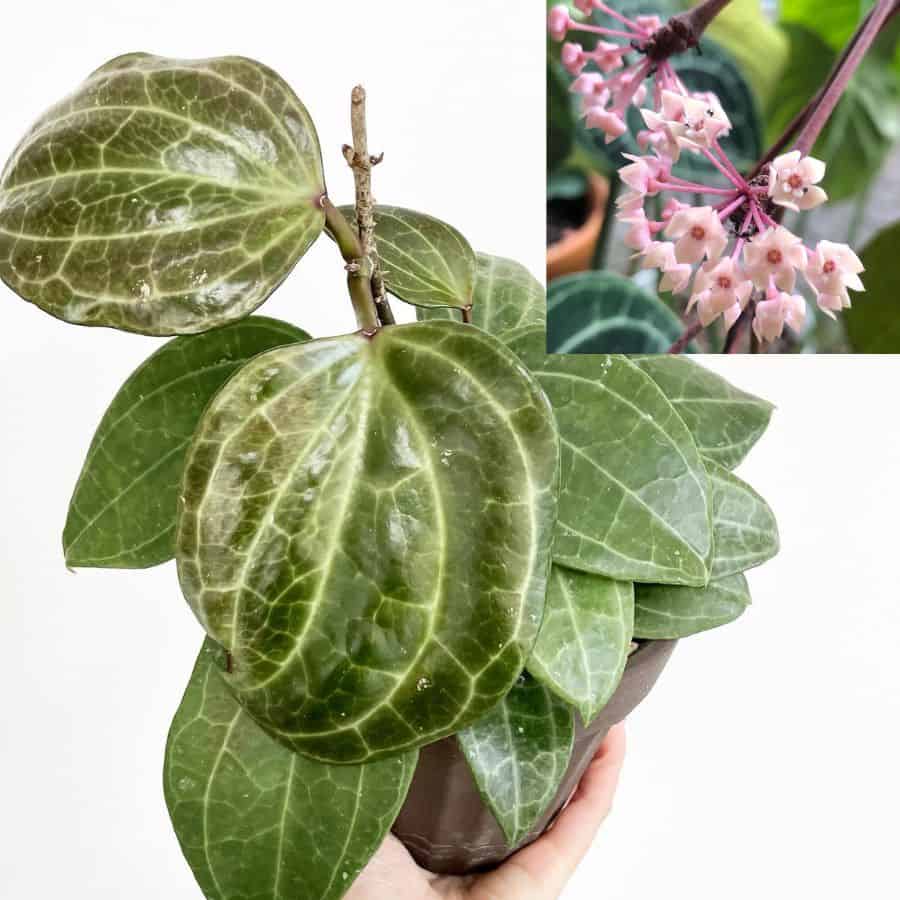
Hoya latifolia is a magnificent vine with strong stems and lush, large leaves that catch the eye with their smooth, bright green texture and distinctive 5 veins. The edges of the leaves are curled, adding to its captivating appearance.
When in bloom, this hoya variety showcases an impressive flower umbrella with up to 40 single flowers, each with a small crown and short corolla lobes. The peduncles and pedicels are thick and pubescent, adding to its charm. Despite its small size, the corolla boasts a diameter of 3-4 cm when fully open, making it a standout in any collection. With its impressive size and striking appearance, Hoya latifolia is a must-have for any hoya enthusiast.
Hoya lauterbachii
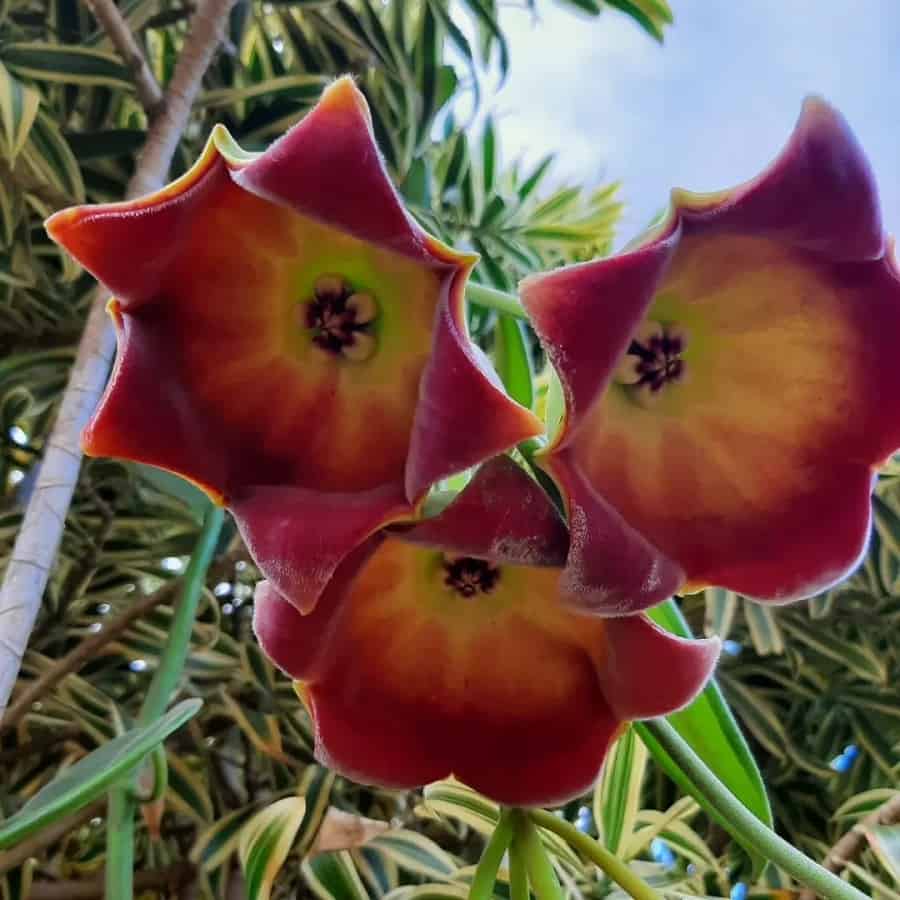
Hoya leucantha
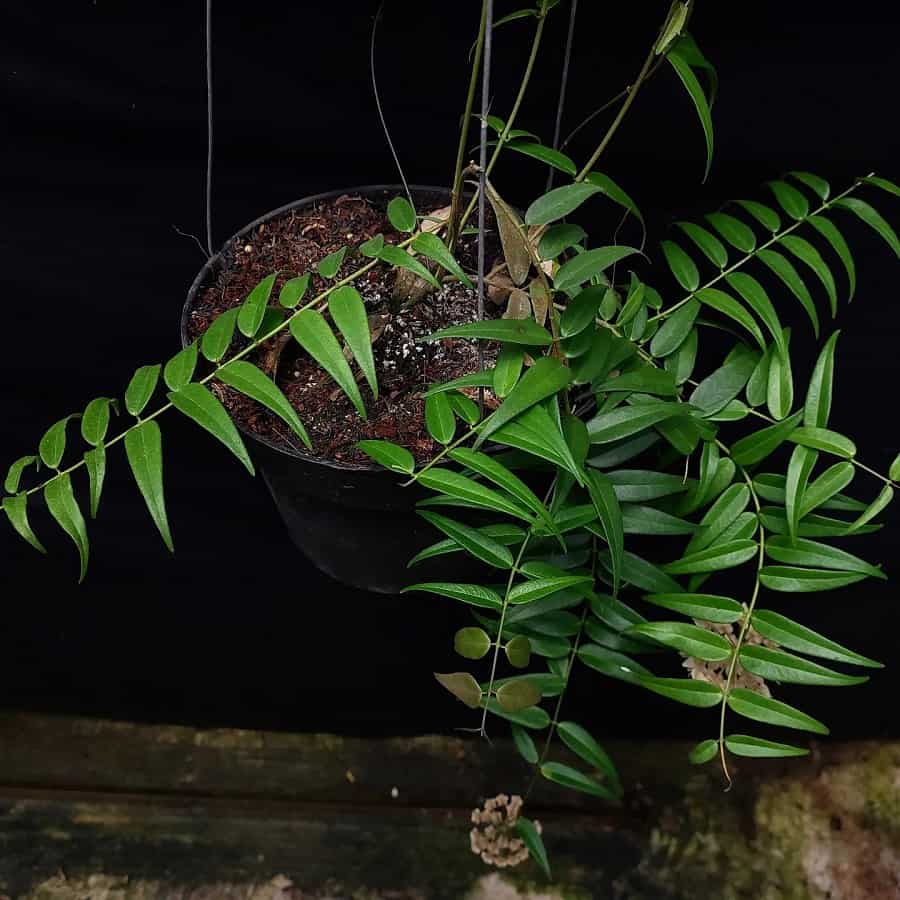
Hoya leucantha is a fascinating plant that is a true climbing and epiphytic wonder. With its combination of both curly and straight stems, this hoya adds an interesting texture to any garden or collection. Its stems are thin and cylindrical, with a white latex juice, while the leaves are lanceolate and bare with a pinnate venation. The inflorescence is positively geotropic and features cream to pale yellow or pink star-shaped flowers with a pale yellow crown that sometimes has a red spot. This unique hoya will definitely make a statement wherever it grows.
Hoya leucorhoda
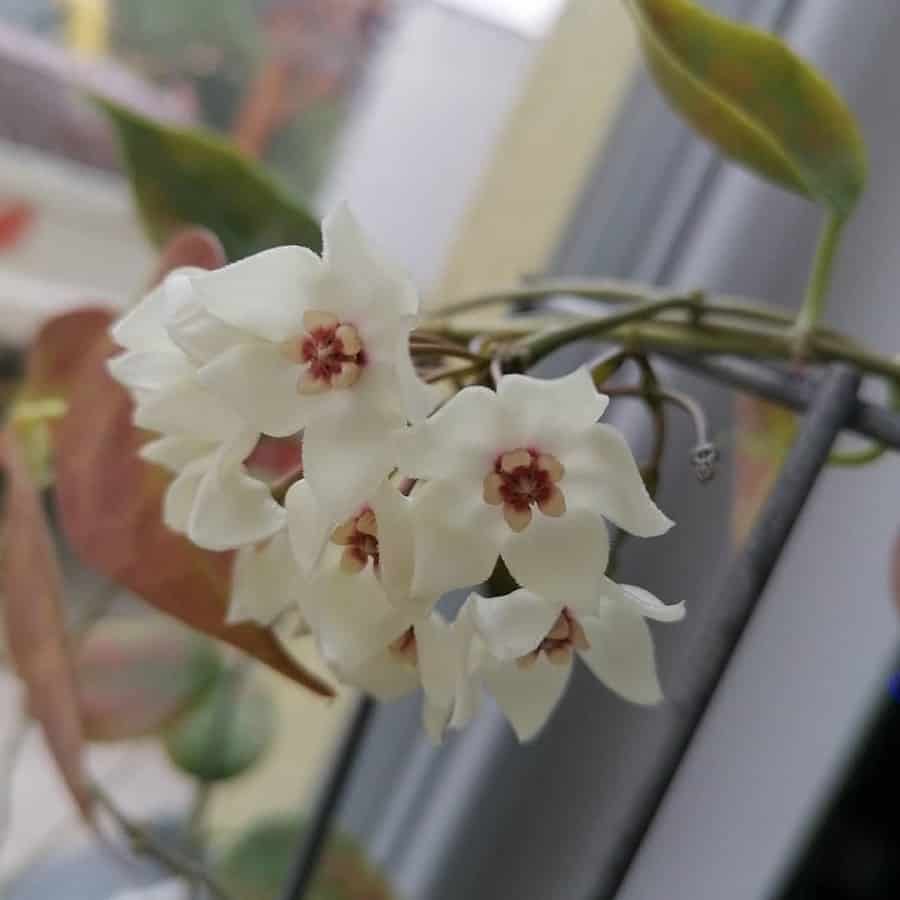
Hoya leucorhoda is a rare and highly sought after epiphytic hoya that comes from Papua New Guinea. Discovered by Dr. Schlechter, this plant quickly became his favorite due to its beauty and versatility. The smooth, light green, lanceolate leaves grow quickly and the plant needs support as it climbs.
The star-shaped flowers are crystal white with a light pink crown that can vary in color from white to dark purple. This hoya requires a well-moist soil and regular illumination in winter to thrive. However, be sure to keep a close eye on it as it is prone to spider mites. Hoya leucorhoda is a unique and beautiful plant that will surely make a statement in any greenhouse or collection.
Hoya leytensis
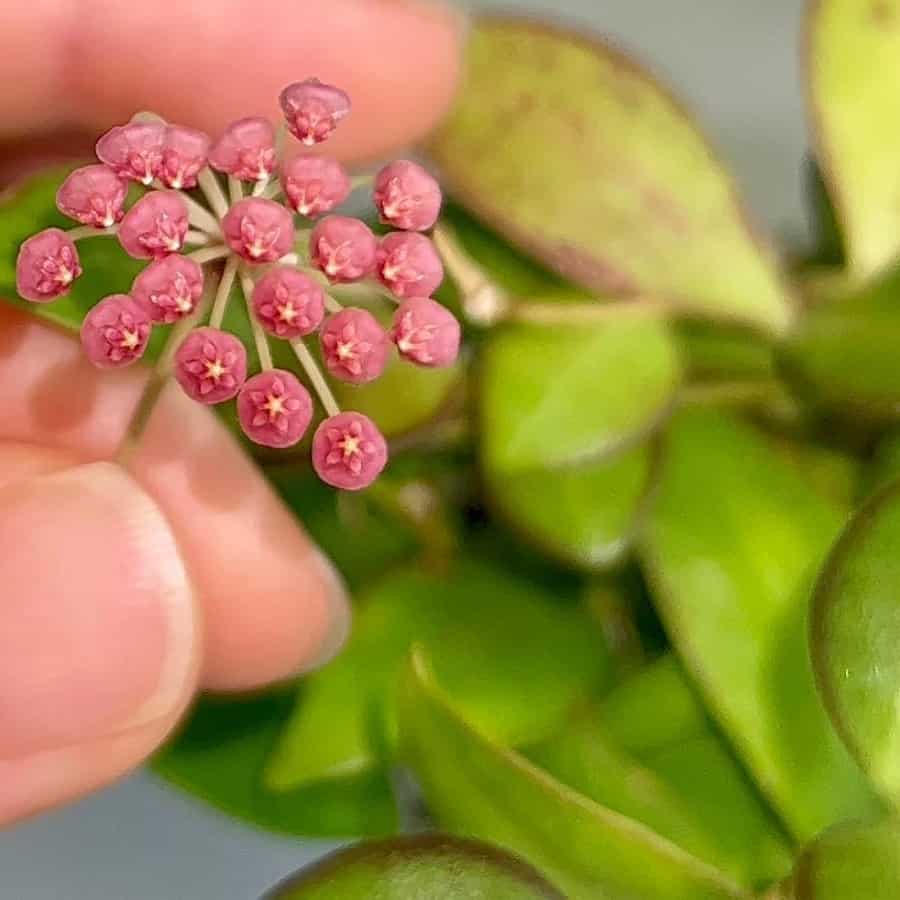
Hoya leytensis is a unique and charming hoya that stands out with its small, leathery, grey-green leaves. These leaves are often dimorphic and matte, with no pubescence, and measure 1-4 cm in width and 2-3 cm in length.
When in bloom, this hoya produces small umbrellas of 10-25 pinkish-beige flowers with wrapped lobes. The crown is two-lobed, with a ciliated rim around the gynostegia, and the flowers have a diameter of 0.5 cm. The flowering period lasts only 4-5 days, making it a fleeting but beautiful sight to behold. Overall, Hoya leytensis is a must-have for any hoya enthusiast or collector.
Hoya limoniaca
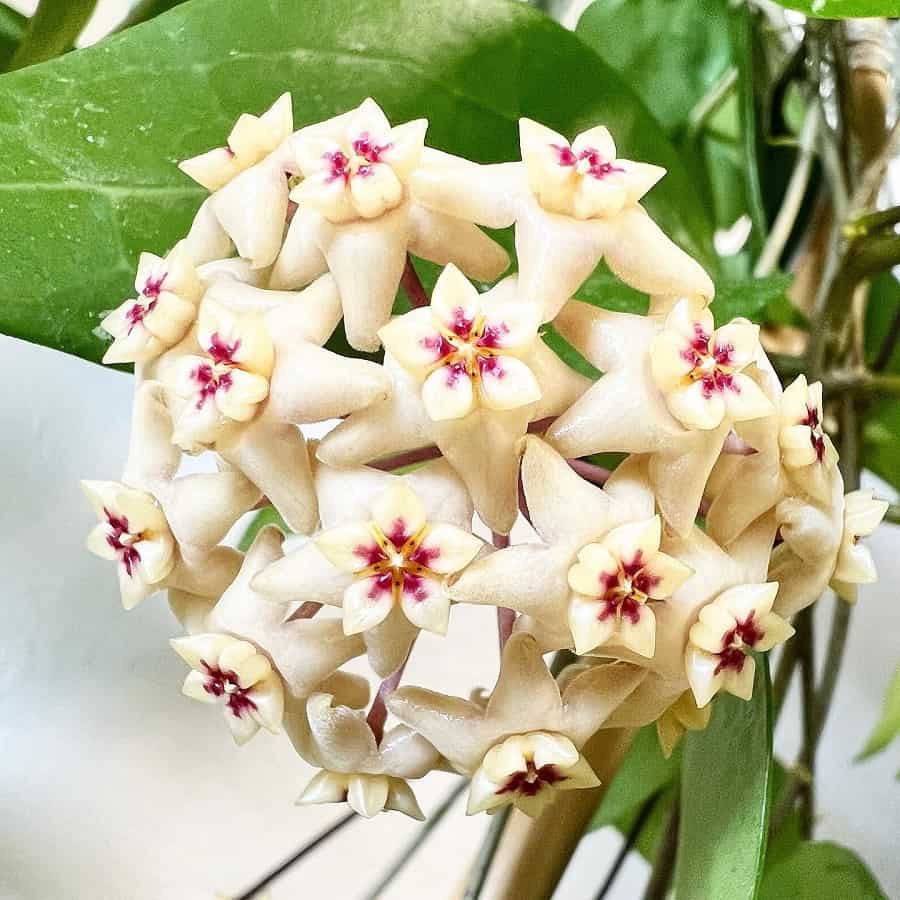
Hoya limoniaca is a fascinating hoya that’s sure to catch your eye with its unique characteristics. This climbing vine boasts almost completely bare flower parts and a cylindrical stem that’s thick, with a noticeable thickening at the nodes. The leaves are usually thick and leathery, with five main veins, measuring 7-8 cm long and 3-3.5 cm wide, and have a rounded base and an oval shape that tapers towards the tip.
During the bloom, Hoya limoniaca produces 15-20 individual flowers, each 1.0 cm in diameter, with pale yellow corolla lobes that are bent back. The crown color can vary from deep pink to creamy white and the flowering period lasts up to a week. All in all, Hoya limoniaca is a beautiful and captivating hoya that’s sure to impress.
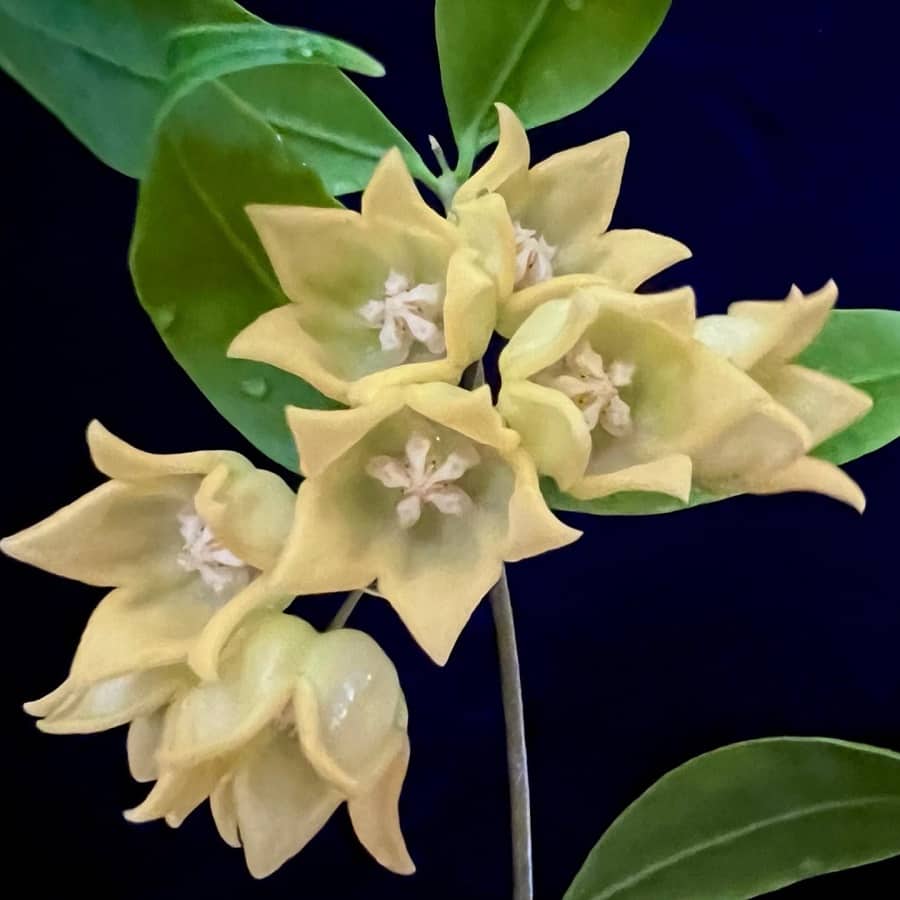
Hoya linavergarae is a fascinating species, with a flower crown that sets it apart from the rest. This climbing plant grows bushy, with smooth leaves measuring 4-5 cm long and 1.1-2.7 cm wide. The flowers are broadly bell-shaped, around 2 cm in diameter, and have a unique crown with curved inner coronal lobes that give the flower a distinct look. With its unique features, Hoya linavergarae is sure to captivate anyone who encounters it.
Hoya linearis
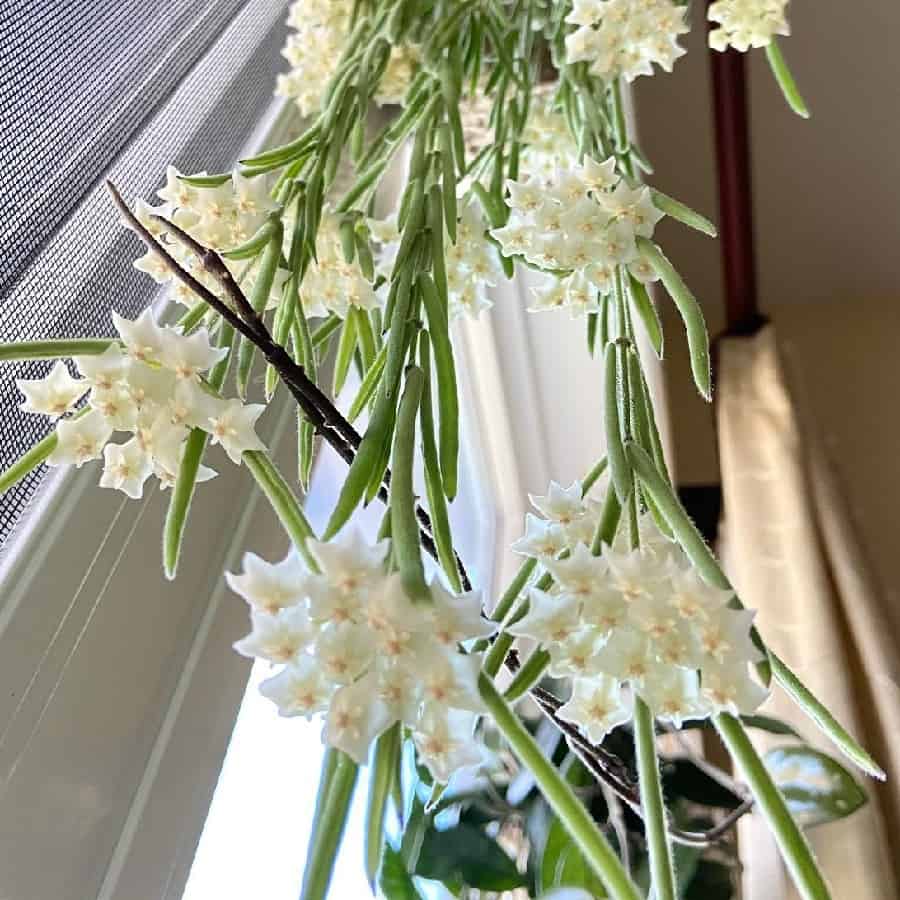
Hoya linearis is a rare and beautiful species of hoya that can grow up to 6 meters long. Its leaves are linear and slightly pubescent, with bent edges that form a groove on the inside. During the flowering season, it produces up to 20 creamy-white, slightly citrus-scented flowers, each with a diameter of 1.25 cm.
This hoya is a mountain variety that prefers a cool and shady environment, moist soil, and regular feeding. The flowering season typically occurs in early autumn or sometimes in spring, and the flower stalks fall off after blooming without producing nectar.
Hoya litoralis
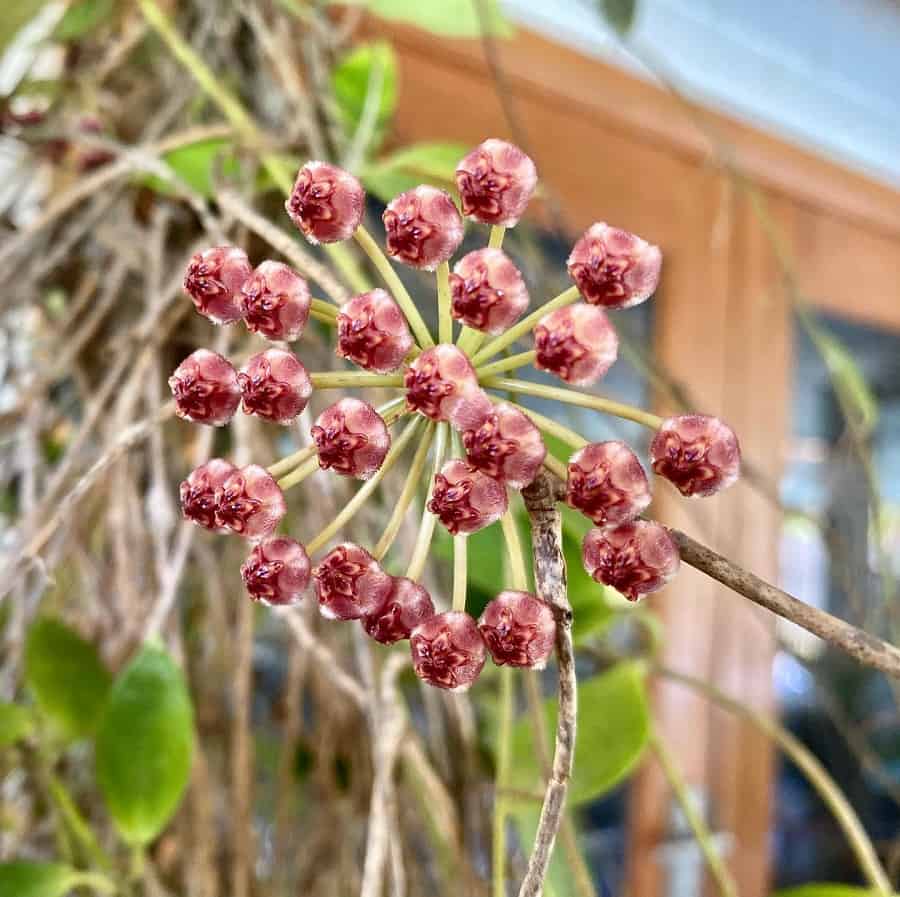
Hoya lobbii
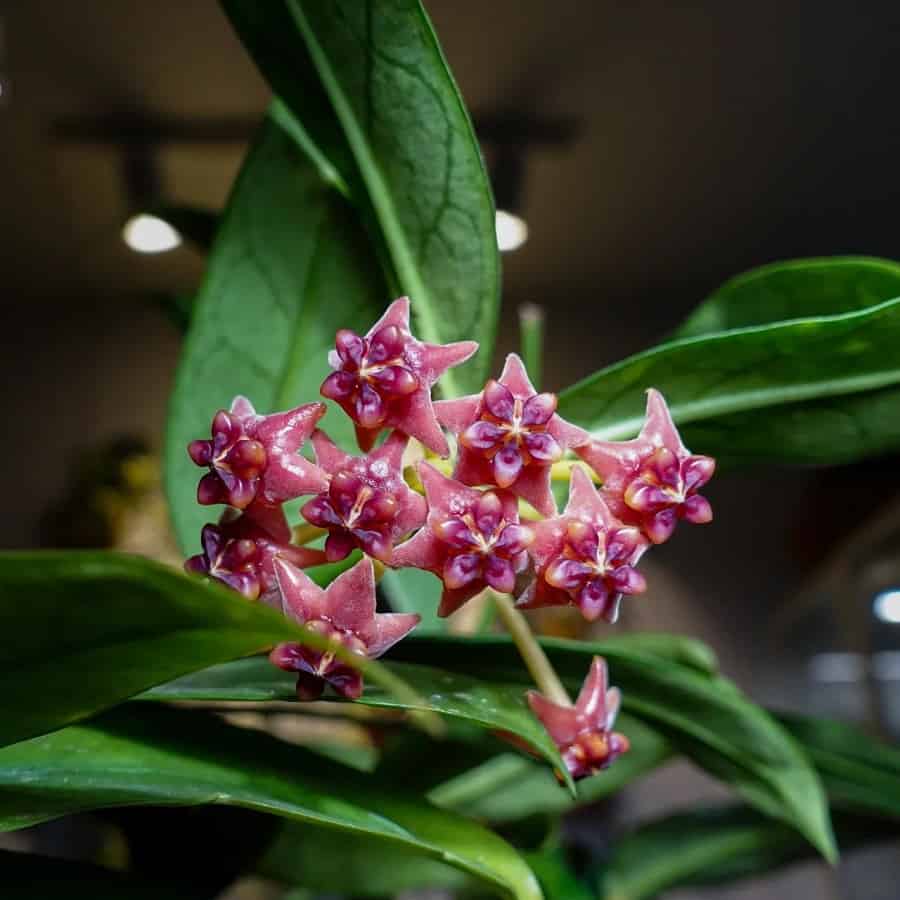
Hoya lobbii is a unique semi-shrub that pays tribute to the botanist who discovered it, Mr. Thomas Lobb. This plant boasts large, dark green leaves with light spots, reaching lengths of 8-11 cm and widths of 4 cm, and short petioles. In a single flower umbel, up to 20 stunning flowers can be found, with creamy to burgundy corolla blades and a glossy cherry-colored crown. Not only does it bloom regularly and generously, but it also has a weak, delicate fragrance.
Hoya loheri
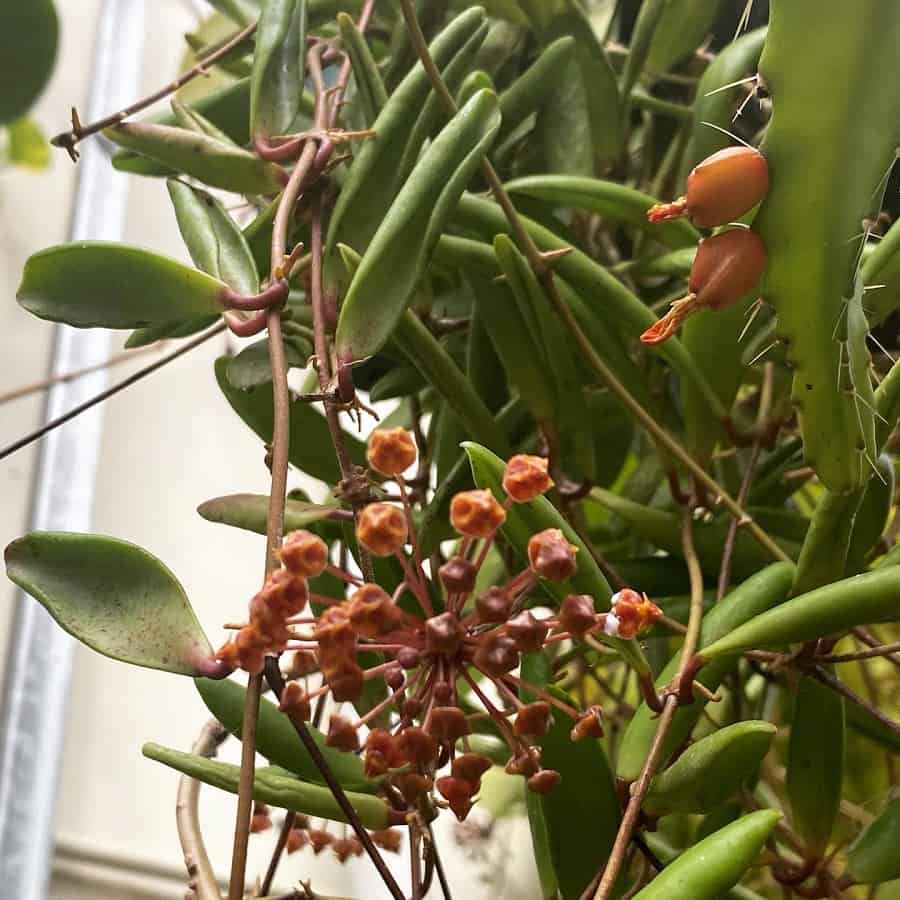
Hoya loheri is an epiphytic climbing plant, known for its highly branched and densely packed leaves that give it a compact appearance. With elongated and narrow leaves, it boasts an unusual brilliant rusty-orange color in its flowers, making it a unique addition to any plant collection. Hoya loheri requires high humidity and consistently moist soil to thrive, and is also easy to grow. With its loose flower umbels and distinct flower crown, Hoya loheri is a one-of-a-kind specimen that is sure to stand out in any garden.
Hoya longifolia

Hoya longifolia is a unique species of hoya, originating from the cool forests of China, India, Myanmar and Thailand. It is often confused with Hoya shepherdii, but is distinguishable by its oval-oblong leaves that are dark green, fleshy, and smooth with a slightly lighter underside. The scourges are reluctantly curly and can reach several meters in length. During the blooming season, it produces a few white, pubescent, and fragrant flowers with a diameter of 1.6-1.7 cm. This species of hoya thrives in cooler conditions and requires temperature fluctuations to bloom well, making it a special addition to any collection.
Hoya loyceandrewsiana
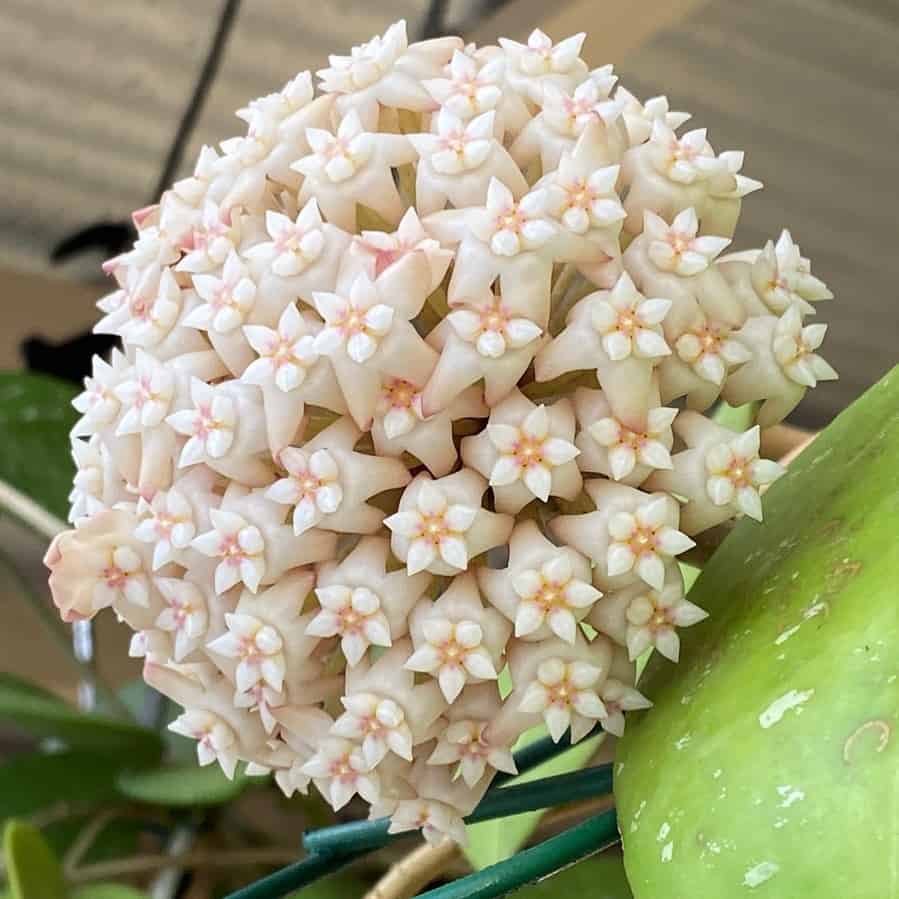
Hoya loyceandrewsiana is a beautiful, strongly stemmed plant that roots easily along its internodes. With flat, heart-shaped leaves that reach up to 20 cm wide and 25 cm long, this hoya is sure to make a statement in any collection. The pedicels are thick and form spherical inflorescences up to 15 cm in diameter, containing up to 100 hairless ivory flowers with a sweet, pleasant aroma. This hoya blooms for 2 to 4 days, adding a delightful touch to any indoor garden.
Hoya lucardenasiana
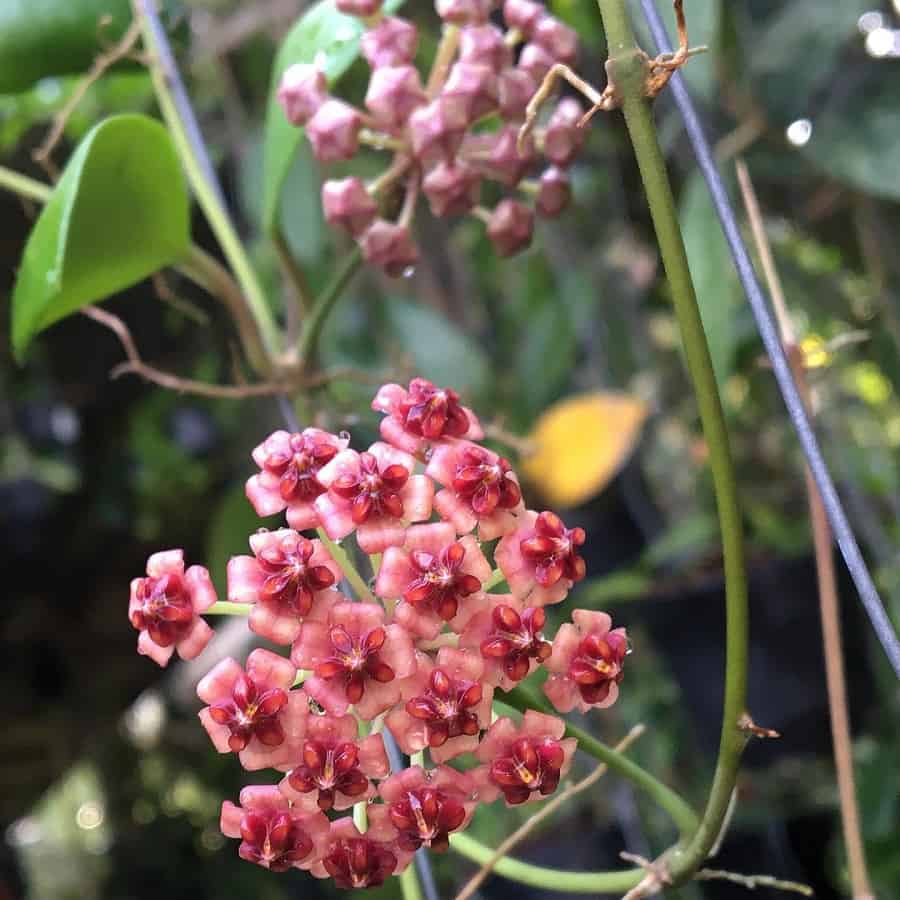
Hoya lucardenasiana is a captivating epiphytic plant with dense leaves and delicate, pink flowers. As it grows, it becomes a significant mass and requires strong support to sustain its beauty. With leaves measuring 4-6 cm in length and 3-4 cm in width, the plant features barely visible veins that smooth out with age.
During flowering, 15-20 beautiful flowers bloom, each with a diameter of 1 cm and dirty pink corolla lobes that are bent back. The crown of the flower is a light cherry color, adding to the plant’s charm. The flowering period lasts for about 4 days, making Hoya lucardenasiana a true delight for plant enthusiasts.
Hoya lucyae
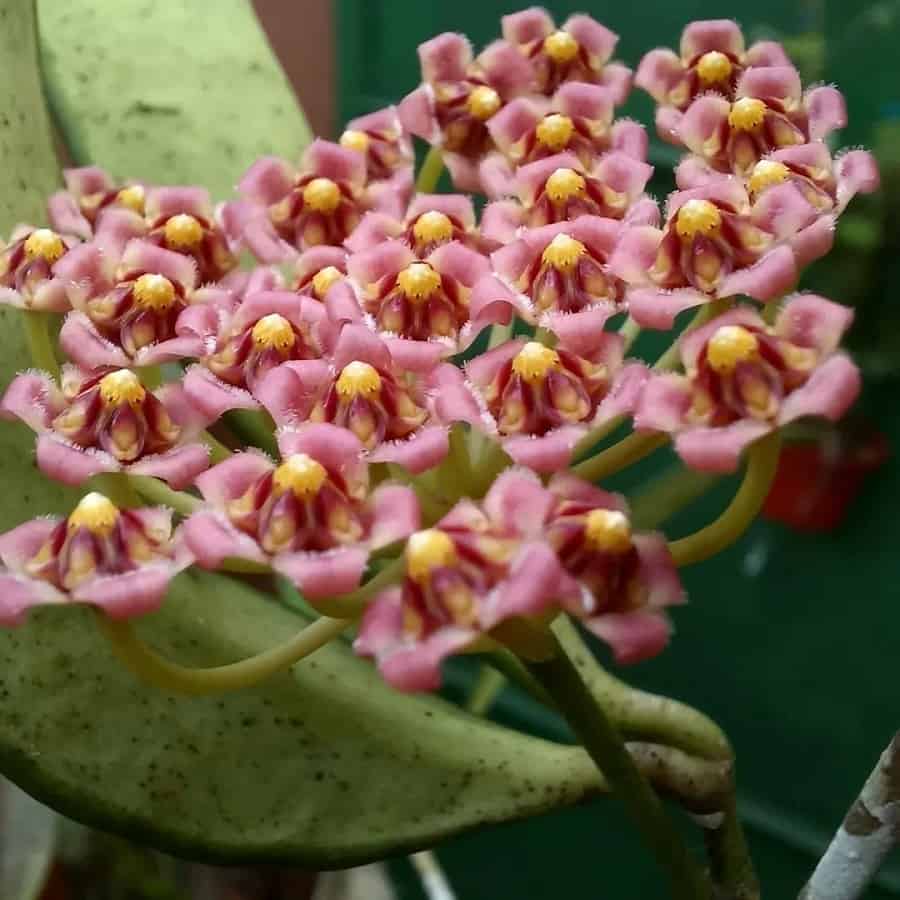
Hoya lyi

Hoya lyi is a unique and hardy plant species that thrives in shady, mossy areas on limestone cliffs. With its ability to climb and cling to rocks, Hoya lyi can survive in conditions where other species cannot. This plant’s leaves are fleshy and vary greatly in shape and size, while the flowers can range from white to light pink with a purple spot in the center of the crown. Although the exact relationship between Hoya lyi and Hoya thomsonii is yet to be fully understood, they share similarities in their growing habits and physical features.
Hoya macgillivrayi
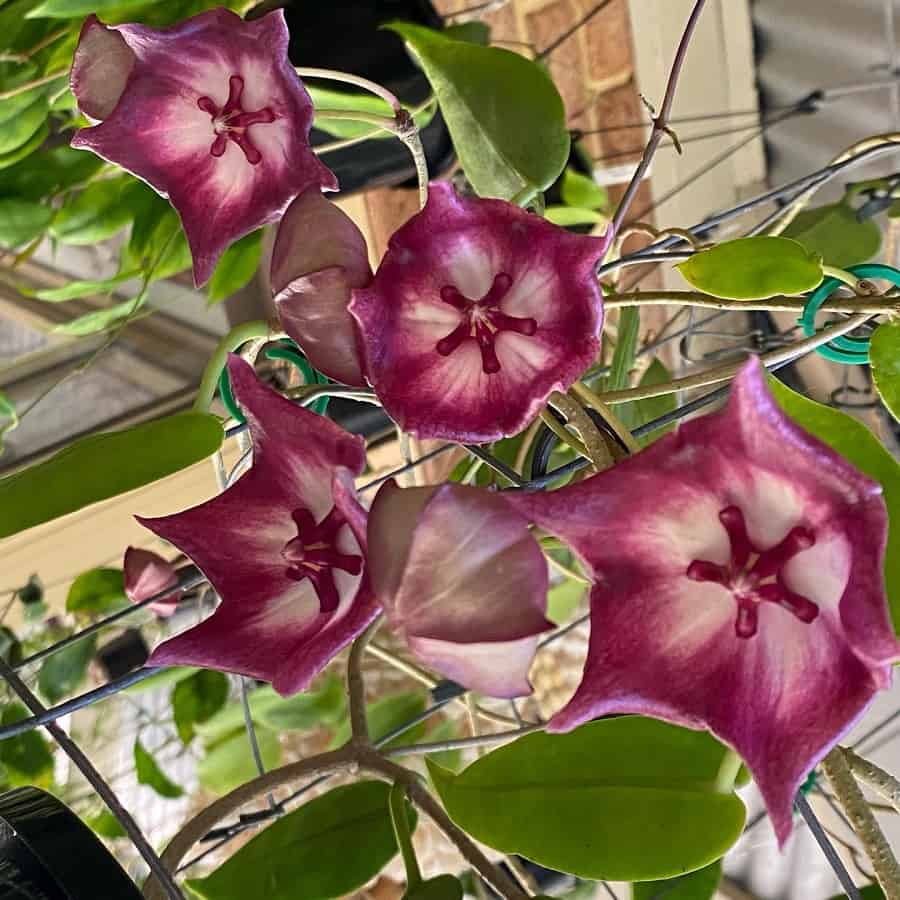
Hoya macgillivrayi is a breathtaking variety of Hoya native to Australia. This vigorous climbing plant is a stunner with its dark green, glossy, and fleshy leaves that are broadly oval in shape. The young leaves are a reddish color and the older ones are heart-shaped at the base and pointed at the tip.
With a height of up to 20 cm, it can reach the light and bloom with 4 to 12 individual bell-shaped flowers in shades of purple or red-brown, often with a white spot in the center, and a purple crown that is 1 cm in diameter. Its strong fragrance only adds to its beauty. However, it’s important to maintain good soil drainage, provide a dormant period in winter, and not overfeed the plant for optimal growth and flowering.
Hoya macrophylla

Hoya macrophylla is a unique and magnificent species of hoya native to Java, Borneo, and Indonesia. This climbing vine prefers limestone-rich soil and boasts large, dark green leaves that are smooth, shiny, and oblong-oval in shape, with sharp tips and prominent veins.
During the blooming season, Hoya macrophylla produces ball-shaped flower umbrellas, each containing creamy white corollas with a hint of reddish or purple and pale pink, concave crown lobes with sharp tips. The corolla blades are smooth on the outside, yet covered with dense papillary fluff inside, making the blooms of Hoya macrophylla truly a sight to behold.
Hoya macrophylla Variegata
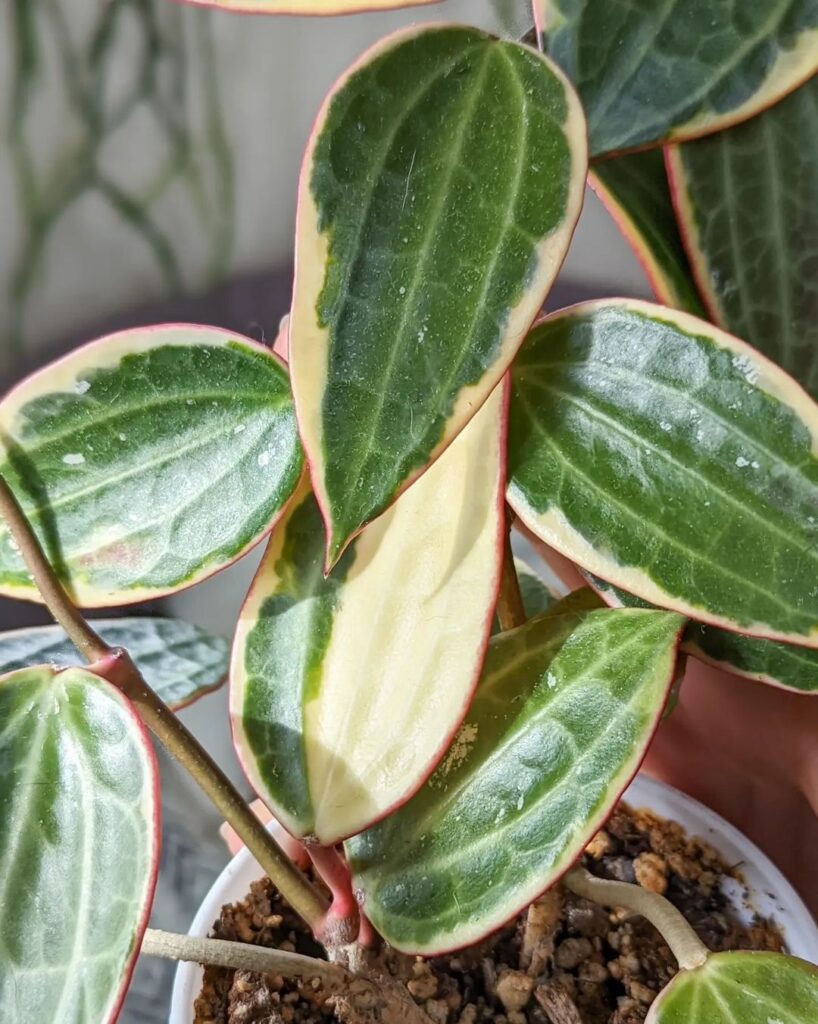
Hoya madulidii
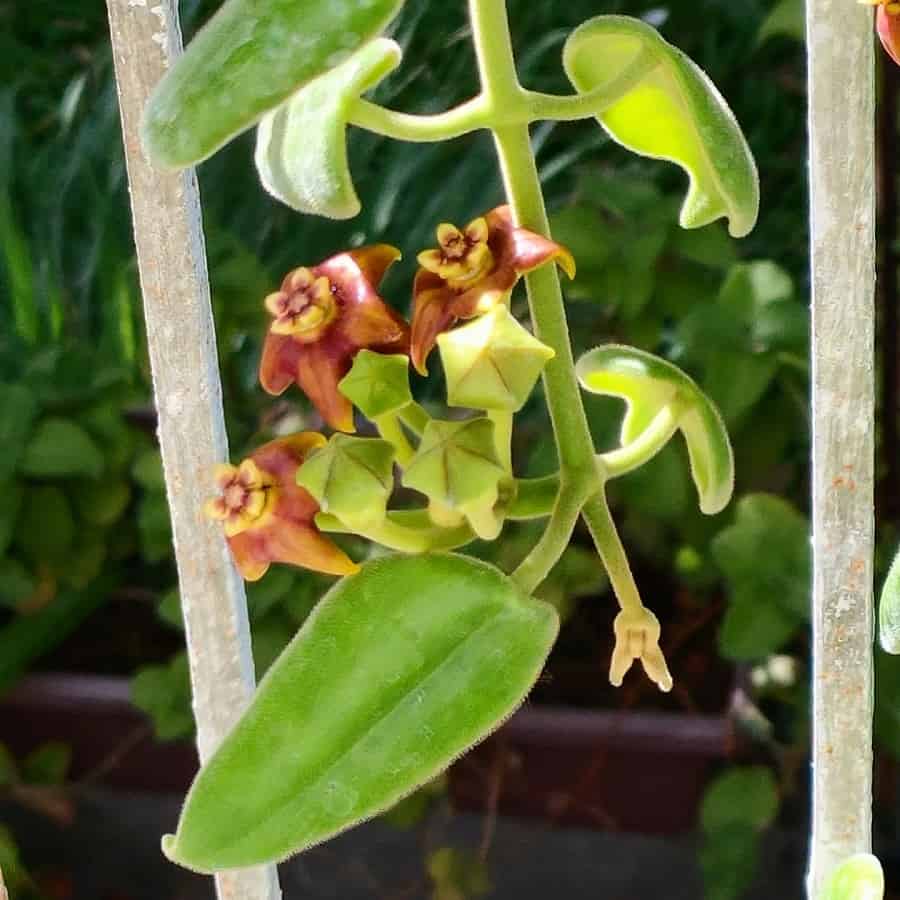
Hoya magnifica

Hoya magnifica is a stunning climbing vine native to the tropical regions. With its long, hairy vines reaching up to several meters and pubescent leaves, this plant is sure to capture the attention of any plant enthusiast. The leaves are dark green, fleshy, and oblong or oval with a prominent midrib, and the young leaves may turn reddish or brownish in full sun.
During late autumn, the plant produces a loose flower umbel with up to 25 fragrant, wide open bell-shaped corollas with a glossy white color and a small red spot under the crown. Hoya magnifica loves high humidity and some calcium in the soil and grows fast, making it a wonderful addition to any indoor or outdoor garden.
Hoya maingayi

Hoya maingayi is a unique epiphytic hoya with a smooth stem and large, smooth leaves that can reach 18-20 cm in length. The leaves have a distinct elliptical-lanceolate shape, with a pointed tip and a network of thick veins on the upper side, while the main vein is clearly visible on the underside. The plant’s floral corolla is covered in soft hair and is a pale pink color, with a white crown. With its smooth stem and eye-catching flowers, Hoya maingayi is a must-have for any hoya enthusiast.
Hoya manipurensis
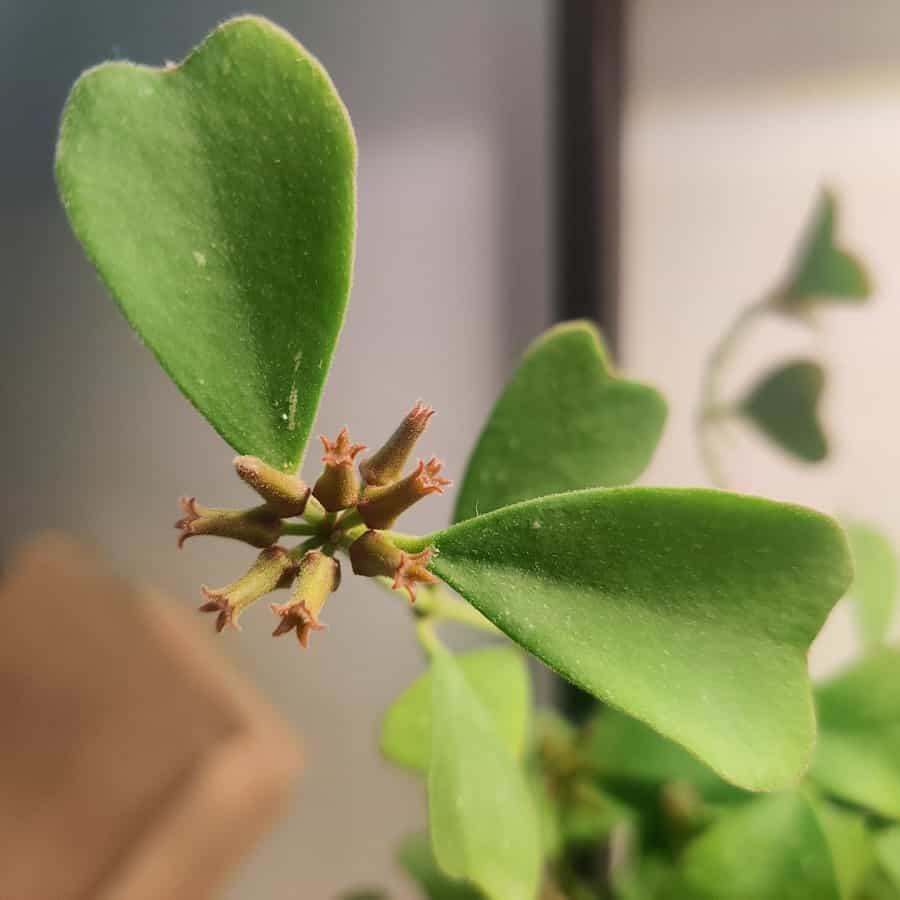
Hoya manipurensis is a unique and fascinating plant species with a semi-shrub lifestyle. Its branches grow upwards at first, but due to their weak structure, they eventually droop and take a horizontal position. Its leaves are green, with occasional silvery spots, and are shaped like a heart.
When the Hoya manipurensis blooms, it showcases its beauty with 4 to 9 delicate, tubular flowers that resemble tiny jugs. These flowers have a yellow, fleshy crown and a notched upper part. The stalks are short and almost invisible, adding to the mysterious allure of this amazing epiphyte.
Hoya marginata
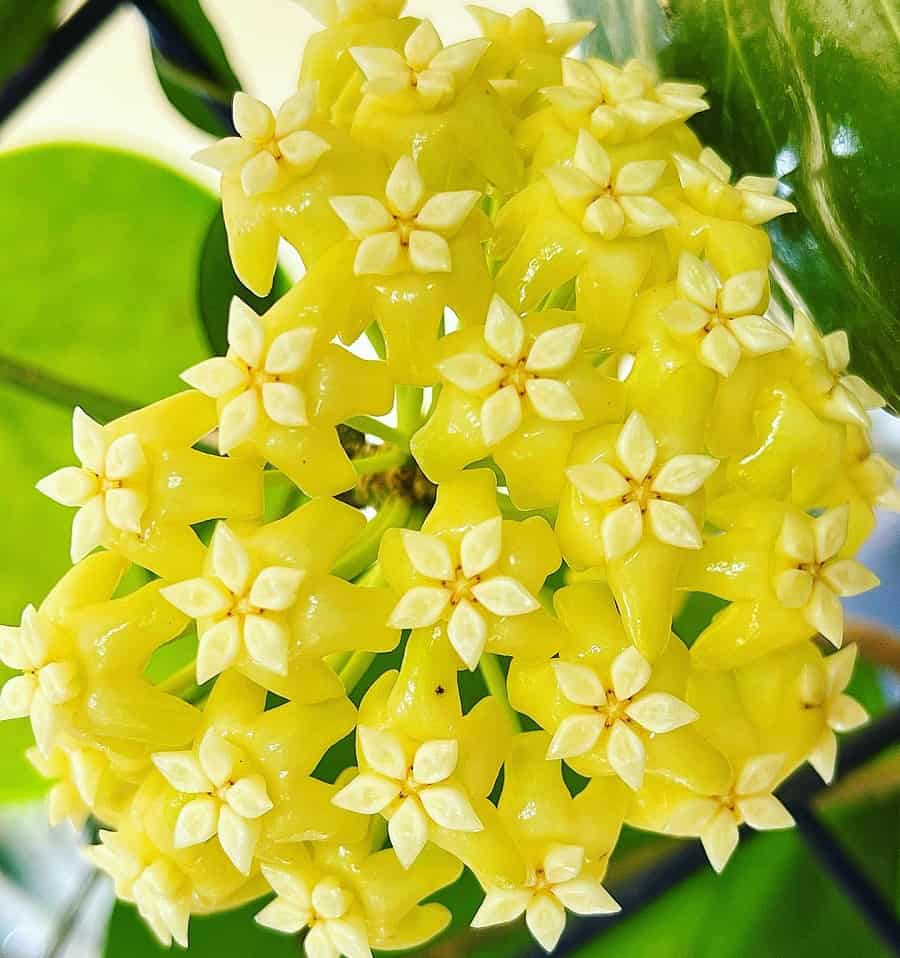
Hoya marginata is an eye-catching epiphyte with a strong stem and impressive leaves. The leaves are large and smooth with 7 prominent veins that extend from the base of the leaf. When exposed to sunlight, they turn a stunning red-brown color.
The plant is also known for its beautiful blooms, with up to 20 light yellow flowers opening in a single umbrella-shaped cluster. The crown of the flowers is a pale pink, and the edges of the corolla blades are covered in fine hairs. This easy-care hoya species grows quickly and blooms early, making it a great addition to any plant collection.
Hoya mariae
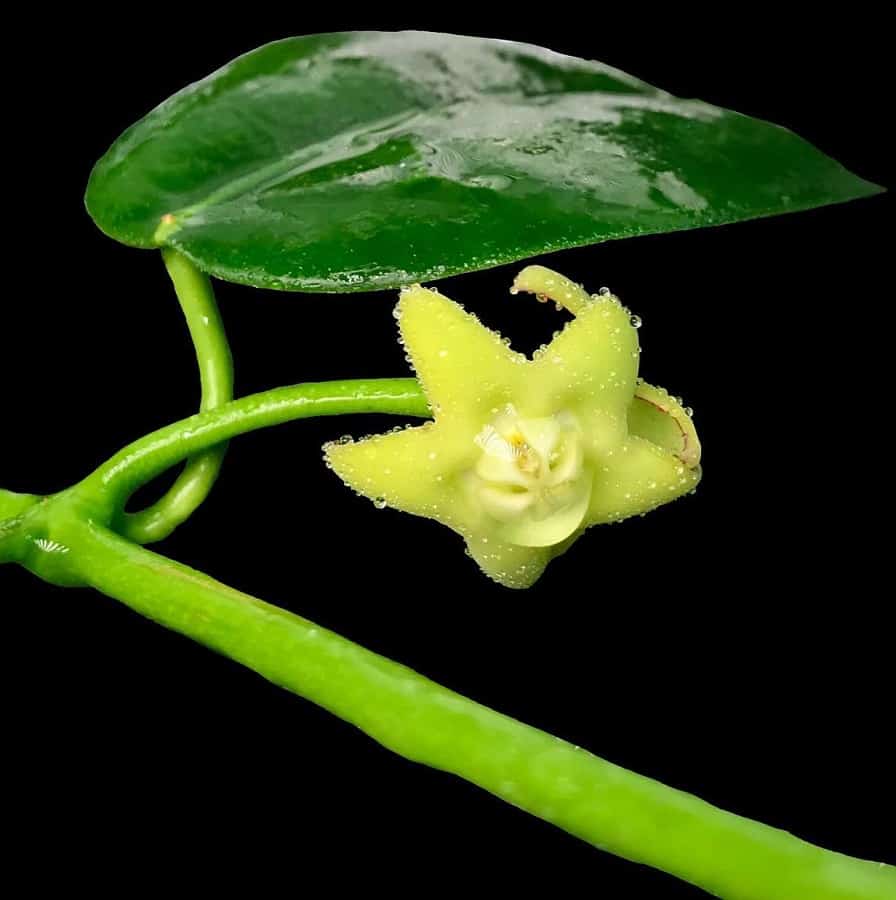
Hoya mariae is a unique and captivating epiphytic climbing liana that adds a touch of exoticism to any plant collection. Its branches are smooth and rarely leafy, making way for its prominent oval-shaped leaves with a fine leathery texture. These leaves are glabrous on both sides, pointed at the top, and rounded at the base.
During the flowering season, the plant showcases 1 to 3 separate wheel-shaped flowers, each with a yellowish-greenish corolla that is shortly pubescent on both sides. The corolla lobes are oval-triangular in shape, with a diameter of 1.5 to 2 cm. The flowering lasts for about 5 days, with a weak fragrance. This plant is sure to make a lasting impression!
Hoya mathilde
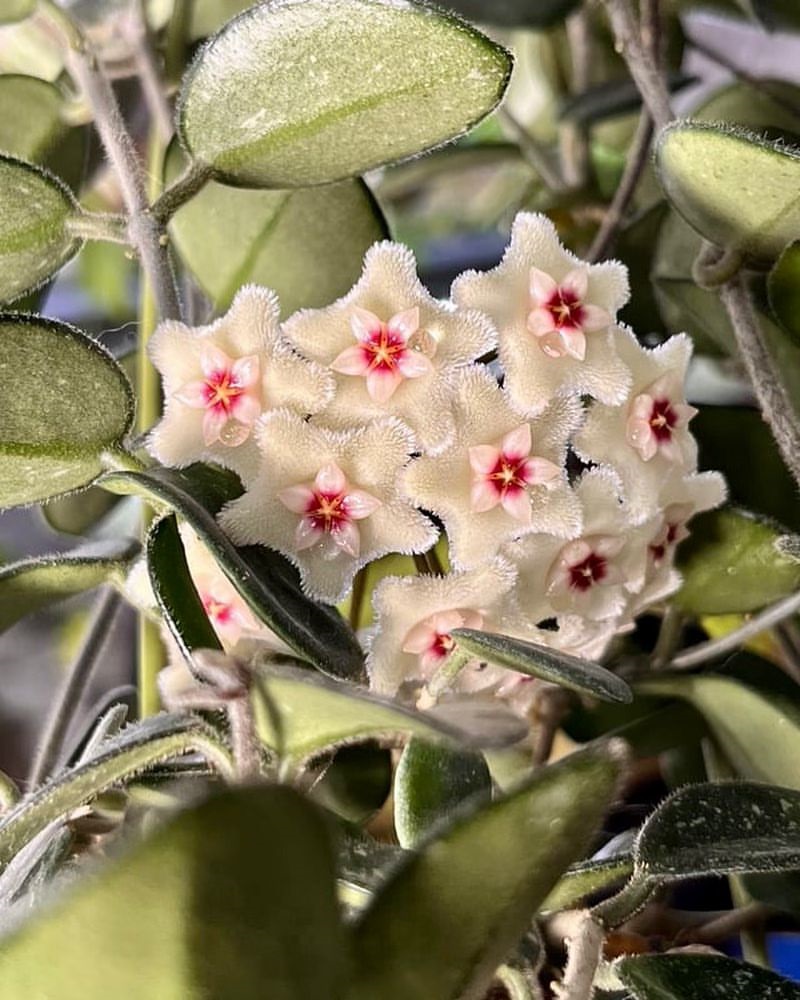
Hoya mathilde, a hybrid of Hoya carnosa and Hoya serpens, boasts small, dark green succulent leaves with silver flecks and a fuzzy underside. It produces star-shaped, creamy white flowers with a pink or purple center that bloom in clusters and emit a sweet fragrance. This plant can grow as a climber or trailer, and it can be trained to climb a trellis or moss pole.
Hoya mathilde Splash

Hoya mathilde “Splash” is a hybrid between Hoya carnosa and Hoya serpens. It features small, succulent, ovate leaves adorned with numerous silver spots, making it a visually striking plant.
Hoya mcgregorii
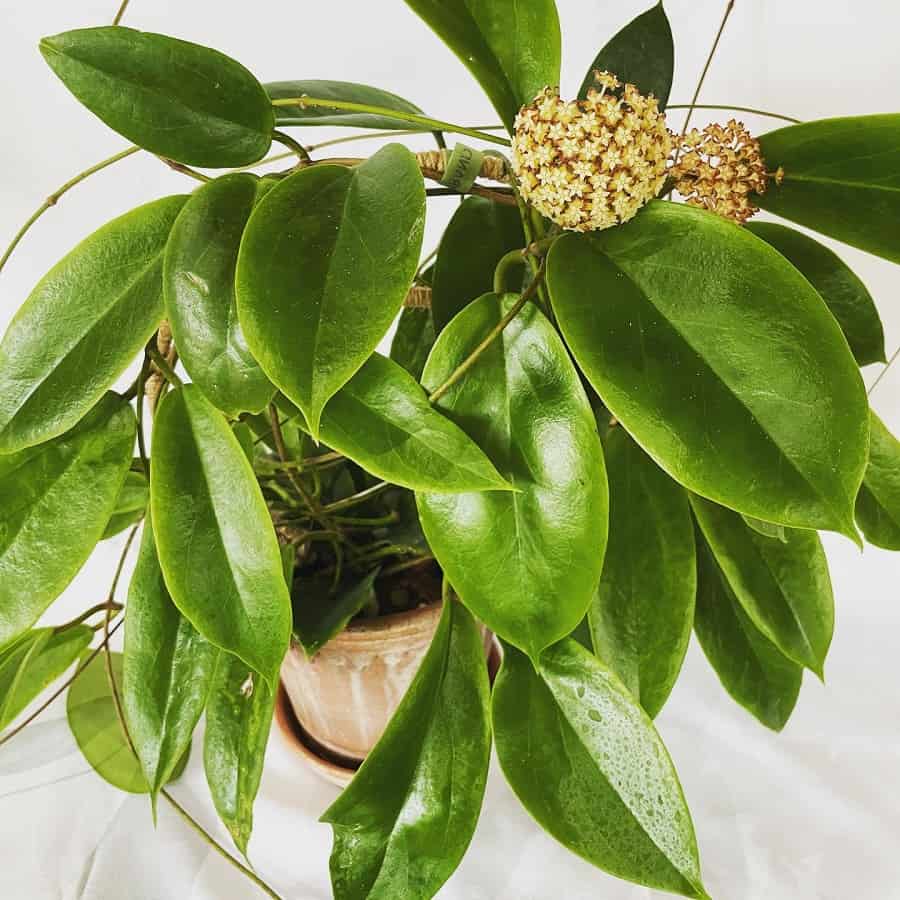
Hoya megalantha
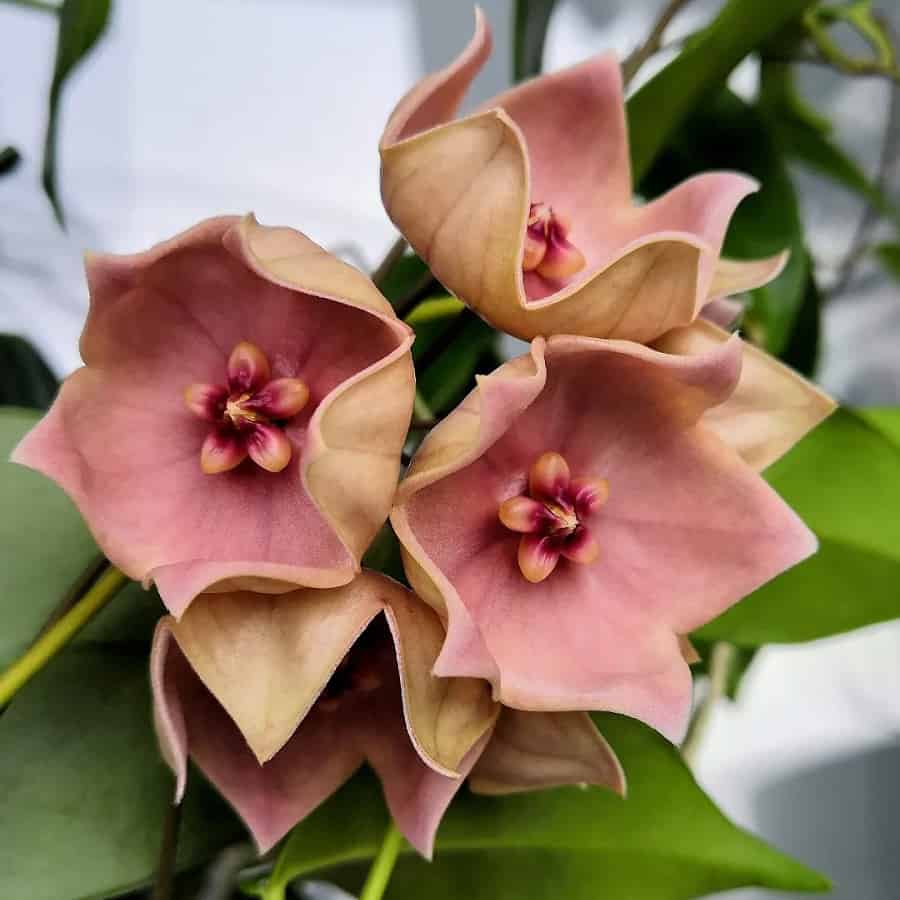
Hoya megalantha, hailing from the Fiji Islands, is a delicate and beautiful climbing vine. This plant boasts leaves that are 5-7 cm long and 2-3 cm wide. During the flowering season, it showcases 4-10 pale pink flowers that open in an umbrella-shaped cluster. The corolla of the flower is bell-shaped and has a diameter of 4-4.8 cm. The fragrance is reminiscent of sweet dough and the flowering period lasts 4-5 days.
However, cultivating Hoya megalantha is not for the faint of heart, as it is sensitive to drying, easily sheds leaves, and is difficult to root. The plant prefers cooler climates and does not respond well to long periods of high temperatures. Ideal growing conditions for Hoya megalantha include a pot with wick watering, very loose soil, and placement in a northern or northwestern window. Despite its demanding nature, Hoya megalantha is a truly unique and lovely addition to any plant collection.
Hoya megalaster
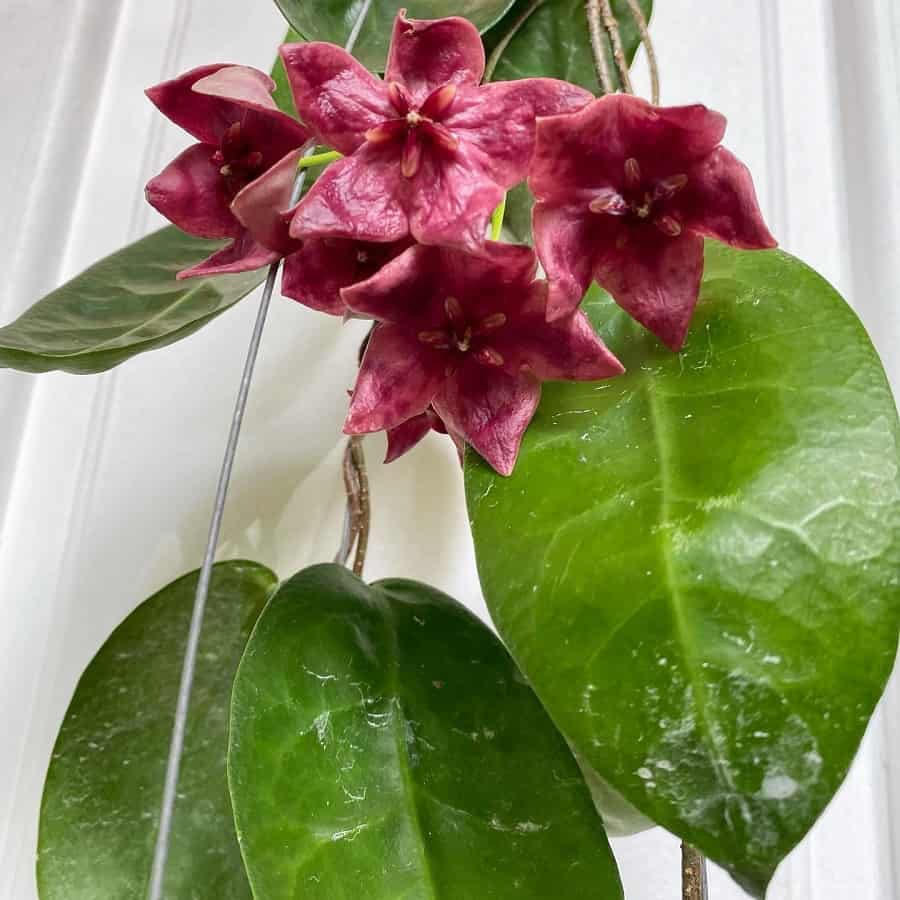
The Hoya megalaster is a captivating beauty that demands attention with its fast growth and curly vines. Its dark and smooth leaves, measuring 15-17 cm long and 10 cm wide, are adorned with unique dimples that make it stand out.
During the bloom time, this plant transforms into a fragrant paradise with 10-15 pale purplish-pink flowers, shaped like open bells, that emit a pleasant and slightly spicy aroma in the evenings. However, its delicate beauty requires a lot of light and heat to thrive, making it a challenge for those who want to experience its floral splendor.
Hoya meliflua

Hoya meliflua, native to the Philippines, is a fast-growing plant with dark green leaves that range in size from 5 to 30 cm in length and 3 to 8 cm in width. The leaves have a sharp or pointed apex and rounded or wedge-shaped base with curved edges. The inflorescences are spherical or convex, 4 to 6 cm in diameter and consist of 5 to 20 individual flowers with pubescent corolla lobes that turn back and vary in color from orange to light pink and purple.
The crown of the flowers is pale pink with a red-violet center and emits a sweet aroma. Hoya meliflua is an easy plant to grow, but its stems can become strong and difficult to bend, so it’s best to shape the plant before the vines mature. The plant blooms regularly, but not often, and flowering is stimulated by temperature fluctuations.
Hoya meredithii

Hoya meredithii is a unique and visually stunning plant that is native to Southeast Asia. It is known for its curly, thread-like vines and sparse aerial roots along the stems, making it a standout addition to any collection. This hoya is characterized by large, wavy-edged leaves with a spectacular network of secondary veins and a central vein, creating a striking contrast of dark green against a lighter leaf plate. The new stems and pedicels often have a bronze tint, adding to its beauty.
During flowering, Hoya meredithii produces up to 35 pale, light cream-colored flowers with white crowns, exuding a pleasant aroma and sweet nectar. While it’s a fast grower, it’s important to keep it well-moisturized during dry spells for optimal health and growth.
Hoya merrillii
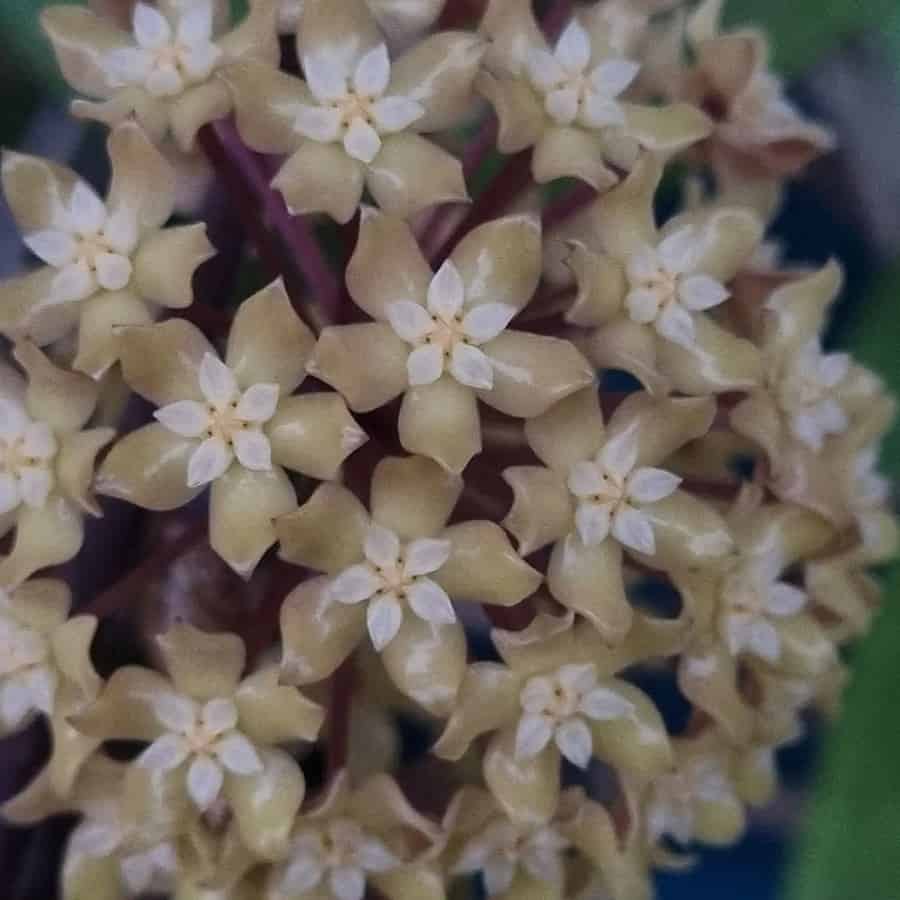
Hoya merrillii is a beautiful, low-maintenance plant that adds a touch of tropical glamour to any room. Its glossy, light green leaves are slightly fleshy, with a “webbed” pattern of visible veins, creating a unique and striking appearance. The curly vines are smooth and grow aerial roots, which give the plant a touch of whimsy.
When in bloom, this epiphyte produces an impressive umbel of 20-30 yellow, fragrant flowers with tips turned back, adding a pop of color and sweet scent to the room. Whether you’re a seasoned gardener or just starting out, Hoya merrillii is an easy-to-grow, beautiful plant that will make a lovely addition to any home.
Hoya micrantha
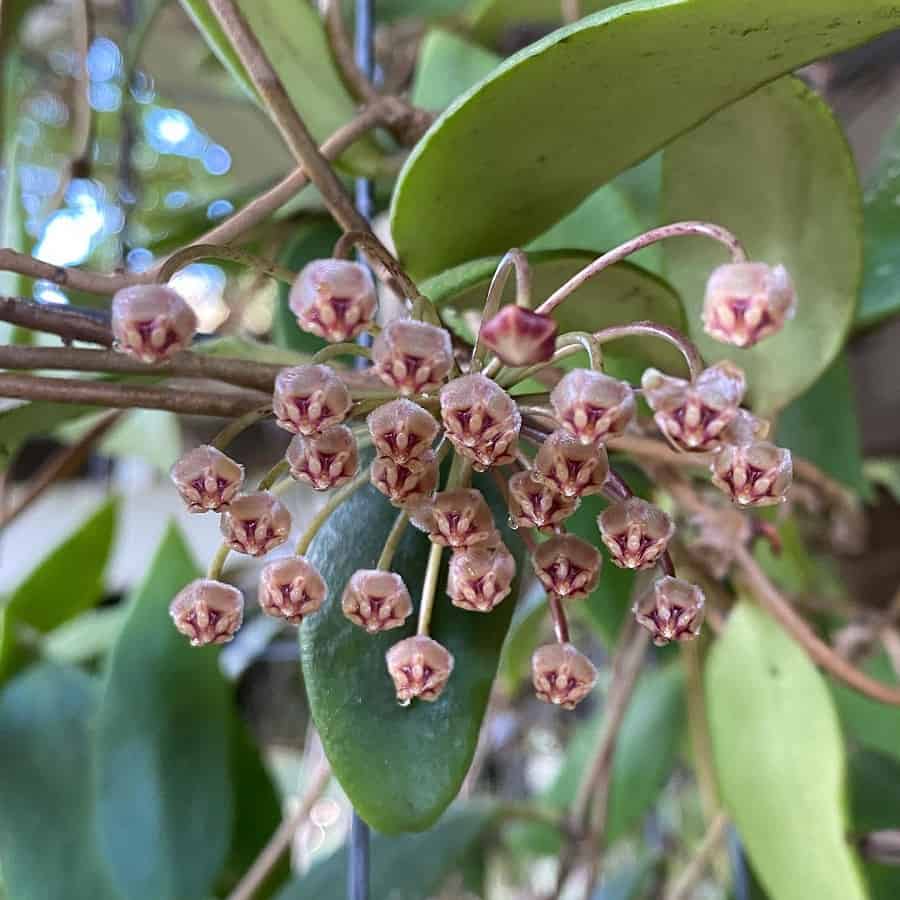
Hoya micrantha is a unique and hardy species of hoya that boasts thick and fleshy leaves with a striking contrast between the rich dark green on the upper side and the lighter green dotted underside. The vines are stiff and dark, making the plant even more visually striking.
Despite its vigorous growth, it remains compact and branches easily, making it easy to maintain. Hoya micrantha is also a low-maintenance plant, as it is almost not affected by pests. It blooms easily, with loose, flat umbels of tiny flowers resembling those of Hoya lacunosa or Hoya obscura. A must-have for any hoya enthusiast!
Hoya microphylla
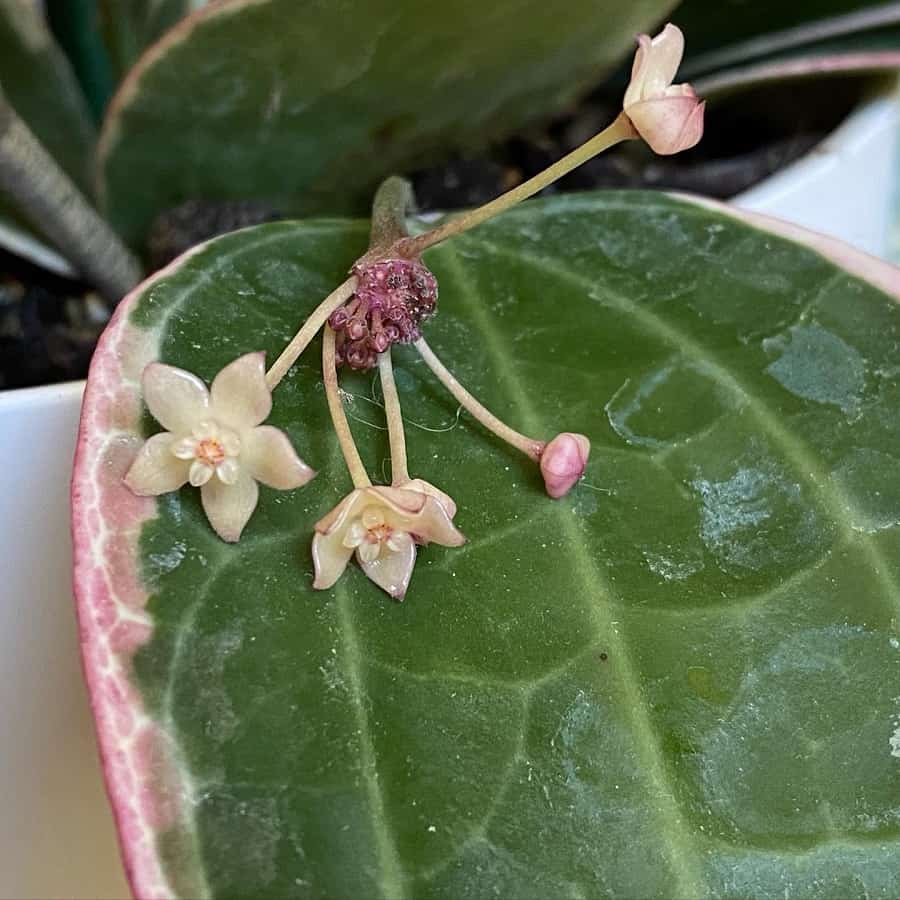
Hoya microphylla is a tiny but tough epiphyte with delicate vines that sway in the breeze. Its small, leathery leaves are a unique feature, and its flowers are a stunning sight, with 6 white bells sporting purple crowns, making it a truly unique addition to any collection. But beware, this Hoya is not for the faint of heart, as it is difficult to grow and requires precise conditions to thrive. High humidity and the right temperature are key, but with the right care, this Hoya will reward you with its beauty.
Hoya microstemma

Hoya microstemma is a dainty and versatile epiphyte that adds a touch of elegance to any collection. With its small, smooth elliptical leaves and petite peduncle, it makes a perfect climbing vine. The real showstopper, however, is its star-shaped flowers, pubescent and white with a gentle transition to pale pink, topped off with a bright pink crown. With 8-15 flowers per umbrella, Hoya microstemma is sure to catch the eye and add a touch of magic to your collection.
Hoya minahassae
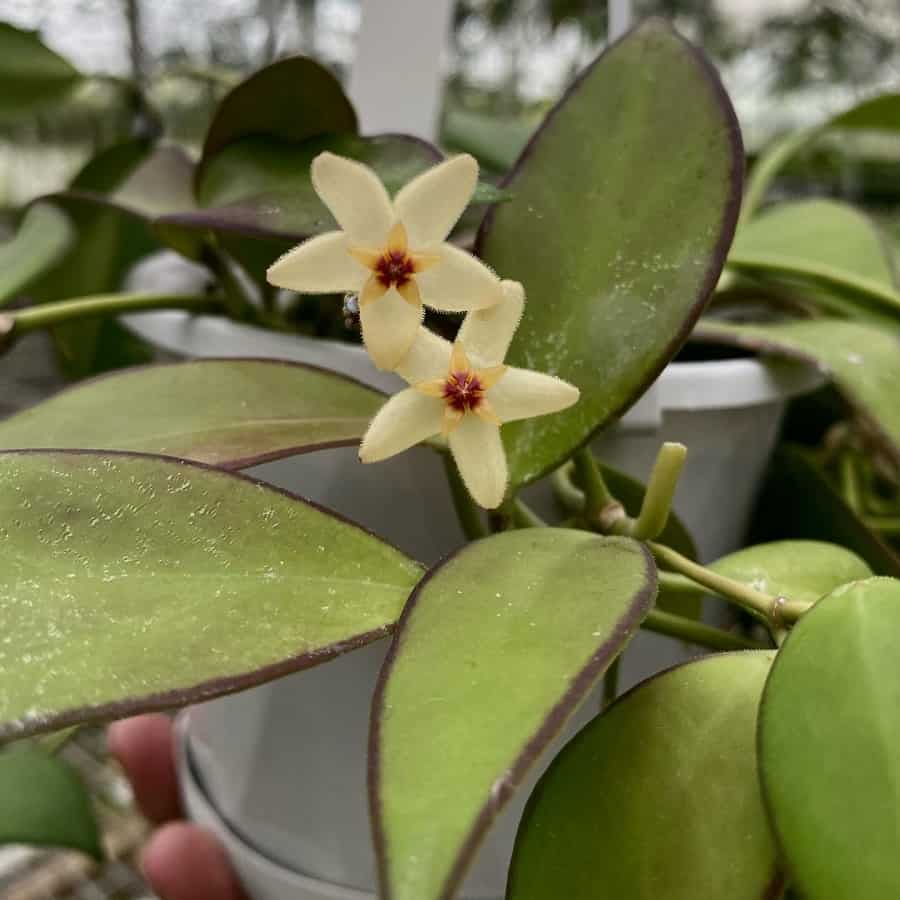
Hoya minahassae is a stunning epiphytic liana with lush, fleshy vines that frame its delicate leaves. With its oval or lanceolate-oval leaves, both sides smooth and without visible veins, it is a true beauty. The real treat, however, is its flat flowers, 1.3 cm in diameter and opening in a positively geotropic concave flower umbel. The white corolla lobes are smooth on the outside and pubescent on the inside, with a pale yellow crown. Although it doesn’t release nectar, Hoya minahassae’s flowers last up to 10 days, making it a true delight to behold.
Hoya mindorensis
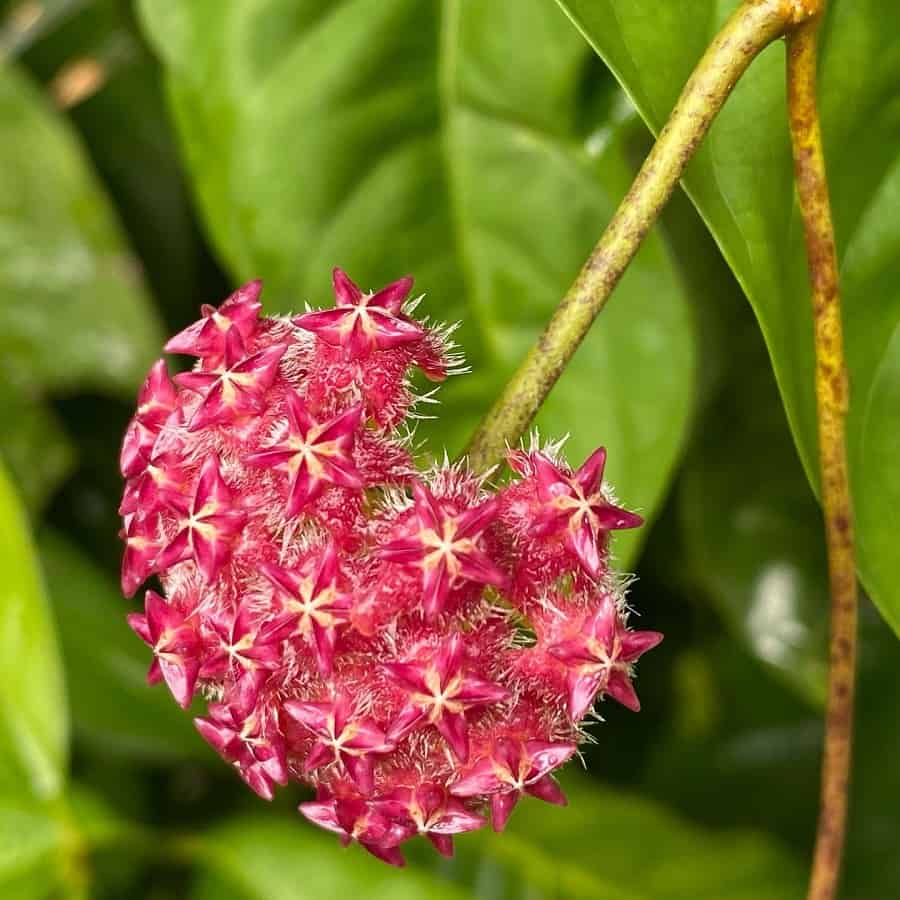
Hoya mindorensis is an epiphytic hoya that stands out with its smooth, curly vines and vibrant leaves. This fast-growing plant loves the sun and will quickly fill any empty space with its lush foliage, featuring elliptical leaves with reddish spots that show when grown in sunny spots. But the real showstopper of Hoya mindorensis is its 40-50 individual flowers, with a diameter of 1.5 cm, that open in a spherical flower umbrella.
With long, translucent hairs and petals that bend back to form a “tousled” look, the sharp blades of the crown create a spectacular star. With a wide range of colors, from red to yellowish-cream, pinkish-orange, and burgundy, Hoya mindorensis is a delight to behold and will provide a week of enjoyment with its sweet nectar.
Hoya minutiflora
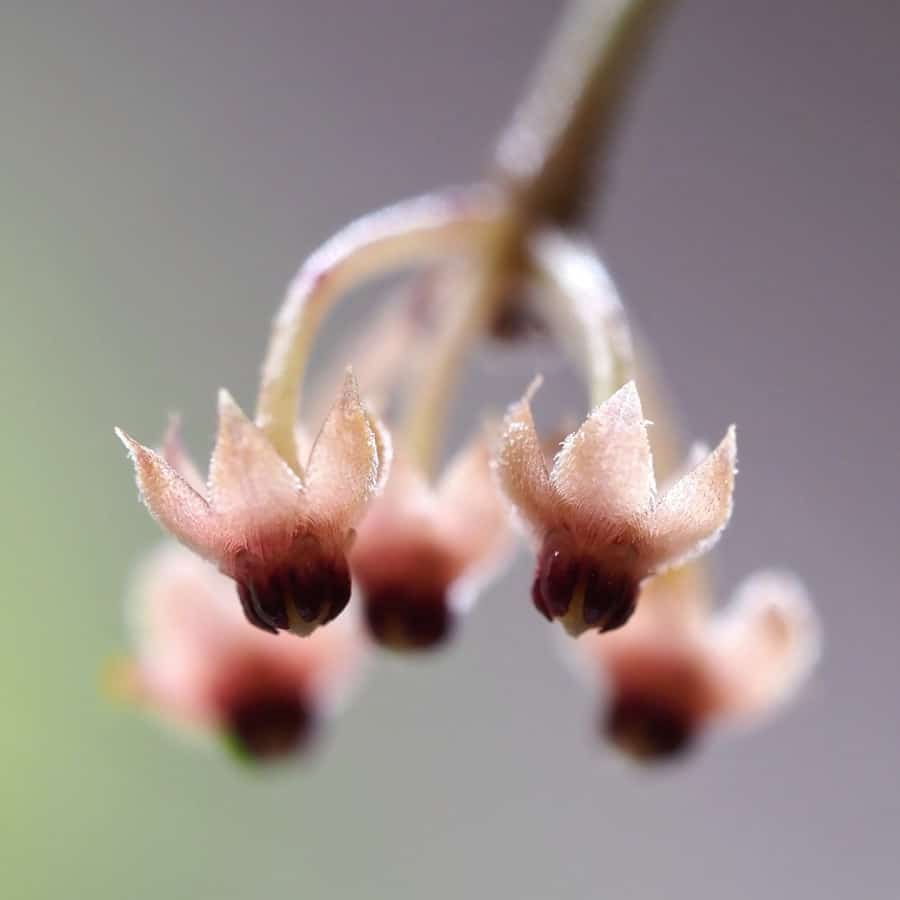
Hoya minutiflora is a miniature gem among Hoyas, a tiny, climbing epiphyte that’s sure to capture your heart. With round-oval leaves that are light green, slightly pubescent, and fleshy, it provides a perfect backdrop for its showy flowers. The positively geotropic inflorescence forms a slightly convex floral umbel with 5-10 flowers on a sparsely hairy stalk, with corolla lobes that bend back and showcase their pinkish-orange pubescence.
The crown is a true masterpiece, with its bright purple center surrounded by bright yellow and topped with two-bladed outer lobes. Hoya minutiflora is a tiny hoya that packs a big punch and is sure to delight anyone who sees it.
Hoya mitrata

Hoya mitrata is an intriguing plant that got its name from its unique flower shape resembling a bishop’s headdress (miter). This terrestrial or epiphytic hoya has curly stems up to 2-4 m long and thin, leathery leaves with silver specks and visible veins. It also has two different forms of leaves: wide and inverted boat-shaped or large and concave, growing in groups along the stem and hosting black ant domatia, which increase the plant’s moisture and nutrient supply.
The negatively geotropic inflorescence opens with 10-20 ivory or slightly pinkish corolla lobes and a white crown with a red spot in the center. It has a weak, sweet aroma and is sensitive to waterlogging, so it is important to use well-drained soil. However, it is often affected by thrips in cultivation.
Hoya monetteae
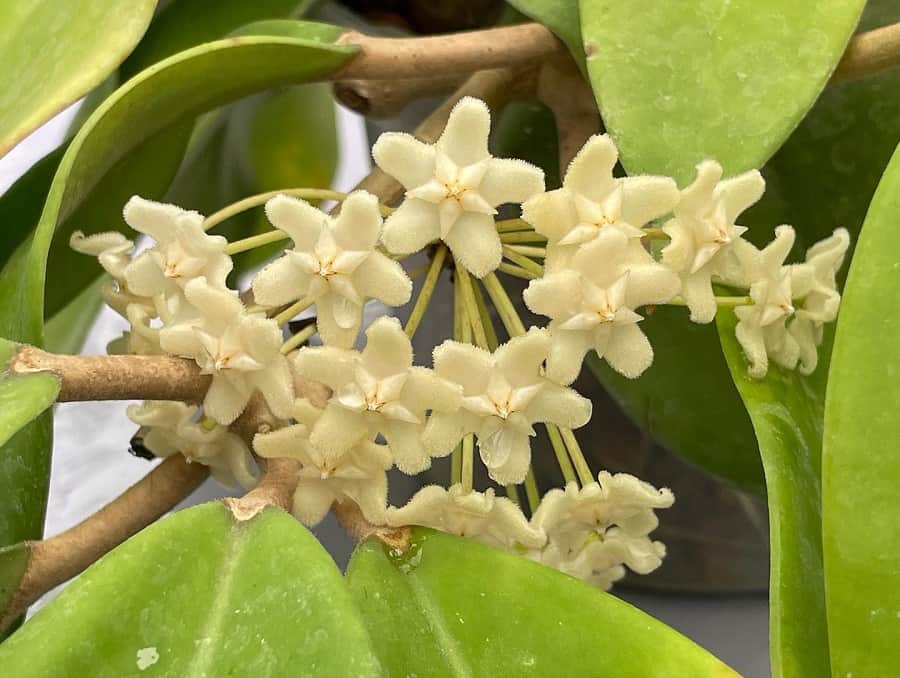
Hoya monetteae is a captivating epiphytic hoya that originates from the Philippines, Sulawesi, and Borneo (Sabah). Its leaves are large and smooth, with a sharp tip and slightly tucked-up edges, and the plant’s growth is similar to Hoya diversifolia but with longer stems (up to 5 m long).
This hoya produces a sweet, strong fragrance during flowering, and its clear sap sets it apart from most Hoyas with milky sap. During the blooming season, 15-35 flat, white flowers similar in shape and size to Hoya carnosa flowers open in a hemispherical umbrella 7-10 cm in diameter, showcasing the plant’s unique beauty and charm.
Hoya montana
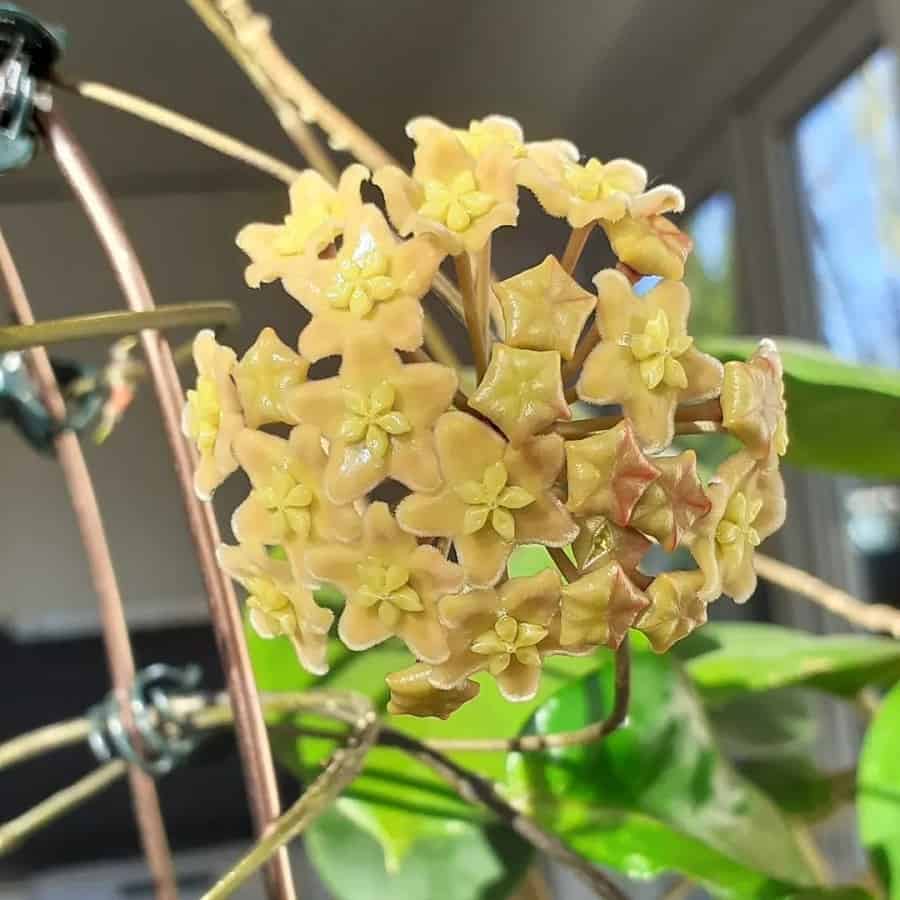
Hoya montana is a tropical beauty from the lush forests of northeastern New Guinea. This epiphytic plant is known for its fast-growing, thin, and hard stems that can gracefully cover neighboring plants. With large, dark green, glossy leaves that are elliptical in shape and slightly wavy along the edges, it’s a lush and slightly branching specimen. During the blooming season, the plant opens loose flower umbels with 8 to 15 golden yellow flowers, about 1.3 cm in diameter, making it a sight to behold. The flowers are similar to those of other Hoya species and emit a weak but sweet fragrance.
Hoya motoskei
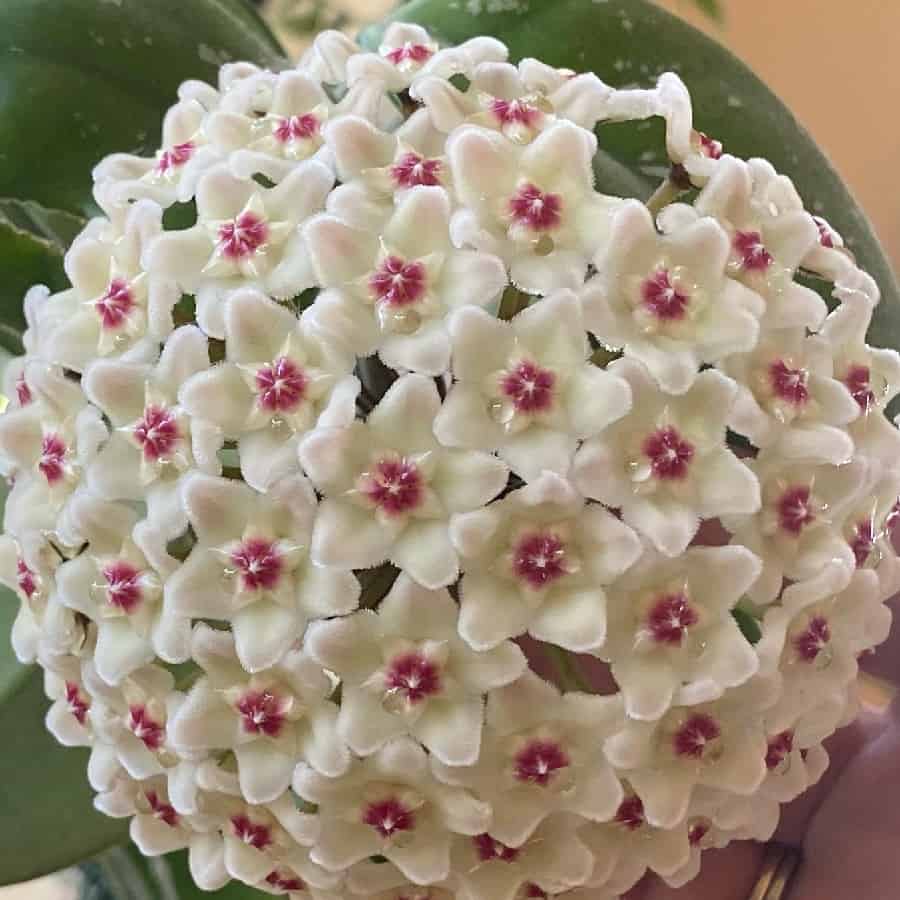
Hoya motoskei is a plant species that has a debated status as a separate species or a synonym of Hoya carnosa. It originates from Southern Japan and Thailand and is known for its uncertain taxonomy.
Hoya multiflora
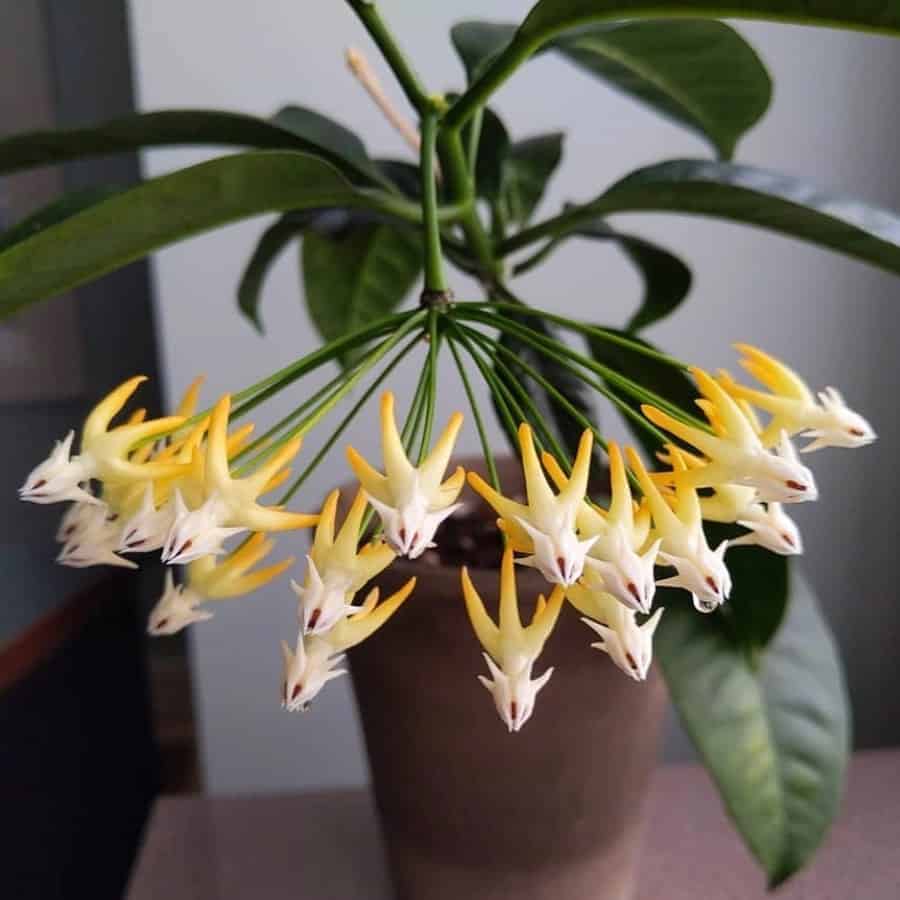
Hoya multiflora is a versatile species of Hoya that is native to India and New Guinea and grows at varying altitudes between 200 and 1200 meters above sea level. This species is known for its impressive display of flowers, with 20-50 individual blooms in a single umbel, each with a diameter of 1.6 to 2.6 cm. The corolla is yellow-white and the blades are bent back like a flying rocket, with a white crown.
The leaves are dark green, leathery, and oblong with visible veins and occasional silvery spots. This species is not only an economically important ornamental plant but is also considered a medicinal plant, known to be traditionally used in treating rheumatoid arthritis and other stomach/intestinal diseases. Despite its morphological diversity, Hoya multiflora remains a popular species for its striking beauty and versatility.
Hoya myrmecopa
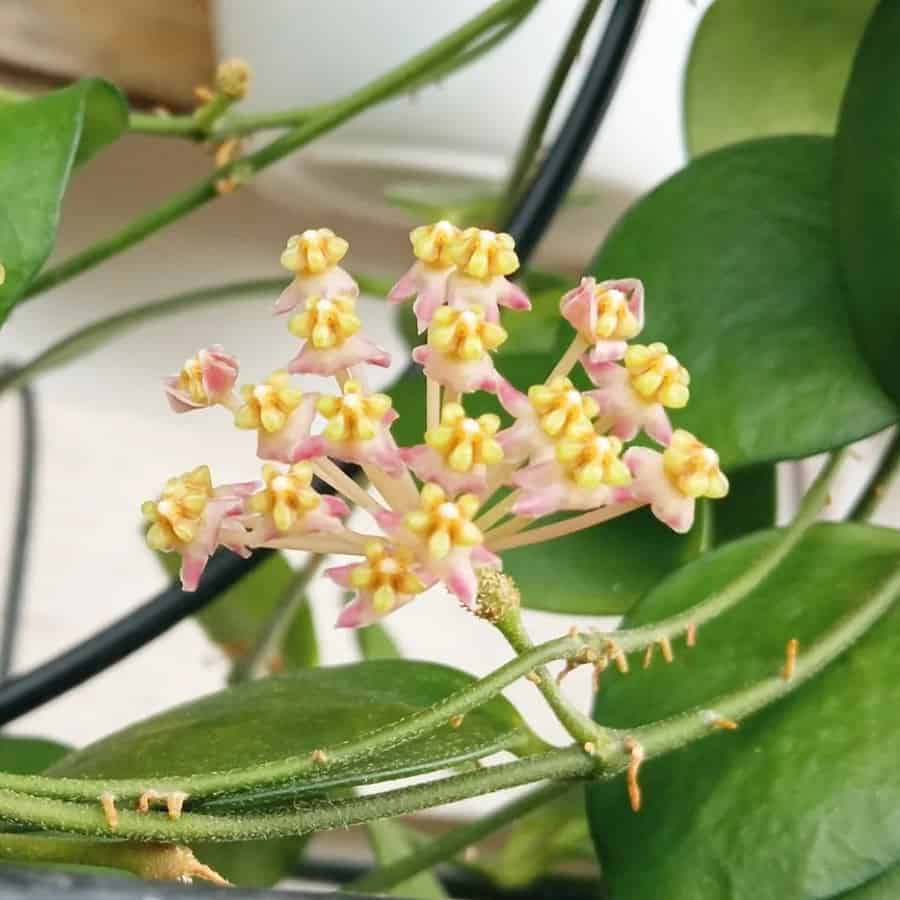
Hoya myrmecopa is a rare and unique species, originating from Sulawesi, Indonesia. This medium-sized plant is characterized by its hard and thick leaves, measuring 8 x 4.5 cm and has a green color with no visible veins. The delicate flowers have pale yellow corollas, with milky yellow crowns that have a distinctive brick-orange spot in the center.
Up to 20 flowers can bloom at once, and the aroma is weak. Hoya myrmecopa is easy to care for, preferring small pots and shade from direct sunlight, and blooms frequently throughout the year. It is a must-have for any hoya collector, especially since it has recently been described under the names Hoya sp. IPPS 8840 and IPPS 8841.
Hoya nabawanensis

Hoya nabawanensis is a stunning and unique epiphytic plant from Southeast Asia with smooth and thin stems reaching up to 2 meters long. The leaves are fleshy, dark green with pinnate venation, and the flowers are small with creamy white corolla and creamy yellow crowns. This hoya is known for its abundant flowering with 20-30 individual flowers in each umbrella, making it a magnificent sight to behold.
Hoya naumannii
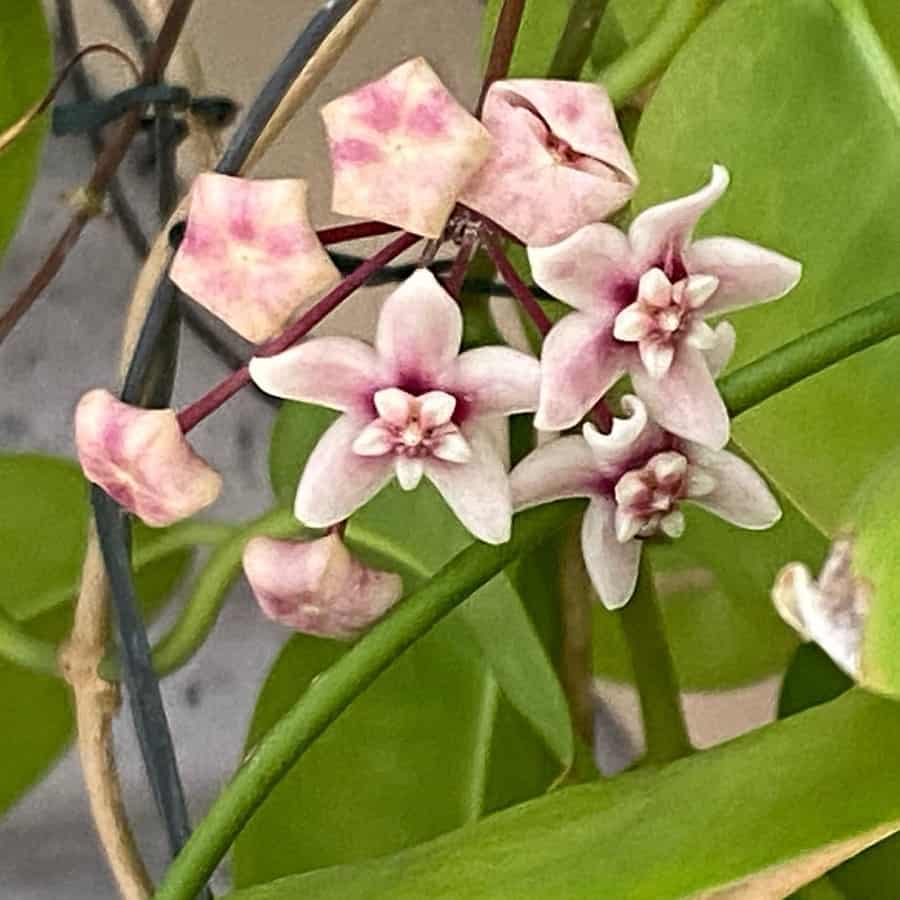
Hoya naumannii is a fast-growing species that belongs to the Hoya albiflora complex. With its light green, smooth, and shiny leaves that can grow up to 12 cm long and 7 cm wide, Hoya naumannii adds a touch of lush greenery to any room. However, it requires support from the very beginning and high temperatures, as well as plenty of sun to flower.
When it does bloom, you’ll be treated to 10-20 star-shaped, pinkish-white flowers with a pink spot and a sweet, spicy aroma. These flowers produce a lot of nectar, so it’s a good thing they don’t drip. Flowers last a little over a week and make for an eye-catching display.
Hoya neocaledonica

Hoya neoebudica
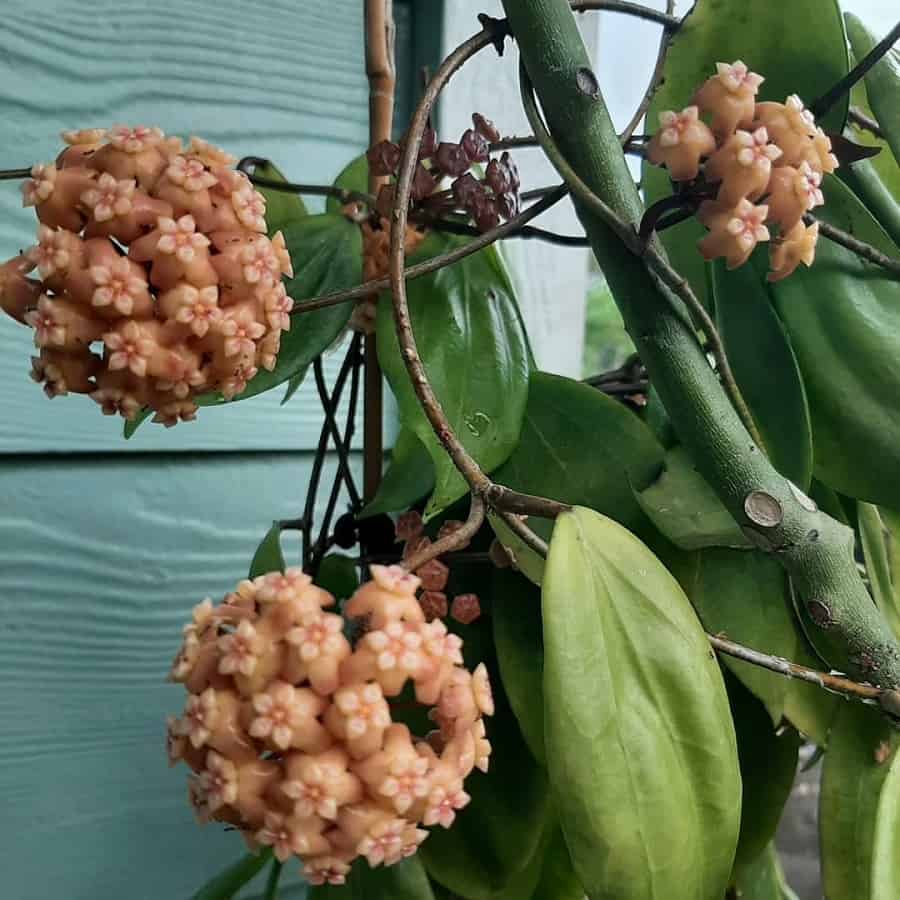
Hoya neoebudica is a unique and fascinating plant that hails from the lush forests of Vanuatu. This tropical beauty was first discovered by French botanist Guillaumin in 1937 and its delicate stems, tender leaves, and vibrant blooms have captivated plant enthusiasts ever since.
With its light green leaves that are accented by noticeable veins and clusters of pale pink, glossy corolla lobes, Hoya neoebudica adds a touch of elegance to any indoor garden. It prefers a warm, humid environment and thrives in the summer, but be careful not to place it in direct sunlight, as this can slow its growth. There is speculation that it may be a clone of other Hoya species found nearby in Samoa, carried to Vanuatu by the wind. Regardless of its origin, Hoya neoebudica is a true delight for the senses.
Hoya nervosa
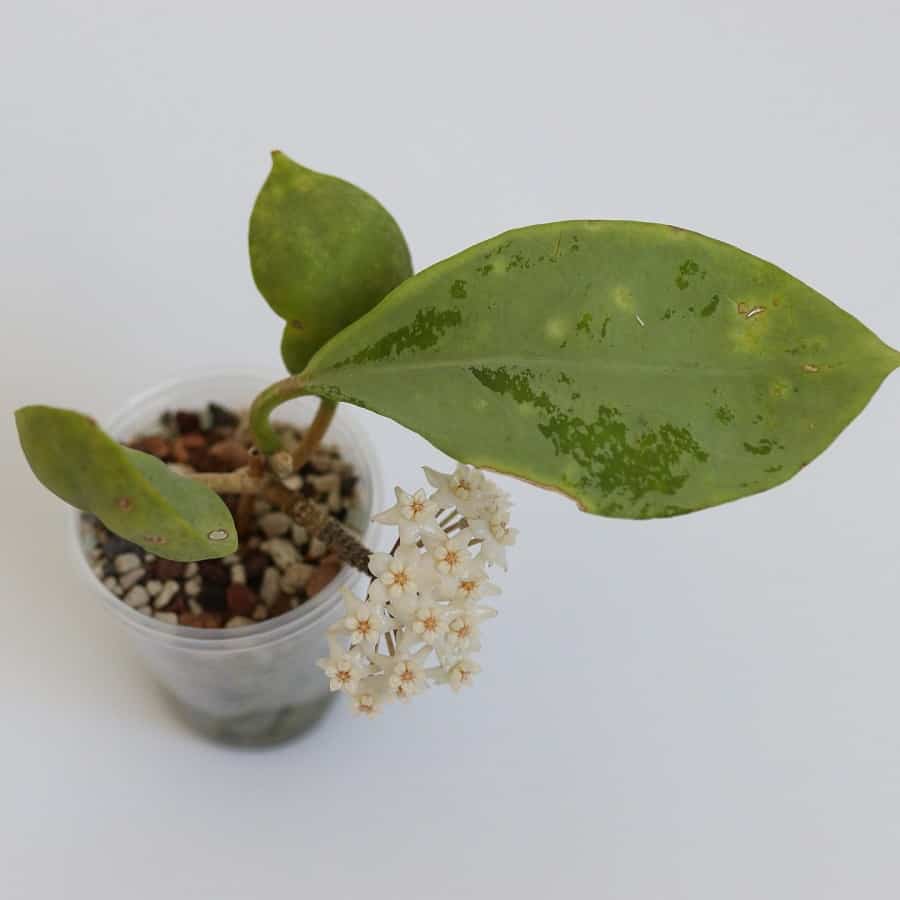
Hoya nicholsoniae New Guinea Ghost
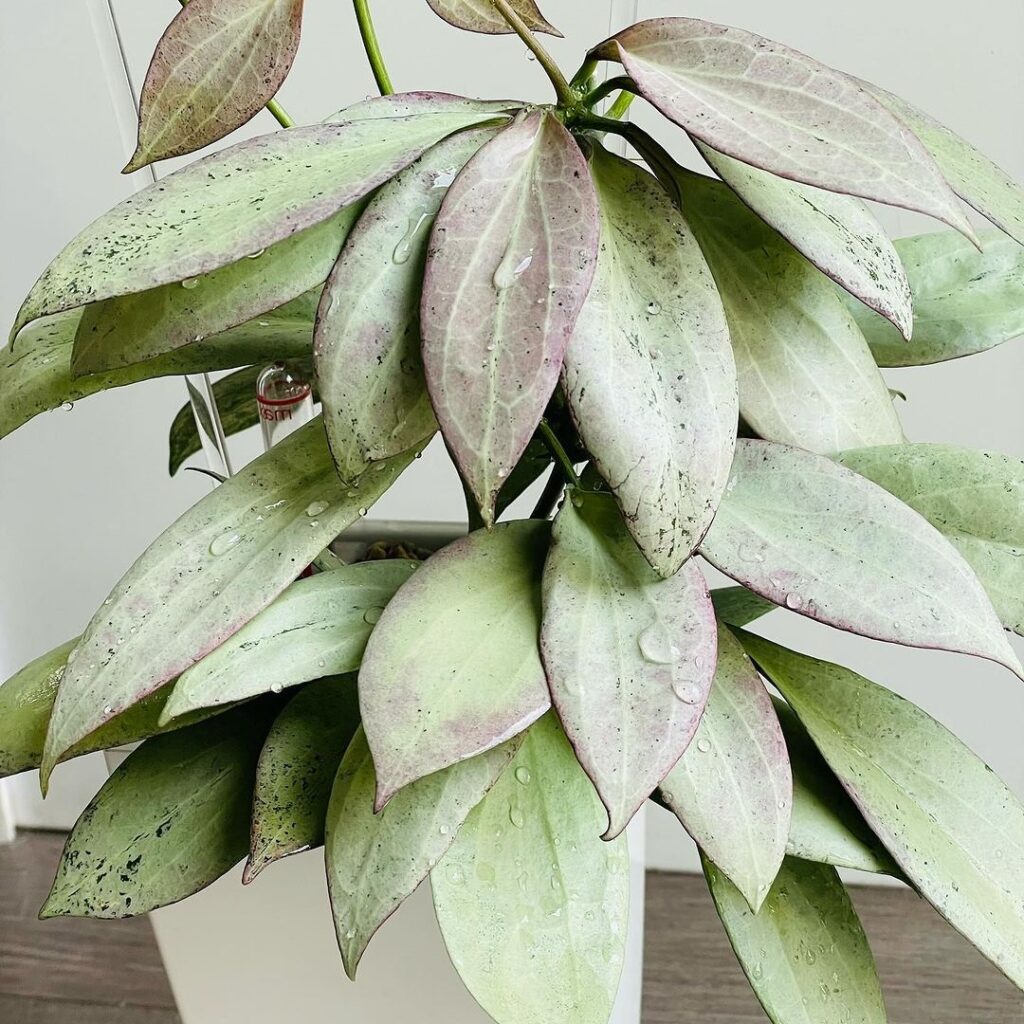
Hoya nicholsoniae New Guinea Ghost is a captivating plant with delicate, shimmering foliage that changes color in bright light, ranging from lavender to pink. This robust flowering plant bursts with beautiful white blooms with a yellow center.
Hoya nicholsoniae
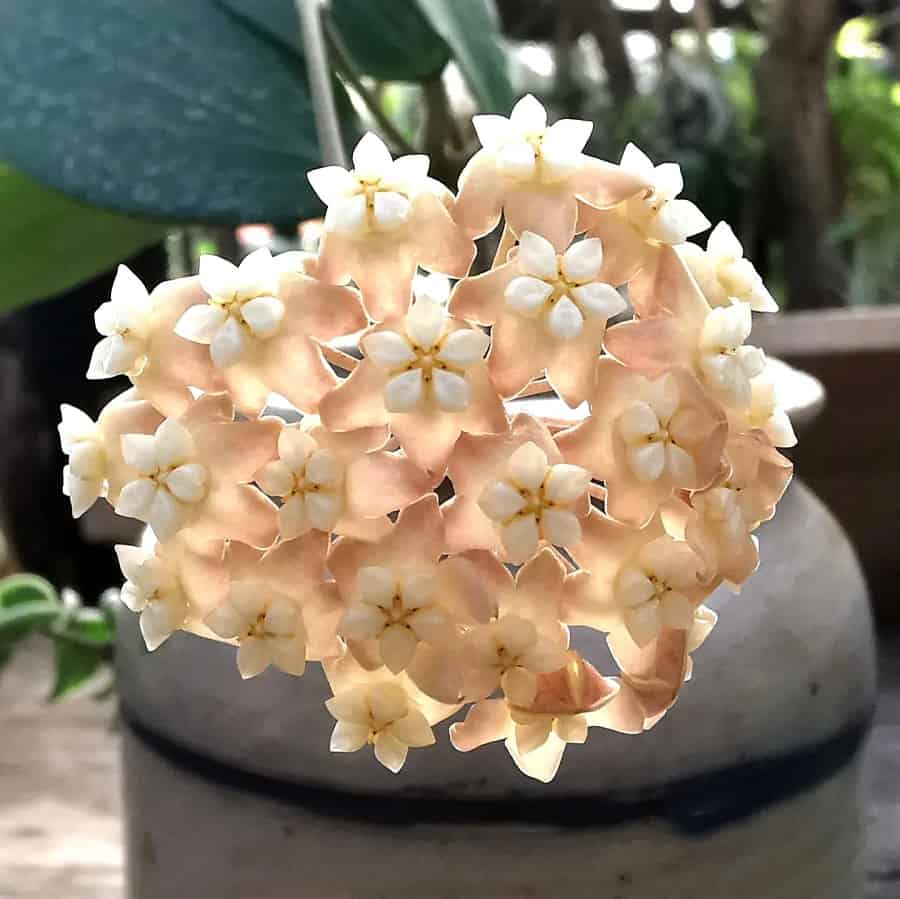
Hoya nicholsoniae is a tropical treasure that grows in the forks of trees along the shores of Rockingham Bay. With its curly stems and aerial roots, this plant brings a touch of whimsy to any indoor garden. Its leaves are oval-shaped with a sharp tip, smooth, and leathery, with 5 veins extending from the base.
When in bloom, Hoya nicholsoniae showcases clusters of 10-25 individual flowers with a diameter of 1.3 cm, the corolla lobes of which can range from faded green to yellow or pink. The crown of the flower is white, making it easily distinguishable from Hoya verticillata, which has white flowers. With its variable flower color and delicate beauty, Hoya nicholsoniae is a must-have for any plant collector.
Hoya nummularioides

Hoya nummularioides is a resilient and low-maintenance plant that’s a joy to cultivate. With its 2.5 mm thick stems that grow in an ampel form and its many aerial roots, it’s a plant that can cling to almost any surface. Its leaves are round or elliptical, plump, velvety, and moderately green, with edges slightly darker.
During the rainy season from August to October, Hoya nummularioides transforms into a fragrant flowering machine, opening several umbels of 10-20 small flowers at the same time, each with a white corolla and a pink crown. Recently, several clones have emerged with crowns of different colors, including pink, deep pink, and pale yellow, making Hoya nummularioides a versatile and stunning addition to any indoor garden.
Hoya nyhuusiae

Hoya nyhuusiae is a unique and rare species of Hoya plant, named after the renowned Swedish Hoya collector, traveler and former editor of Hoyatelegrafen, Torill Nyhuus. This winding, epiphytic or ground-growing plant is found in the humid and foggy equatorial forests of Bukit Tupai, Mt. Kinabalu, Sabah, Borneo, Malaysia at an altitude of 1400-1600m above sea level.
The leaves of Hoya nyhuusiae are dark green, glossy, and thick with a pinnate venation and a clearly visible central vein. During flowering, 4-6 individual pale green bell-shaped flowers with pale yellow crowns open in a flower umbrella with a diameter of 4-5 cm. Although it is difficult to grow and not suitable for beginners, Hoya nyhuusiae is a fascinating plant that adds an exotic touch to any collection.
Hoya oblongacutifolia

Hoya obovata

Hoya obovata is a captivating, climbing hoya with a fast growth rate and a luxurious display of blooms. Its leaves are a rich, deep green color with light speckles and are thick and fleshy, measuring 6-8 cm in diameter. =
When grown in good light, Hoya obovata bursts with 20-30 fluffy pale pink flowers, each with a dark pink or pink inner crown. This plant is known for its sweet and abundant nectar, which is not only transparent but also a standout characteristic among its relatives like H. kerrii and H. diversifolia.
Hoya obovata Splash
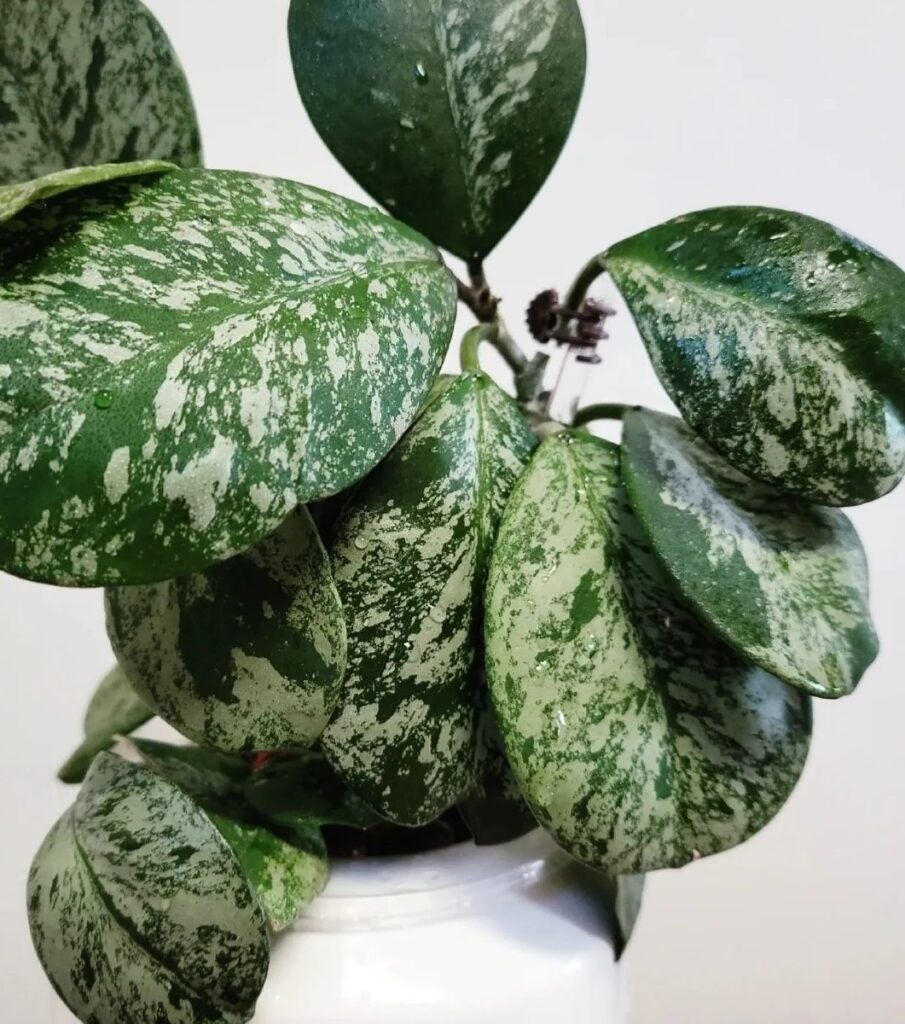
Hoya obovata Splash is a variegated variety of Hoya obovata, featuring waxy green leaves with yellow variegation in the center and white splashes scattered throughout. This striking appearance makes it a standout addition to any plant collection.
Hoya obscura
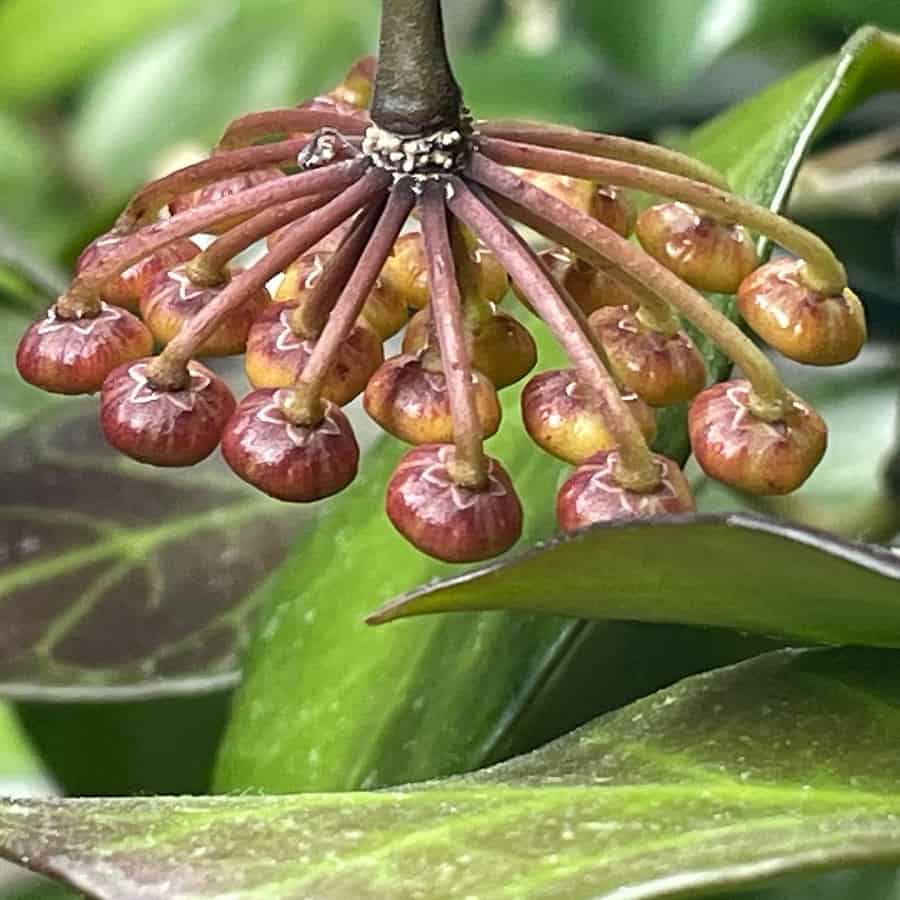
Hoya obscura is a lush and dense epiphyte that thrives in a moist and humid environment. Its leaves are oval-oblong and glossy, with thin lateral veins and the ability to change color based on sunlight exposure. This hoya is known for its flat and graceful floral umbels composed of creamy pink or creamy yellow flowers that are soft and fragrant. Though it requires a lot of water and consistent soil moisture, Hoya obscura is a unique and beautiful plant that adds a touch of elegance to any collection.
Hoya obtusifolia
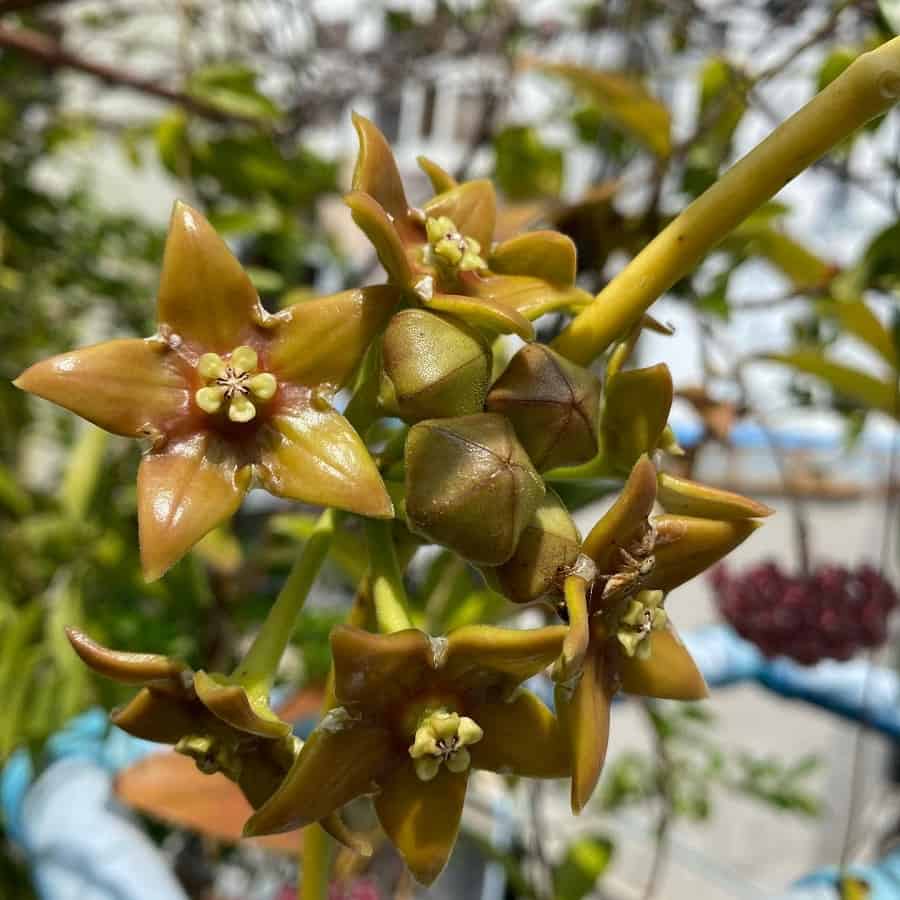
Hoya obtusifolia is a rare and unique plant that boasts fleshy, light green leaves with blunt tops, giving it its name. This hoya is a versatile climber, able to grow both in soil or as an epiphyte, and can reach lengths of up to 10 meters!
In the right conditions, it produces gorgeous convex flower umbels, featuring 10-20 smooth and bell-shaped flowers in a range of colors from ivory to pale yellow, and even pink in some cases. With a thick petiole and a flowering time during the rainy season, this hoya is a must-see for any collector. Although it resembles Hoya imperialis, its flowers are much smaller, making it a distinct species.
Hoya odetteae
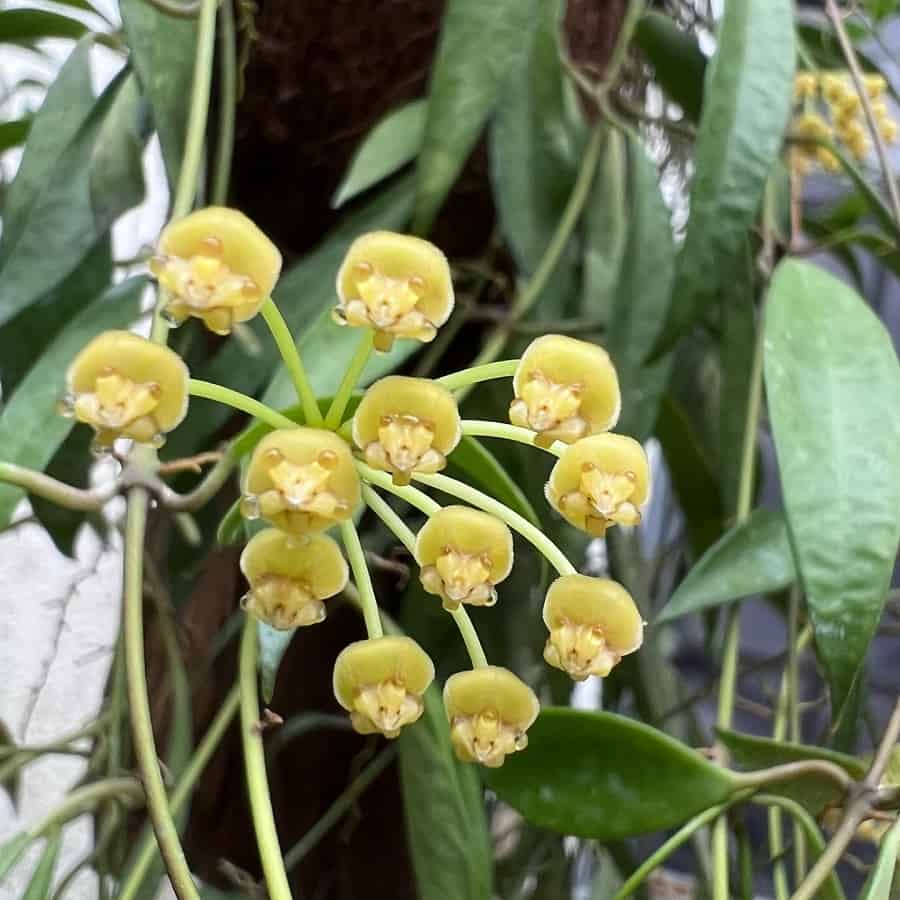
Hoya odorata
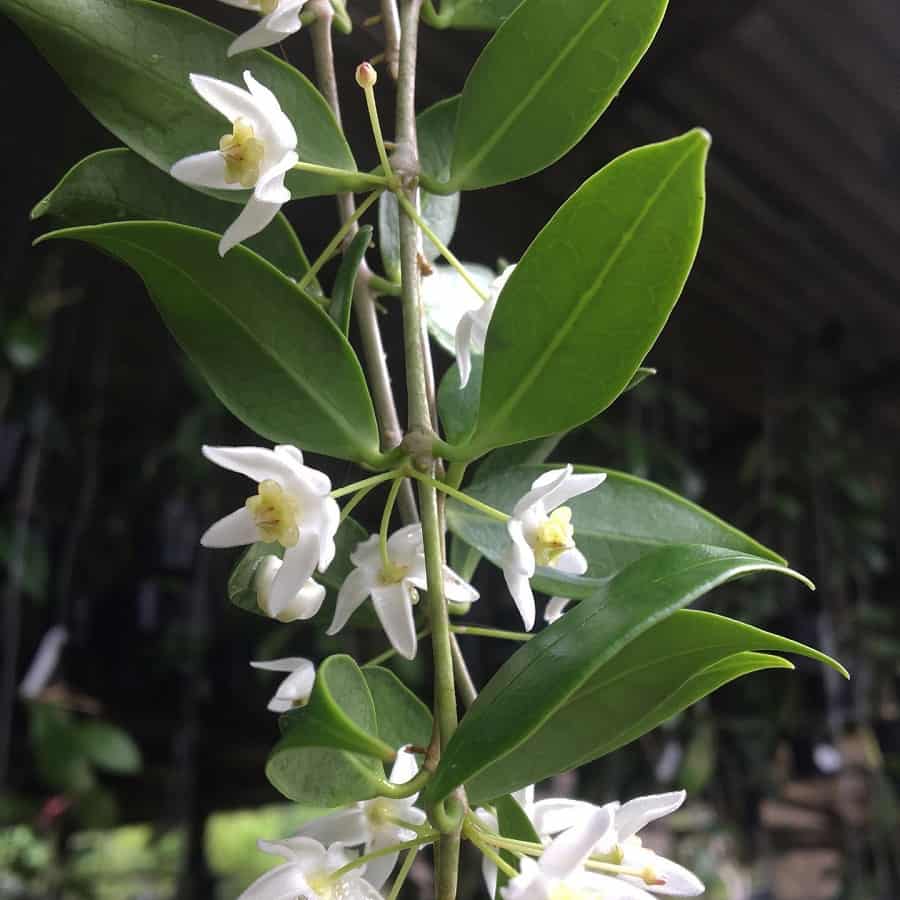
Hoya omlorii
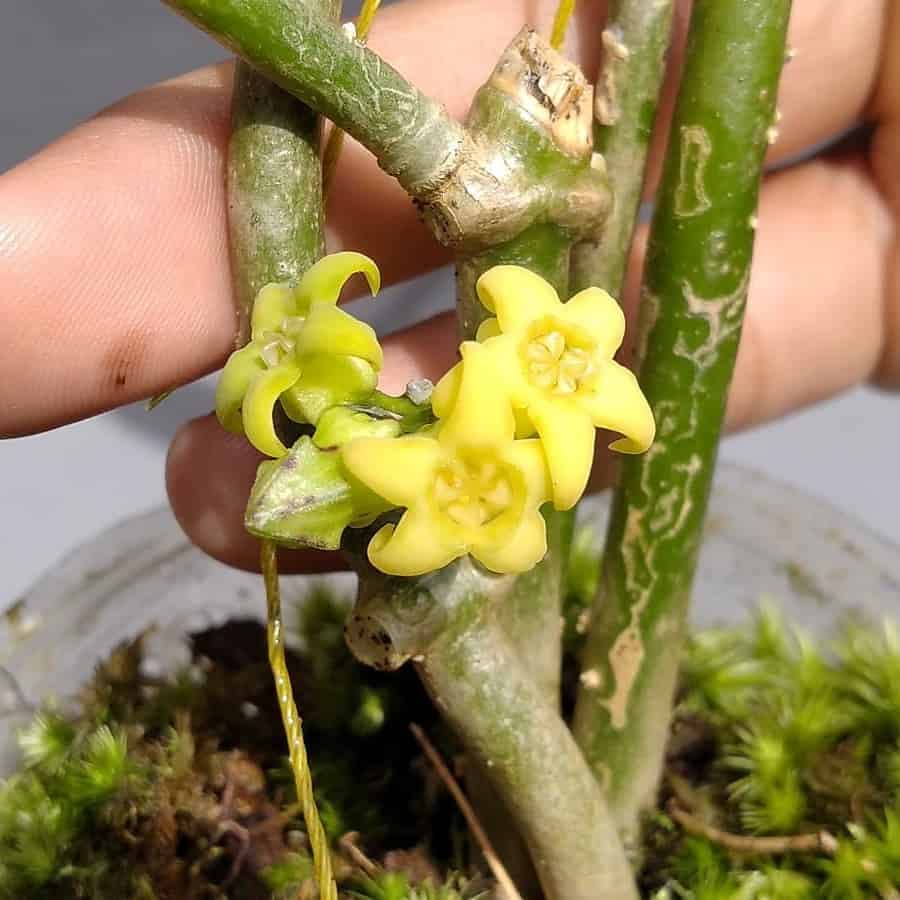
Hoya omlorii is a unique climbing plant that adds a touch of greenery to any space. Its branches are thin and can grow up to 10 meters long, making it a perfect choice for climbing trellises or hanging baskets. The leaves are long and elliptical with a glossy green finish, giving the plant a lush and healthy appearance.
When in bloom, the plant produces up to 12 small, wheel-shaped yellow flowers with a subtle sweet fragrance. This hoya is a low maintenance plant that is perfect for gardeners who are looking for an easy-to-grow plant with a touch of elegance.
Hoya onychoides
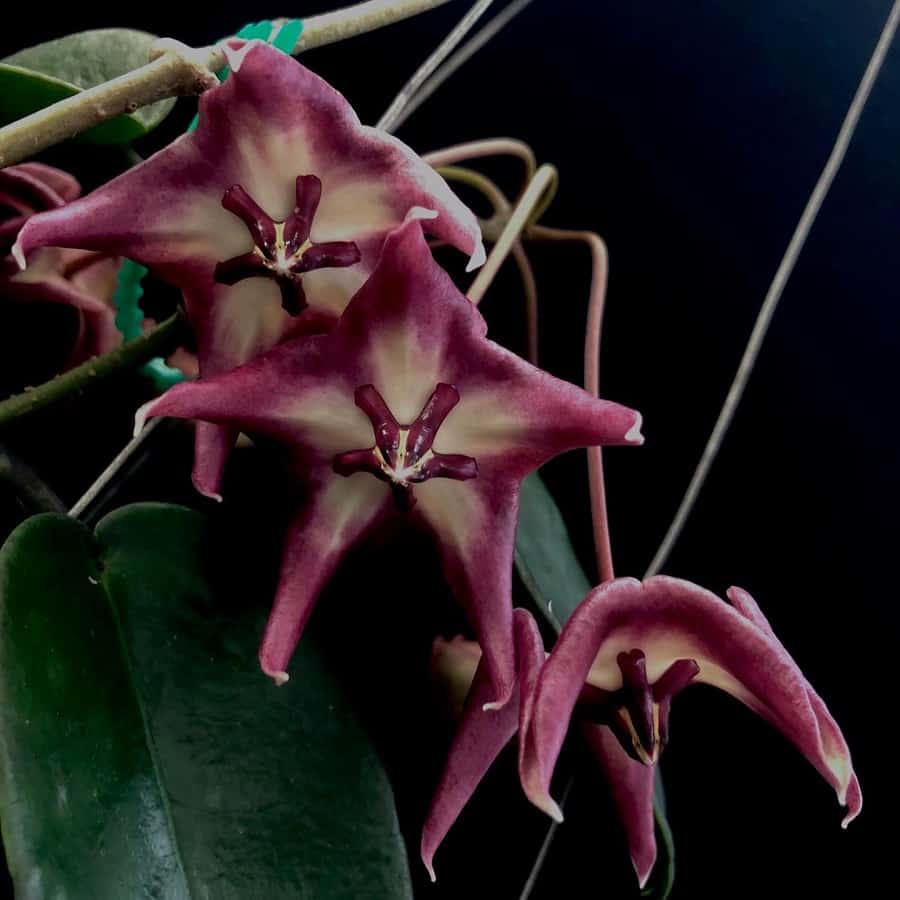
Hoya onychoides is a lush and beautiful hoya that demands room to grow. Its large internodes and oval-lanceolate leaves, with a clearly visible central vein, are a stunning dark green that can show a bronze hue in young growth.
With its unique fragrance reminiscent of gardenia, jasmine, and rose, this hoya blooms profusely with dark pink, almost burgundy, star-shaped corollas, often described as claw-like, in flower umbels of 3-10 individual flowers with a diameter of 5-7 cm. The bloom lasts for about 10 days and the aroma is pleasant and distinctly Hoya onychoides.
Hoya ovalifolia
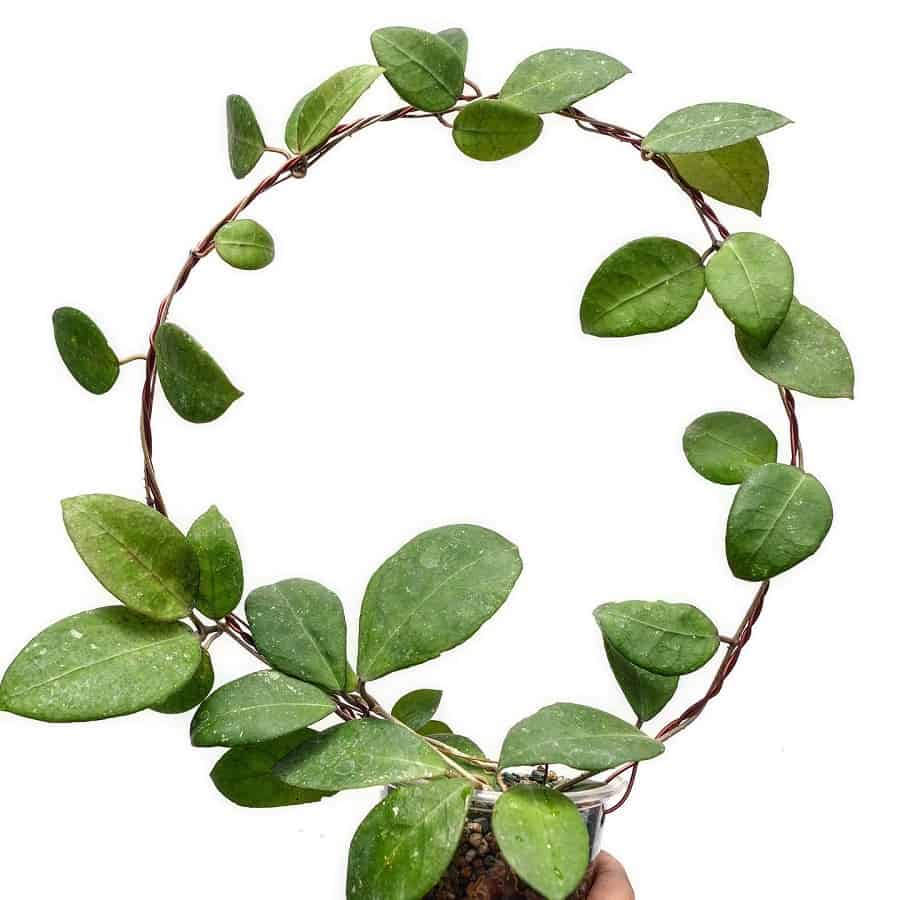
Hoya pachyclada
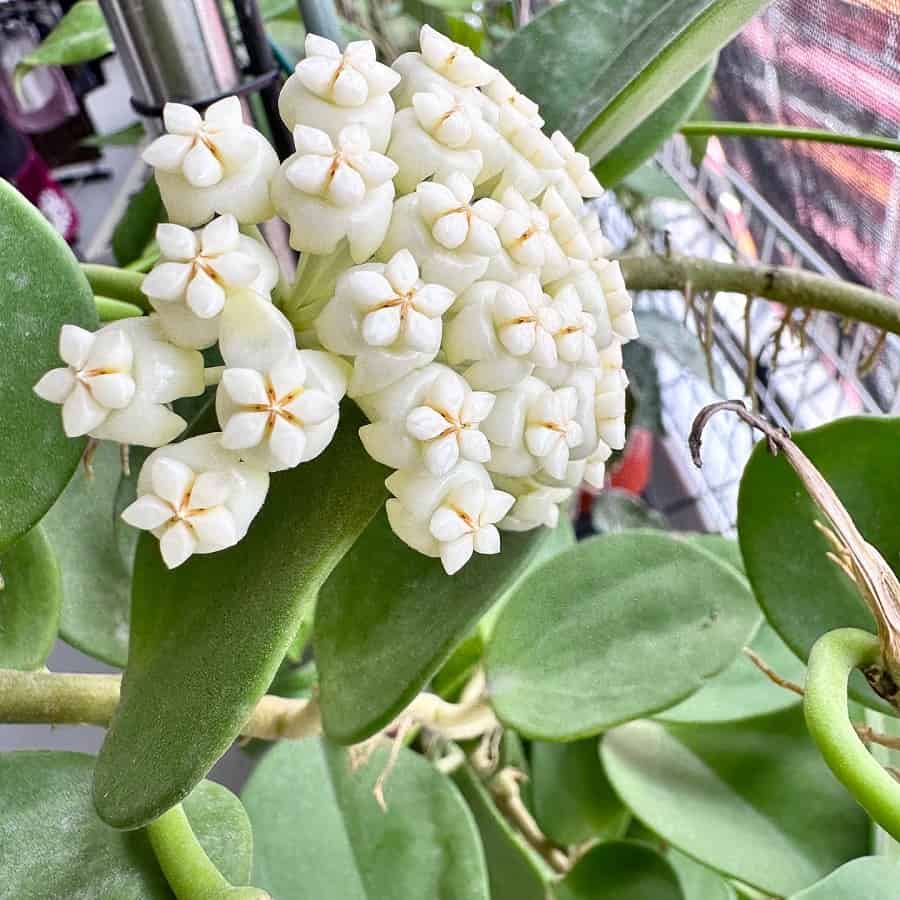
Hoya padangensis
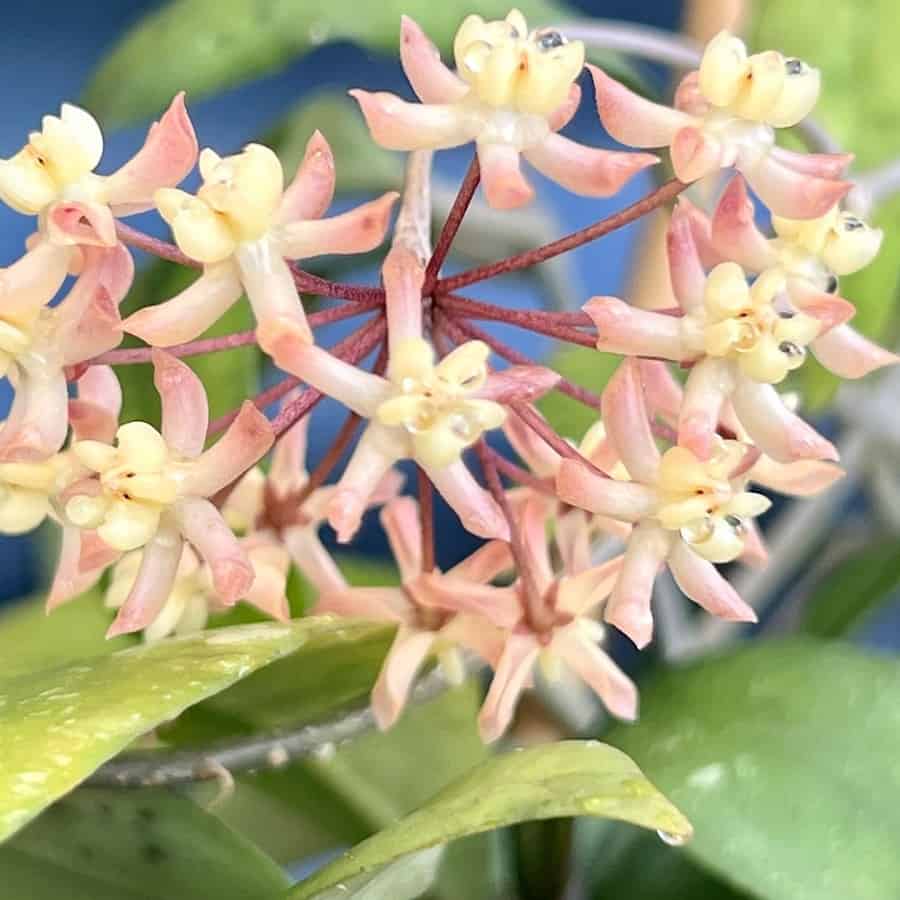
Hoya palawanica
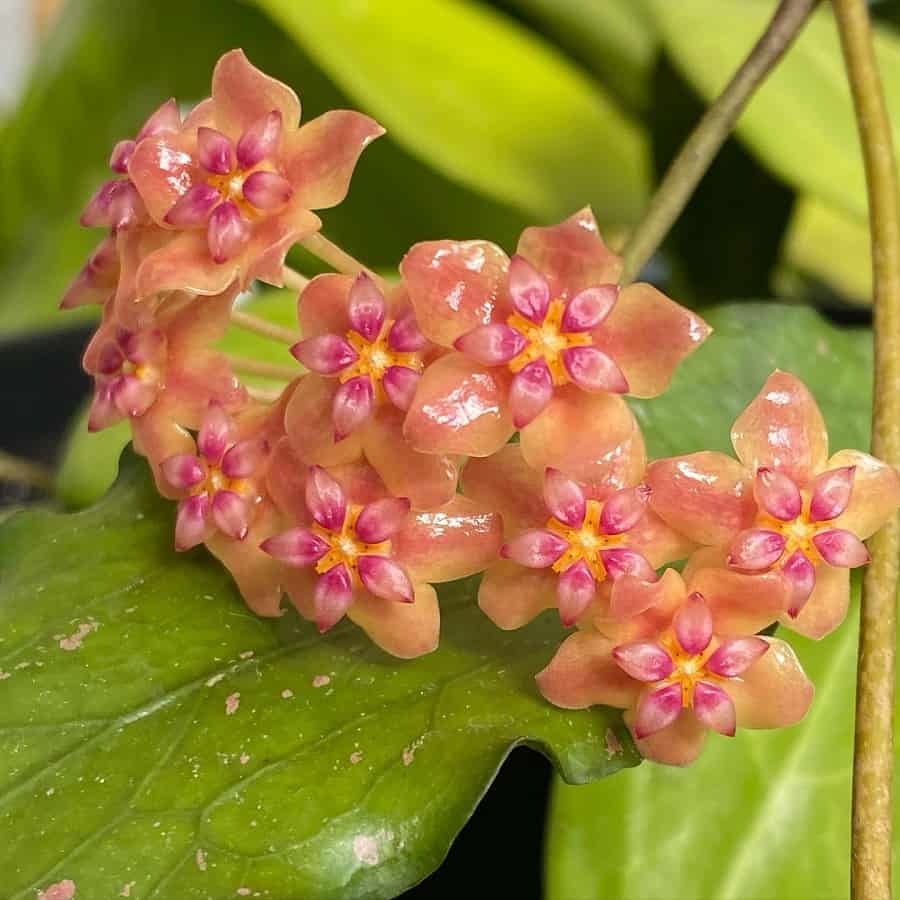
Hoya pallida
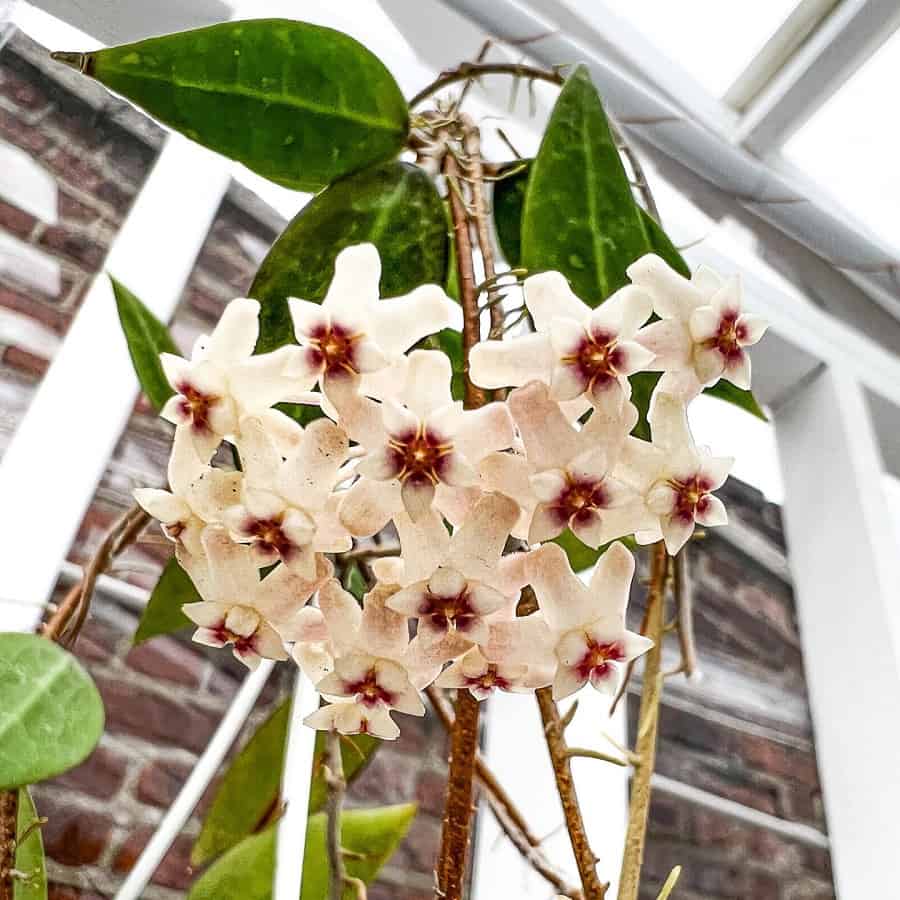
Hoya pallilimba
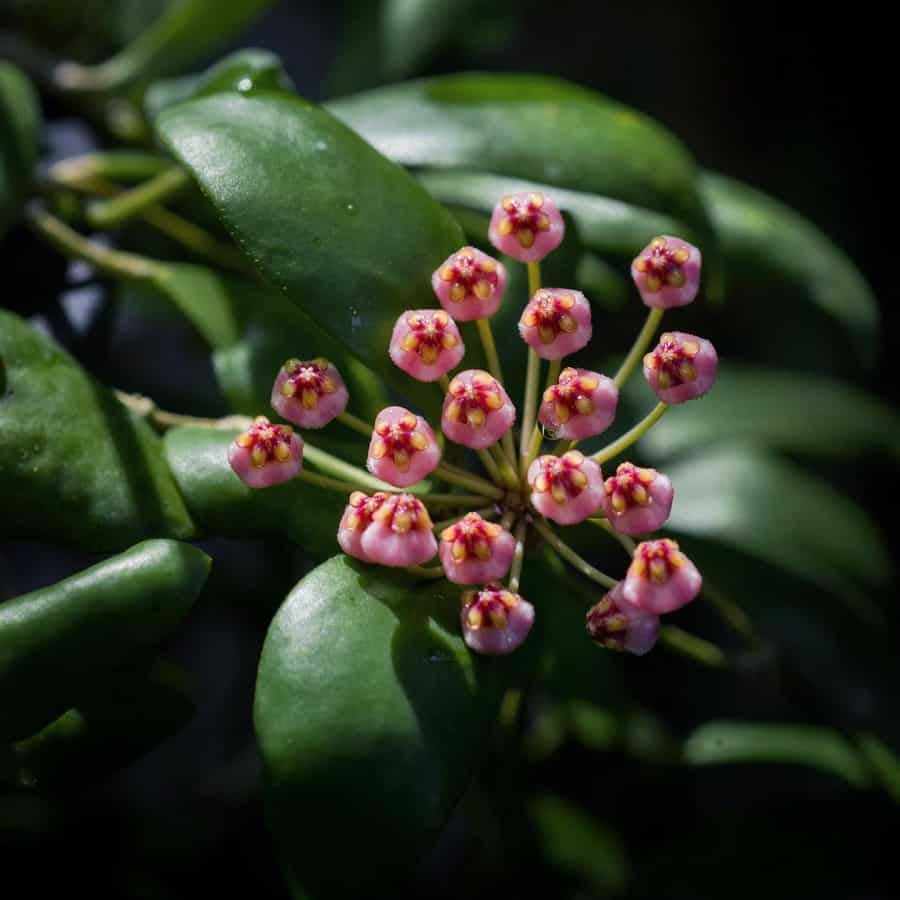
Hoya pallilimba is a unique species native to the Indonesian island of Sulawesi, where it grows in symbiosis with ants. Its stems are thin and clinging, and its leaves are grayish-green with silvery spots and pointed tips. With a loose flower umbel, up to 20 light pink flowers with a yellow crown and sweet scent bloom several times a year. Hoya pallilimba grows slowly but blooms early, requiring shading and high humidity to thrive.
Hoya panchoi
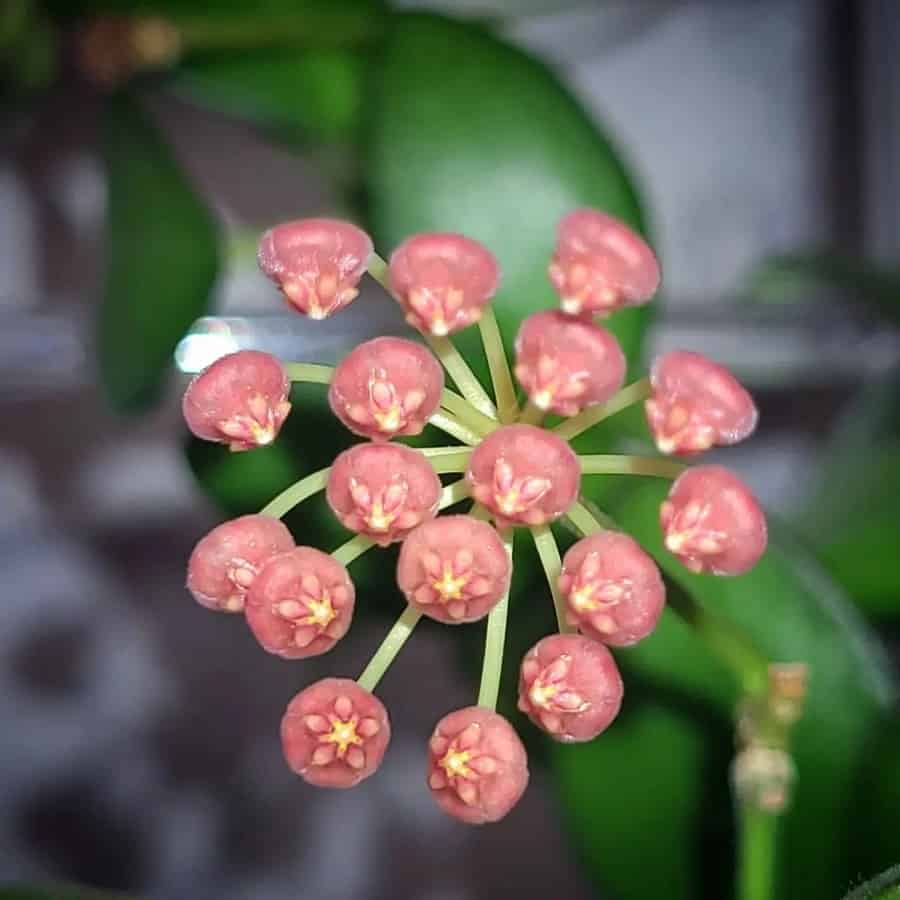
Hoya panchoi is a small but mighty hoya plant that hails from the Bulusan lowlands. With its lush, dark green leaves and beautiful pink flowers with a striking yellow center, this small-leaved ampelous hoya is sure to turn heads. The corolla blades of its flowers are turned back, adding an extra touch of unique charm to this already fascinating plant. Whether hanging from bushes or small trees, Hoya panchoi is sure to thrive in its forested environment.
Hoya pandurata
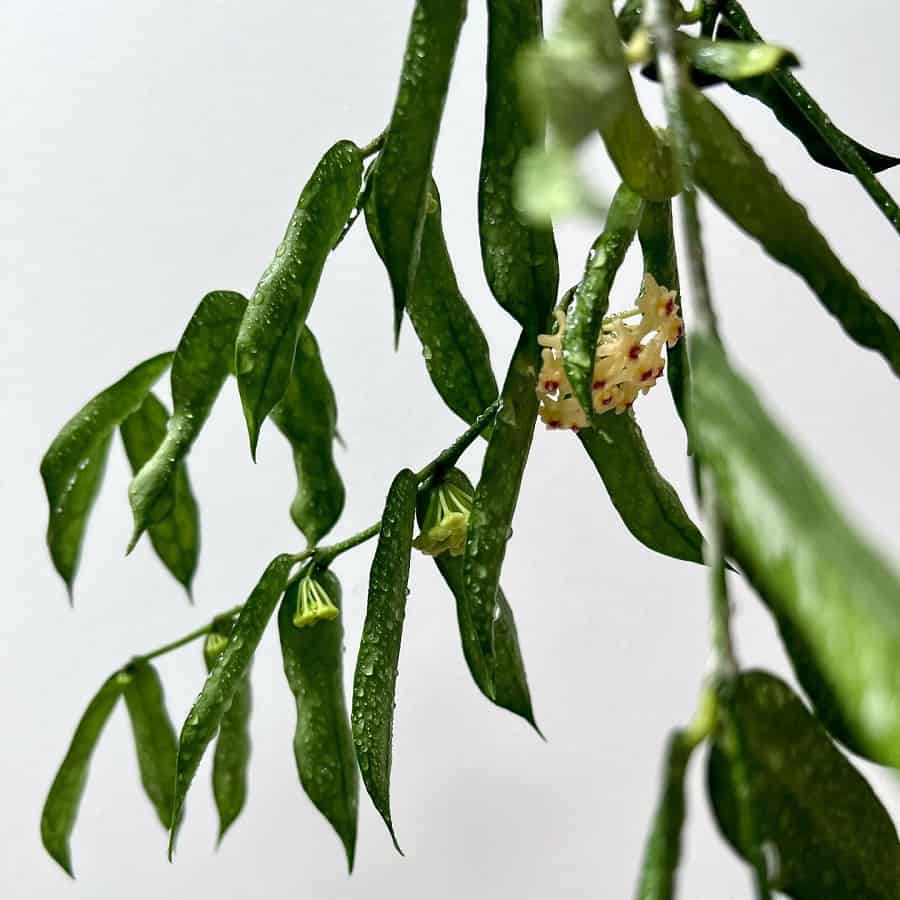
Hoya pandurata is a unique variety of hoya, known for its violin-shaped leaves. This subshrub grows in the primary and secondary broad-leaved forests at elevations of 800-1200 meters, often on exposed mountain peaks. Its dark green leaves are 10 cm long and 2.5 cm wide, and it produces 5-10 flowers with a diameter of 1.2 cm in a flower umbrella.
The orange-yellow corolla blades are bent back, with the tips turned away, and the crown of the flower has an orange-yellow color with a red spot in the center. When it blooms, it releases a sweet nectar. To ensure that it blooms properly, it is important to maintain constant soil moisture when buds begin to grow.
Hoya parasitica
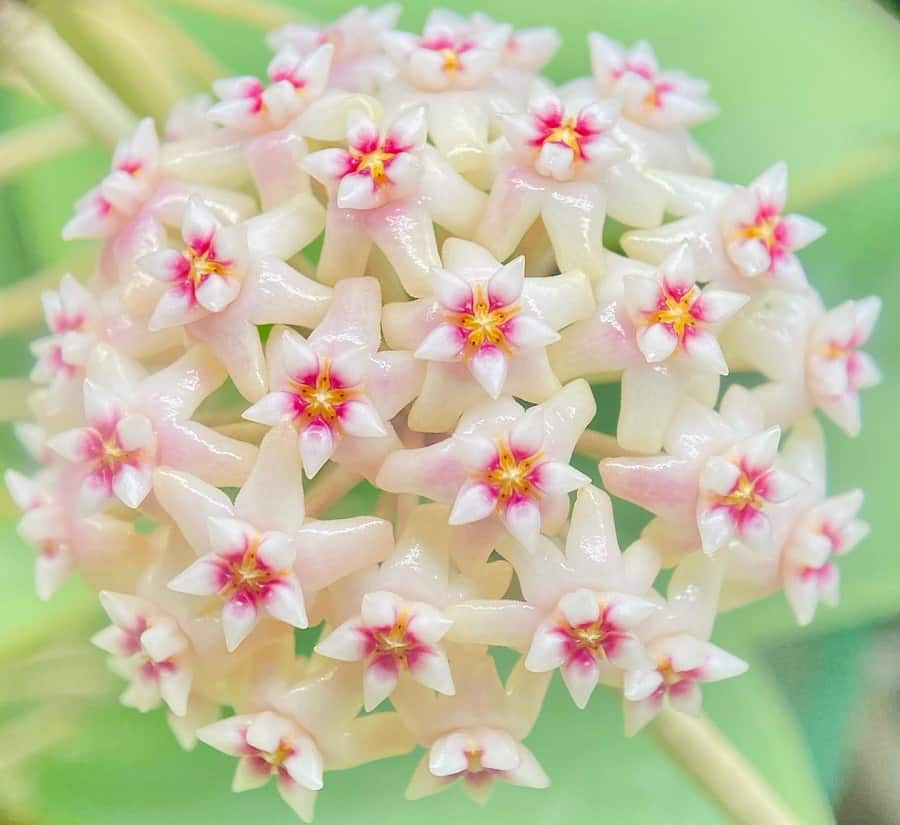
Hoya parviflora
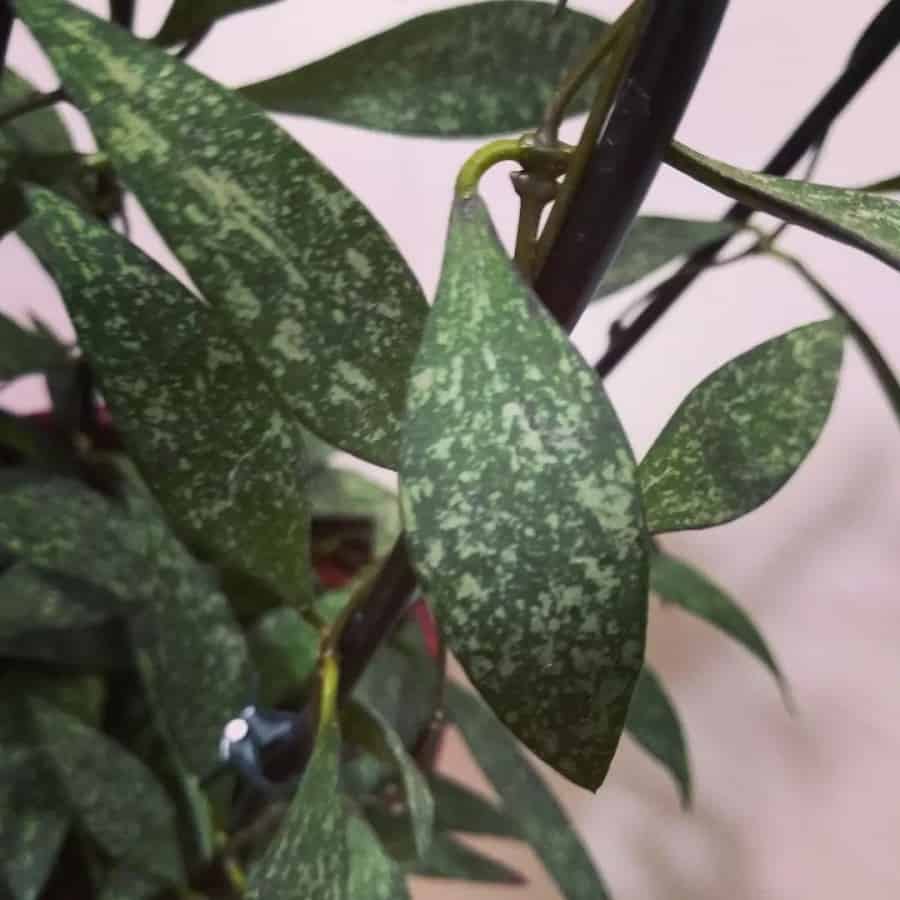
Hoya parviflora is a beautiful epiphyte that thrives in damp, evergreen broad-leaved forests. With its long, curly stems that are often dark red when young and succulent, lanceolate leaves, this species adds a touch of elegance to its natural habitat. The thin, hard peduncles produce a loose, concave floral umbel with small, pinkish-white flowers that have a dense ring of dense hairs at the base of smooth lobes and blades that form into a cone-shaped crown.
Hoya parviflora blooms in autumn in Malaysia and in the summer in Vietnam, making it a stunning addition to the forest during these seasons.
Hoya parvifolia
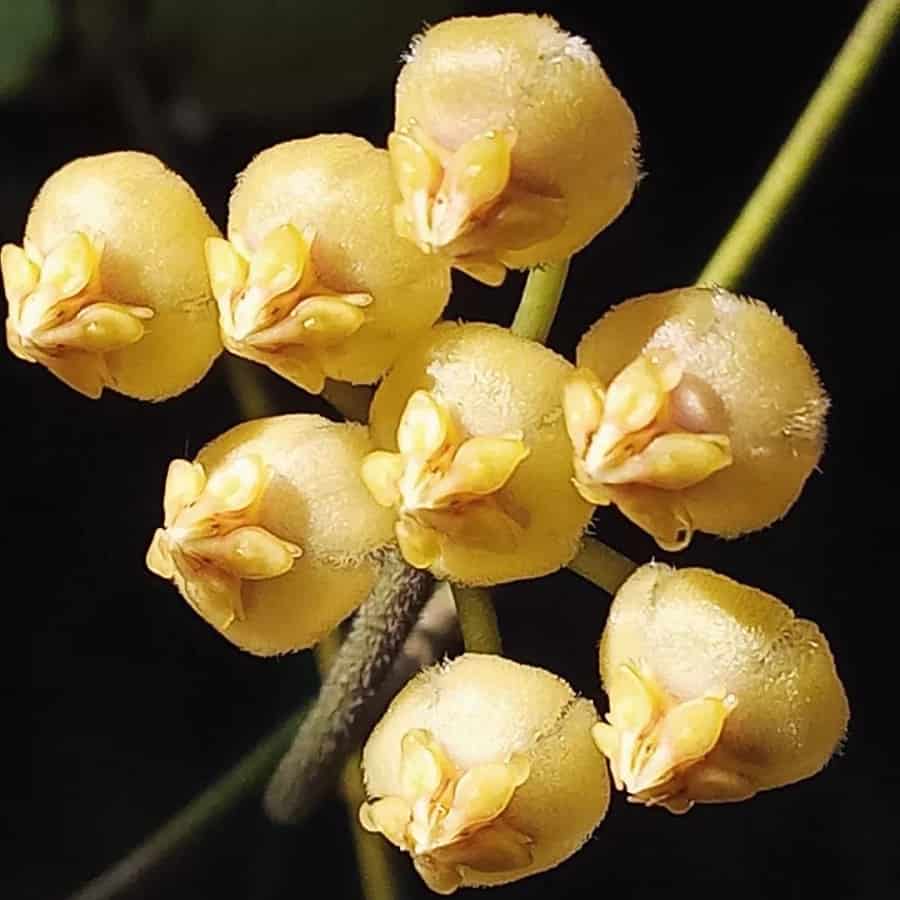
Hoya parvifolia is a charming and unique hoya that is native to Indonesia and Sumatra. With its small, gray-green leaves that are covered in short, velvety hairs and its small, yellowish-green flowers with a yellow crown and reddish patches, it is a delightful addition to any collection. Despite being a slow grower with a superficial root system, it is a hardy species that prefers a moderately dry environment. Found in 1901 near Danua Kotta in the Irdagiri District by Dr. Shlechter, this hoya is a part of the Acanthostemma section and boasts a flower shape that resembles Hoya lacunosa.
Hoya patella
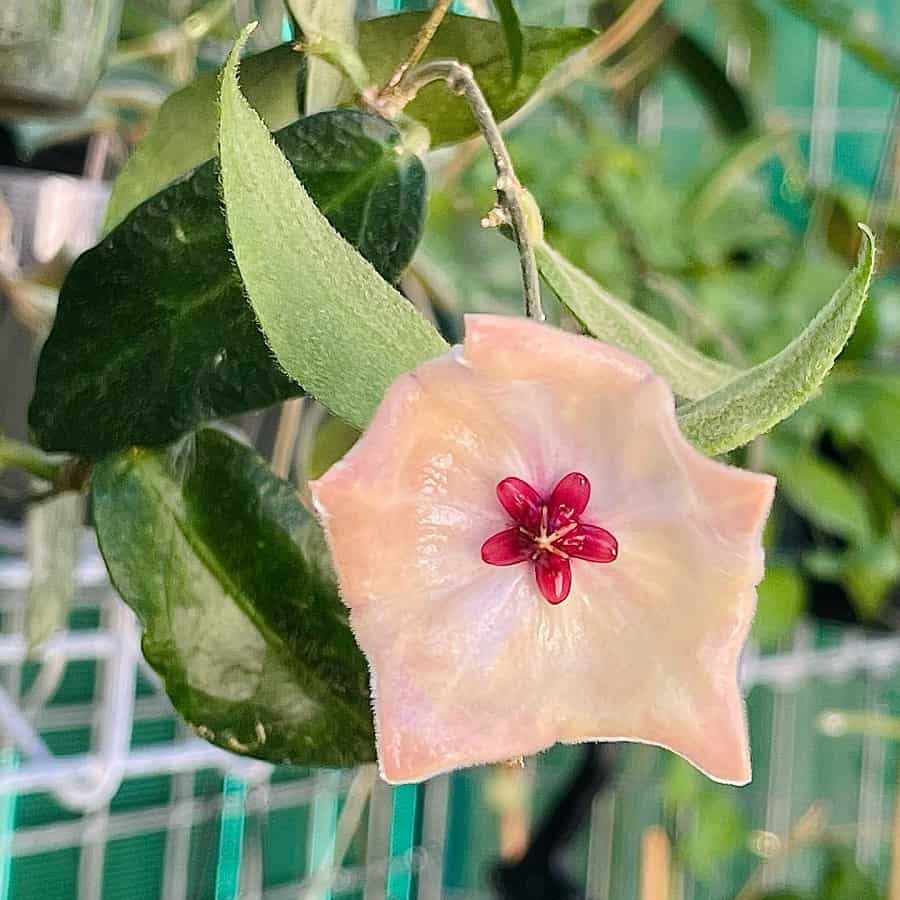
Hoya patella is a stunning epiphytic liana with delicate, sparsely pubescent leaves in an oblong-oval shape. This hoya boasts the largest flowers in its section, with bright pink petals and a crimson-red crown. The corolla of the flower is wide and bell-shaped, with star-shaped lobes, creating a stunning display. Hoya patella requires a warm, moist environment to thrive, and when conditions are right, it blooms readily and consistently. Get ready to be wowed by this gorgeous hoya!
Hoya pauciflora
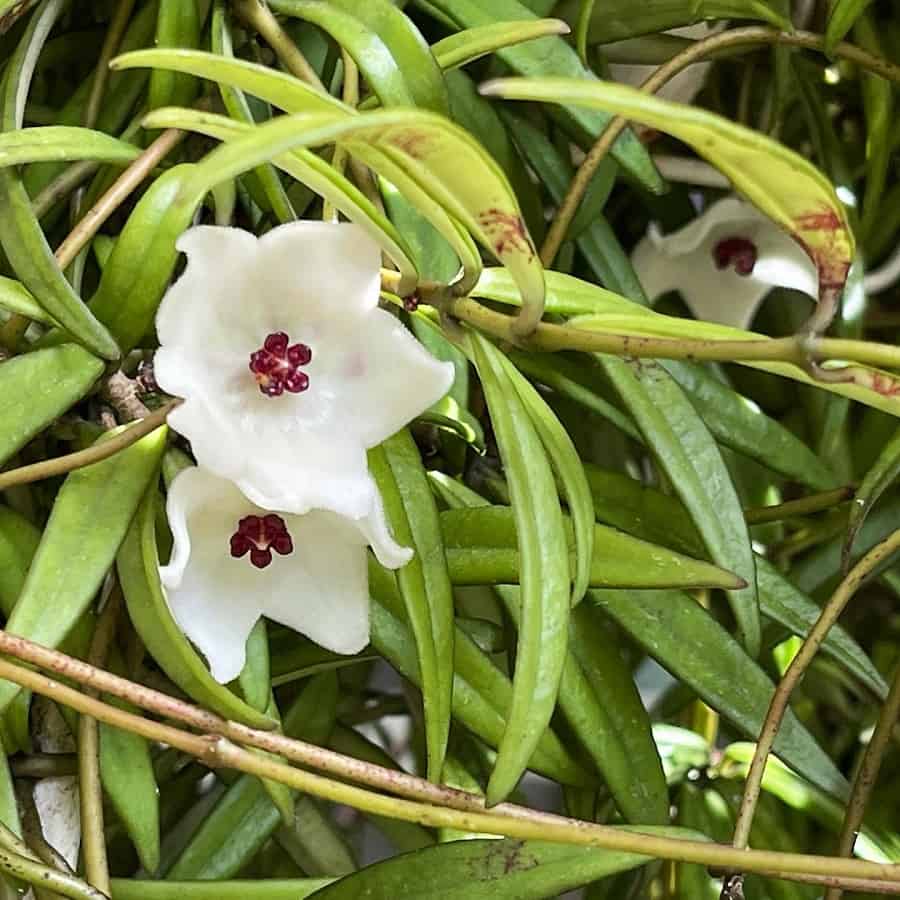
Hoya pauciflora is a compact and bushy plant with thin and smooth dark green leaves that curl at the edges. The leaves can be 3-9 cm long and no more than 1 cm wide, with a clearly visible reddish midrib. This plant produces only 1-2 flowers in each leaf axil that are in the shape of a wide-open bell, with a diameter of 2.5-4 cm. The corolla lobes are crystal white and the crown is purple, giving the impression of “crystals” due to the tiny reflective hairs in the flowers.
Hoya pauciflora blooms from March to September and produces a delicate aroma and a small amount of nectar. This plant grows in both foothills and at high altitudes in humid forest regions, preferring shady and cool places with high humidity and temperature fluctuations.
Hoya paulshirleyi
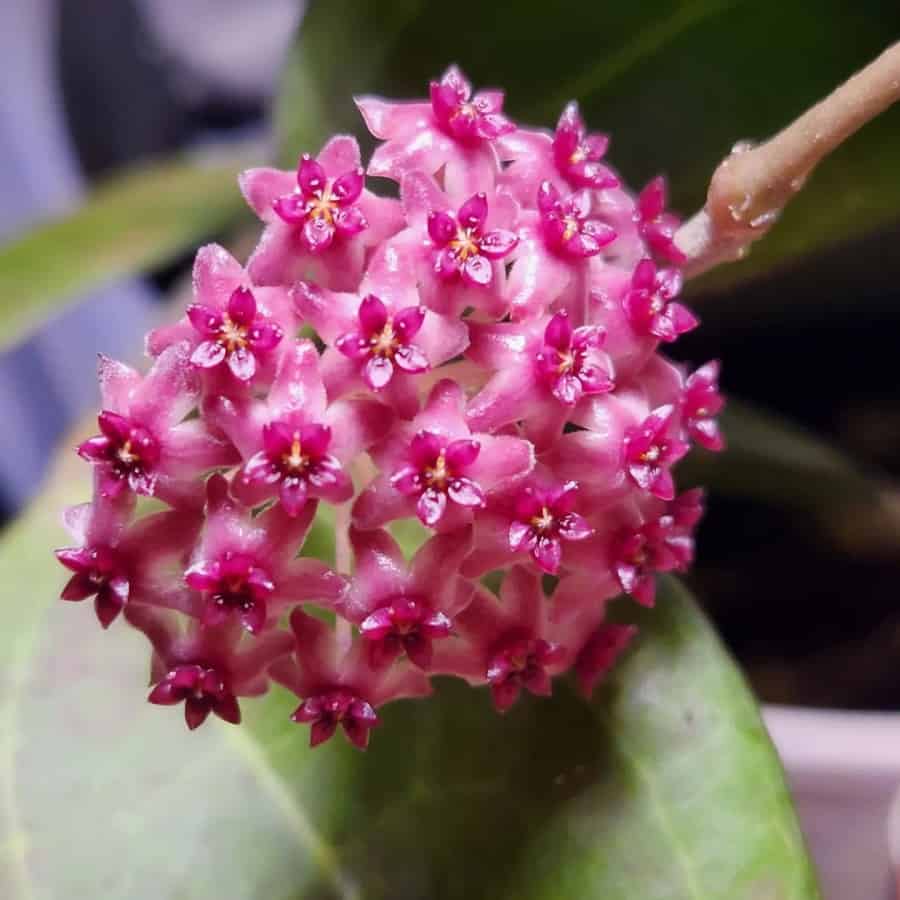
Hoya paxtonii
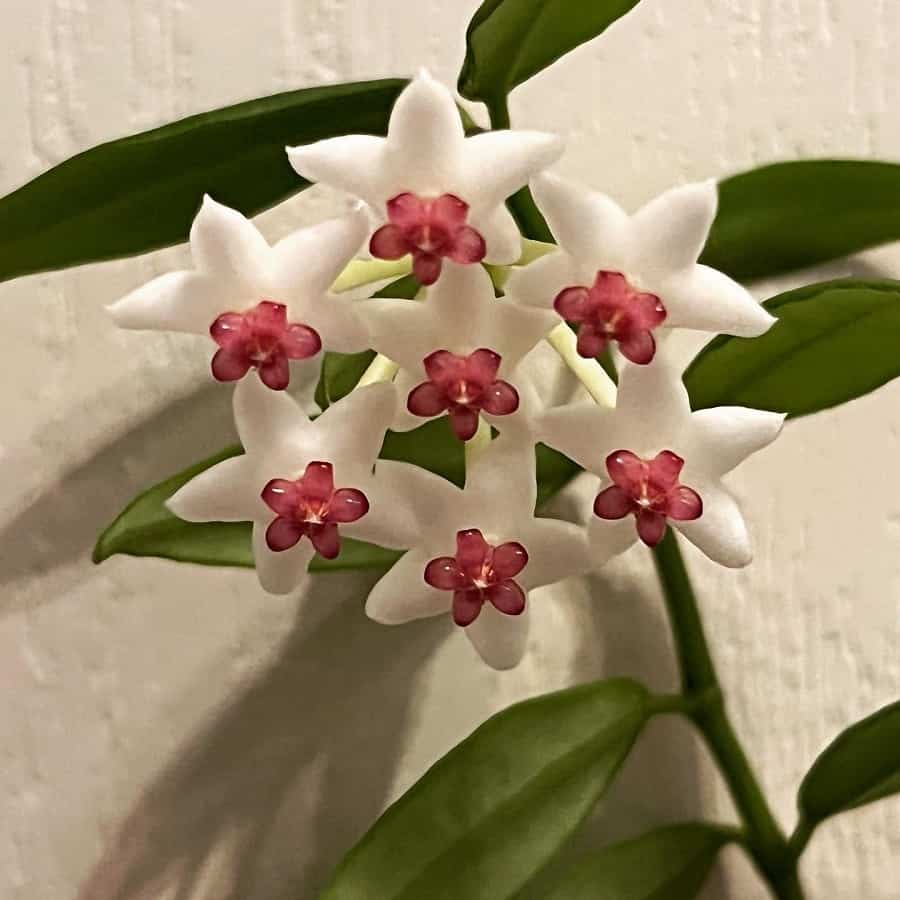
Hoya paziae

Hoya pentaphlebia
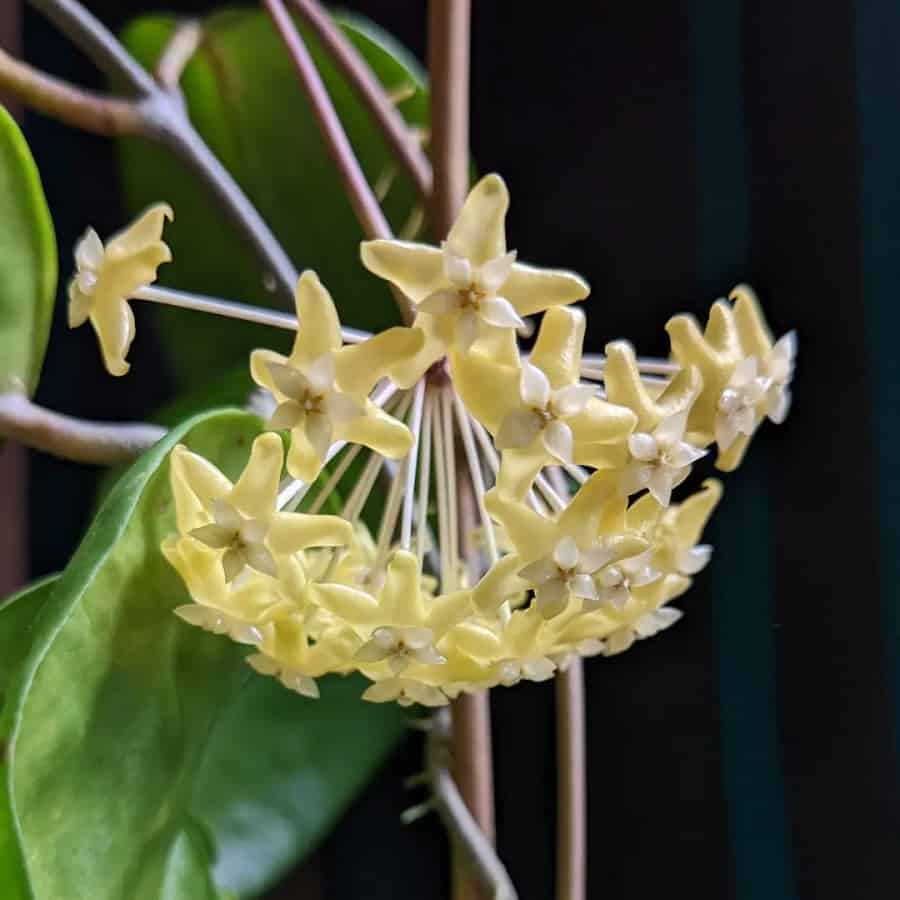
Hoya pentaphlebia is a unique and stunning plant with round, smooth stems and round leaves that are glossy, waxy, and slightly wavy and twisted. This species boasts an impressive flower umbel of 25-35 bright yellow flowers that emit a sweet citrus scent throughout the day and night. Hoya pentaphlebia is related to Hoya fischeriana, but distinguishes itself with its differently shaped leaves and its uncommon blooming period from early spring to late October.
Hoya perakensis

Hoya phyllura
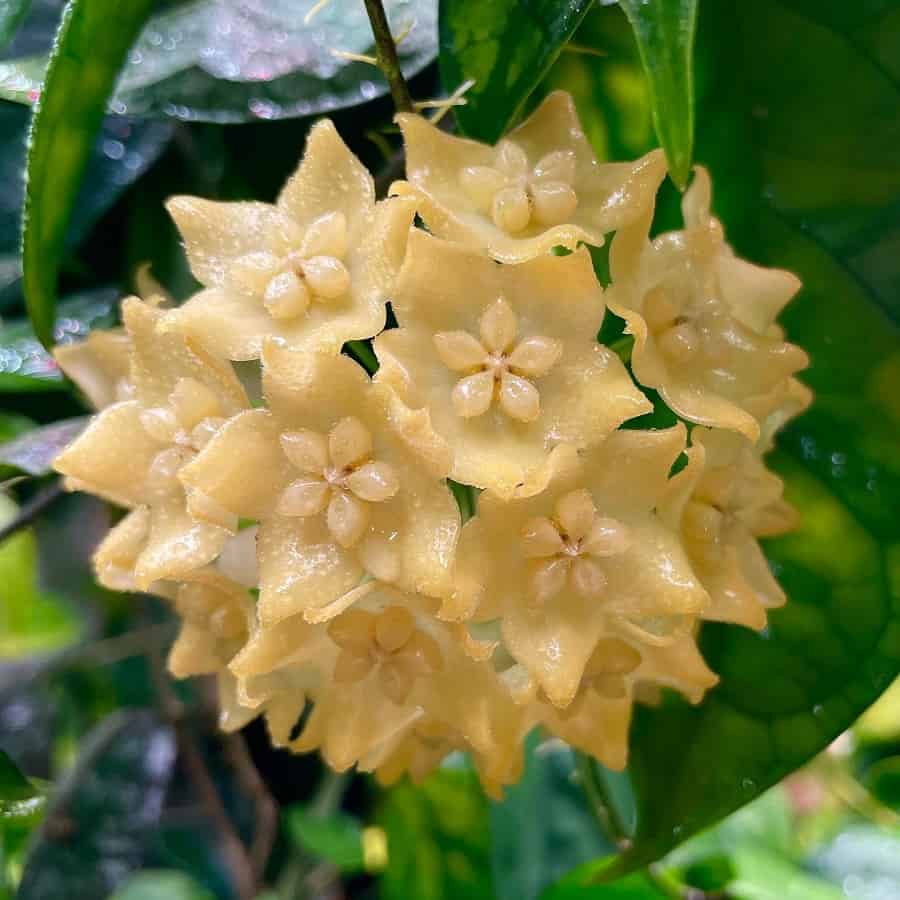
Meet Hoya phyllura, a stunning climbing hoya from Sabah, known for its smooth stems that can grow up to 10 meters long. With its milky white juice, corky bark and light green leaves, this plant is not only fascinating to look at but also boasts of a beautiful convex umbrella of 10-28 cup-shaped, yellow or pale orange flowers, that open up and spread their sweet fragrance throughout the year. Despite its natural habitat in the hills among the dipterocarp forest, Hoya phyllura is currently threatened with extinction, making it a rare and unique species to keep an eye out for.
Hoya picta
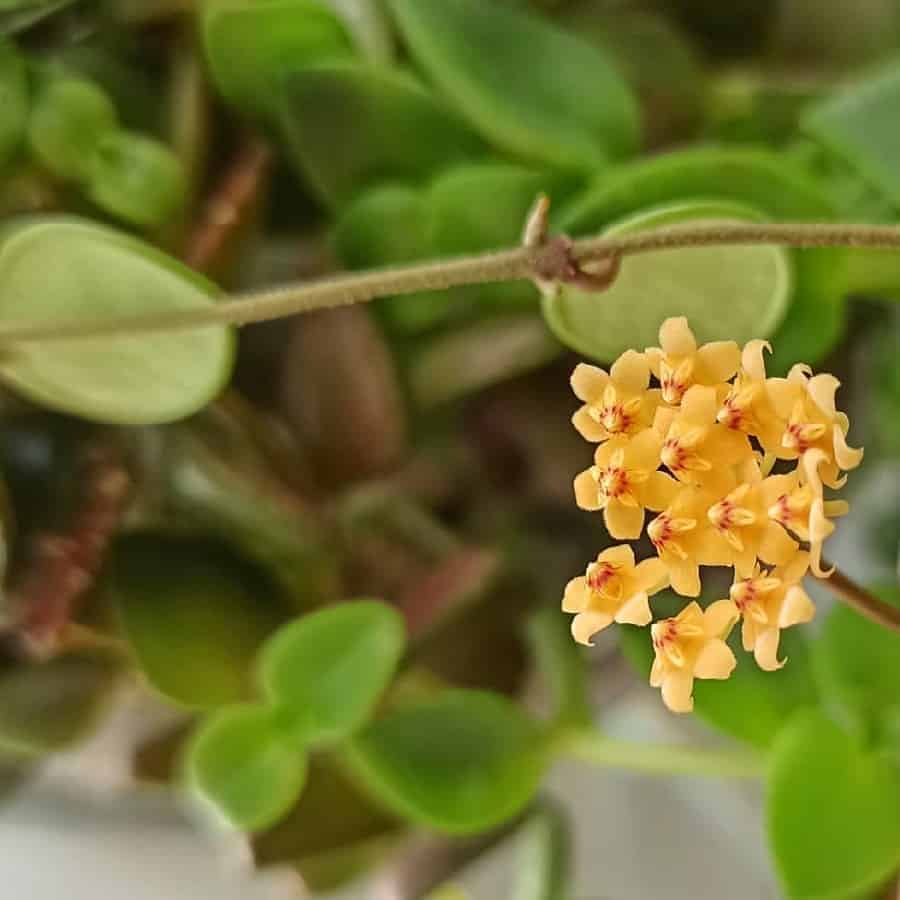
Hoya piestolepis
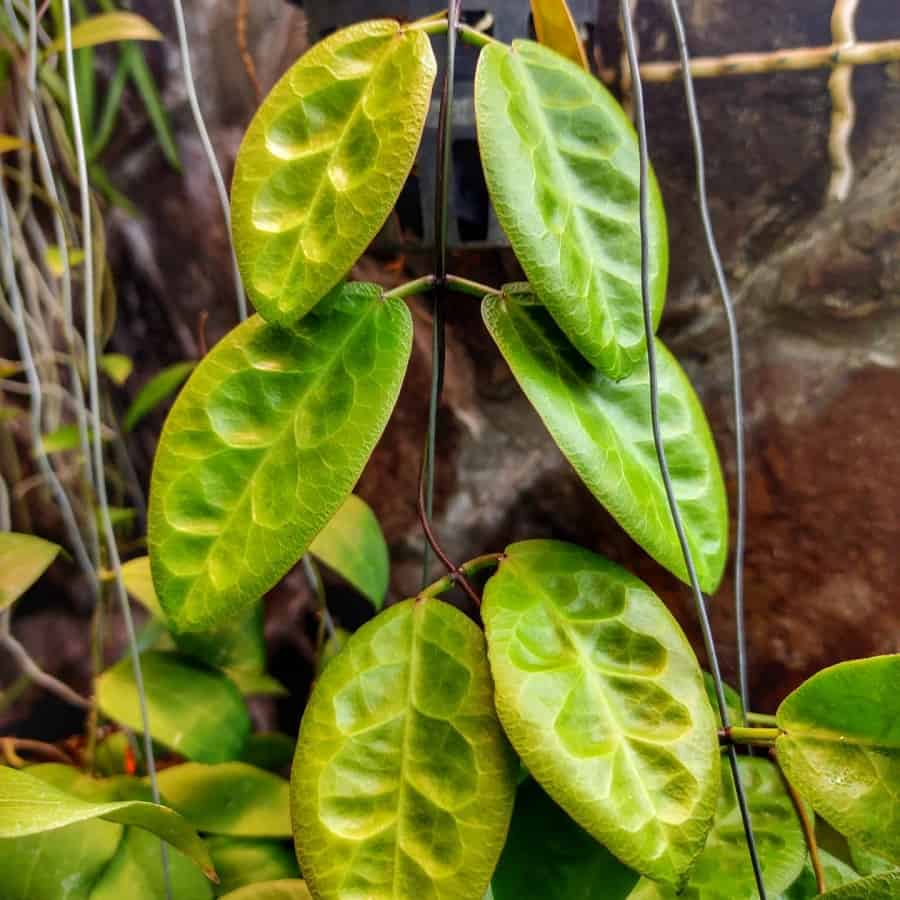
Hoya piestolepis is a fascinating vine that originates from the forests of northeastern New Guinea. With thin and flexible stems, this hoya can climb its way to new heights. Its leaves are leathery, oblong-elliptical in shape, and boast a glossy finish that gives the plant an added touch of sophistication.
During the flowering season, up to 10 unique blooms can be seen on each flower umbel, each with a smooth and slightly pubescent corolla. With peduncles that measure around 6 cm in length, the corolla itself reaches a stunning 2.4 cm in diameter, with bent blades that perfectly complement its center-to-edge crown that stands at a mere 0.5 cm long and 4 mm high. This hoya is truly a treasure to be discovered, and is a perfect addition to any collector’s garden.
Hoya pimenteliana
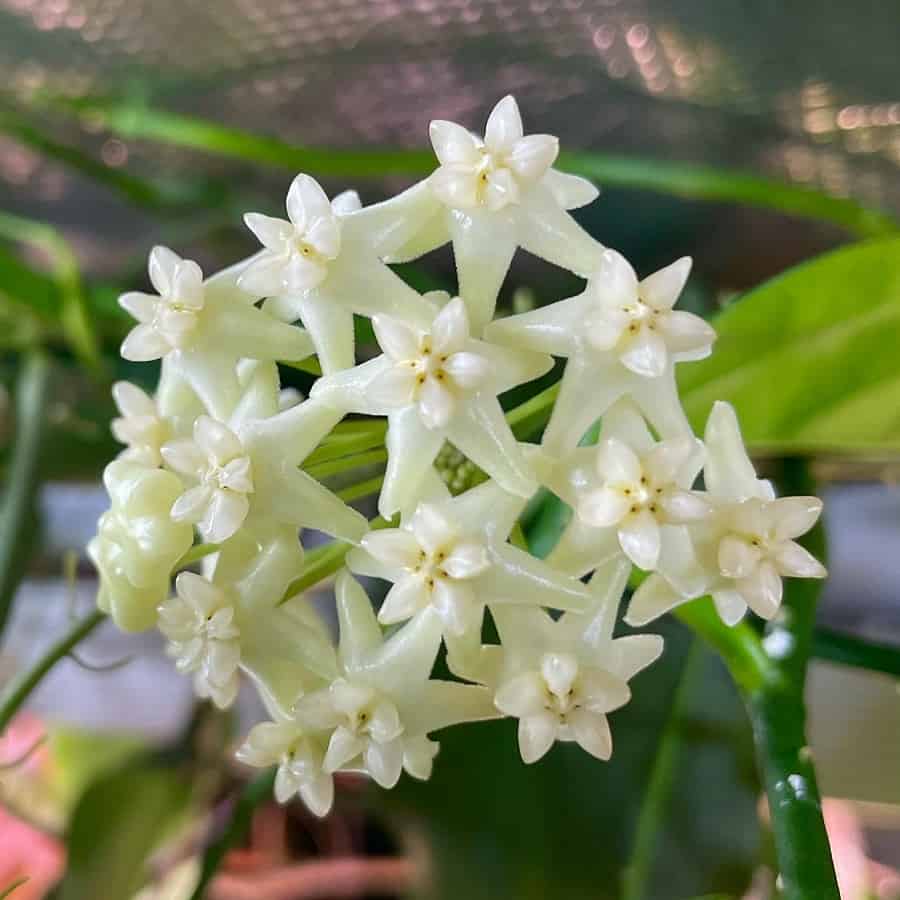
Hoya pimenteliana, named after Philippine botanist Reynold B. Pimentel, is a highly branched hoya with a vigorous, curly stem that is green, becomes rough with age, and lighter in color as it matures. Its leaves are deep dull iridescent green and have a pinnate venation, with secondary veins extending at a 45° angle to the midrib. The pedicels are light cream-brown with varying degrees of purple, and in a flower umbel, 4 to 18 individual flowers open, each with a yellowish, recurved, pubescent corolla. This unique hoya is sure to add an interesting touch to any plant collection.
Hoya platycaulis
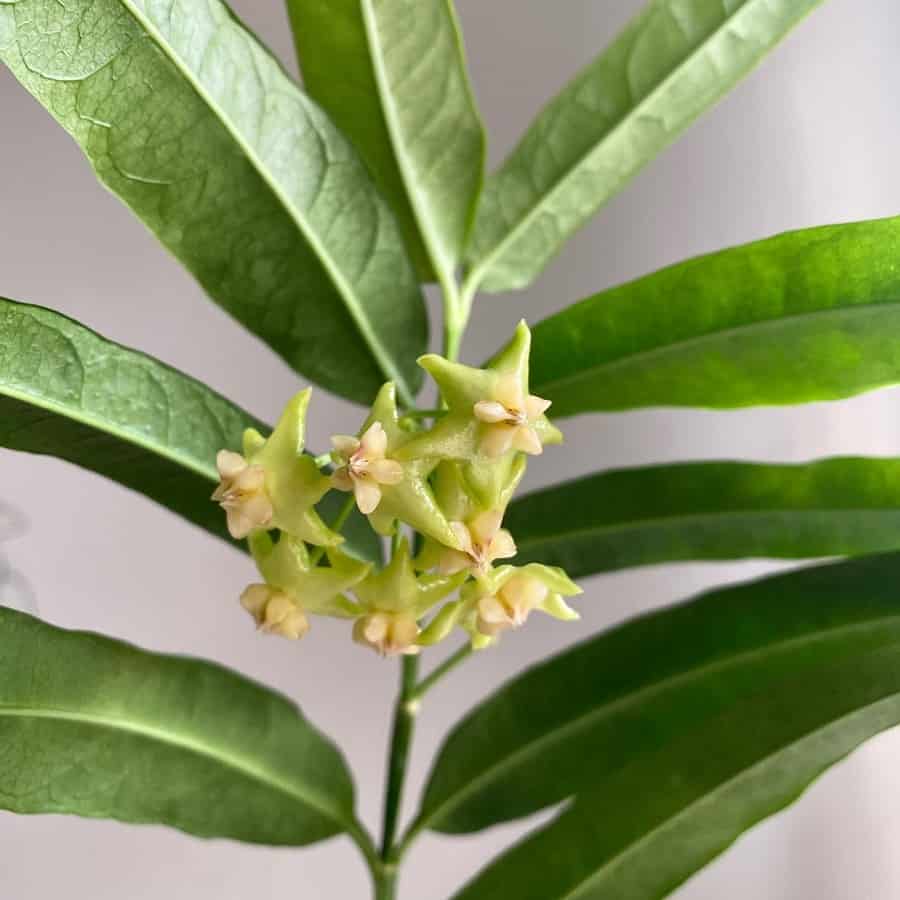
Hoya platycaulis is a unique plant, with slightly woody stems that are flattened on two sides, and can grow up to 1 meter in length. It produces white latex sap and has smooth branches that are 1.5-6 mm in diameter. The leaves of Hoya platycaulis are green and can turn red in strong sun, and are linear-lanceolate with a narrow pointed tip and a rounded base. The floral umbels are flat or slightly convex, with 10-12 individual yellowish-green flowers that are smooth and bent back. With its distinctive leaves and unique stem structure, Hoya platycaulis is a must-see for plant lovers.
Hoya plicata

Hoya plicata is a unique epiphyte that is easily recognizable by its strong yellowish stems. This species boasts dark green, leathery leaves in two different forms – oval-lanceolate with either 7 cm by 4 cm dimensions or 18 cm by 5 cm dimensions with elongated-pointed bases. The leaves have weakly expressed venation and both surfaces are smooth.
In a concave flower umbel, there can be anywhere from 1 to 25 blooms that are open for 8 to 10 days, with pubescent, pale orange corollas that have a dark red upper part of the blade of the crown. Although it has often been mistaken as Hoya micrantha, chemical analysis has shown that they are indeed two separate species.
Hoya polyneura
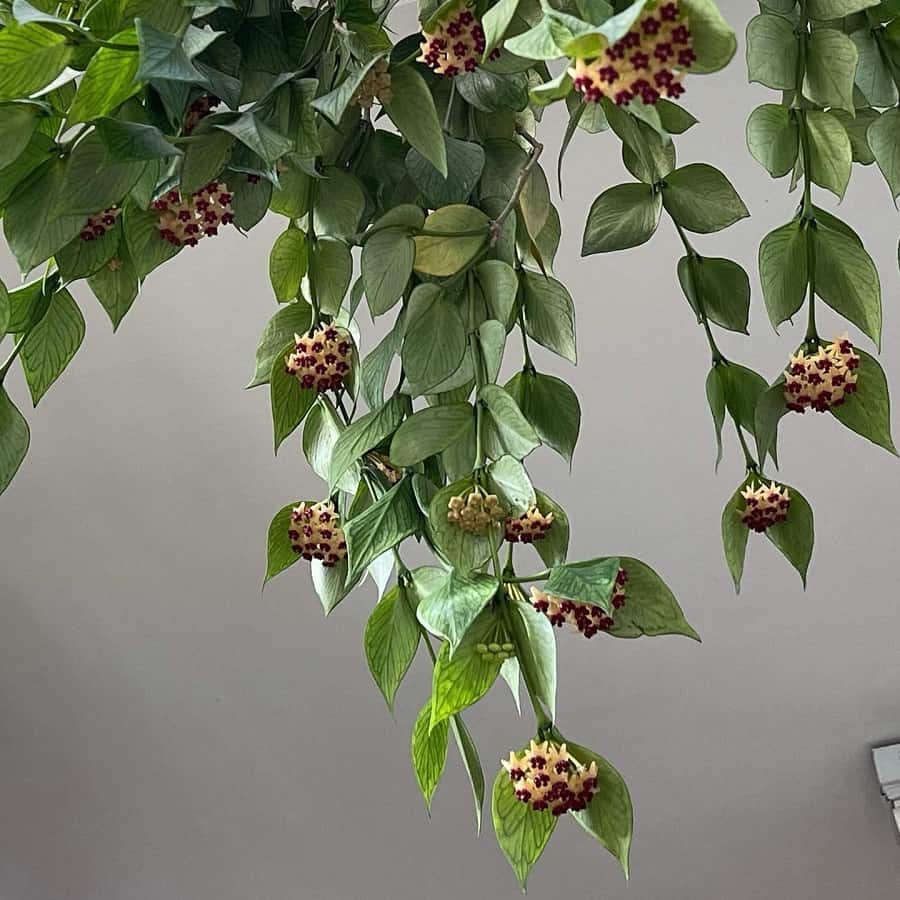
Hoya polyneura is a majestic epiphytic subshrub that grows in tall trees along the edges of mountains at an altitude of 1700-1900 meters. This plant is known for its strong, spreading branches and dark green leaves with prominent venation, earning it the name “many veins”. During the months of May and June, the plant puts on a beautiful display with 10-15 pale pink flowers with a cherry-colored crown.
There are two forms of Hoya polyneura, one with green leaves and one with silver-speckled leaves, making this plant a unique addition to any collection. Although easy to grow, Hoya polyneura requires cool evening temperatures to flower.
Hoya polystachya
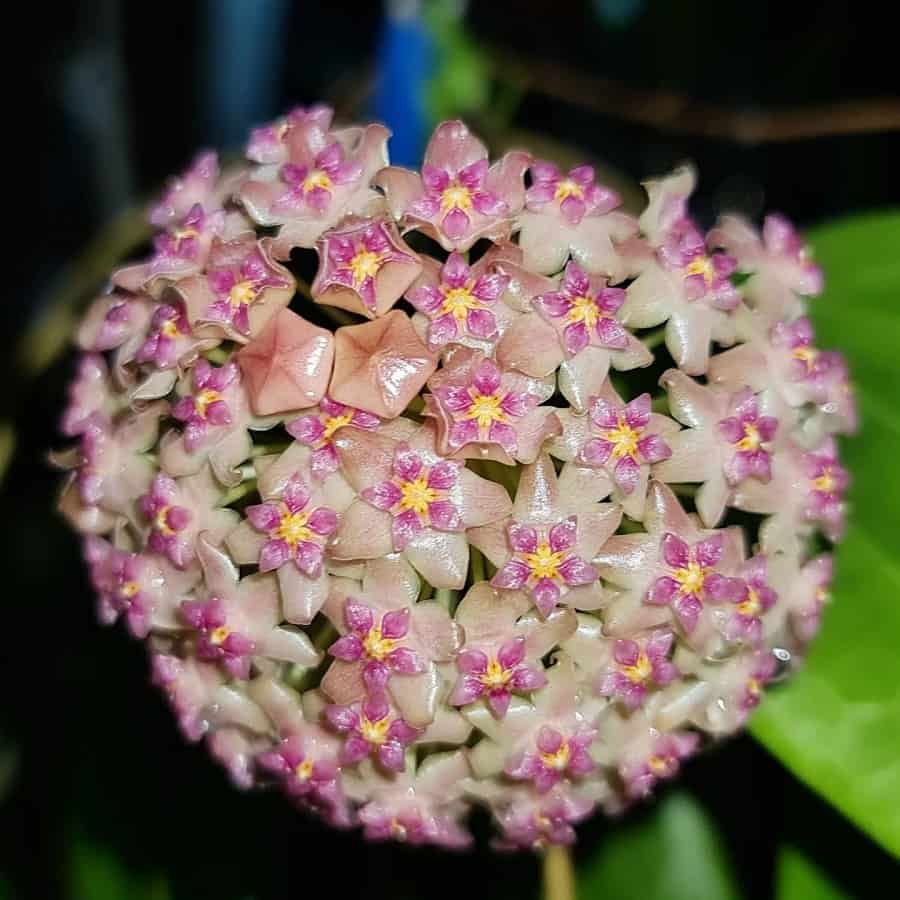
Hoya polystachya is an eye-catching plant with curly, smooth scourges that make it stand out. Its leaves are broadly oval or oblong-oval with a pointed tip and rounded or slightly heart-shaped base, with thick and fleshy leaf plates, and subtle curved edges.
It boasts an unusual flower arrangement, with umbrellas often connected by two or more on a single common peduncle, making it distinct from other related species. Its small flowers have smooth, oval corolla blades with sharp tips, adding to its unique appeal. Found growing in the mountains of Java and Sumatra, Hoya polystachya is a must-have for any plant enthusiast.
Hoya pottsii

Hoya praetorii
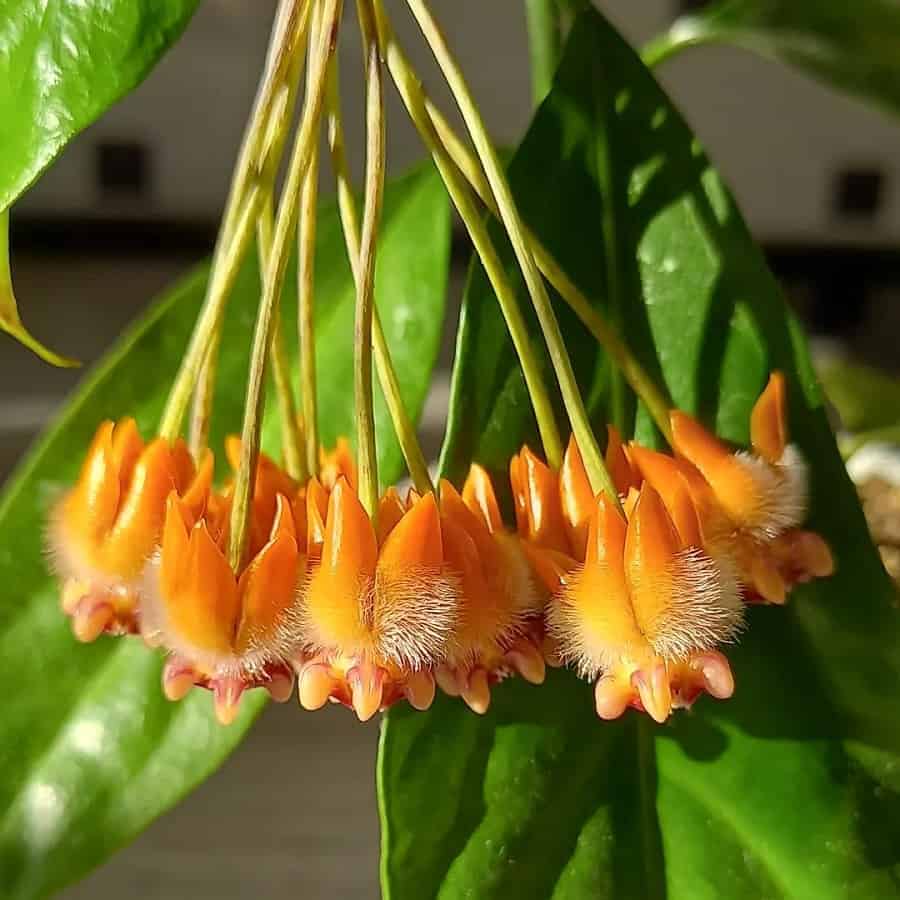
Hoya praetorii is a beautiful and unique epiphytic shrub hailing from Indonesia and named after its collector, C.F.E. Praetorius. It is similar to Hoya lasiantha, but smaller in size, blooms at an early age, and has large, smooth, dark green leaves with occasional silver speckling. The flower umbrellas of Hoya praetorii boast 15-20 bright orange corolla lobes surrounded by thick white hairs, with a beige wine-red crown and a weak aroma. However, this beauty requires more water and fertilizer than other Hoyas and protection from direct sunlight to flourish.
Hoya pseudolittoralis
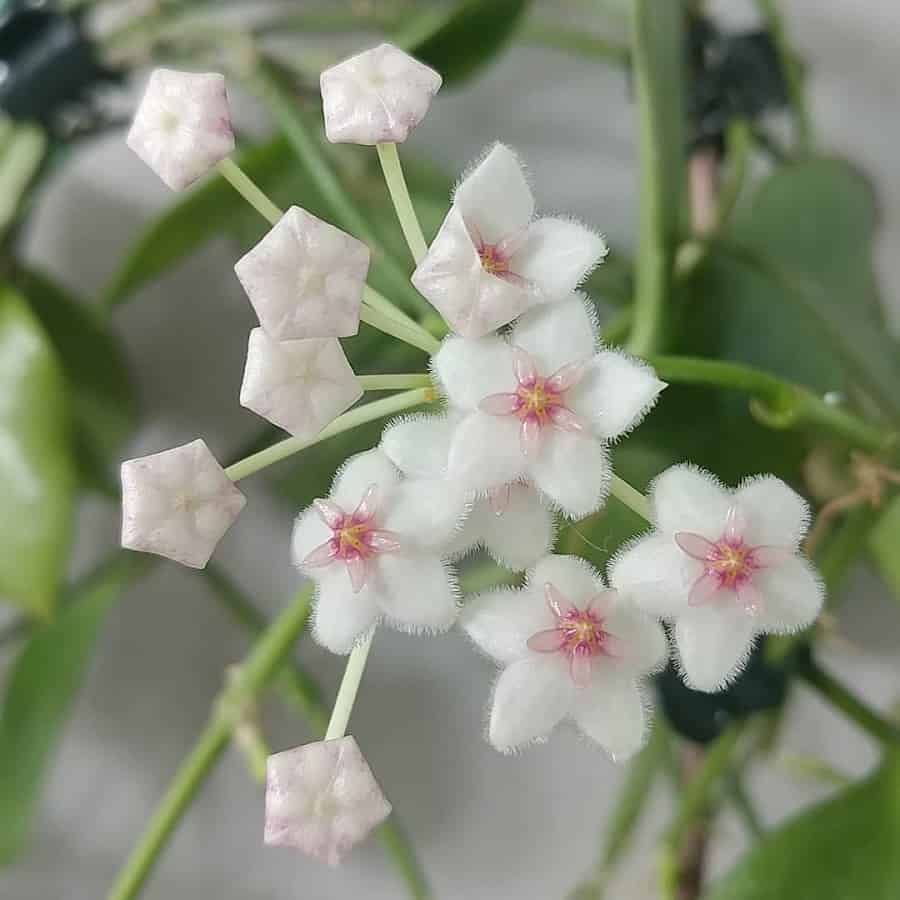
Hoya pubera
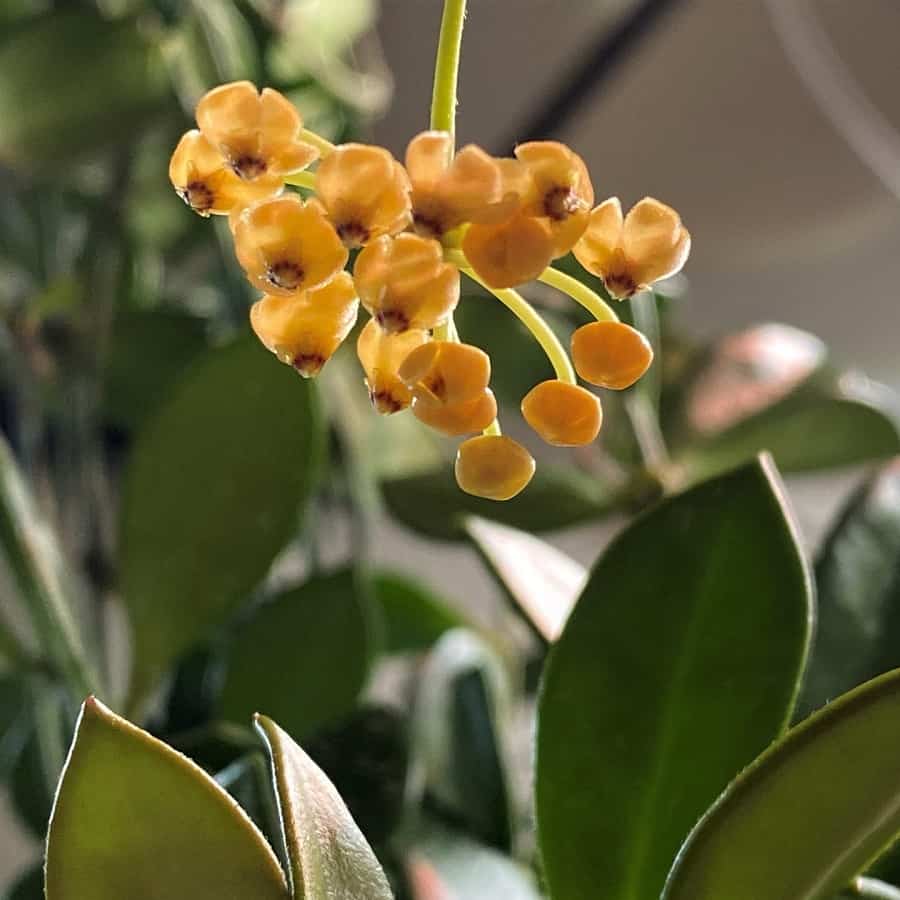
Hoya pubera is a delicate and dainty epiphyte that can creep or climb with grace. Its leaves are light green, either round, lanceolate or elliptical, and are covered in soft hair on both sides, sometimes even smooth. The flower umbrellas, only 2-3 cm in diameter, boast an impressive display of 10-20 flowers, with a diameter of 3.5-5 mm, that range in color from a sunny orange-yellow to a delicate pink. The corolla blades curve back, covered in short hair on the inside, while the crown shines in a cheerful yellow.
Hoya pubicalyx
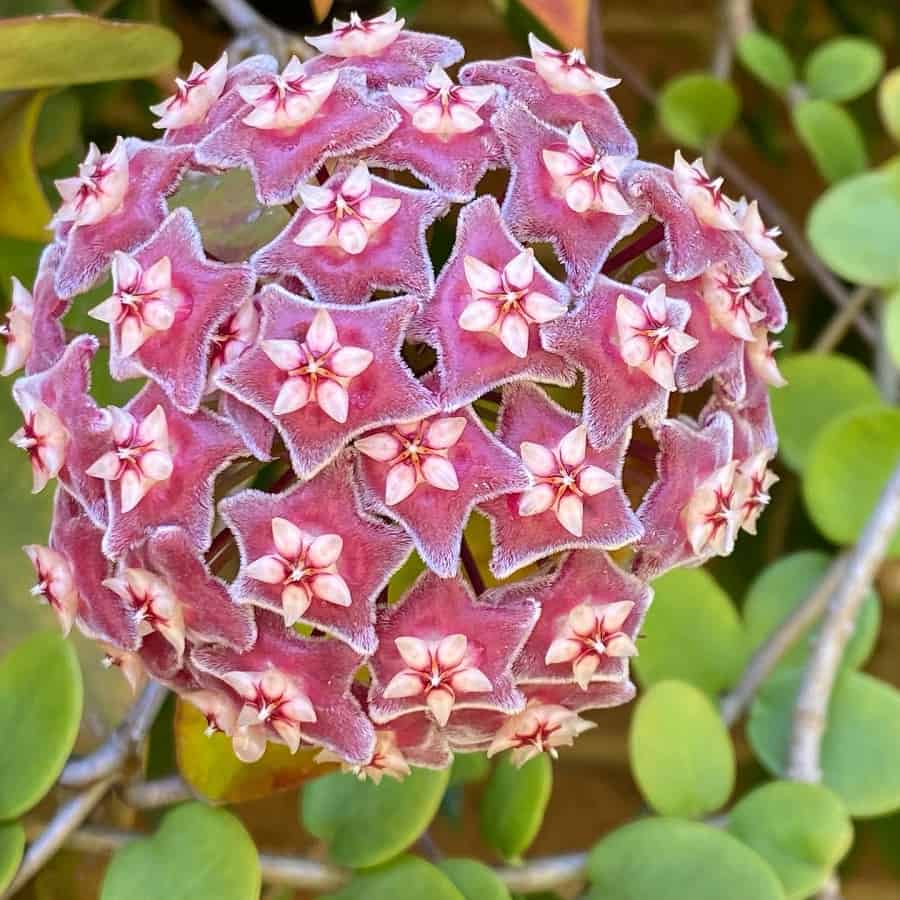
Hoya pubicalyx is a charming, fragrant, and attractive epiphyte with curly, smooth stems that grow up to 20 cm long. The leaves are fleshy, leathery, and smooth, with a distinct pointed apex and indistinct lateral veins. When in bloom, the plant produces stunning flower umbrellas that are 8-9 cm in diameter, with bright purple, triangular corolla lobes and a bright brown, star-shaped crown. The flowers are fragrant and add an enchanting touch to any setting.
Hoya purpureo-fusca

Hoya pusilla

Hoya pusilla is a unique species of hoya plant that is native to Malaysia and is found in the wooded lowlands along Sungai Tahan in Pahang. This plant is a true survivor as it thrives in a symbiotic relationship with ants who build their nests among its roots. This tiny plant is full of surprises, with its thin stems and leaves that resemble Hoya lacunosa.
The petite floral umbel has a concave shape and consists of 1 to 30 fragrant flowers that last 4 days and are white or pale pink in color. The corolla of the flower is smooth with a ring of sparse long hairs inside the base of its lobes, and the crown is small and blunt with an upper lobe that is pink or red and a lower lobe that is white.
Hoya quinquenervia
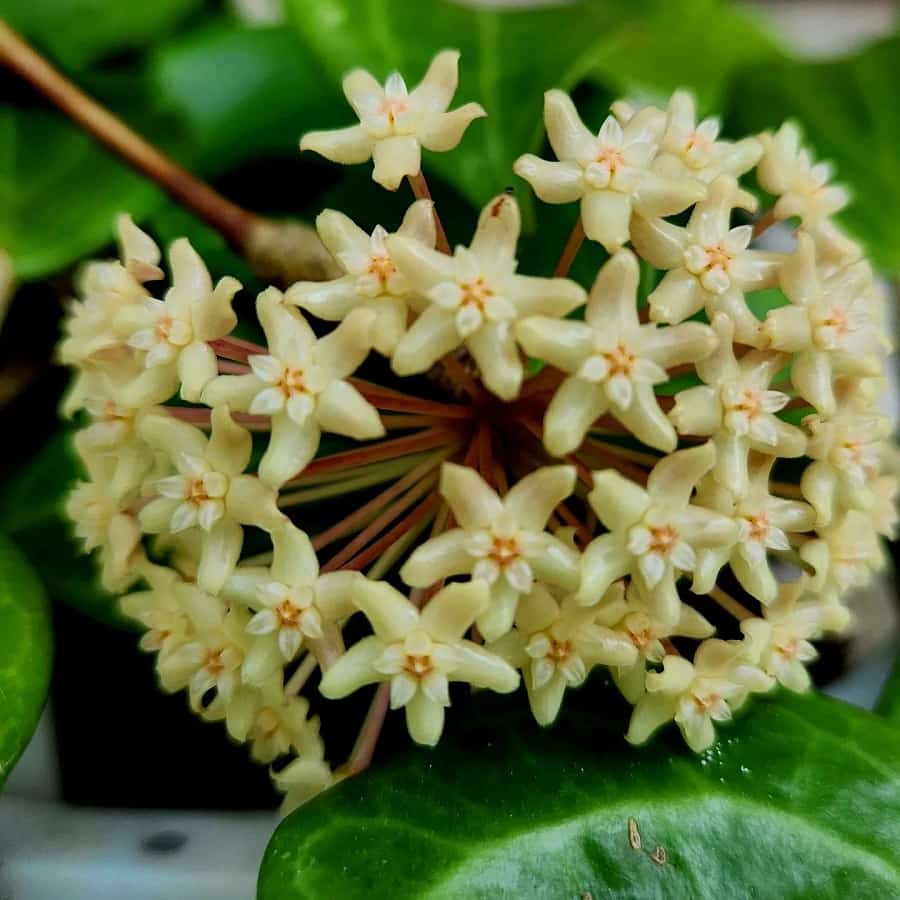
Hoya quinquenervia is an exceptional epiphytic vine that boasts glossy, waxy foliage with a purplish hue in new growth. Its leaves have a slight waviness, rounded base, and a short, pointed tip, with five main veins visible on the surface. This unique hoya variety is renowned for its yellow flowers with delicate pubescence inside the corolla, and a white crown.
A standout feature of Hoya quinquenervia is its horizontal corolla lobes, which distinguish it from other yellow-flowered hoyas. This easy-flowering plant thrives in mid-elevations with good watering and a loose, well-drained substrate. A well-foliated, unstretched internoded Hoya quinquenervia, with its attractive foliage and large clusters of yellow flowers, will make a stunning addition to any hoya collection.
Hoya retusa
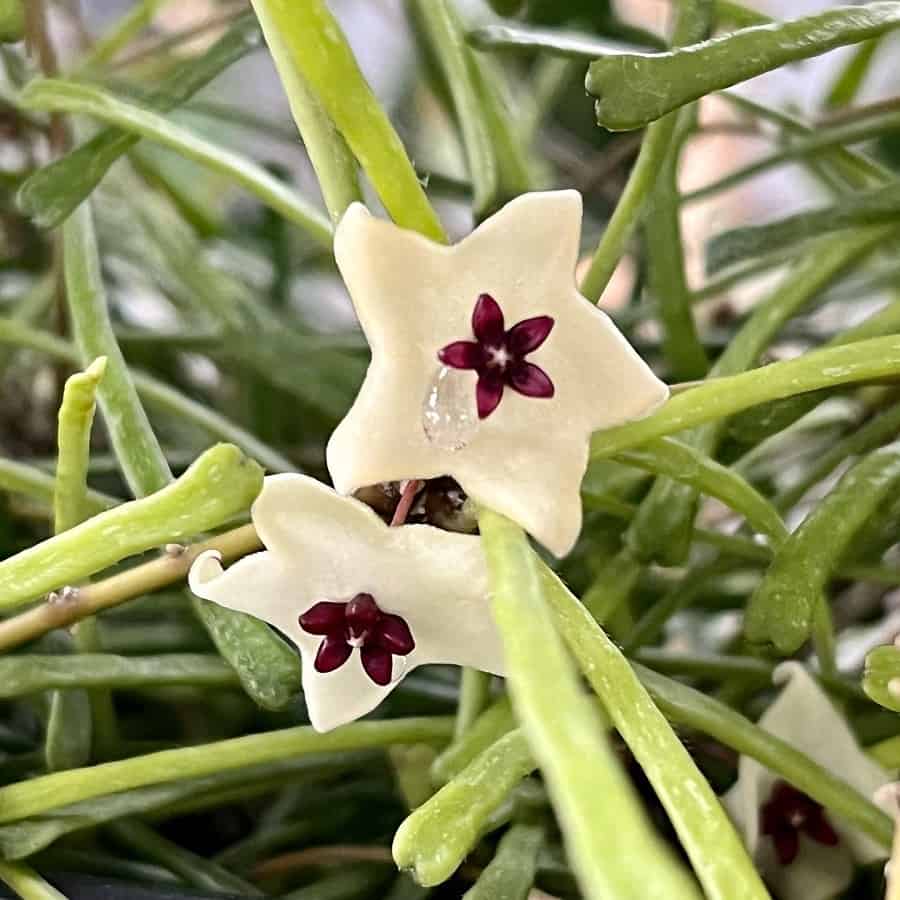
Hoya retusa is a stunning epiphytic vine that captivates with its delicate appearance and easy-going nature. Its thin, light green leaves are slightly folded along the outer edge and its stems are adorned with thin, round, green stems that turn gray with age. This hoya is related to Hoya pauciflora, and produces single star-shaped white flowers that are accented by a crown with a diameter of 5mm, which varies in shade from pink to dark pink.
The corolla is velvety pubescent with hairs and has triangular, sharp tips. Hoya retusa is not demanding, growing quickly and branching well to form clusters of leaves that hang in a cascading formation. With its quick growth, Hoya retusa can be shaped into a beautiful and fluffy plant in no time, and is a great addition to any hoya collection.
Hoya revolubilis
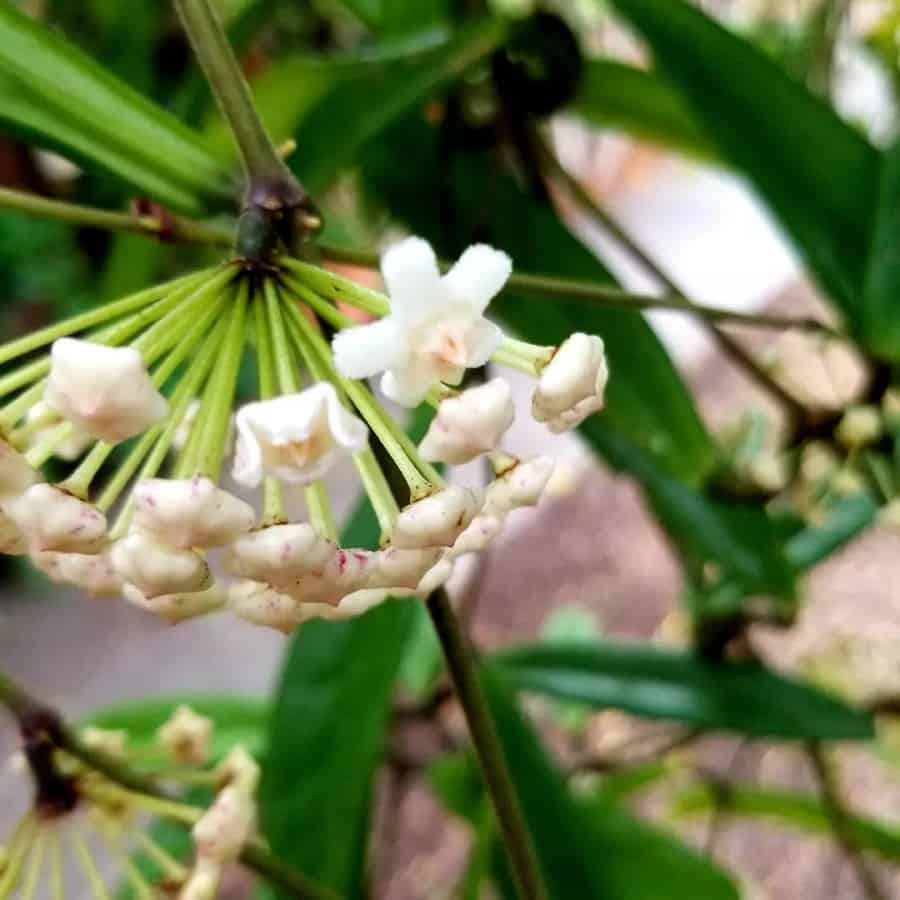
Hoya revoluta

Hoya rigida

Hoya rigida is a magnificent plant native to Thailand that will definitely make a statement in your collection. With its large size and lush, dark green leaves that are leathery, dense, and hard, this hoya is truly a sight to behold. The leaves boast five main veins that fan out from the base and can grow to be 8-23 cm long and 5-13 cm wide.
When in full bloom, the plant produces a breathtaking sight with 20-40 individual flowers, each measuring 1.6 cm in diameter and ranging from light cream to green and light pink. The crown of the flower is mostly white with a pink or red spot in the center, but what sets Hoya rigida apart is its long, narrow sepals that are often visible from the front of the flowers, especially when in the bud stage. And to top it off, this hoya emits a strong, sweet aroma at night during its 5-day blooming period.
Hoya rosita
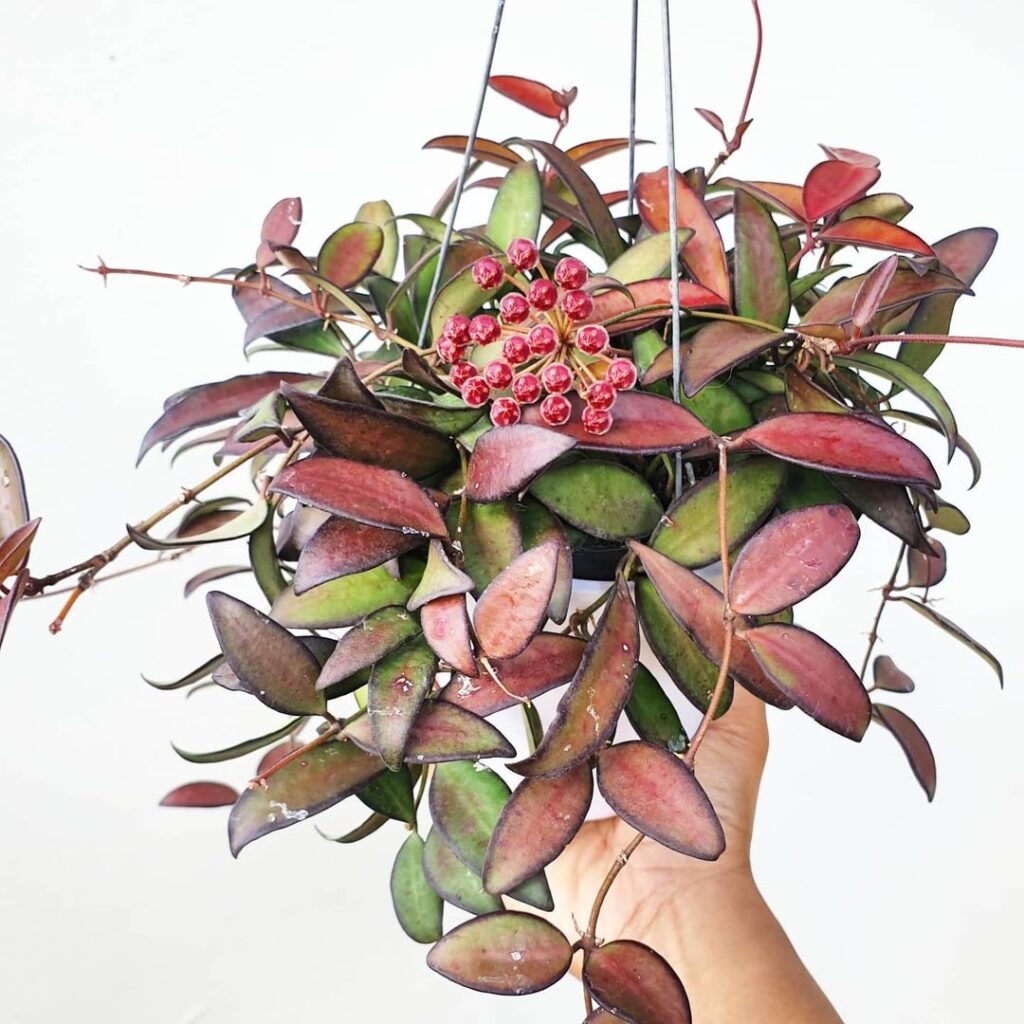
Hoya Rosita is a cross between Hoya wayetii and Hoya tsangii. It has shiny, dark green leaves that can develop a maroon border and turn bronze red in the sun. The plant produces pink flowers resembling small waxy stars that bloom in umbrellas. Hoya Rosita can be grown as a climbing plant or trailing in a hanging basket and may bloom after 4-5 years with proper care.
Hoya rotundiflora
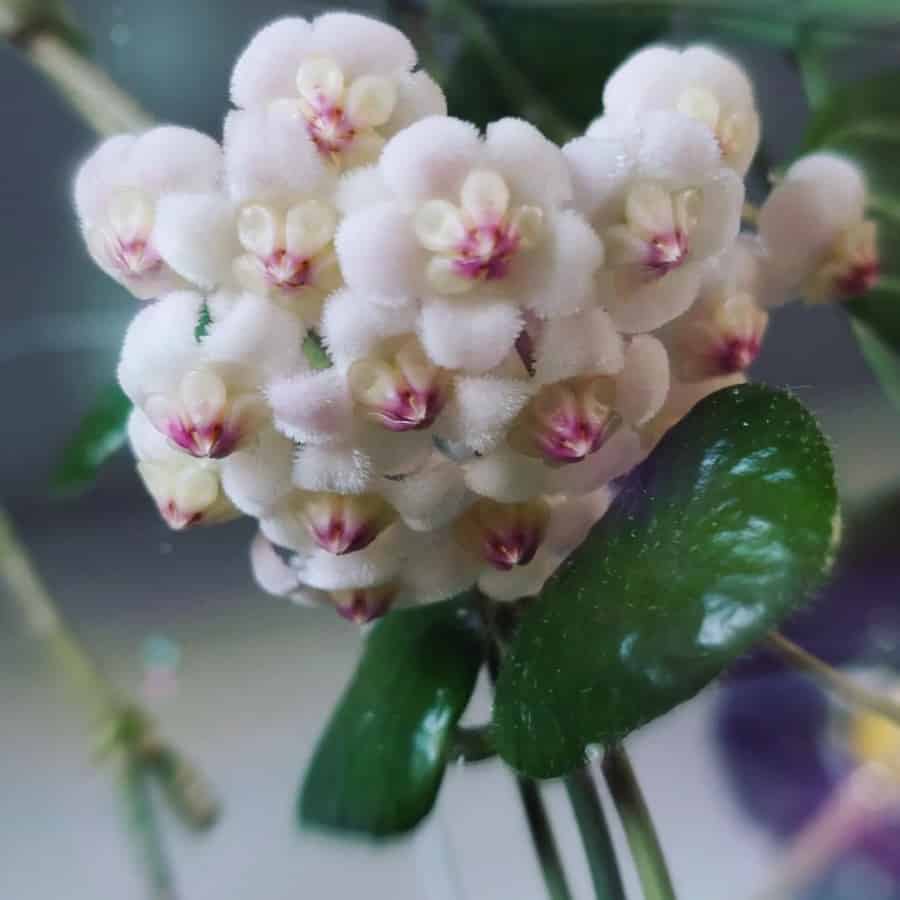
Hoya rotundiflora is a unique and fascinating plant, prized for its delicate beauty. This ampelous hoya has pubescent scourges and oblong-guitar-shaped leaves with a dark green upper surface and a light green lower surface with a darker edge.
The plant opens up to 20 individual flowers with a slight aroma in a flower umbel, with corolla lobes that are white, lanceolate, and papillary pubescent. The crown of the flower is fleshy and creamy white or pale yellow with a dark pink center, adding a pop of color to this already stunning plant. Hoya rotundiflora blooms during the summer months for about a week, making it a beautiful addition to any collection. Despite its delicate appearance, this hoya is hardy and easy to care for, making it a great choice for any gardener.
Hoya rubida
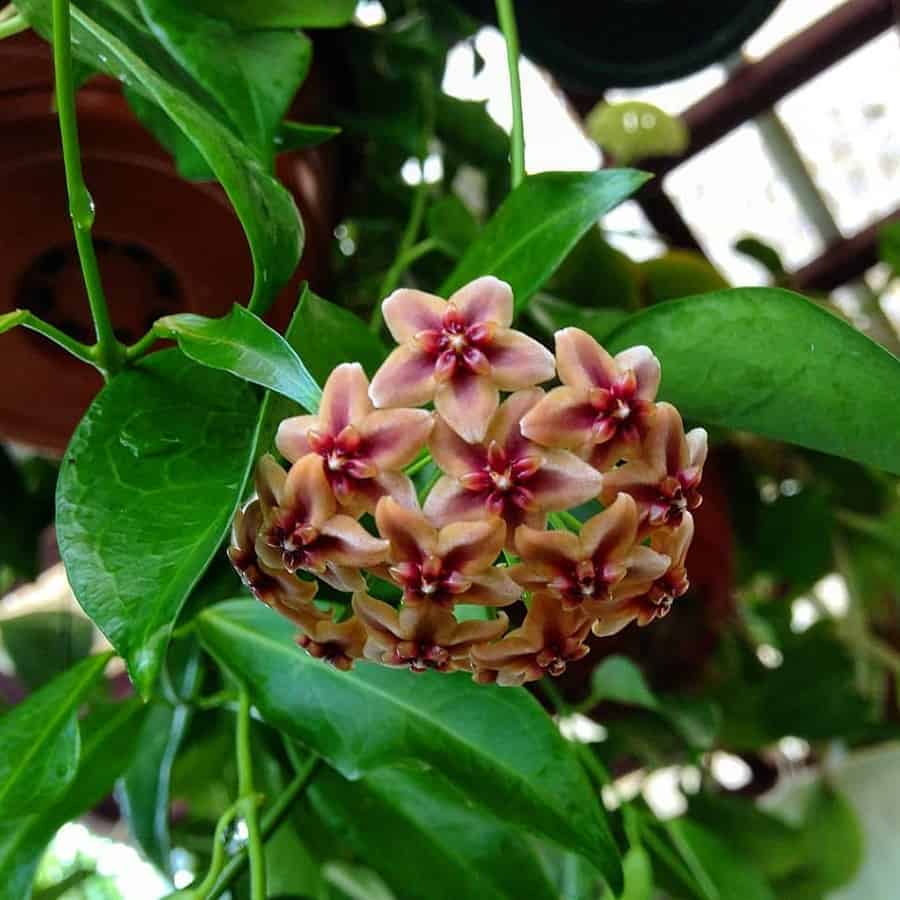
Hoya rubida is a unique and intriguing species of hoya native to the coastal regions of northeastern New Guinea. This climbing epiphyte can be found growing in the trees of the moist mangrove forests, thriving in the salty air and sandy soil of the beach. Its bare, filiform stems make for an interesting contrast with its dark green, ovate leaves, which are glabrous on both sides.
The flowers of Hoya rubida are a real showstopper, with 15-25 individual blooms of 1.2 cm diameter that range in color from burgundy to dark purple, and have a crown to match. With its intricate corolla and bright hues, Hoya rubida is sure to be a captivating addition to any collection of exotic plants.
Hoya ruscifolia
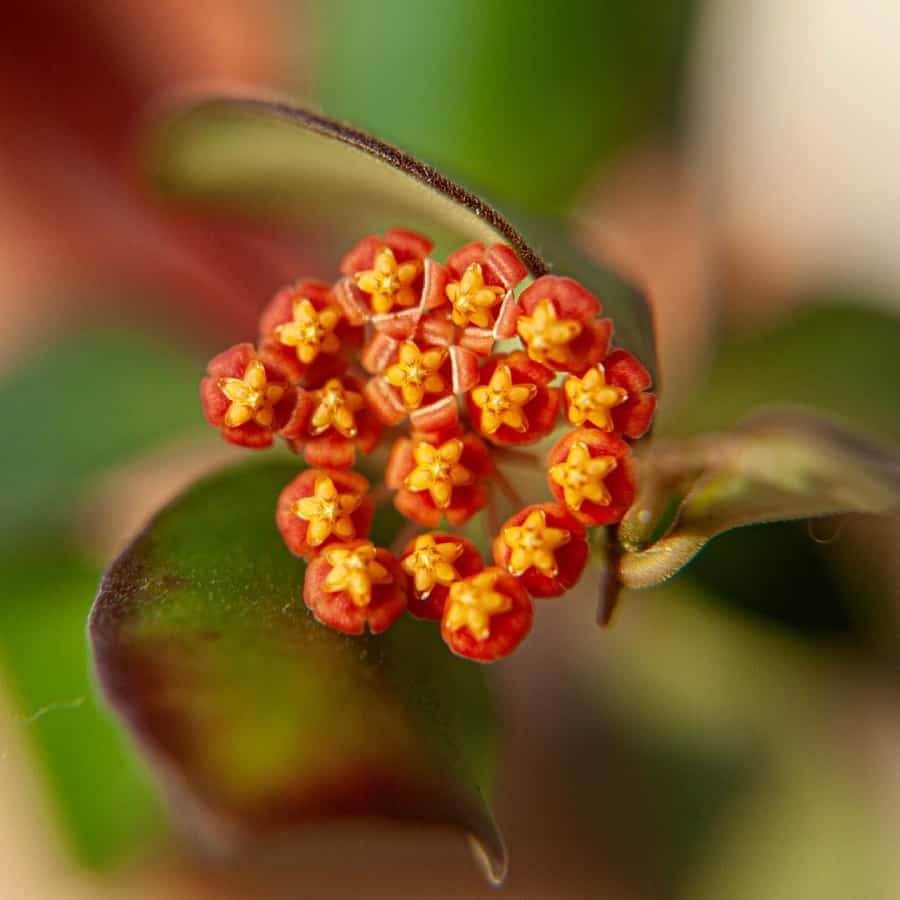
Hoya salweenica

Hoya salweenica, also known as Hoya orogena, is a unique climbing epiphytic shrub native to Southeast Asia. With thick stems that can reach up to 2 meters in length, this plant is sure to make a statement. Its leaves are leathery and elliptical, ranging from 10-16 cm in length and 3.5-6 cm in width. The underside of the leaves is slightly paler than the upper side, which is dull green in color.
In September, Hoya salweenica produces milky white flowers that are pubescent on the inside, with a diameter of about 1.5 cm. The plant’s peduncle is about 5 cm and its pedicel is about 4 cm. This stunning species is not to be missed!
Hoya samoensis
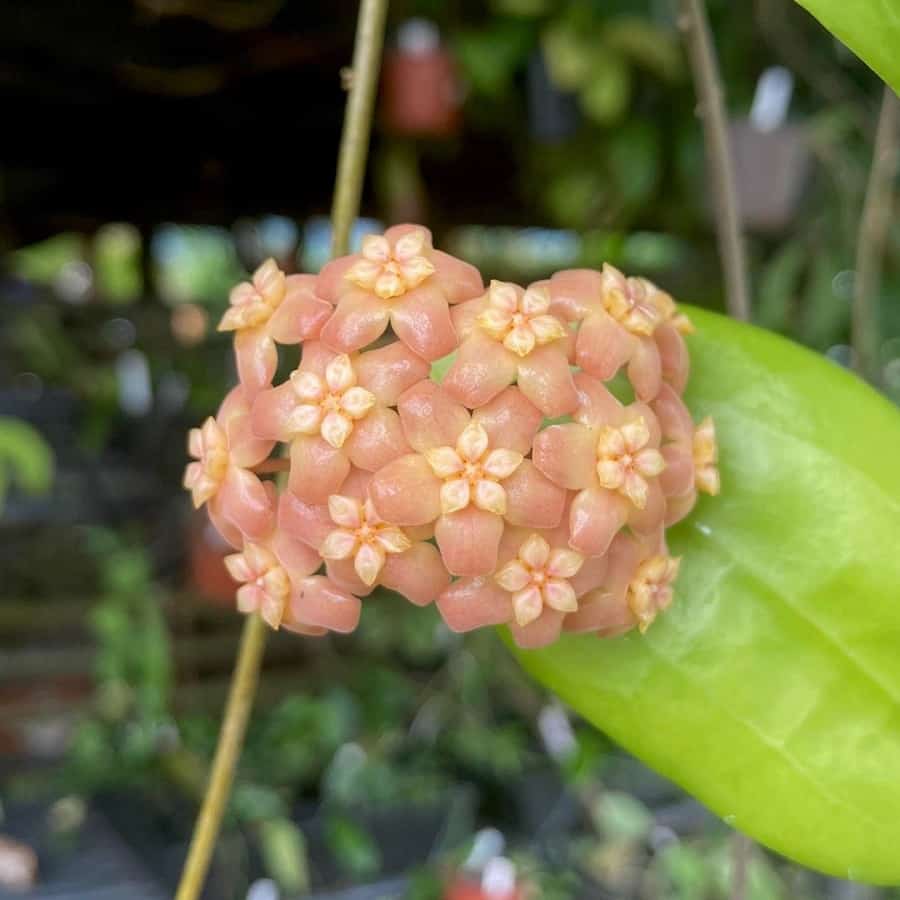
Hoya sammannaniana
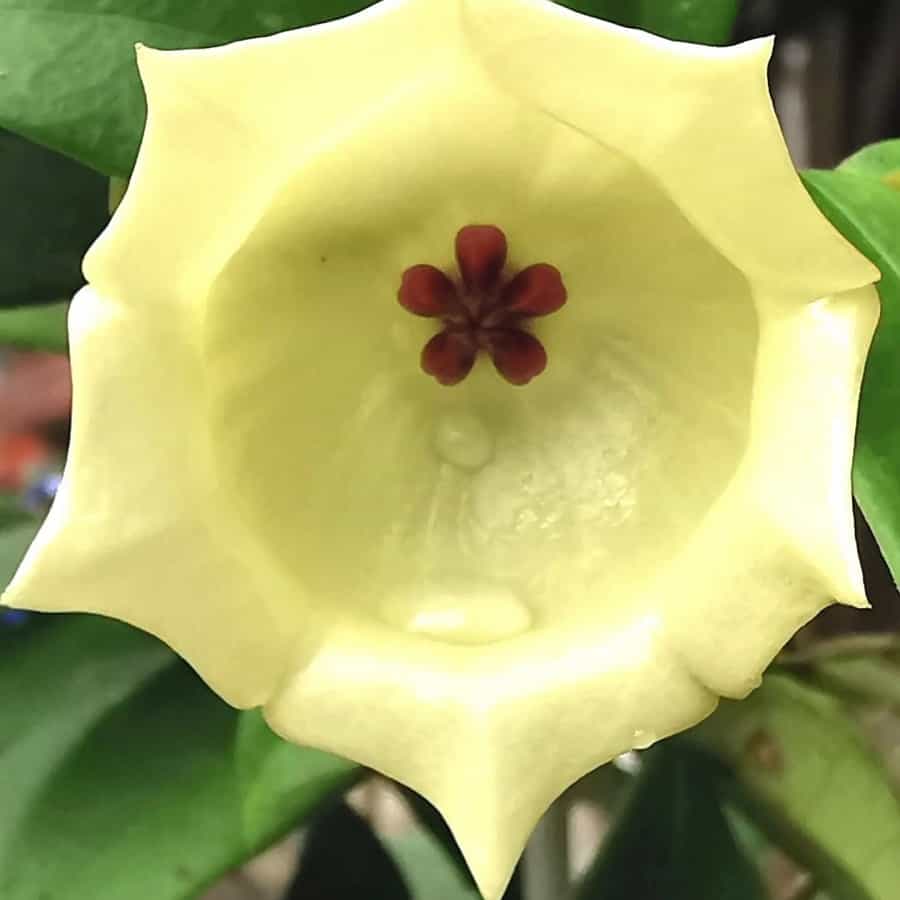
Hoya sammannaniana is a unique and fascinating species of hoya that can grow either as an epiphyte or on the ground, reaching up to 5 meters tall. Its stems are smooth, green with purple spots, and produce aerial roots to help it climb. Its leaves are dark green on top and light green underneath, and its pedicels are green and smooth.
When it blooms, it produces one to two slightly fragrant, hanging, pale cream to very pale yellow flowers with scattered pink spots, and a greenish-cream and dark purple crown. The flowers are bell-shaped, with a bell-shaped base and fused lobes that turn downward during the day and bend outward at the edges. The entire plant has milky juice and flowering lasts for just one day.
Hoya sangguensis
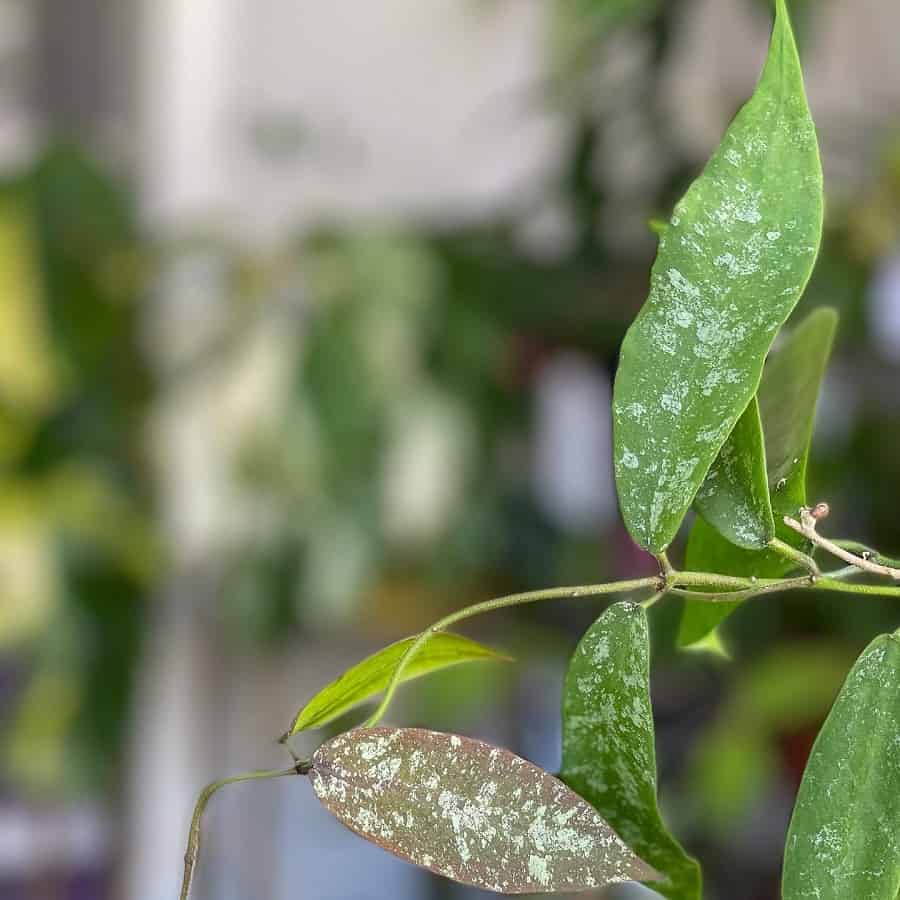
Hoya sangguensis is a captivating epiphyte with a unique appearance. With its white or yellowish latex sap and slender stems, it’s a plant that’s sure to turn heads. The stems are cylindrical, and they become smoother and grayer as they mature. Hoya sangguensis also boasts an abundance of adventitious roots that grow throughout the stem. The leaf petioles are round and green or purple in color, while the leaf blades are elliptical and medium green, with pinnate venation.
The inflorescence consists of a range of 2 to 10 beautiful, creamy white or pale pink-green flowers with red crowns. The floral corolla is shallowly bell-shaped to slightly recurved and the lobes are covered in dense white hairs. Hoya sangguensis is a plant that truly showcases the beauty of epiphytes.
Hoya Sarawak
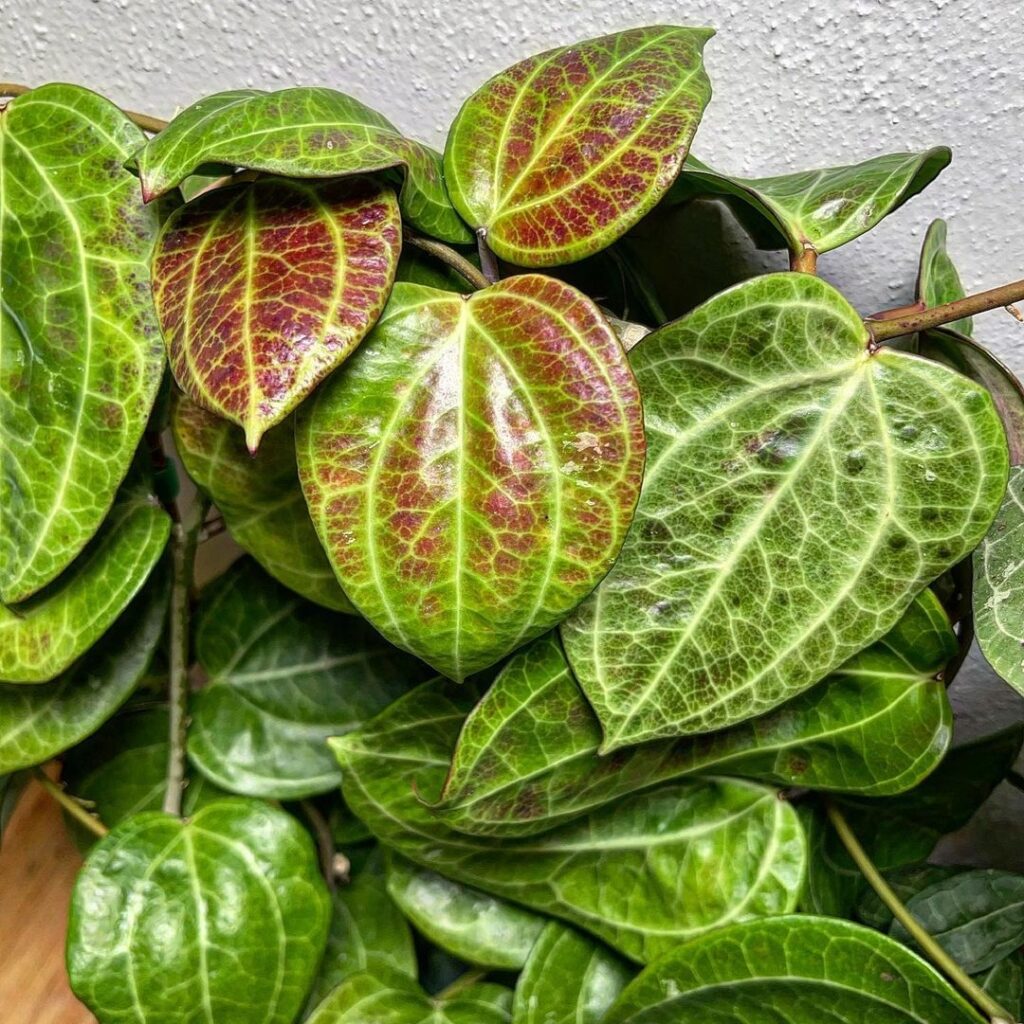
The Hoya Sarawak is known for its large, round foliage and beautiful pink flowers. The leaves feature pronounced veins that can develop a hint of red when exposed to more light, adding to its visual appeal.
Hoya schneei

Hoya schneei is a stunning, epiphytic or semi-epiphytic climbing shrub that can grow up to 6 meters long with flexible, round, and hairless branches. The leaves of Hoya schneei are large and leathery, with an elliptical shape, pointed tip, and a wedge-shaped base. The flower corolla is the star of this hoya, with its white wheel-shaped appearance and petals that measure about 9 mm from base to tip. The corolla is about 1.7 – 1.8 cm in diameter and the blades of the crown are approximately 3.5 mm long from tip to center.
Hoya scortechinii
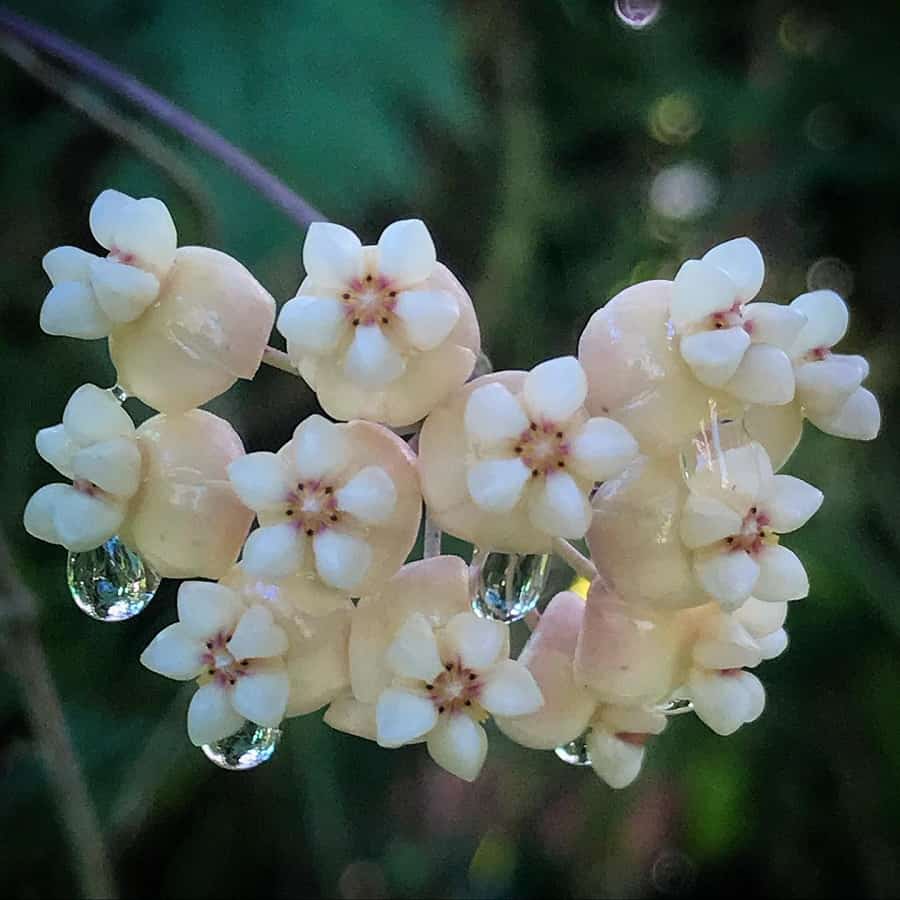
Hoya scortechinii is a climbing liana with long and thin, yet flexible stems that can reach up to 5 meters in length. This plant can grow either on the ground or as an epiphyte, and has adventitious roots that form along its entire length. In culture, it can be grown on a support and is easy to care for. The leaves are light green, silky, oval-shaped with pointed tips and a blunt base, and have a pinnate venation.
The peduncles grow upward against gravity and bear 5-20 flowers in a flower umbrella with a diameter of 3-5 cm. The corolla lobes are off-white or pale yellow with a slight lilac tint and form a ball-like flower with a diameter of 1.4 cm when unfolded. The crown is white, cream, or pale yellow and flowering lasts for 4-5 days.
Hoya serpens
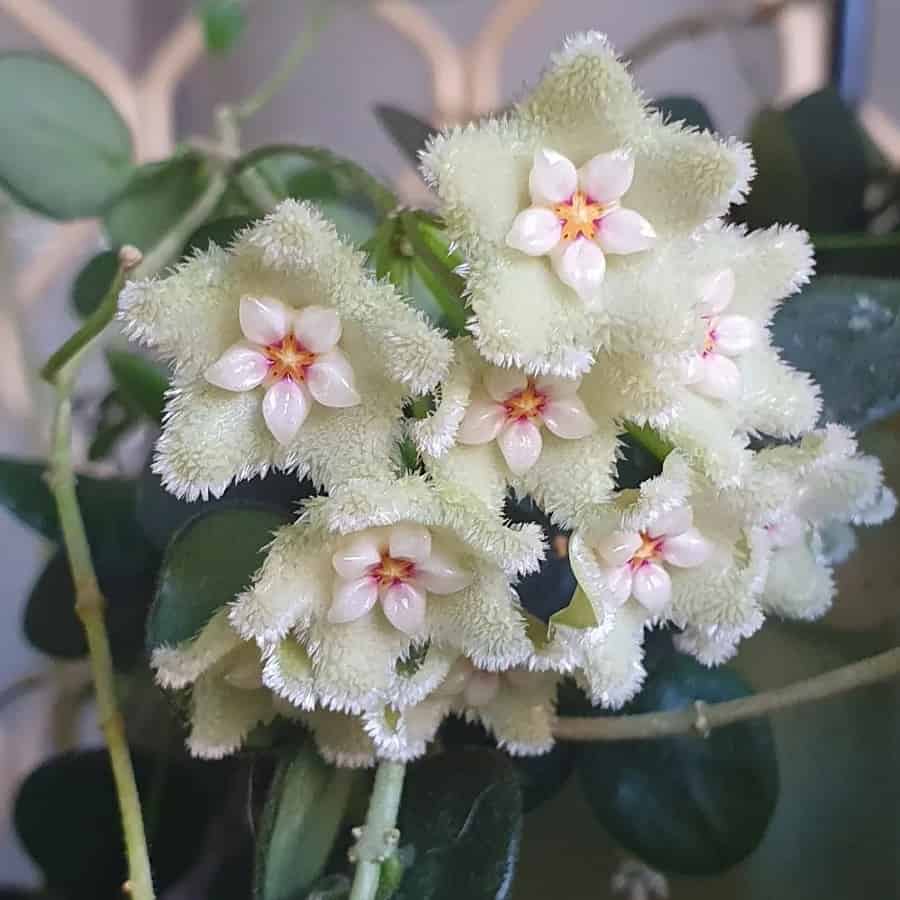
Hoya serpens, also known as the “creeping hoya,” is a unique species known for its way of growing. Instead of growing upright, it prefers to cling to surfaces using adventitious roots formed at the nodes on its thin and wiry stems. With leaves varying in shape and having a dull surface with short hairs, this hoya also showcases a stunning display of 10-15 light green pubescent flowers, each with a diameter of 1.5 cm and a white crown with a red center. However, Hoya serpens can be a challenge to cultivate as it thrives in cool, humid conditions with a decrease in temperature at night.
Hoya shepherdii
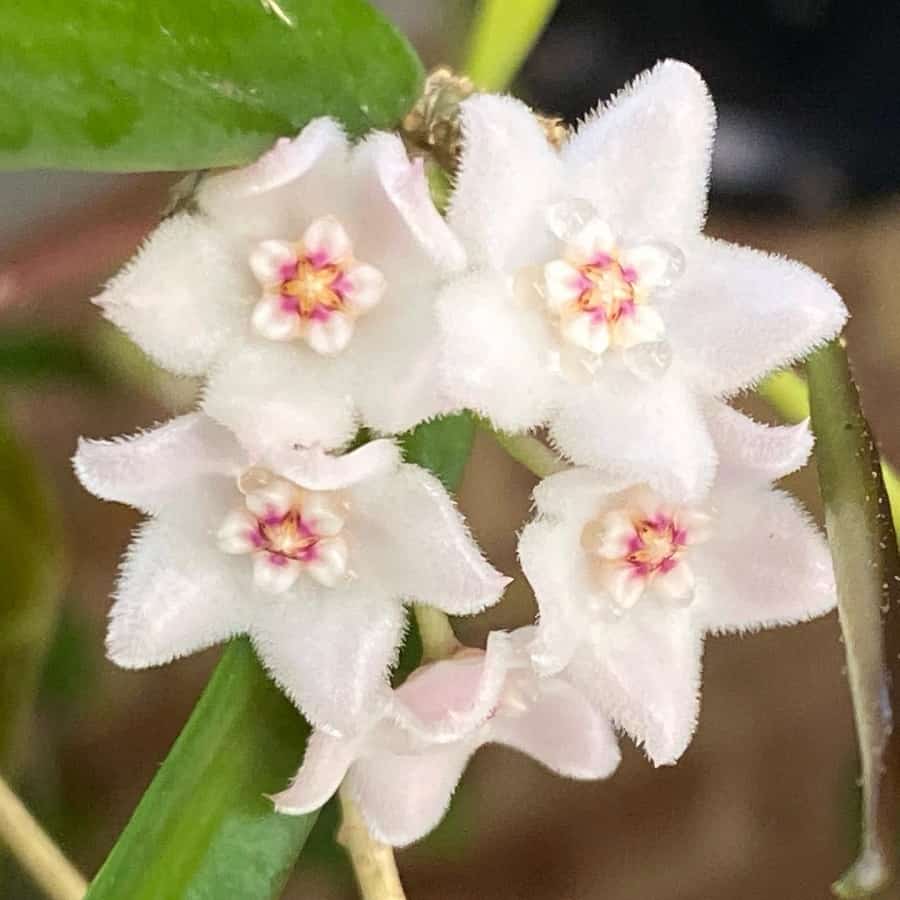
Hoya shepherdii is a unique and fascinating hoya species known for its thin and drooping stems, succulent and dark green leaves that resemble hanging beans, and compact flower umbrellas. Its flowers are flat, pubescent and white with a pale pink tint and a strong aroma.
The blooms are easy to encourage by placing the plant in a cool area and can bloom tirelessly, forming buds on the same peduncles. With its distinctive growth habit and stunning blooms, Hoya shepherdii is a fascinating plant to cultivate for any hoya enthusiast.
Hoya siamica
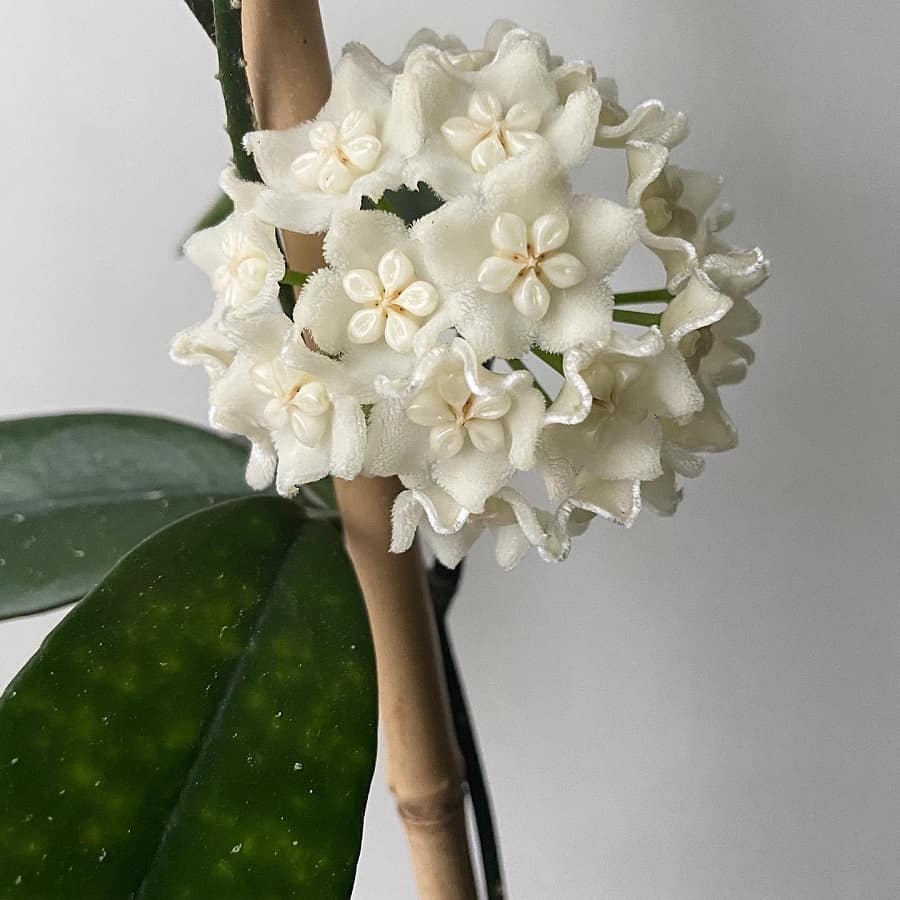
Hoya siamica is an exotic, epiphytic liana with long, smooth and fleshy leaves that can reach up to 1.5 m in length. With bare petioles, the leaves are 4-10 cm long and 1.5-2 cm wide and they become leathery when dry. This beautiful Hoya blooms with delicate white flowers, measuring 1.5 cm in diameter, that open in clusters and last for about 7 days. The corolla and crown are creamy white, and the corolla lobes have a pubescent inner side and smooth outer side.
Although nectar is not released, Hoya siamica has a slight sweet aroma during its summer blooming season. This species is closely related to Hoya longifolia and requires the right conditions for optimal growth.
Hoya sigillatis

Hoya sigillatis is a charming and unique liana, with its profuse branching and delicate stems. Its leaves are shaped like an oval, with a rounded base and a sharp tip, adorned with random silvery spots. The peduncles are sturdy and remain attached to the plant even after flowering, and the small (0.8 cm) flowers bloom in clusters of 15-20.
The corollas of the flowers are distinctive, as they are bent backwards in their fully open state, and they have no scent. Overall, Hoya sigillatis adds a touch of elegance to any space with its unique appearance.
Hoya sipitangensis

Hoya sipitangensis is a remarkable and effortless-to-grow epiphyte, known for its larger foliage and flowers compared to its relative Hoya lacunosa. This hoya boasts green leaves speckled with silver and blooms profusely with up to 30 pinkish-white pubescent corolla lobes. The crown of the flower is pinkish-red and has a weak aroma, while the flowers are turned back and have a diameter of 0.9 cm when fully opened.
This hoya is similar to Hoya walliniana, but with larger flowers. It grows quickly and blooms at an early age, almost continuously like Hoya lacunosa. It thrives in a well-drained soil and can tolerate some drying, but performs best with regular watering.
Hoya soidaoensis

Hoya soidaoensis is a lively, branching epiphyte that grows with ease and produces bright green, silky leaves. Its unique feature is its geotrophic inflorescence, which means the flowers grow downward. With long pedicels and star-shaped flowers, this Hoya boasts a stunning display of yellow-green petals with long white hairs and a pink center. With a light cinnamon fragrance and continuous blooming from a young age, Hoya soidaoensis is a joy to cultivate, thriving in consistently moist soil but tolerating short periods of drying.
Hoya solaniflora
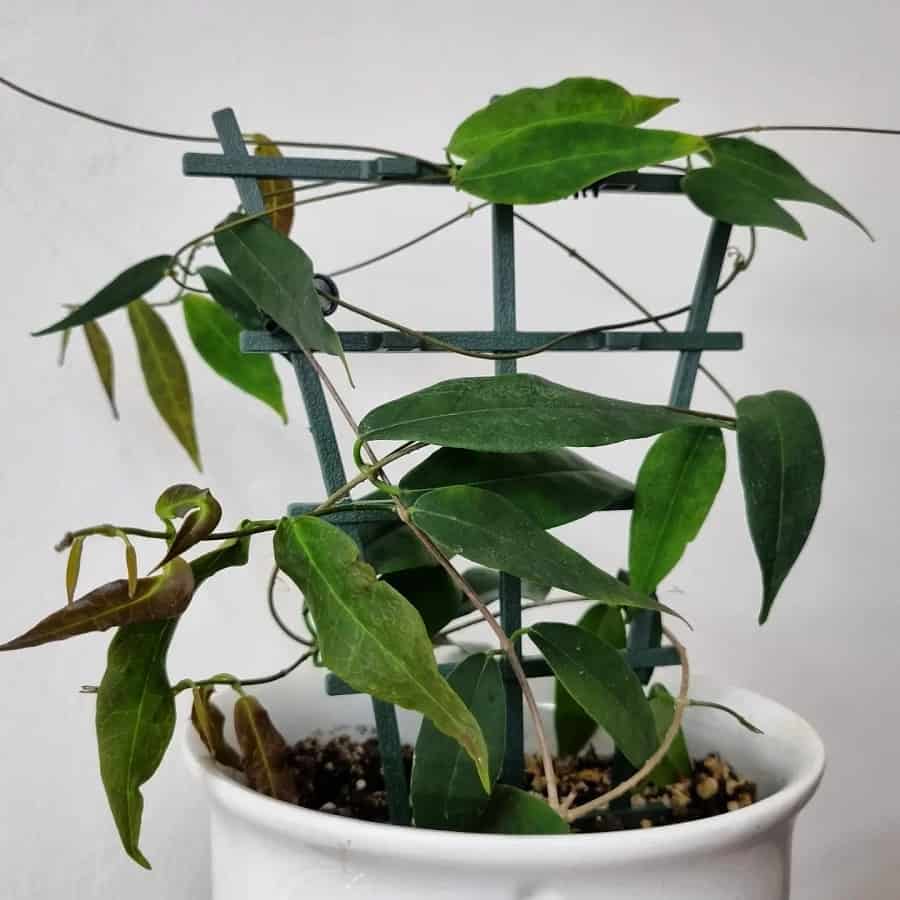
Hoya solaniflora is a remarkable epiphytic plant with delicate and flexible branches. Its leaves are thin and smooth, with a sharp tip and distinct central vein, giving it an elegant appearance. During blooming season, it transforms into a stunning display of 10-15 individual creamy white flowers, each with a diameter of 2 cm and a light yellow crown featuring an eye-catching orange-yellow spot. With its delicate beauty and ease of cultivation, Hoya solaniflora is a must-have for any plant enthusiast.
Hoya soligamiana

Hoya soligamiana is a unique epiphytic vine that stands out among its Hoya relatives with its long peduncles and larger flowers. This plant boasts waxy leaves with five fanning veins and smooth, leathery texture. When in bloom, Hoya soligamiana showcases its stunning yellow-beige and pink flowers that open in an umbrella of 8 to 20 blooms. With a flowering period that lasts just 1 to 2 days, it is a treat for any nature lover. In cultivation, it prefers bright, indirect light from an east or west window. With its distinct features, Hoya soligamiana is a must-have for any plant enthusiast.
Hoya solokensis
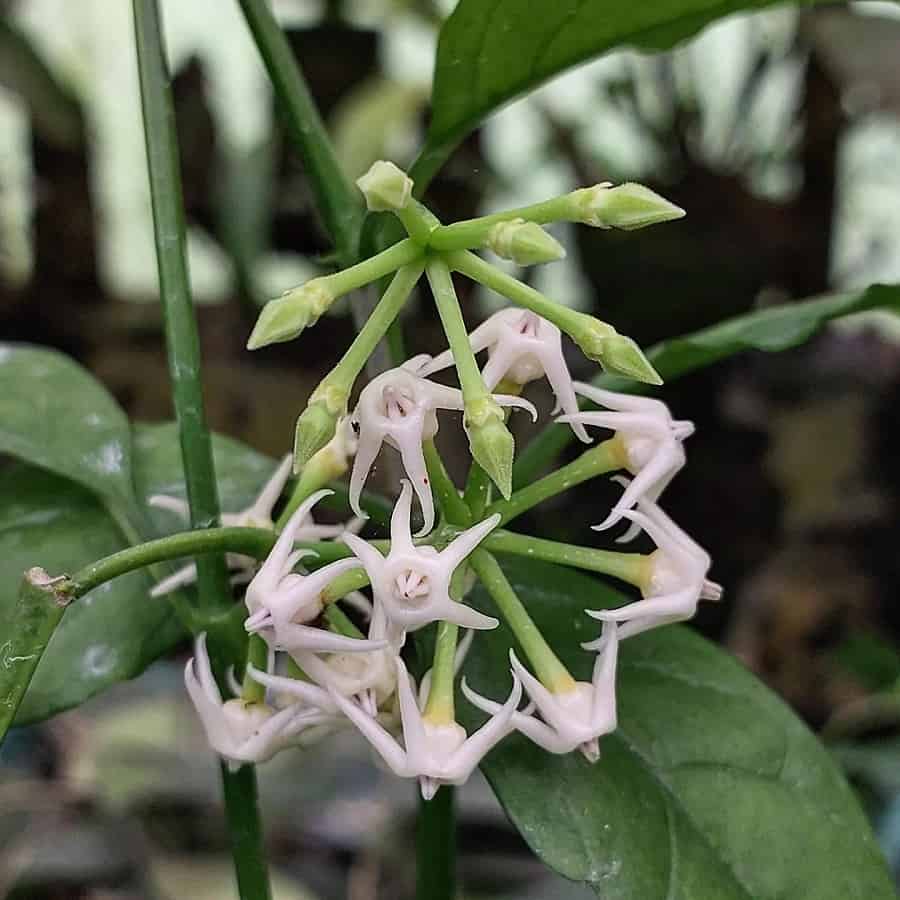
Hoya solokensis is an enigmatic epiphytic shrub that stands out from its climbing cousins. With a distinct white latex sap and an erect or spreading growth habit, this species is an unusual sight in the world of Hoyas. Its leaves are thin, elliptical and medium green, with a slightly depressed upper surface and a convex lower surface.
The inflorescence is subulate, producing from 3 to 10 flowers, with the corolla being tightly covering the lower half of the flower with a short funnel-shaped tube and free lobes. The corolla is white and covered with reticulated hairs inside, and the crown is hard and waxy. With its shrubby habit of growth and short-lived peduncles, Hoya solokensis is similar to Hoya papaschonii, a species found only in southern Thailand.
Hoya sp UT 033
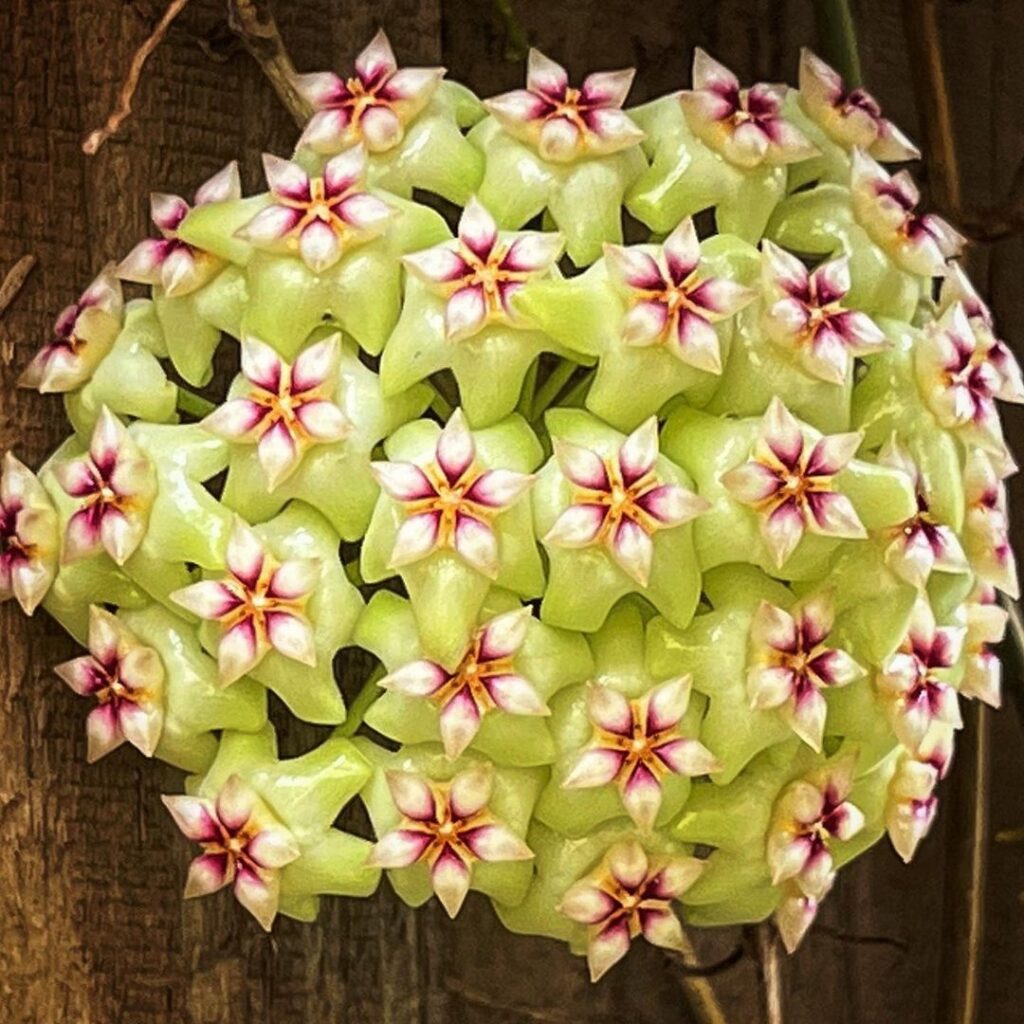
Hoya sp. UT-033 is a twining epiphytic vine from Southeast Asia, known for its elliptical deep green leaves that develop a red hue when sun-stressed. It features large, glossy leaves and produces small flowers with reflexed lime-green corollas and soft pink coronas, emitting a mild, fruity fragrance.
Hoya spartioides
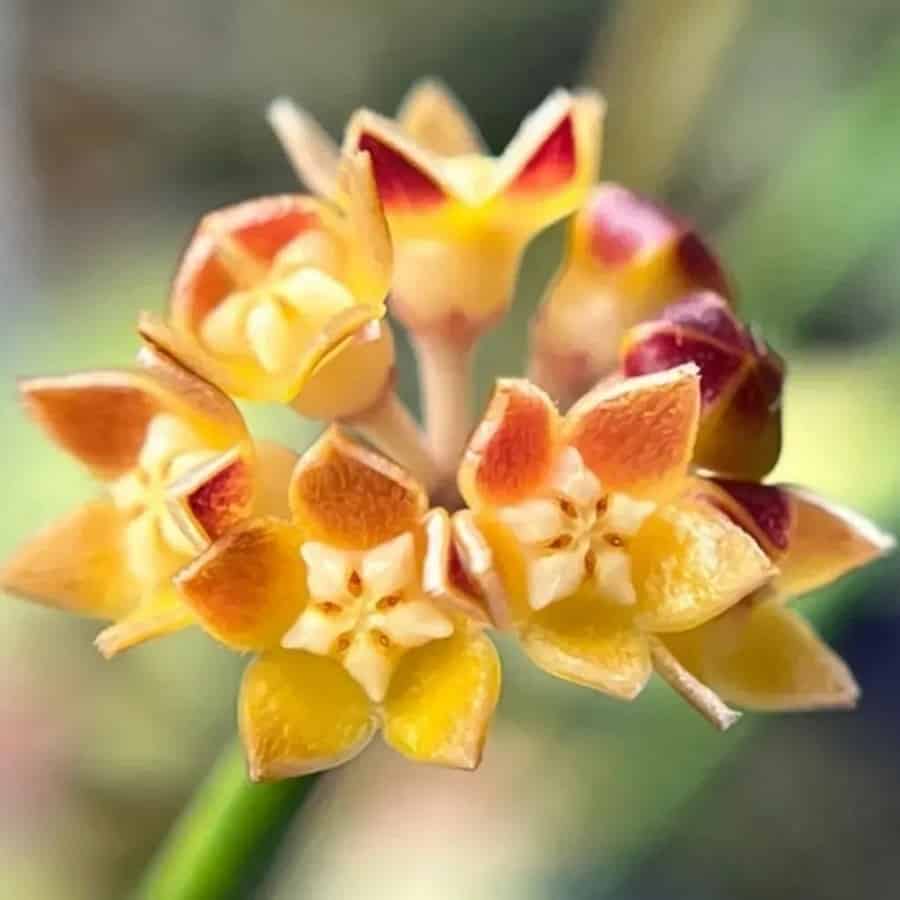
Hoya spartioides is a fascinating plant species found in southern Borneo, Sabah, and Kalimantan regions. With its unusual habitat, this species grows from tree holes where ants deposit its seeds, forming a symbiotic relationship with the ants who protect and provide nutrition to the plant. Despite its rareness in nature, Hoya spartioides thrives through its green stalks that perform photosynthesis instead of its leaves, which quickly fall off.
During the blooming season, it produces vibrant orange flowers with a white crown that only last one night, giving off a unique smell of burnt rubber. Cultivating Hoya spartioides is a challenge due to its demanding needs for light and high humidity, making reproduction a difficult task. Thus, manufacturers are exploring new methods such as micro cloning in test tubes to propagate this fascinating species.
Hoya stenakei

Hoya stenakei is a fascinating species of epiphyte that’s not just a mere houseplant, but a climbing powerhouse! With its luscious, succulent leaves and eye-catching inflorescence, this plant will leave you in awe. Growing up to 10mm in diameter, its cylindrical stems have a dark green hue, and the new growth is slightly pubescent. As it ages, the stem turns into a lignified, leafless structure, with a grayish-brown, glabrous bark that peels away.
The leaves of Hoya stenakei are a standout feature, hanging from petioles and boasting a dark green upper surface, with a light green underside. The venation is pinnate, with secondary veins branching between the central vein and the leaf margin.
When it comes to flowers, Hoya stenakei delivers! Its inflorescence consists of 2-10 individual flowers that are positively geotropic and convex, with pastel pink corollas and a pale creamy yellow center. The fleshy, triangular corolla lobes are dense with pubescence inside, and emit a delightful fragrance reminiscent of Gardenia jasminoides, especially at night. This species may be rare in nature, but its beauty is not to be missed.
Hoya stenophylla

Hoya stenophylla is a stunning epiphytic vine that will leave you breathless with its grace and elegance. It boasts narrow, leathery leaves that are located close together on the stem, with very short petioles of just 2-3 mm. When in full bloom, Hoya stenophylla produces up to 10 delicate flowers on thin pedicels, each with a corolla that has strongly divided blades and a creamy yellow color that turns light pink towards the inner crown.
This species, along with Hoya yvesrocheri, is a unique variety from Papua New Guinea with linear leaves, but the two can be easily distinguished by the uniform coloration of all parts in Hoya yvesrocheri and the width of its leaves. Hoya stenophylla sets itself apart with its simultaneous development of all flowers, a rare trait among Hoya varieties.
Hoya stoneana
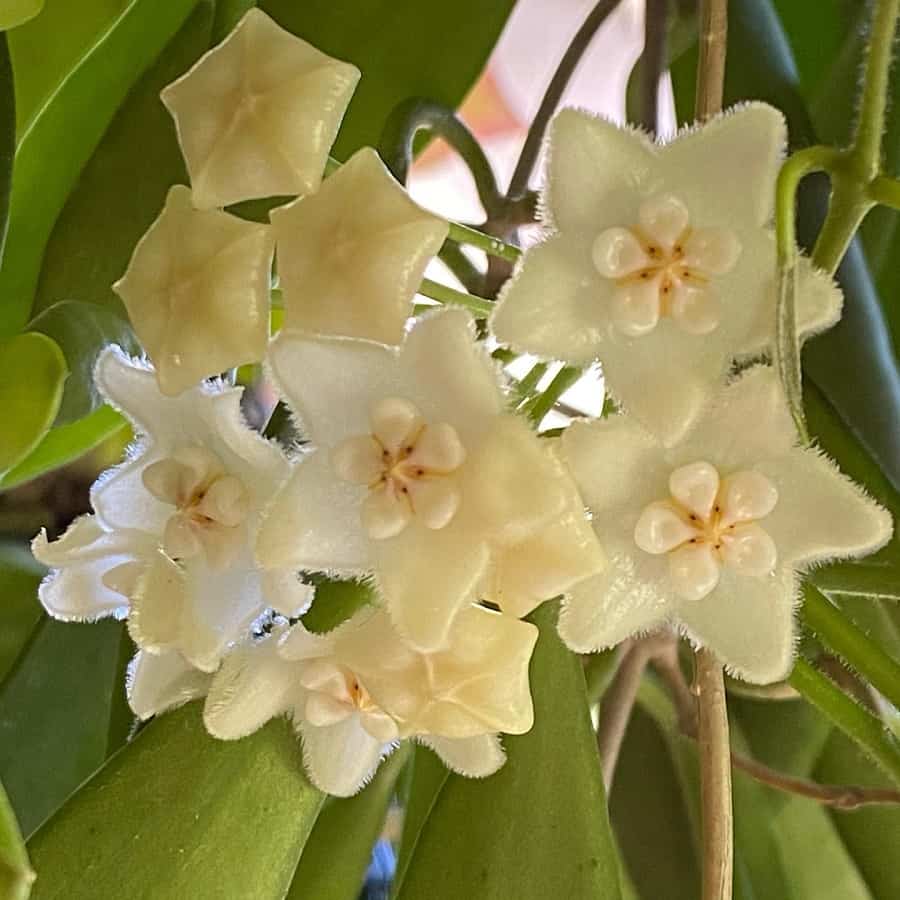
Hoya stoneana is a mysterious epiphyte, previously misclassified as Hoya longifolia (pubescent form). This versatile plant is capable of climbing, but also thrives as an ampel. It is believed to grow at high altitudes due to its preference for cool temperatures.
With its narrow, dark green, shiny and slightly pubescent leaves that can reach up to 12 cm long and 2 cm wide, Hoya stoneana is a visually striking plant. The 10-15 flowers on each umbel are 2 cm in diameter and resemble a combination of Hoya thomsonii and Hoya serpens, with a yellowish-white corolla and white crown. Although the aroma of the flowers is weak and unpleasant, Hoya stoneana is still a unique and fascinating plant to admire.
Hoya subcalva
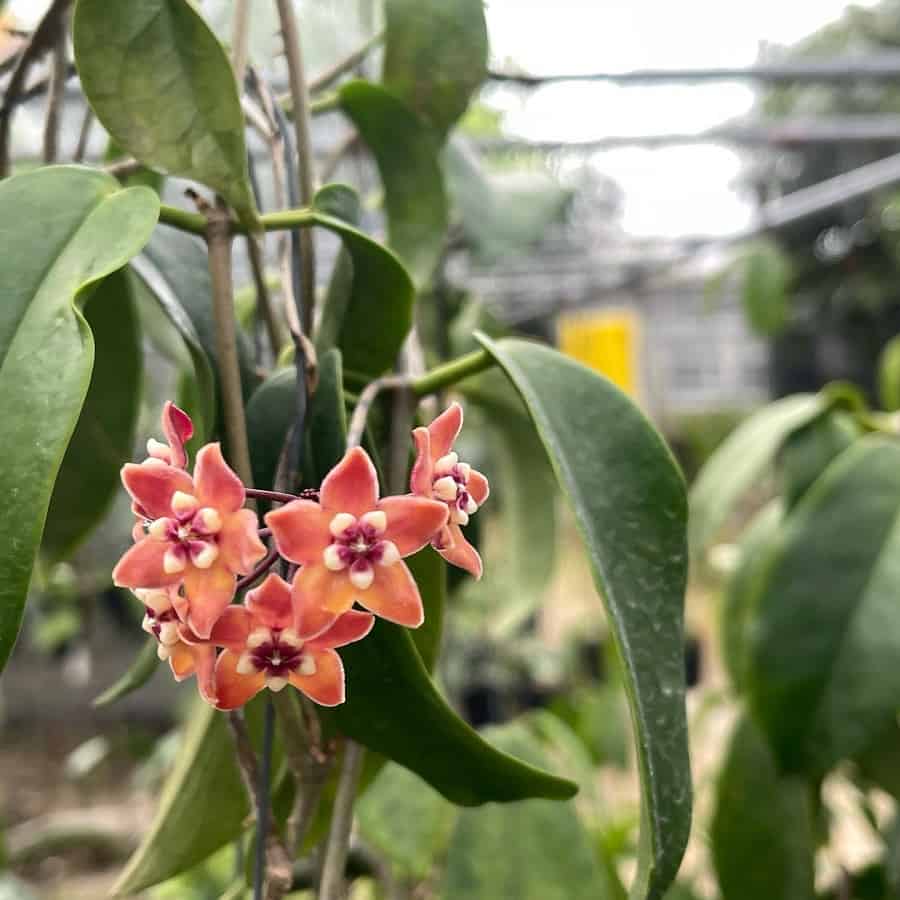
Hoya subcalva is a vibrant and fast-growing climbing vine that adds green mass quickly. With large dark green, glossy, and smooth leaves that can grow up to 19 cm long and 8 cm wide, this plant is sure to make a statement. The plant opens up to 15-20 individual flowers that are up to 3 cm in diameter and have unique corolla lobes that change from pastel apricot to pastel yellow, giving the appearance of a “striped flower”.
The strong, sweet, and spicy aroma adds to the beauty of this plant, making it a perfect addition to a well-lit location, just be sure to keep it out of direct sunlight to avoid leaf scorch. With proper care, including a constantly moist substrate, Hoya subcalva will thrive and bring a touch of beauty to any space.
Hoya subquintuplinervis

Hoya subquintuplinervis is a rare and exotic species from Chiang Mai, northern Thailand that was once distributed under the name “Hoya sp. Chiang Mai.” This elegant and graceful species is a close relative of Hoya pachyclada, and has smooth, fleshy leaves with an oval rounded base and sharp tip.
With 5 visible veins on both sides, this plant is a true gem for collectors, and its rarity only adds to its appeal. Despite its close resemblance to Hoya pachyclada, very little is known about this mysterious plant, making it an intriguing species to study and grow.
Hoya sulawesiana
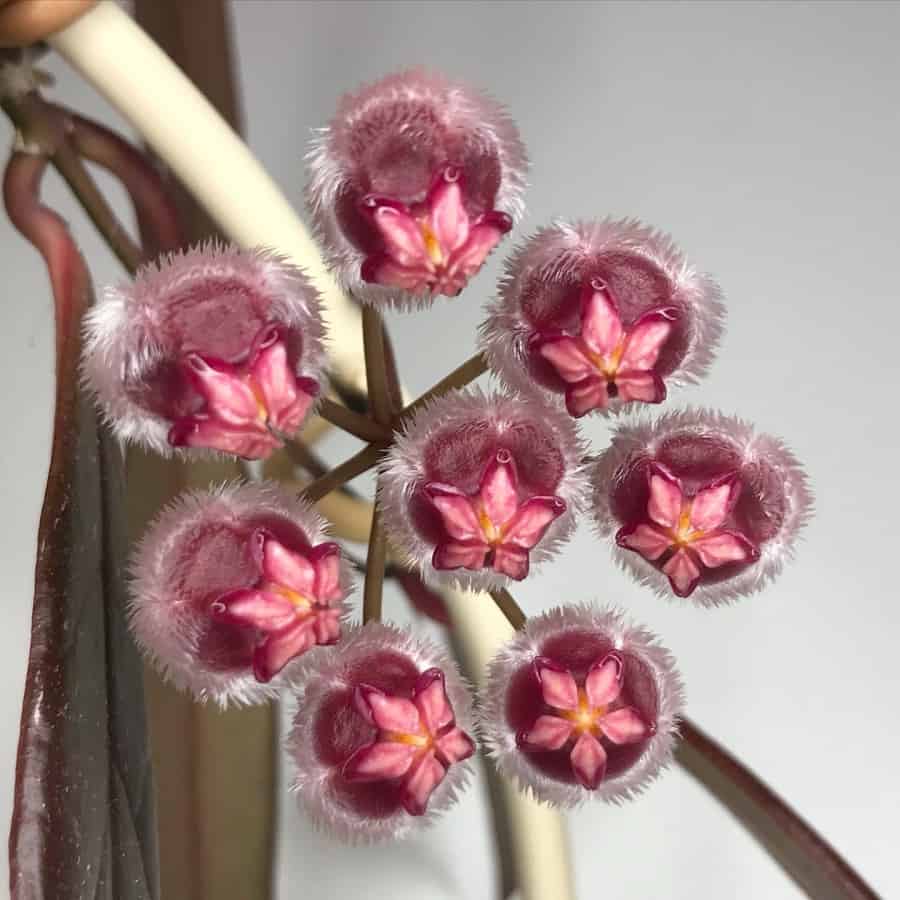
Hoya sulawesiana, hailing from the Indonesian island of Sulawesi, is a unique and captivating plant species. With a distinctive appearance and fascinating growth habits, this epiphytic climber boasts thin yet stiff stems that can reach up to 10 meters long, twisting and creeping on trees and branches. Its leaves are fleshy and come in two distinct types – either lanceolate and hard or elliptical and flat.
The inflorescence of Hoya sulawesiana is positively geotropic and holds 6-10 dark crimson flowers with a recurved limb, fading to dark salmon pink towards the tips. The crown of each flower is pale pink in the upper part and reddish-purple at the bottom, adding to the plant’s alluring charm. This rare species is a must-see for any hoya enthusiast.
Hoya sumatrana
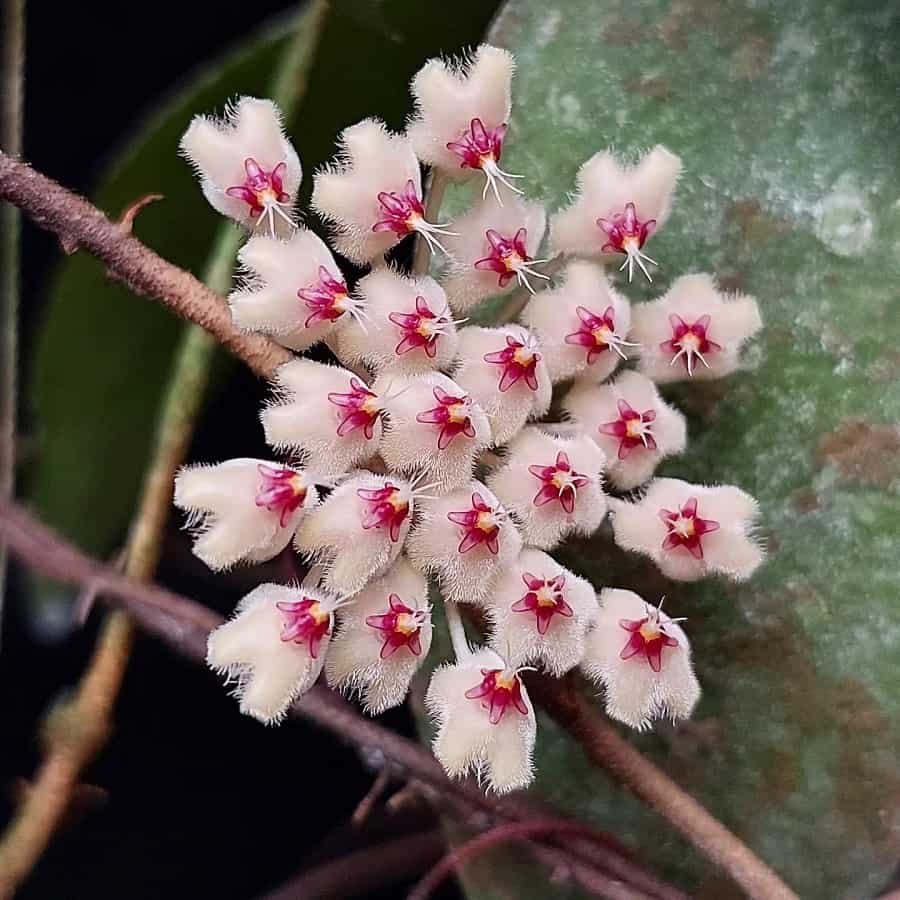
Hoya sumatrana is an enchanting plant that thrives in an epiphytic lifestyle, climbing up trees and branches with its thin but sturdy stems. It emits a white or yellowish sap that flows through all of its parts, giving the plant a mystical aura. With adventitious roots growing below its nodes and along its stems, Hoya sumatrana is a resilient plant that can withstand its environment.
The leaf petioles are dark brown and round, creating a stark contrast with the hard, juicy leaves that are medium green on the upper surface with occasional silvery spots. The lower surface is pale green, with inconspicuous basal tubercles.
Hoya sumatrana produces flat inflorescences that consist of 10-15 beautiful flowers that bloom for a long period of time. The peduncles are positively geotropic, dark red and form at each node. The corolla of the flowers is cream-colored, with triangular lobes that are densely pubescent inside and smooth on the outside. The crown of the flower is small but mighty, standing at 2-2.5 mm high and 2.8-3.2 mm in diameter, with a striking red color.
Hoya Sunrise
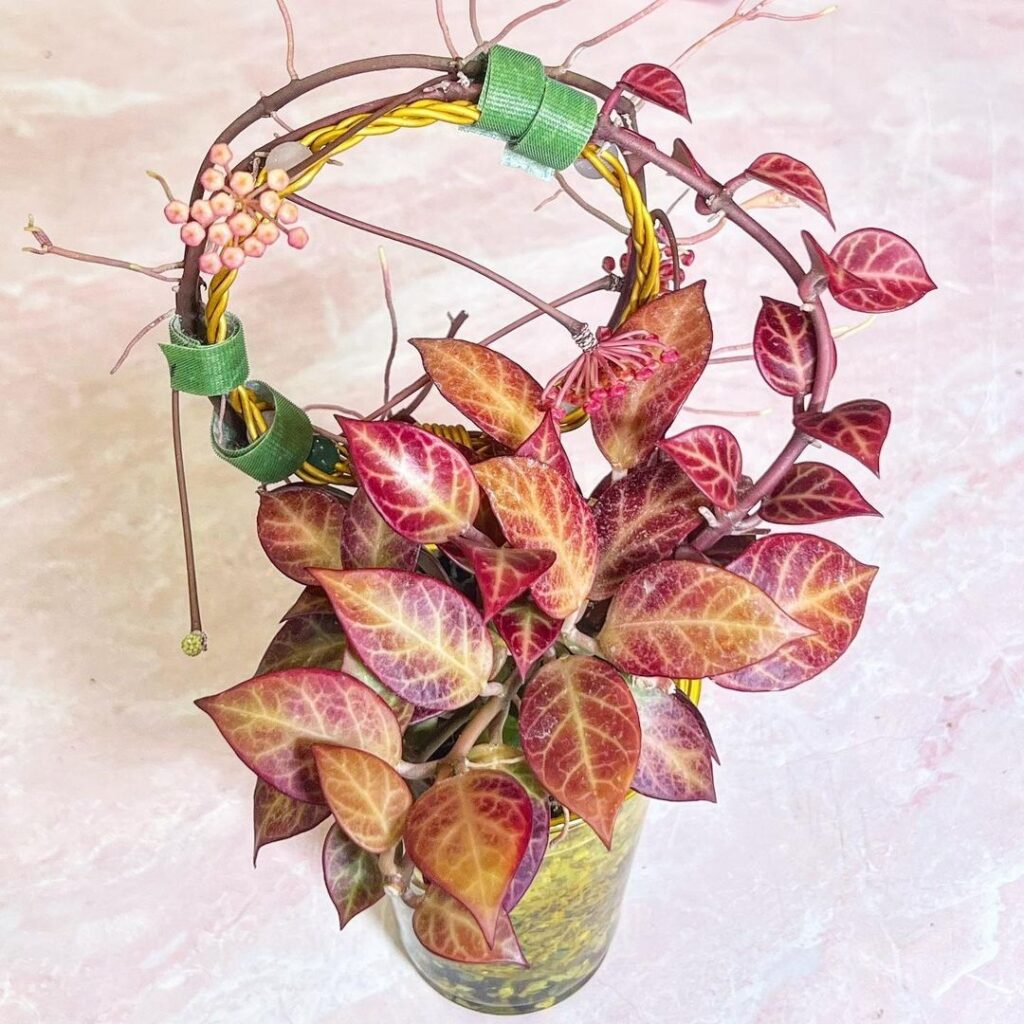
The Hoya Sunrise is a popular and rare houseplant that’s easy to grow. It has glossy, dark green leaves with a prominent network of bright green veins that turn a rich maroon red with purple undersides in bright light. This vining plant produces small, cream-colored, fuzzy flowers that are highly fragrant and range from white to pale pink. A hybrid between Hoya lacunosa and Hoya obscura, it grows fairly slowly.hoya wayetii
Hoya surigaoensis
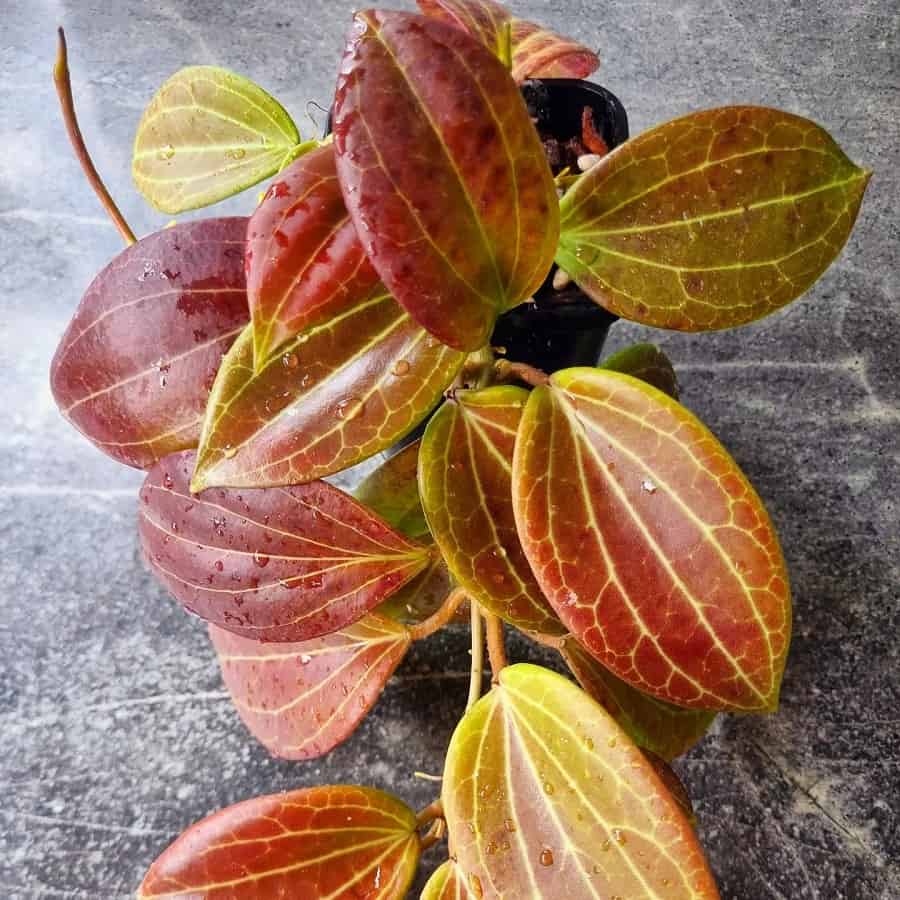
Hoya surigaoensis is a unique species of hoya native to the tropical paradise of Surigao, Mindanao in the Philippines. Discovered on a botanical expedition in 1997 by Edward Gilding and his team, it was named after the region where it was found. This species is similar to Hoya pentaphlebia, but it boasts a smaller corolla with a diameter of just 1.20 cm and a crown with longer inner lobes. The herbarium leaf holotype of Hoya surigaoensis was grown and cared for in Sweden by Mrs. Torill Nyhuus, adding a touch of international flair to this stunning species.
Hoya surisana
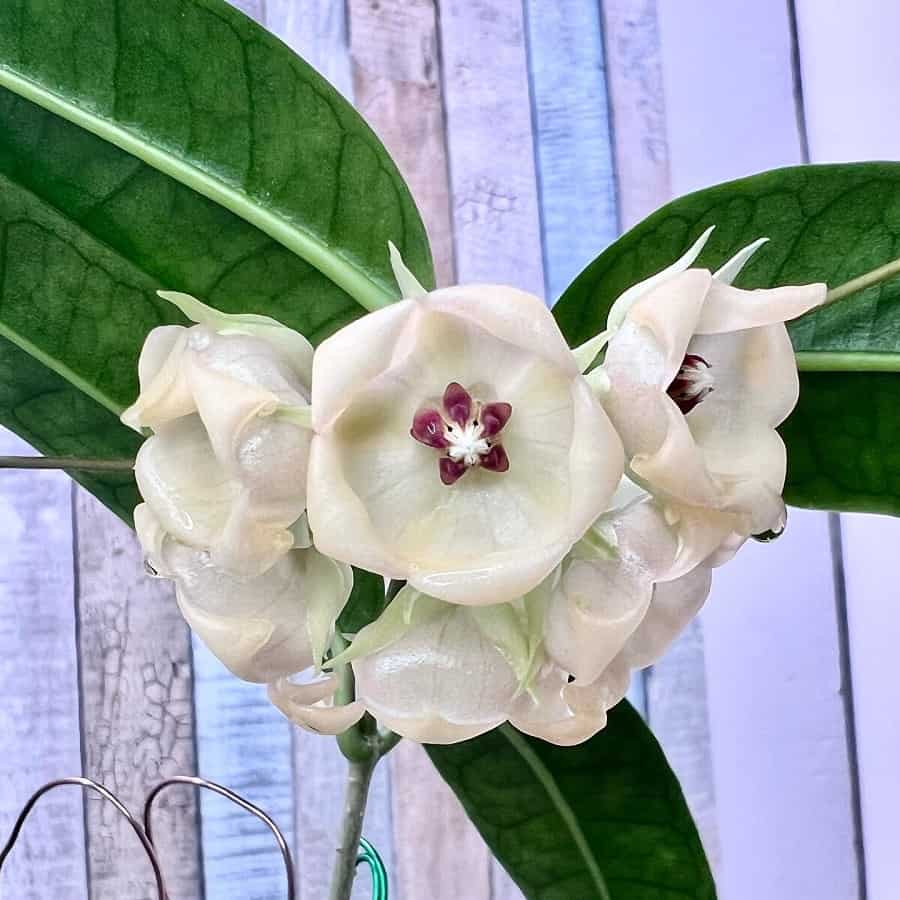
Hoya surisana is a unique and rare species of hoya that is native to West Sulawesi, Mount Makalangkan in Indonesia. It is named after Surisa Somadee, a Thai hoya expert and grower. This ground-climbing vine has white latex in all its parts and is found in pine forests on steep slopes.
The stems are cylindrical, medium green when young and later turn dark green or greyish brown. The leaves are pale green on top and medium green underneath with a pinnate venation. The flowers are white, broadly bell-shaped, and have a crown with dark purple lobes. The umbel of flowers is convex and has up to 10 individual flowers. This species is only known to exist in a limited area in Indonesia.
Hoya sp. Chicken Farm
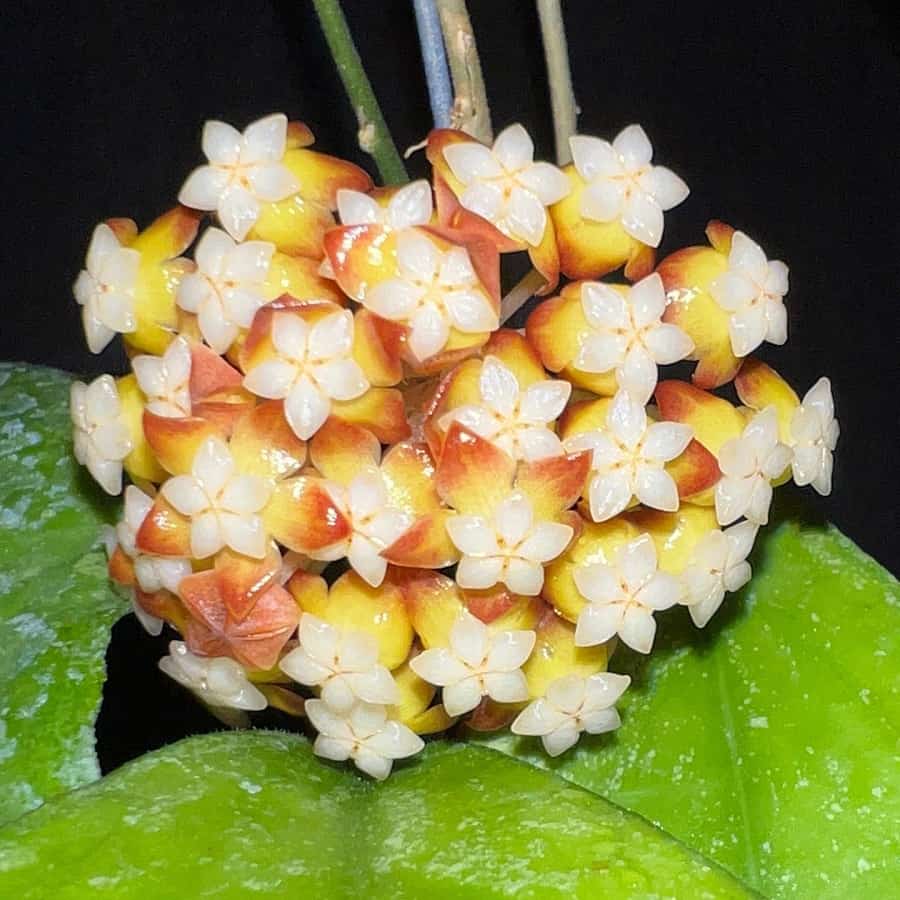
Meet Hoya sp. Chicken Farm – a beautiful and unique species of hoya native to Sabah, Borneo. It was discovered by Eva-Karin Wiberg near a chicken coop in 1997, which inspired its name. This species is similar in appearance to Hoya finlaysonii, with a lifestyle of an epiphyte, and boasts hard, dark green leaves with silver speckles, measuring 19 cm long and 9 cm wide.
During the flowering season, up to 20 individual flowers with a diameter of 0.6 cm can be seen, each with inward-turned yellow corolla lobes with red-brown tips, and a white crown. Hoya sp. Chicken Farm is not only visually stunning but also easy to grow, tolerating soil drying easily.
Hoya sp. DS-70

Hoya sp. DS-70 is a unique and rare variety of hoya, hailing from the Philippines. It is a climbing vine with thin stems, typically grown as an ampel in cultivation. This hoya is known for its beautiful and thick leaves, with a velvety texture, dark green color, and dark edge. The flowers of Hoya sp. DS-70 are small and red with a yellow and red crown, and emit a sweet aroma. This hoya blooms continuously throughout the year, making it an attractive addition to any collection.
Hoya sp. DS-70 was originally distributed by Mr. David Silverman, who listed it as #70 in his collection, leading to its designation as “DS-70”. However, it was later mistakenly published as Hoya tsangii Burton, which has since been corrected. Despite its past classification confusion, Hoya sp. DS-70 remains a sought-after hoya due to its unique appearance and sweet fragrance.
Hoya sp. Haruku
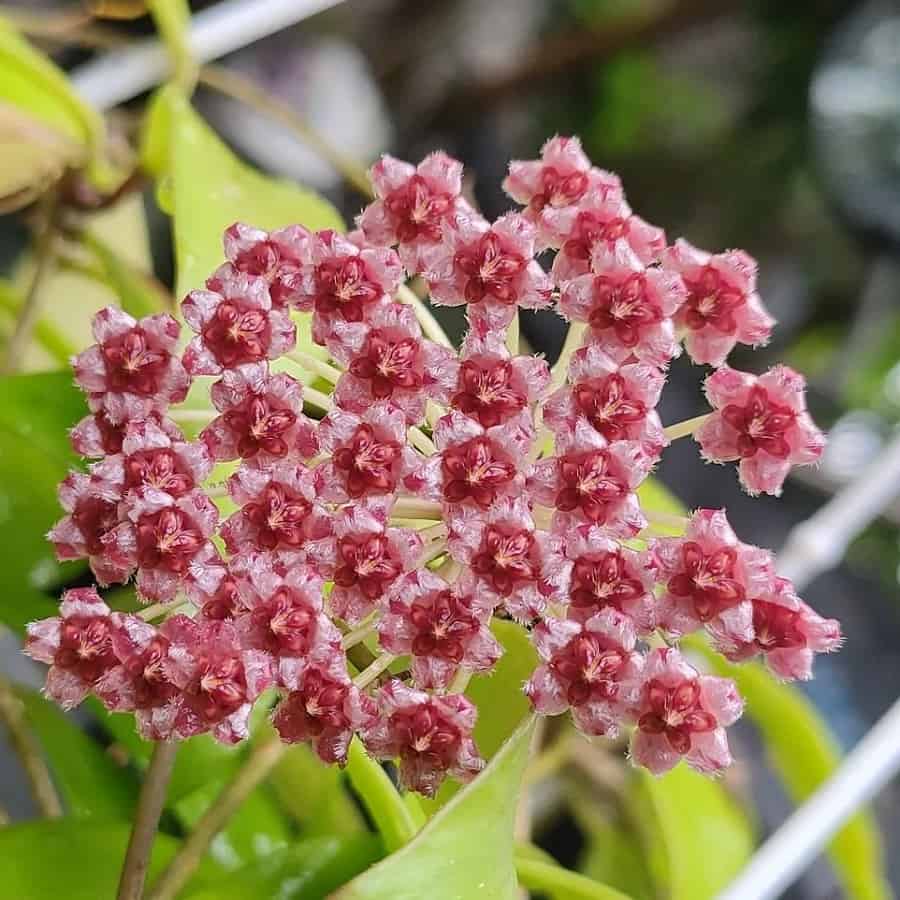
Hoya sp. Haruku is a rare and fascinating species of hoya that originates from the island of Haruku in Indonesia. It’s a strong and early-flowering hoya that can grow in cultivation both on support and as an ampel. The leaves of this plant are lanceolate, smooth, and have a visible central vein. The lobes of the flower corolla are reddish-pink, pubescent, and bent back, giving the flower a unique appearance.
The crown of the flower is deep pink with a purple spot in the middle and it has a delightful fragrance like caramel or burnt sugar. It was originally collected by collector D. Hoetmer blooming on a fallen palm tree. To maintain a healthy Hoya sp. Haruku, it is important to keep the substrate constantly moistened and not let it dry out completely while providing it with bright, indirect light.
Hoya tannaensis
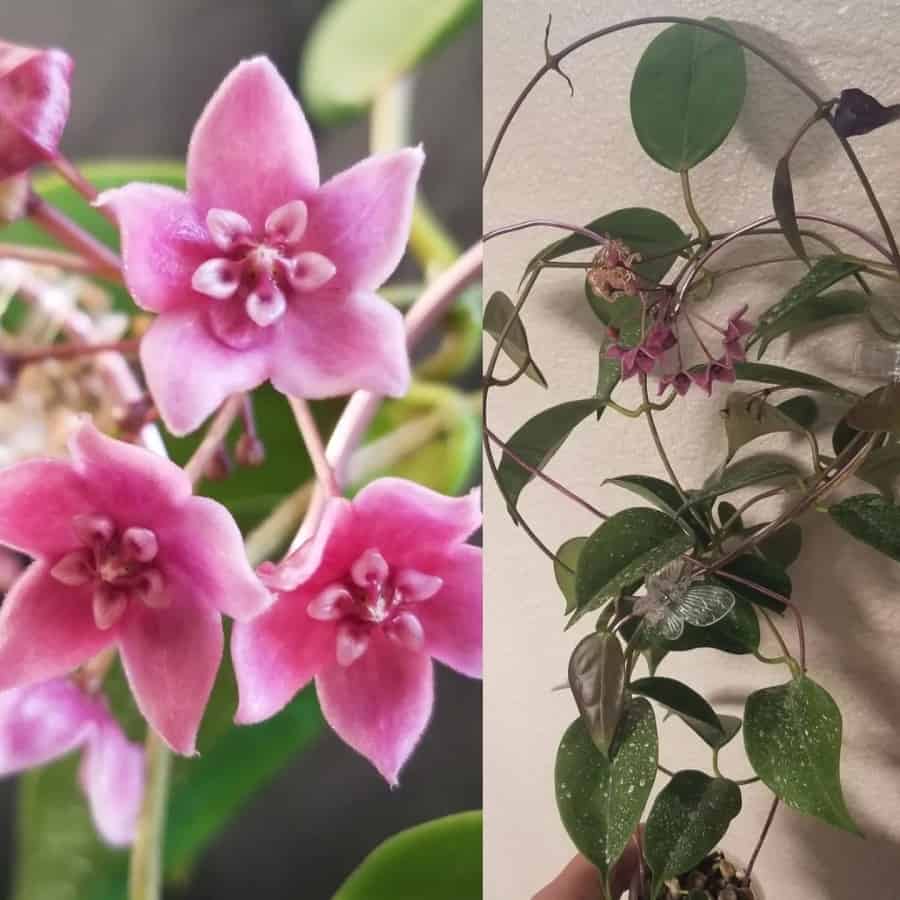
Hoya tannaensis is a fast-growing, epiphytic hoya that is known for its ability to climb and cling to any support it can reach. Its leaves are light green, lanceolate, and smooth, with a pointed tip and a central vein that runs along the center. This hoya is prized for its large, star-shaped or slightly cupped flowers, which are white with a pink tinge and have a pink crown with a lighter center.
The flowers produce a large amount of nectar and have a weak, but not unpleasant aroma. Despite being similar in appearance to Hoya leucorhoda, Hoya tannaensis is difficult to root but once established, it will thrive with little maintenance required.
Hoya telosmoides

Hoya telosmoides is a unique hoya species that was collected from Borneo by the Strong Clemens family. It is a climbing epiphyte that can be grown in both a support or as an ampel plant. The leaves are dark green, thin, and leathery with a pointed tip, and the midrib is clearly visible. The greenish-yellow flowers are urn-shaped, and the corolla is fleshy with a slightly compressed tube.
The triangular corolla lobes are arranged vertically and have a pale yellow with a purple tint. This species needs a cool, wet environment to thrive and has a pleasant aroma. Unlike other hoyas, the unusual shape of the corolla sets Hoya telosmoides apart, resembling plants from the genus Telosma.
Hoya thailandica
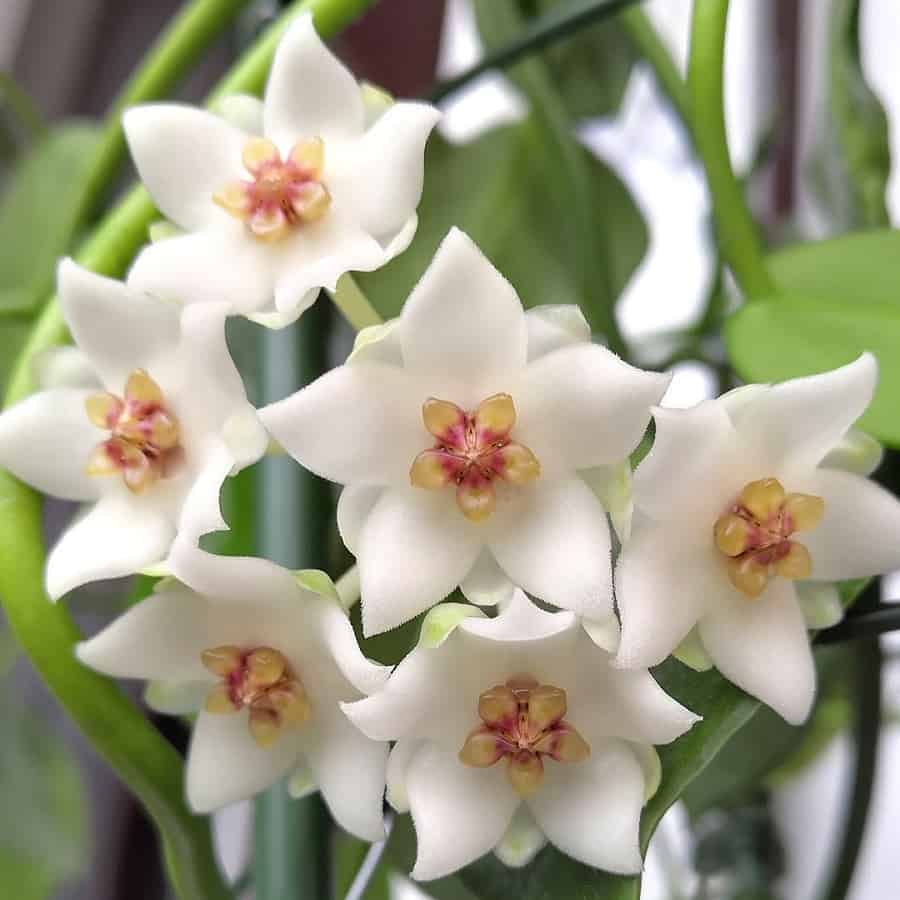
Hoya thailandica is a stunning epiphytic climbing vine that will captivate you with its unique appearance. This hoya boasts dark green, leathery, smooth leaves that are 8-12 cm long and 6-8 cm wide, with a rounded base and a sharp tip. It’s known for its beautiful porcelain-white star-shaped flowers that bloom in a flower umbel of 10 to 15 flowers, each with a diameter of 2 cm.
The corolla petals are 6-8 mm long and 6-7 mm wide, and the crown of the flower is a creamy cream with a purple spot in the center. A standout feature of Hoya thailandica is its long pedicels and long, boat-shaped sepals that are visible between the petals, making it truly a one-of-a-kind hoya.
Hoya thomsonii
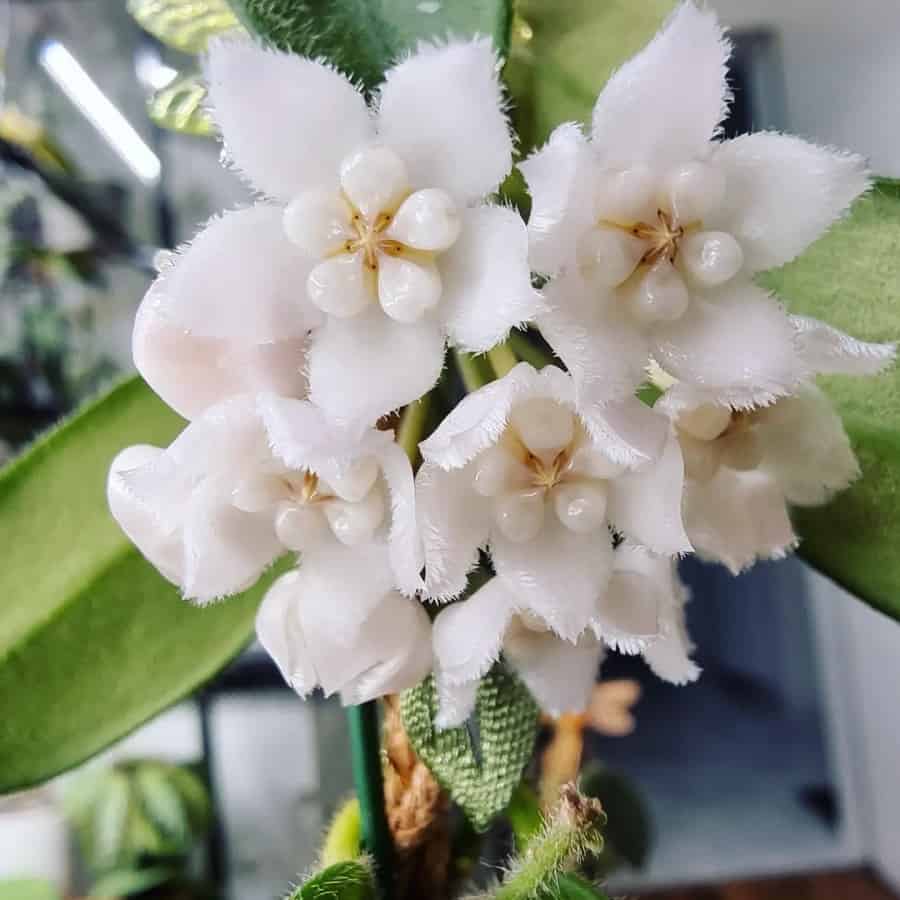
Hoya thomsonii is a versatile plant, originating from India and the Himalayas, growing in rocky cliffs along streams in the mountainous regions of northwestern Thailand and Myanmar. Named after one of its collectors, T. Thomson, it is known for its dark green, hairy leaves with a silvery speck and pubescence. It can grow both as an ampel or climb on a support.
During the winter months of November to December, Hoya thomsonii blooms with an impressive 10-20, sometimes even 30, crystal white, pubescent flowers. With a spicy aroma and slightly pushed forward corolla blades, its flowering can be quite intrusive with many umbels open at the same time. The flowering lasts approximately three weeks.
Hoya thuathienhuensis
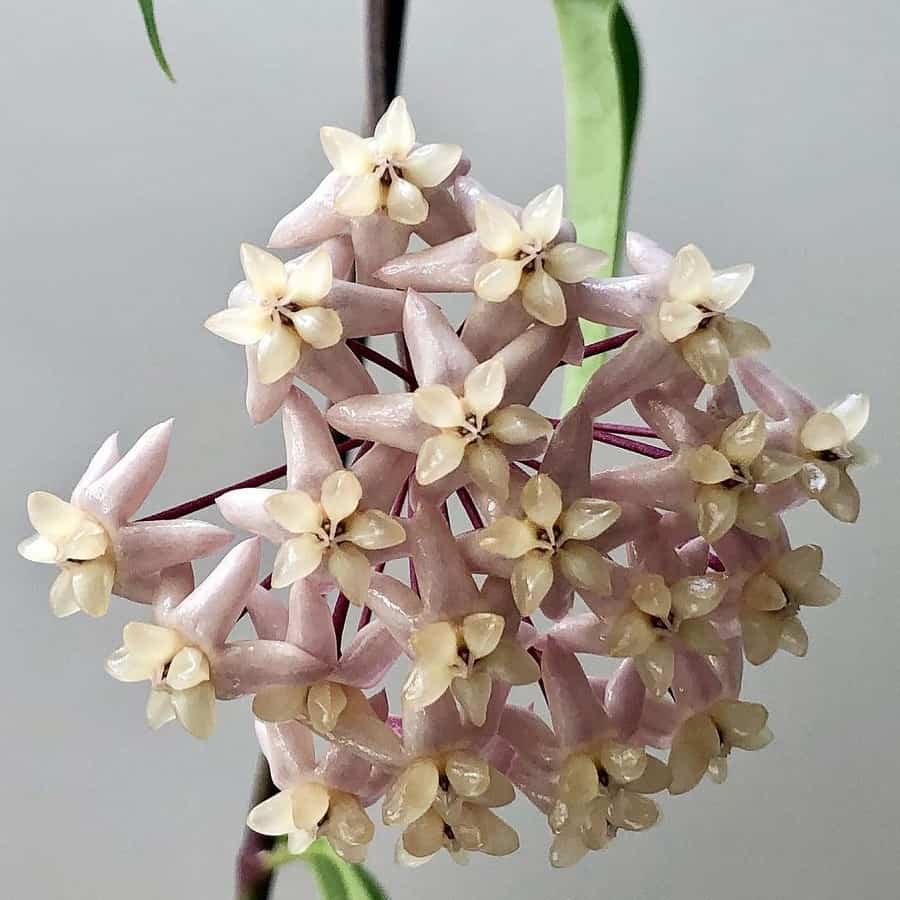
Hoya thuathienhuensis is a beautiful climbing vine that hails from the Thừa Thiên-Huế Province in central Vietnam. This plant was discovered in a secondary, evergreen montane forest and grew up to 20 meters tall, rooted in a humus-rich grass cover. Hoya thuathienhuensis has cylindrical lashes that are weak, 3-5 mm in diameter and can reach up to 5-10 meters in length. The leaves are oblong-oval, 10-14 cm long, and 3-4 cm wide, with a green color on top and light green on the bottom.
The inflorescence is positively geotropic and convex, with 17-20 (sometimes up to 40) flowers. The corolla is white and glossy, 14-16 mm in diameter, and sometimes has a purple tinge. The crown is dull yellow and 8-10 mm in diameter. Hoya thuathienhuensis blooms in May, making it a great addition to any botanical collection.
Hoya tomataensis
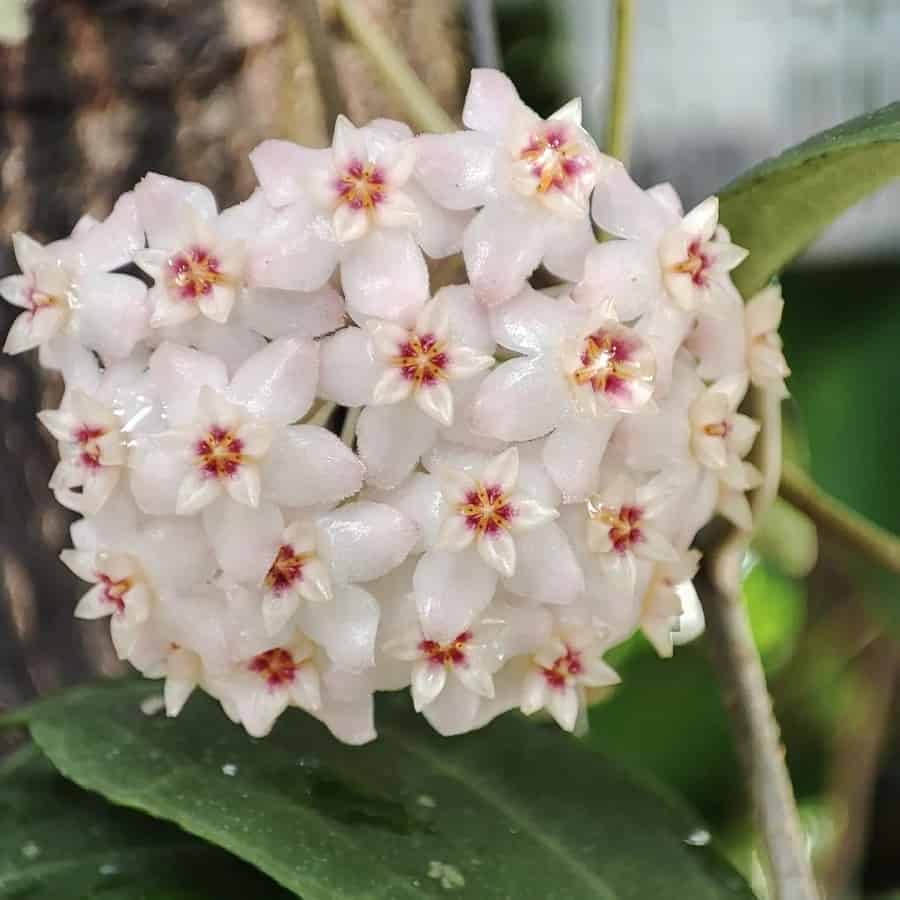
Hoya tomataensis, a new and exotic species, hails from the tropical region of Sulawesi. It was discovered by Ted Green along the street between Tomata and Beteime, thus earning its name. This epiphytic hoya can grow both as an ampel and a climber. Its leaves are thick, oval, light green, and shiny with a noticeable midrib. The flower umbels of Hoya tomataensis are round and loosely arranged, each comprising 20 vibrant red flowers that bloom in an umbrella shape. If you’re looking for an eye-catching and unique addition to your collection, Hoya tomataensis is a perfect choice!
Hoya tsangii
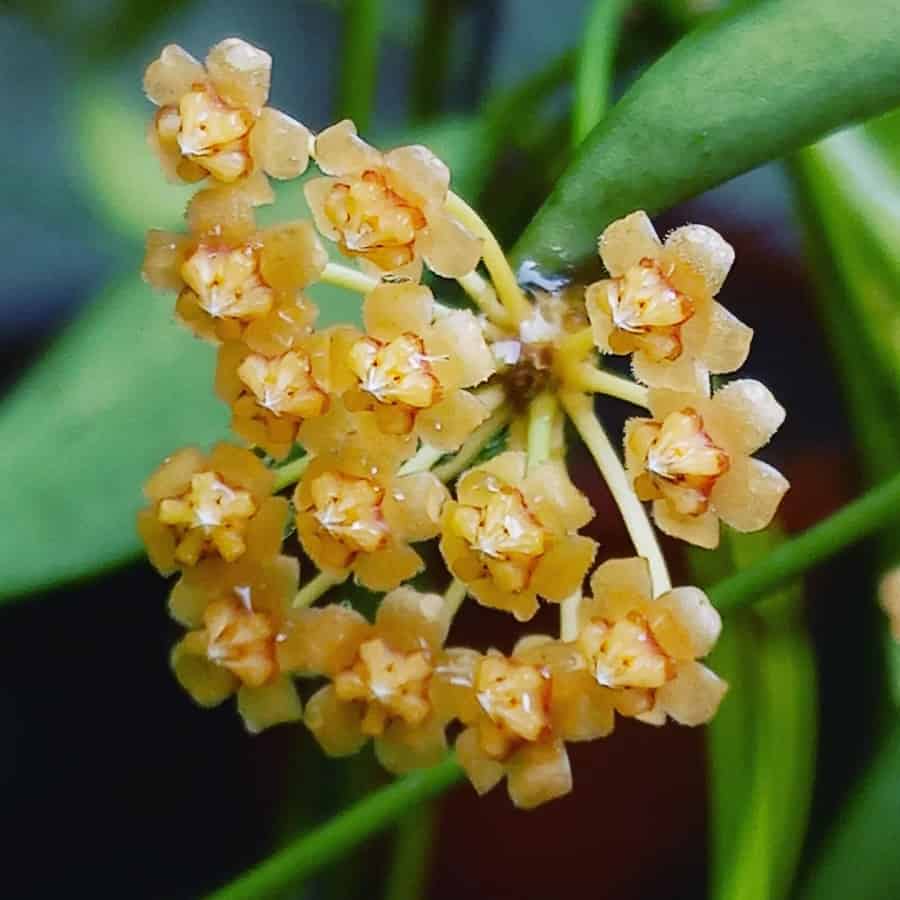
Hoya uncinata
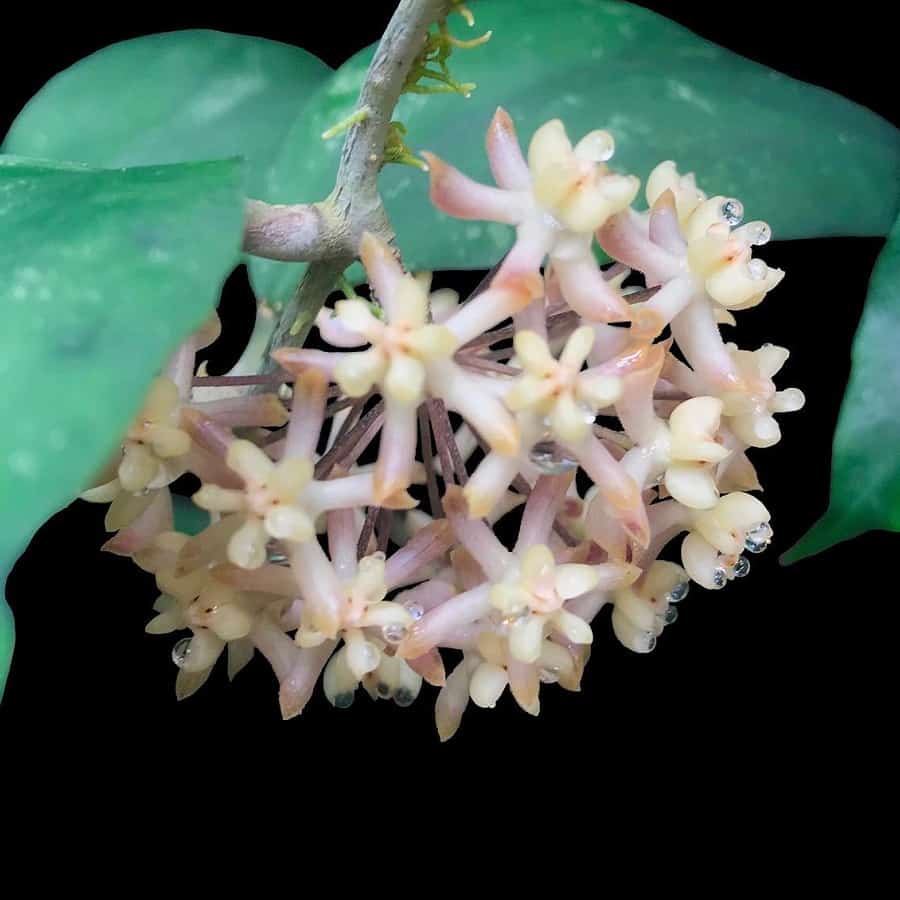
Hoya uncinata is an epiphytic climbing plant native to Indonesia, found in Java and Sumatra. This hoya variety is known for its smooth texture, thin stems and oval-lanceolate leaves with dark green and gray spots on the upper side and lighter green on the underside. The inflorescence of Hoya uncinata is about 4 cm in diameter with 8 to 22 individual flowers. The flowers are white with a pink tinge, finely pubescent on the inside, and have curved petals. This hoya was collected from Gunung Pantjar in West Java, where it grows near warm spring water at an altitude of 500m, and Padang Panjang in West Sumatra, at an altitude of 900m.
Hoya undulate
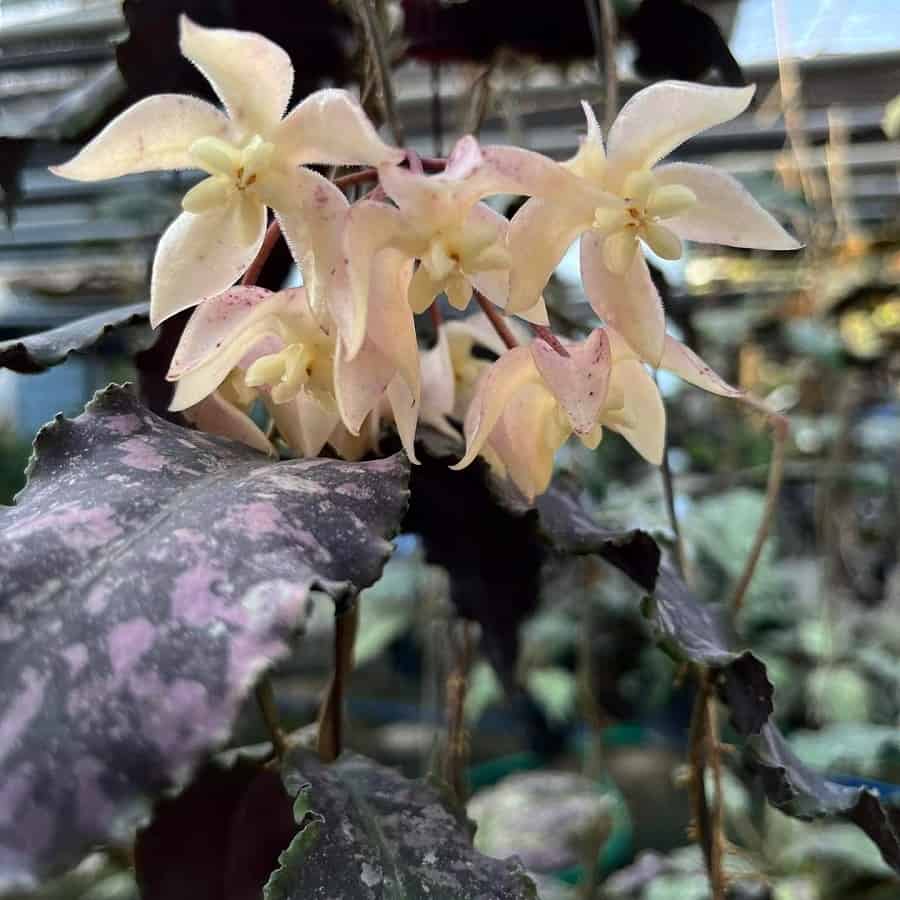
Hoya undulata is a fascinating epiphytic liana native to shady, moist forests in its natural habitat. With thin lashes that vary in length and develop leaves in clusters, it provides a perfect home for symbiotic ants that settle in its domatia, or hollow growths. Its leaves range from oval to obovate and are characterized by a dark green upper surface with gray and purple spots, and a green to purple lower surface.
The flowers are positively geotropic and form convex umbels, with corolla lobes that are white with purple-red dots and creamy light pink inside. In intense sunlight, the leaves turn purple and it usually takes root in ant nests. Hoya undulata is a unique and captivating plant to add to any collection.
Hoya uniflora

Hoya uniflora is a unique species found in Indochina, known for its exceptional floral umbel consisting of only one flower. This species is similar to only a few species found in mainland Asia and northeast India. It is a small, creeping, herbaceous liana that can grow up to 35 cm in length and has greenish-gray, thin stems with sparse aerial roots. The leaves are fleshy and oval in shape, with a glossy green upper side and a greenish-white underside.
The flowers of Hoya uniflora are pendulous, sweetly fragrant, and snow-white in color with a glossy white crown. This species is known to flower between April and June.
Hoya unirana
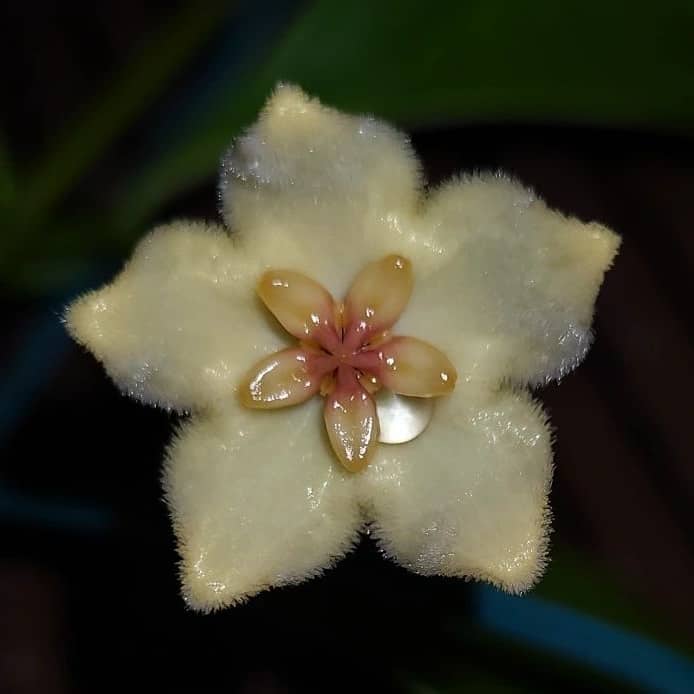
Hoya unirana is a unique and captivating species in the genus with ascending growth habit, most likely as an epiphyte. Its stems are thin and cylindrical, reaching a diameter of 2-4mm and internodes of 3-12cm. Unlike other species, Hoya unirana doesn’t have adventitious roots. The leaves are paper-like, with elliptical or ovate shape, an acute base, and a pointed apex. The veins on the leaf are pinnate, with a depressed middle on the upper surface and 4-8 secondary veins on each side.
The inflorescence of Hoya unirana is noteworthy, consisting of 6 or more flowers, with peduncles that round and glabrous. The pedicels are filiform and bare, while the corolla is creamy-greenish-yellow, 20-22mm in diameter, and densely pubescent inside. The crown of the corolla is creamy yellow with a pink center, 1.5-2mm high and 8.5-10mm in diameter. The beauty of Hoya unirana truly blossoms during the flowering season, making it an interesting addition to any collection.
Hoya vaccinioides
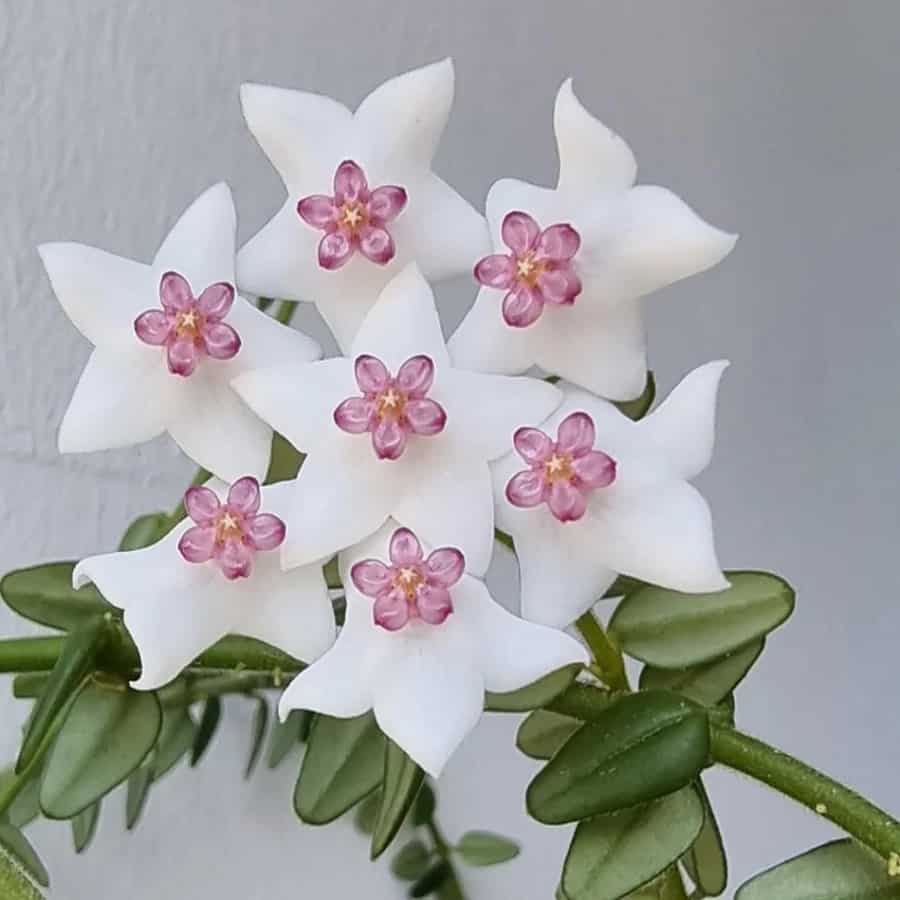
Hoya vaccinioides is a rare and unique epiphyte or lithophyte native to the evergreen moist forests of northeastern India and parts of Southeast Asia. This hoya species is characterized by its star-patterned pedicel covered in dense, long hairs and its stunning white wheel-shaped corolla with a pink crown.
During the months of April to May, Hoya vaccinioides blooms 6-8 individual flowers, each measuring around 2 cm in diameter, filling the air with a pleasant but not overpowering scent. This hoya variety is also used in traditional medicine in Vietnam and can be found at elevations of 1200-1500 meters above sea level.
Hoya vangviengiensis
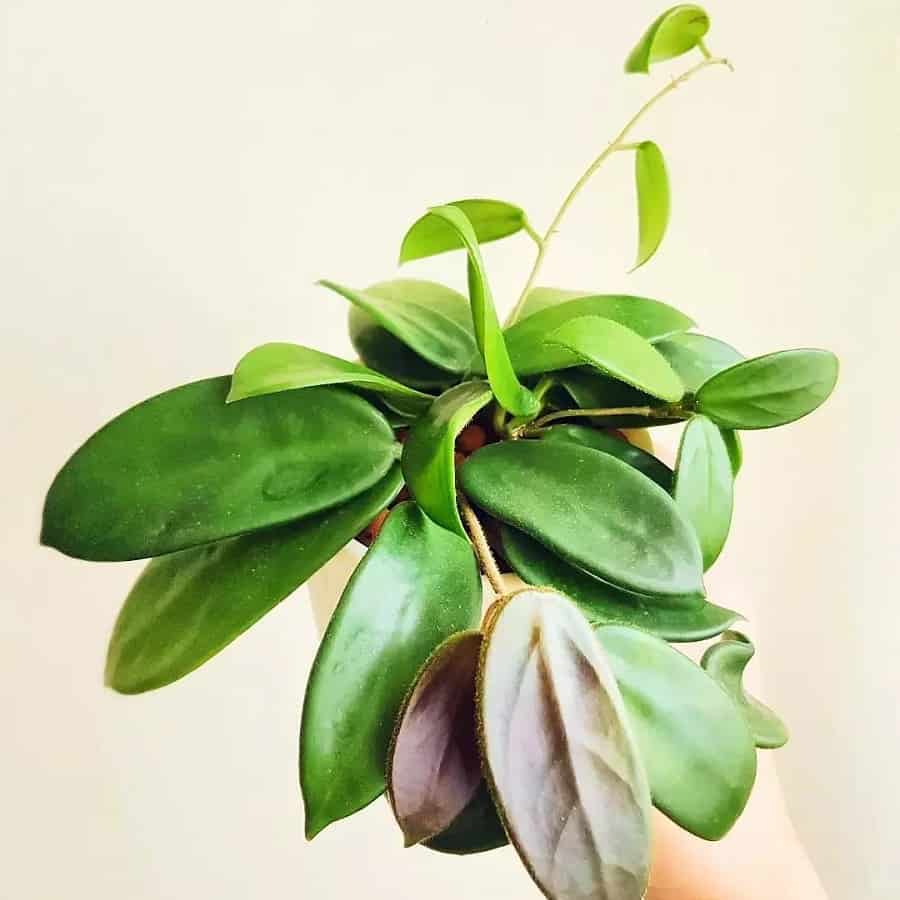
Hoya vangviengiensis is a rare and exotic species of epiphytic liana that is only found in a single location in Laos. With its clear juice and leafy lashes that can grow up to 10 meters long, it is a unique and captivating sight to behold. The leaves of Hoya vangviengiensis are dark green, thin, and broad with a sharp tip and a semi-heart-shaped base.
The white, star-shaped flowers that bloom in a flower umbel can reach up to 20 mm in diameter and have translucent white crowns and smooth corolla lobes with cilia along the edges. Hoya vangviengiensis grows best in humid and cool niches, such as near caves with fresh and humid air, and can be found at altitudes ranging from 300 to 1000 meters above sea level. This species blooms in April, at the end of the dry season, and is sure to captivate any onlooker with its rare beauty.
Hoya vanuatuensis

Hoya vanuatuensis is a rare and exotic climbing vine, with thin and knot-rooted vines that love to live in the shadows of the undergrowth. With its stunning and simple ovate leaves, the leaves are smooth and shiny, displaying a pinnate venation and measuring between 4-8 cm long and 2-4 cm wide.
During the flowering season, a flat flower umbrella opens up to reveal 3-25 pale yellow or pale green flowers, each 1.7 cm in diameter, with a weak but pleasant aroma that lasts for 7 days. This species of Hoya was initially thought to be Hoya diptera but was later published as a separate variety. If you have an old Hoya diptera that has bloomed with a yellow crown, chances are you have the rare and beautiful Hoya vanuatuensis.
Hoya versteegii
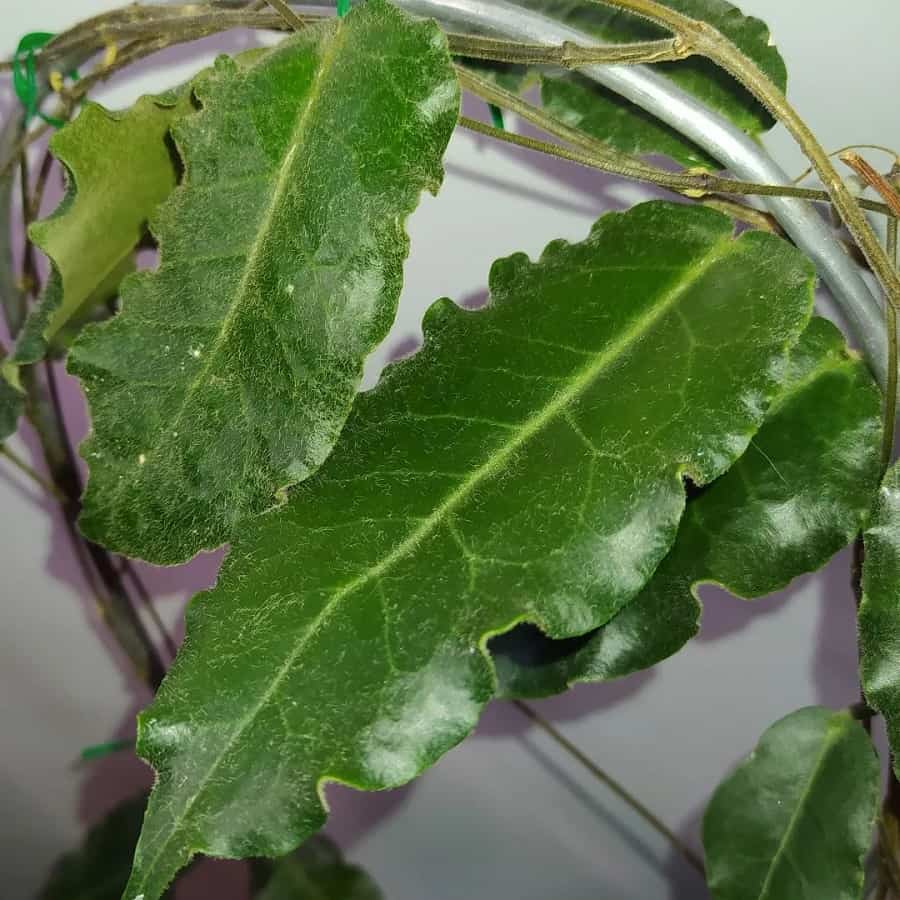
Hoya versteegii is a fascinating climbing vine, known for its tough and leathery leaves that endure even in dry conditions. With its elliptical, fleshy leaves measuring 8-15 cm by 3-6 cm, this plant adds a touch of greenery to any space. The leaves have a pinnate venation and are pubescent on the lower surface, with the upper surface being glabrous or slightly pubescent.
The white flowers that bloom in reusable flower umbrellas have a beautiful funnel-shaped corolla, measuring about 2.5 cm in diameter, with a long pointed tube and a crown up to 3 mm high. With a fragrance that resembles Jasminum adenophyllum, Hoya versteegii is sure to captivate anyone with its beauty and scent.
Hoya verticillata
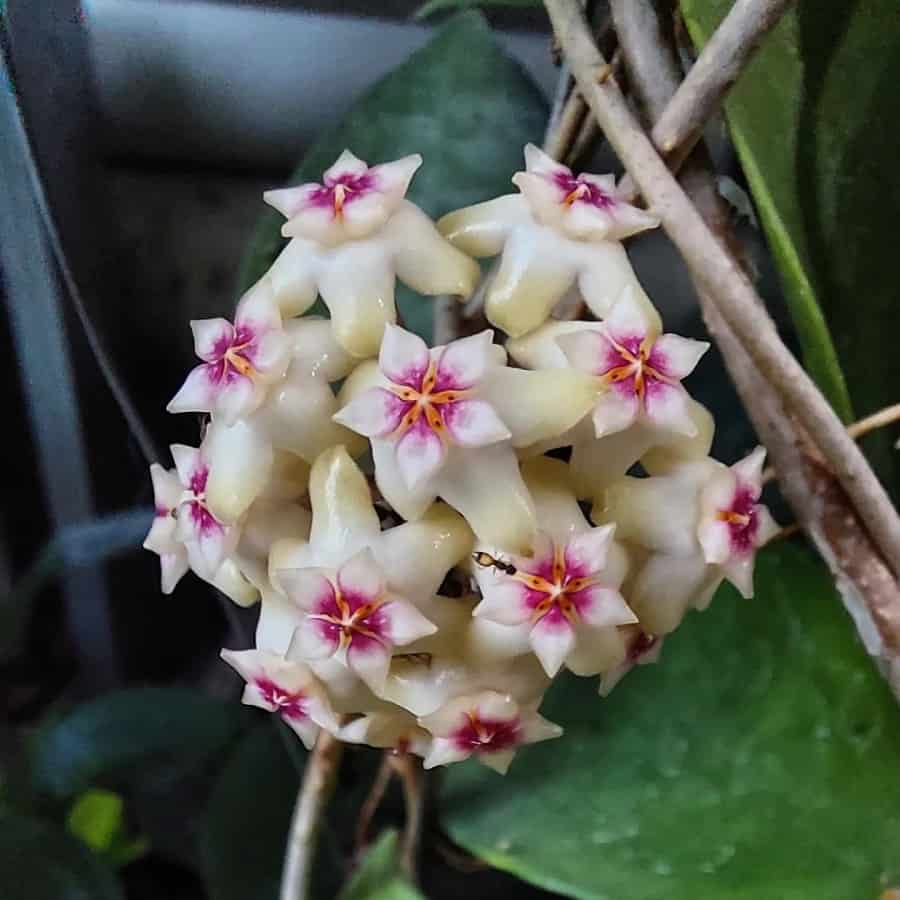
Hoya verticillata is a climbing vine that loves to live in the lush, misty forests of Southeast Asia. Found in Cambodia, Laos, Vietnam, northeast India, Bangladesh, and Thailand, this common hoya is known for its ability to thrive on vertical cliffs, mossy mountain peaks, and along gorges with streams at an altitude of 5-900 m above sea level.
It is a beautiful sight to behold when in bloom, with its delicate flowers ranging from almost white to yellowish or pink, and its fragrance ranging from sweet to alluring. So if you ever find yourself in the jungles of Southeast Asia, keep an eye out for this breathtaking hoya.
Hoya villosa
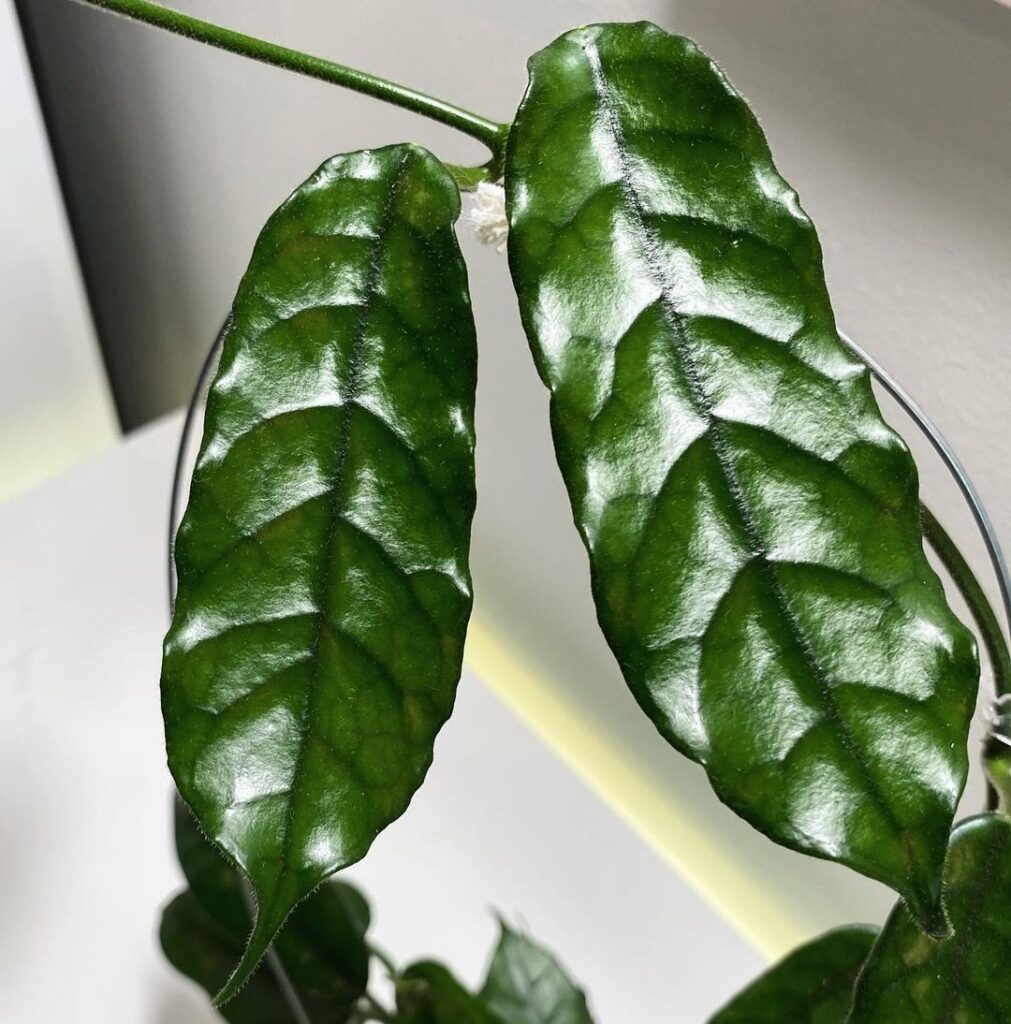
Hoya villosa features large, velvety leaves with rippled edges and a fuzzy underside. It produces attractive, waxy, star-shaped flowers that are typically white or cream-colored, emitting a pleasant fragrance.
Hoya vitellina
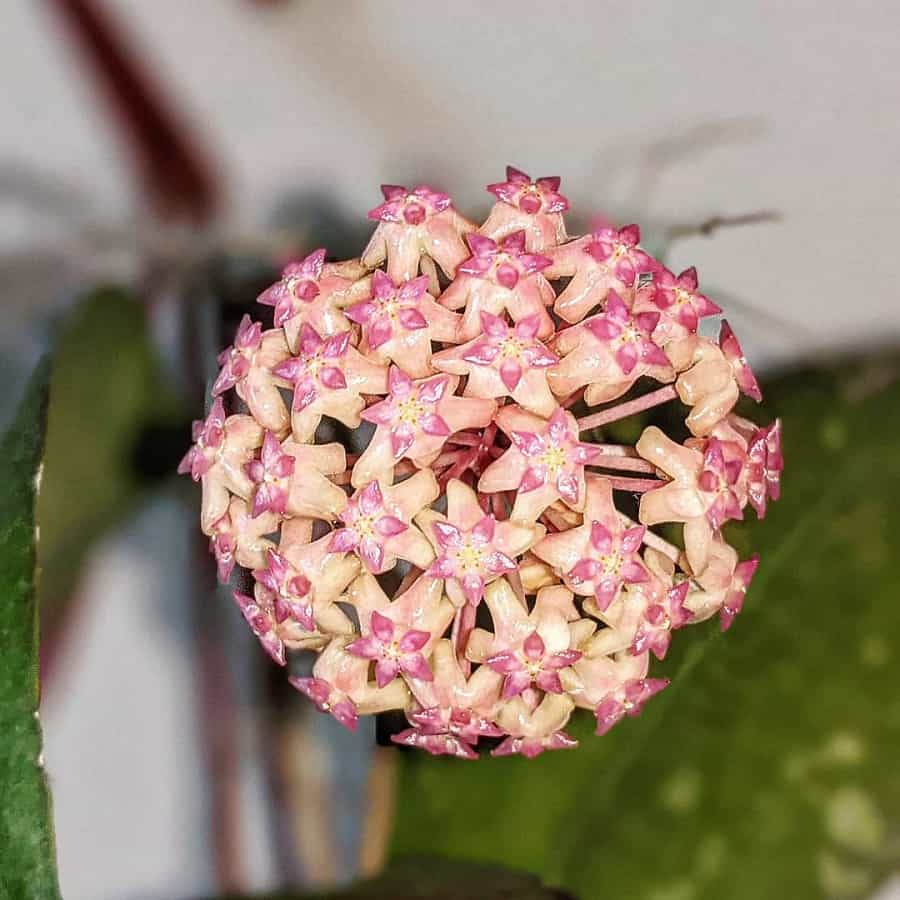
Hoya vitellina is a rare and exotic species of hoya plant from western Java, Indonesia. It’s an epiphytic climber with ovate leaves and noticeable veins only on the upper side. The plant produces 20-35 flat, greenish, beige or pale yellow flowers with a slightly depressed, pink crown. Over 170 years after its initial discovery, Hoya vitellina still remains a mystery to many, with debates over its labeling and synonymy with Hoya fuscomarginata. However, research conducted by the Singapore Botanic Gardens has confirmed that the two names are synonymous.
Hoya vitellinoides
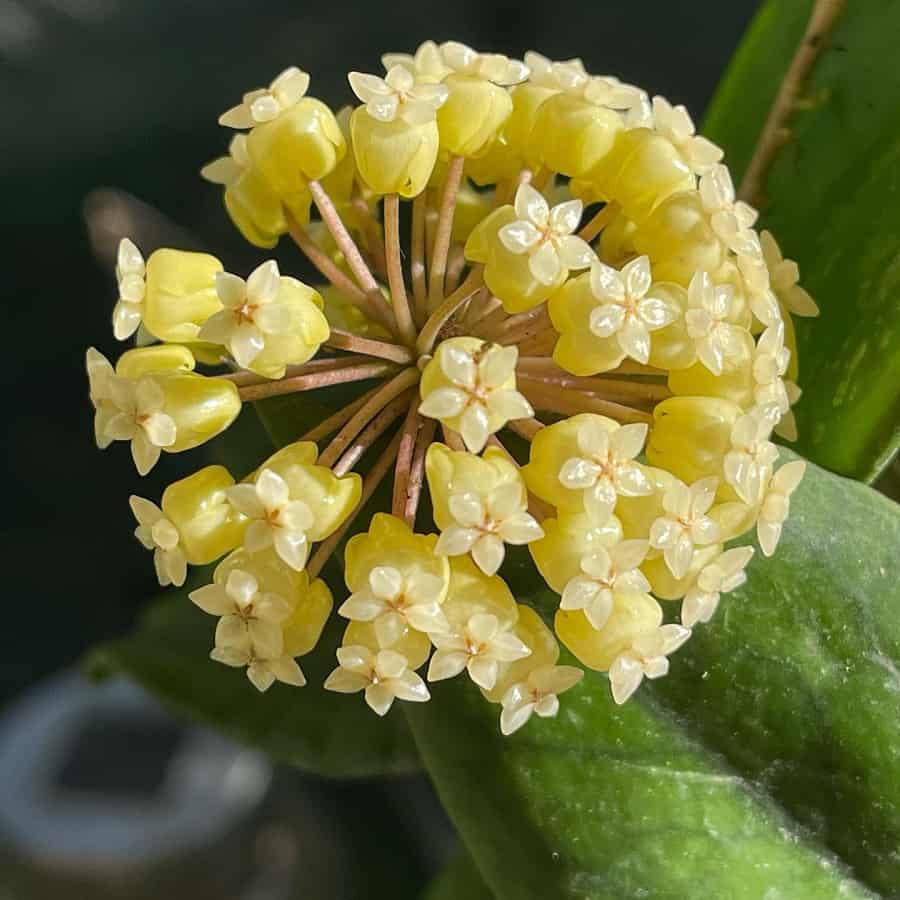
Hoya vitellinoides is an attractive climbing epiphyte with cylindrical, glabrous stems. Its leaves are thick and fleshy, with a broadly oblong shape, pinnate venation, and a vein network that is darker than the rest of the upper surface of the leaf blade.
During the flowering season, Hoya vitellinoides produces a convex umbel of 1 to 20 individual flowers, each with a pubescent corolla about 1 cm in diameter that is pale green or yellow, and a completely white crown. The peduncle is horizontal, rigid, and 2-5 cm long, making this species of Hoya a unique and captivating addition to any plant collection.
Hoya vitiensis

Hoya vitiensis is a unique and visually stunning hoya plant that is native to the Nandarivatu region in Viti Levu, Fiji. It is known for its fast growth and thin, grassy green leaves that can be easily trained to climb along a support.
The flowers of Hoya vitiensis are a true marvel, with a striking combination of grayish-purple corolla and a pale yellow crown with a red center. Each umbrella can hold 10-20 flowers that last for around 10 days and emit an unforgettable scent, even though they produce no nectar. To ensure healthy growth, it is important to keep the soil moisture moderate at all times.
Hoya wallichii

Hoya wallichii is a rare and elusive variety of Hoya named after Nathaniel Wallich, a Danish botanist and superintendent of the Calcutta Botanical Gardens. Originally thought to be a different genus, advances in taxonomic research have confirmed it as a unique and distinct species of Hoya. With a lowland habitat requirement for high temperatures and ample sunlight, Hoya wallichii is a climbing terrestrial subshrub with thin stems and leathery, oblong-oval leaves.
This variety was once thought to be lost, but was recently rediscovered in two remote locations in Brunei and Johor, Malaysia, where it grows on sandstone boulders or in the forest canopy. Hoya wallichii blooms with solitary, white-cream bell-shaped flowers with a dull red crown.
Hoya wallichii subsp. tenebrosa
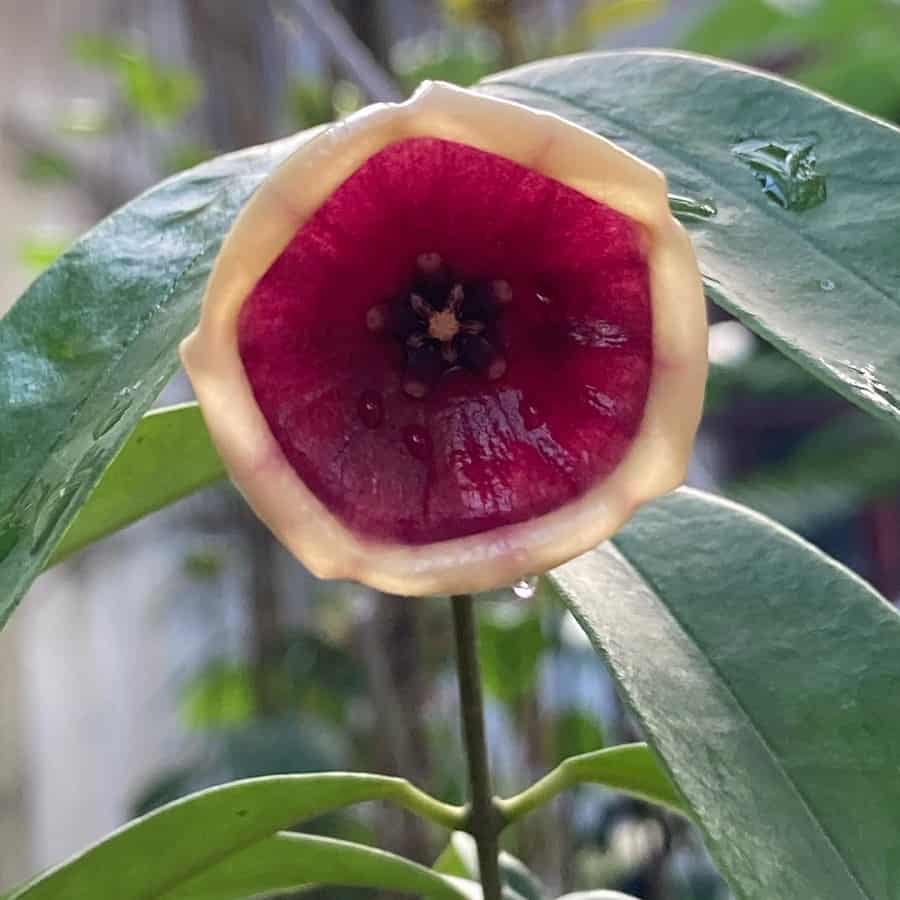
Hoya wallichii subsp. tenebrosa is a mysterious and dark beauty that was discovered in Indonesia’s West Kalimantan region. This plant grows in the lowlands, in oil palm plantations, and prefers to be nestled in the shade of the canopy, where it grows up to 5 meters above the ground. It is an epiphyte that boasts white sap in all of its parts, and its cylindrical stems are thin and delicate. The leaves are rounded and ovoid to oblong in shape, with barely visible secondary veins.
The inflorescence of Hoya wallichii subsp. tenebrosa is a stunning display of dark purple and white or cream flowers that bloom one at a time. The corolla is bell-shaped and deep purple on the inside with a white or cream edge, and the crown is almost black and velvety. The specific epithet tenebrosa refers to the dark color of the rim and crown, which is a true testament to the plant’s beauty and elegance.
Hoya walliniana

Hoya walliniana is a tropical beauty named after the talented Swedish photographer Pierre Wallin. It is a fast-growing and versatile plant, originally from Malaysia, that can be grown as a climber or in an ampel. With its glossy, dark green leaves that boast a silvery speck and blush in the sun, it’s a feast for the eyes.
Inflorescences up to 30 creamy white flowers with pubescent corolla lobes, pale yellow crown with a red-brown center, and a weak, short-lived scent. Hoya walliniana is a low-maintenance plant that does not require much space and can easily survive the drying of the substrate.
Hoya walliniana UT 152
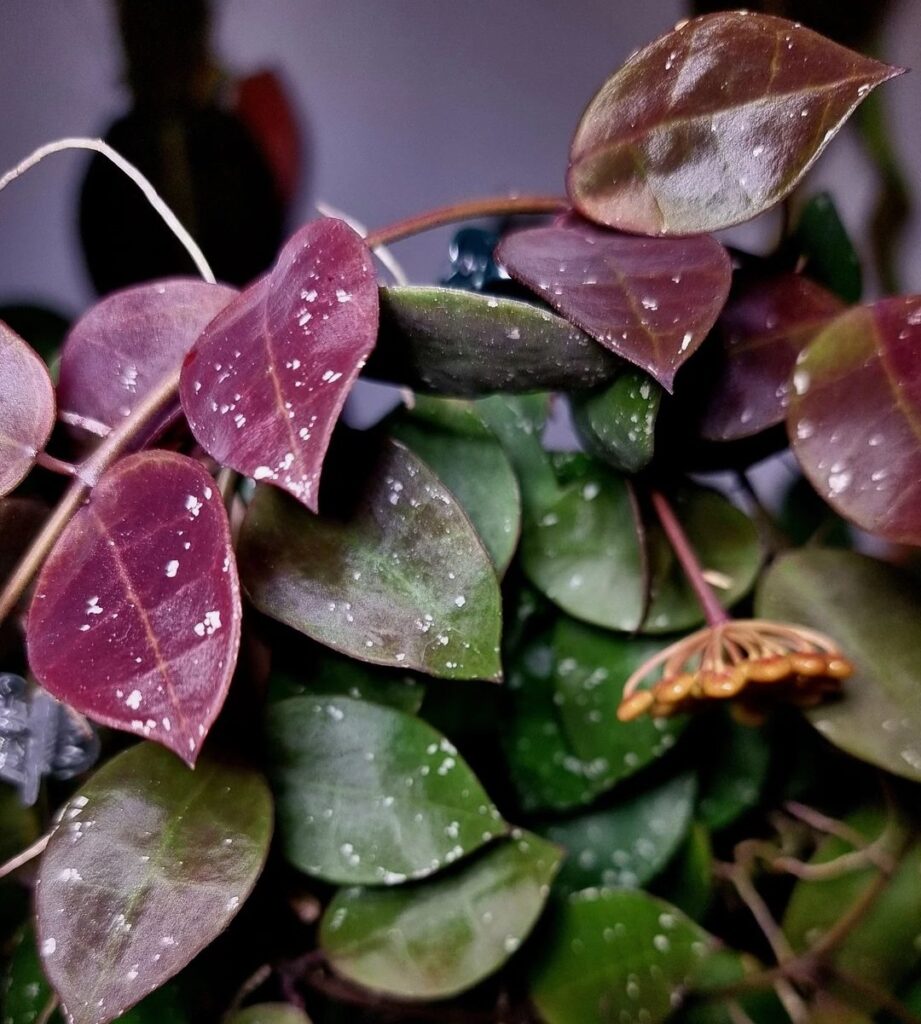
Hoya wayetii

Hoya wayetii is a medium-sized hoya with a compact form, that hails from the Philippines. This hoya is prized for its dark red flowers that exude a rich aroma of honey, and the inner surface of the corolla is pubescent. The leaves are narrow, elongated, fleshy and deep green, often framed with rusty-purple pigmentation that creates a dark edge effect.
This variety prefers high humidity and grows best in a poor and loose soil that is moderately moist but not constantly damp. Keep an eye out for the sweet fragrance of honey and the stunning dark red blooms that make Hoya wayetii an excellent choice for any hoya enthusiast!
Hoya wayetii Variegata
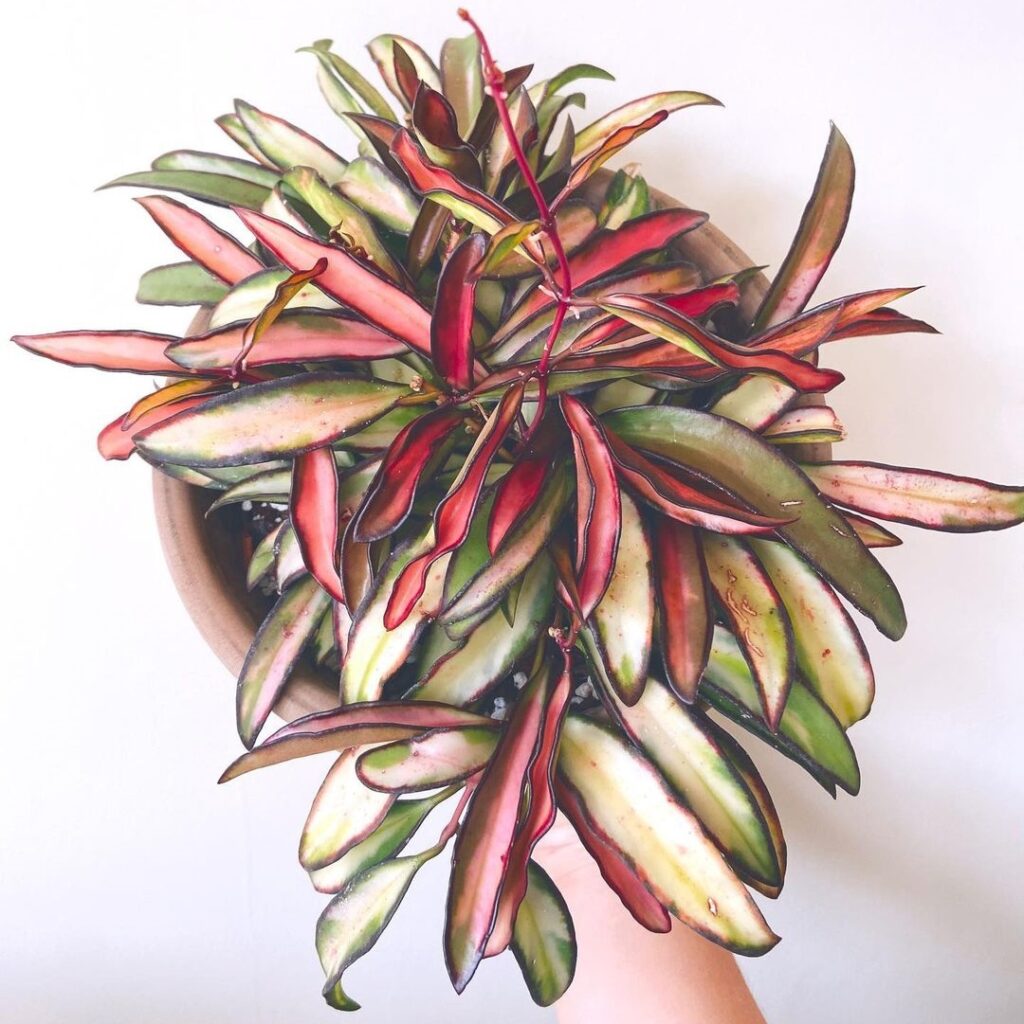
Hoya waymaniae
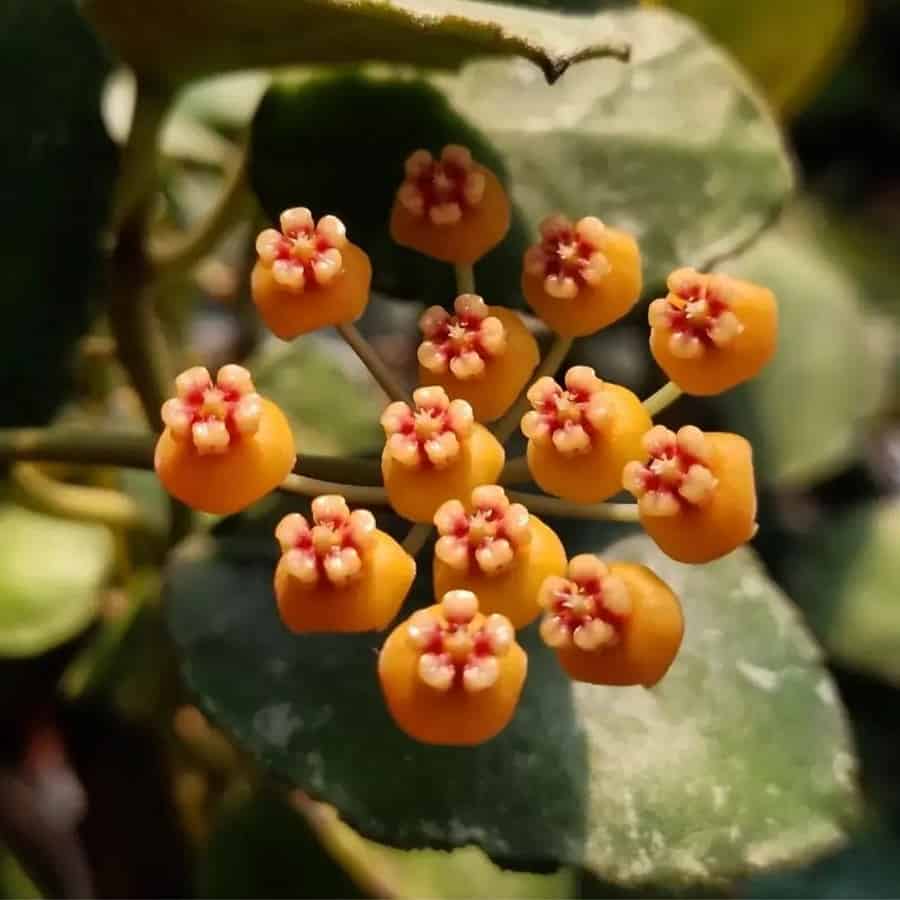
The Hoya waymaniae is a stunning species of the Hoya genus, named after Ann Wayman, the editor of the Fraterna International Hoya Society Association. Hailing from Borneo, this species is prized for its unique leaf structure, which is thick, hard and slightly rough, with wavy edges and a slight bumpy protrusion. When exposed to sunlight, the leaves take on a striking red hue, adding to its beauty.
With a strong and hard stem that roots well from the center of the internode, this species is a sight to behold when it produces its 20-25 individual flowers in a flower umbel. The flowers are large, orange in color with a beige-red crown and white “hairs” in the center, exuding a subtle and indescribable scent. Despite its delicate beauty, Hoya waymaniae is not an easy plant to grow, requiring careful attention and a delicate balance of moisture.
Hoya wibergiae
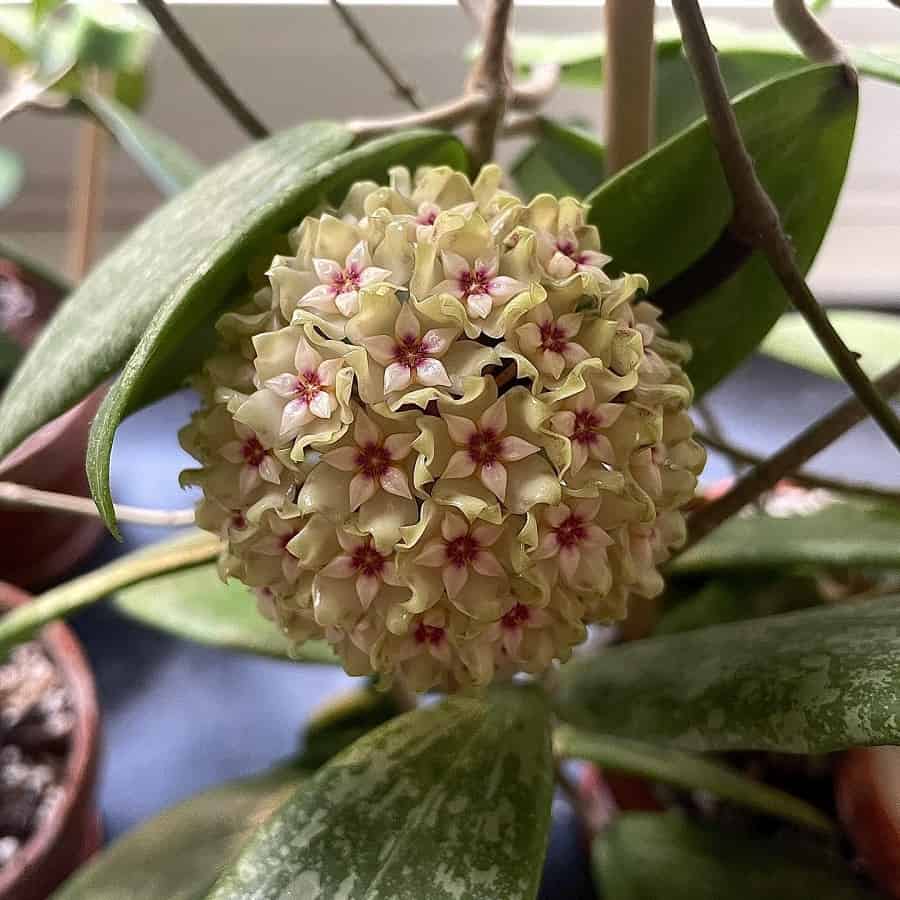
Hoya wibergiae is a unique species of Hoya, named after a renowned Swedish Hoya collector and editor-in-chief of the Hoyatelegrafen magazine of the Swedish Hoya Society. This climbing epiphyte is known for its branching and re-branching lashes and smooth stems. The leaves are opposite, oval, slightly curved and tapering with a sharp tip, with a smooth surface and rusty specks on the upper surface.
The flowers of Hoya wibergiae are star-shaped, with a velvety, glossy corolla that ranges from white to soft yellow. The crown of the flower is pale yellow with rusty red tones, creating a beautiful contrast with the corolla. Hoya wibergiae is originally from the area of the Estrella waterfall in Palawan, Philippines.
Hoya wightii
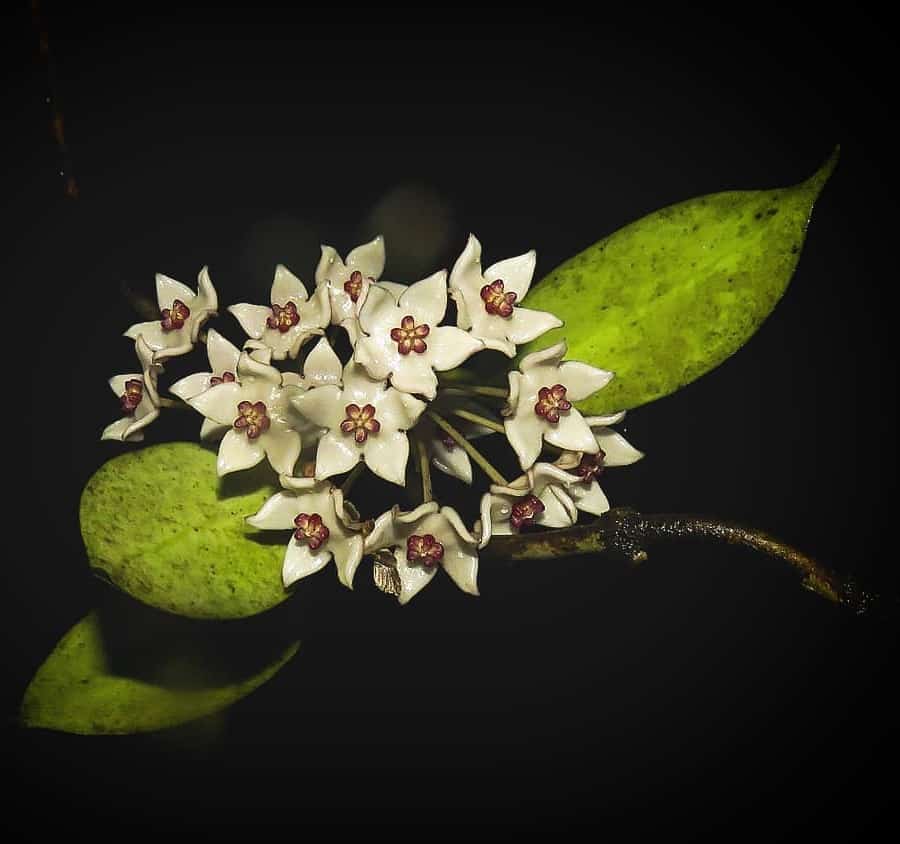
Hoya wightii is a rare and delicate hoya species that originates from India. This species is a hanging plant that grows near river streams and is threatened by habitat destruction. The leaves of Hoya wightii are oblong, glossy and have a velvety surface that’s dull green in color. The flowers of Hoya wightii are beautiful, crystal white with sharp corolla blades and a red-violet crown.
The aroma of the flowers is light and hyacinth-like, and flowering can last up to 7 days. Growing Hoya wightii can be demanding, as it requires a lot of water and high humidity, and is very sensitive to drying. This species thrives in a bright location without direct sunlight. Hoya wightii is a slow-growing species, making it even more precious.
Hoya Wilbur Graves
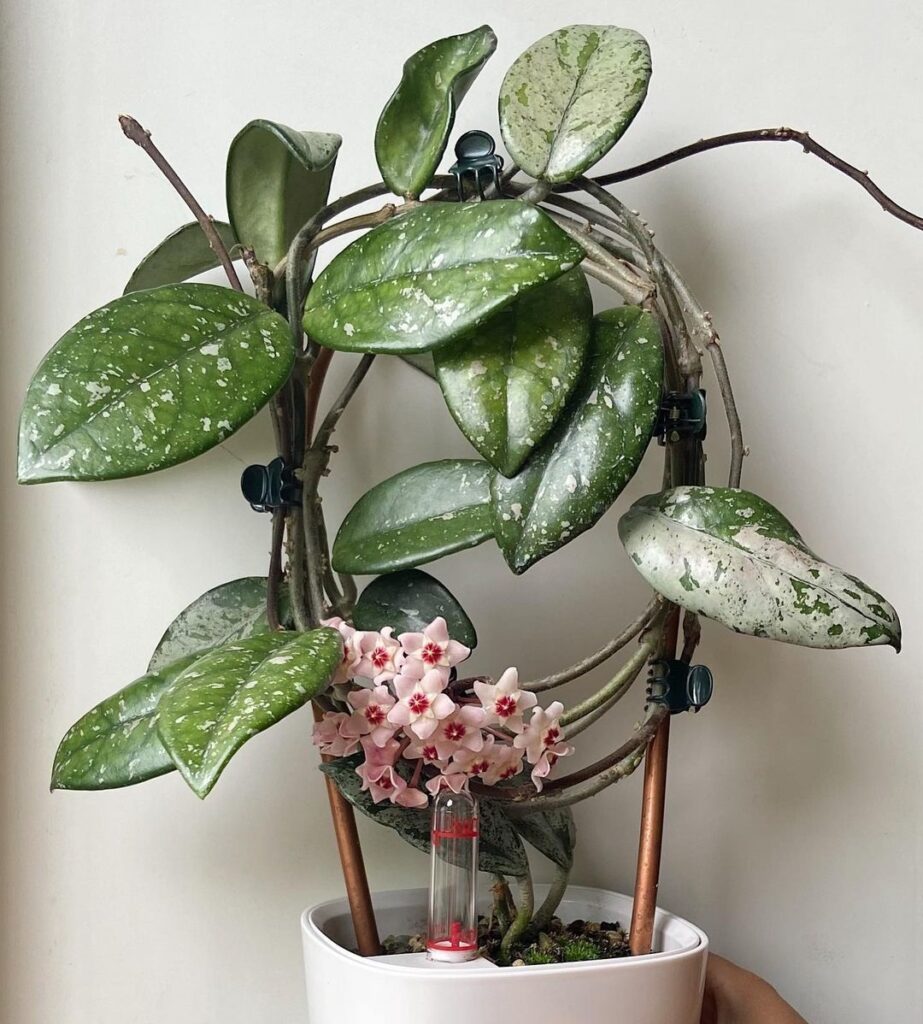
Hoya carnosa ‘Wilbur Graves’ is a popular houseplant known for its attractive foliage with silver splashes that can sometimes cover the entire leaf or split it in half. This variety can grow to be 4–6 feet tall and 2–3 feet wide, making it an impressive addition to any indoor plant collection.
Hoya wrayi
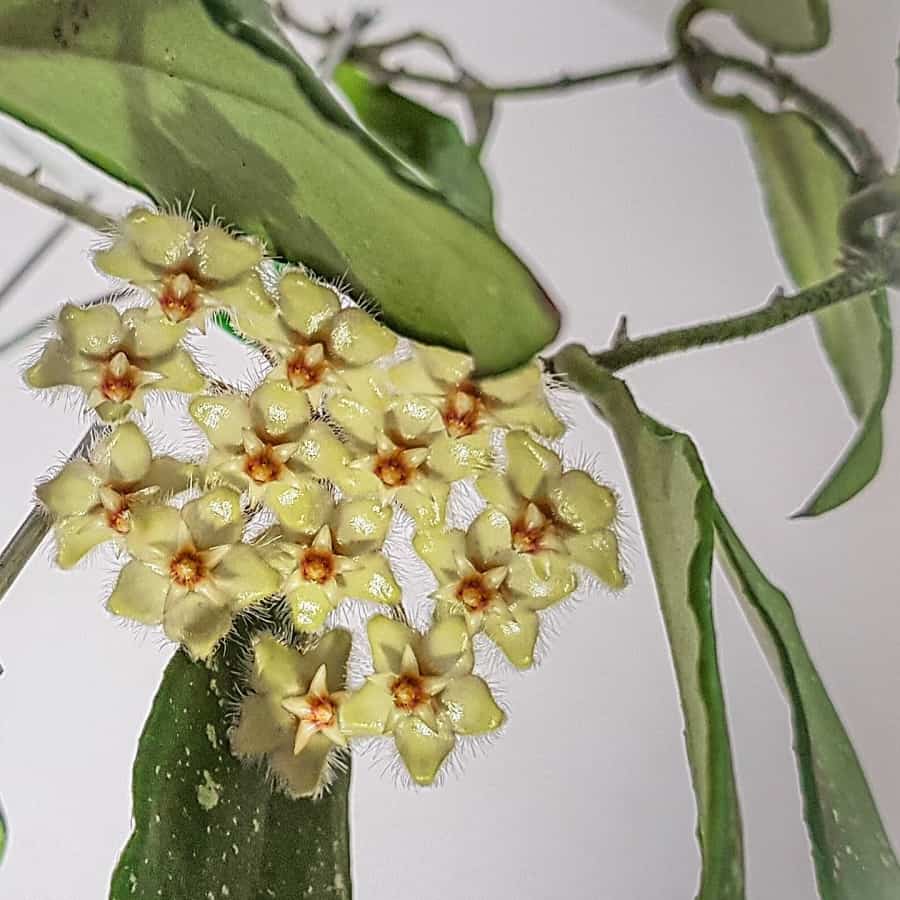
Hoya wrayi is a rare and stunning species of the Hoya genus, named in honor of collector Leonard Wray. This rare hoya is found in only two locations in Peninsular Malaysia, and grows in mountainous forests as an epiphytic liana. Hoya wrayi produces 2-4 smooth, fleshy leaves per node and has downward-growing, hairy flowers in a flat umbel that can last for 4 days. These greenish-cream or pale pink flowers are unique and highly sought after by collectors.
However, as a rare and restricted species, Hoya wrayi is highly vulnerable to habitat destruction and it is important to protect the areas where it grows to preserve this beautiful variety and its ecosystem.
Hoya Xiaojie 001
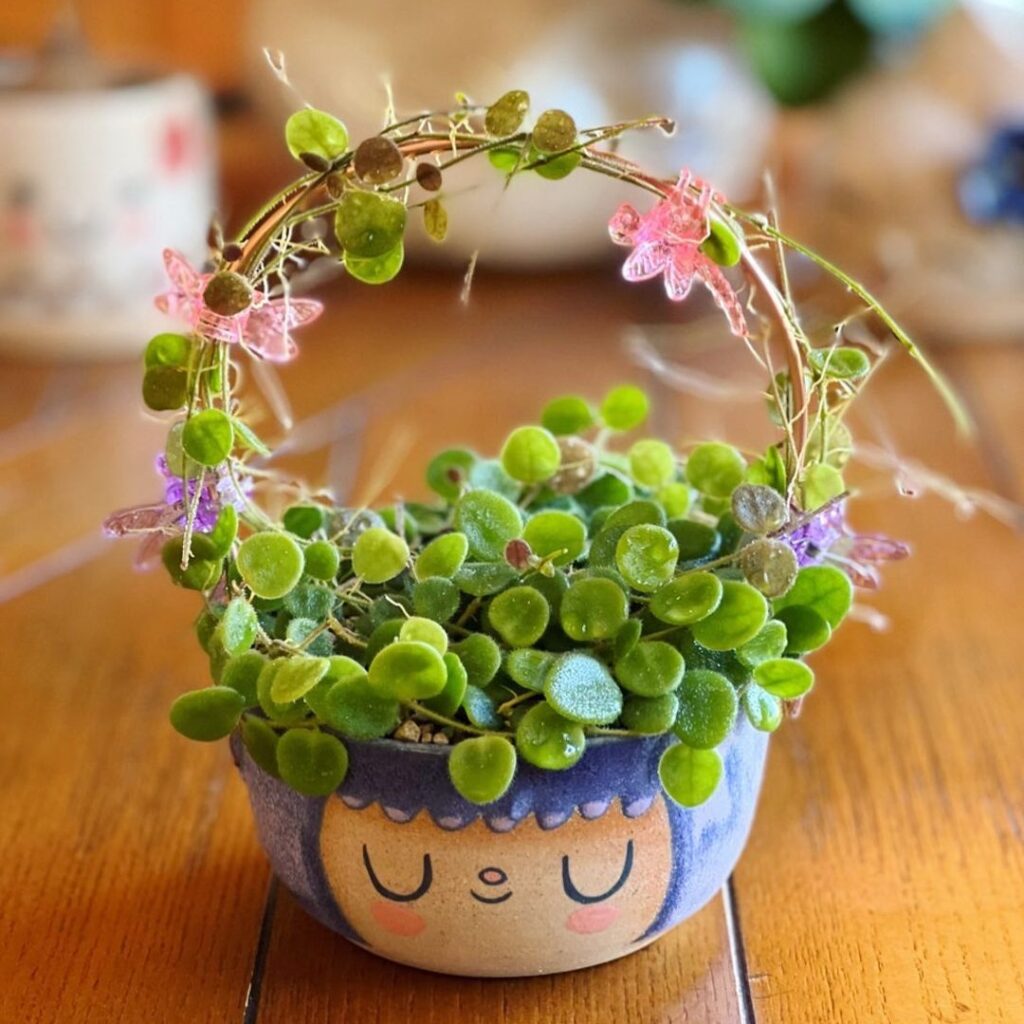
Hoya aff. serpens (Xiaojie 001) is an easy-to-grow clone of Hoya serpens.
Hoya yingjiangensis
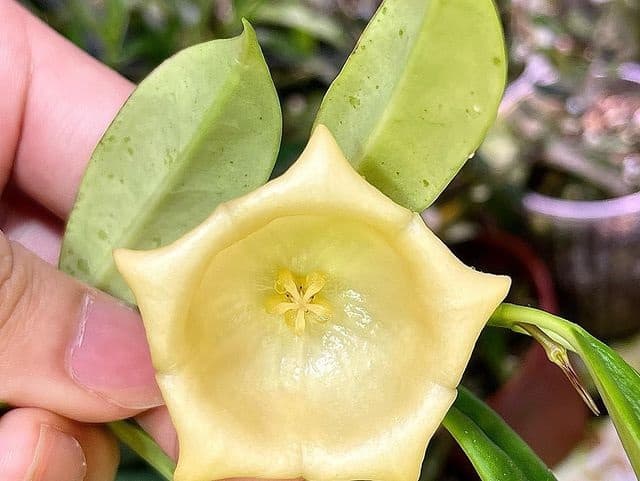
Hoya yingjiangensis is a rare and unique species of hoya named after its habitat, Yingjiang Xian, in China. This species is a shrubby epiphyte that can form dense thickets, with stems that can reach up to 1.2 meters in length. The leaves are obovate, finely serrated, and have a fleshy, succulent texture with a smooth green color.
This hoya produces a single, positively geotropic flower that has a creamy yellow campanulate corolla and a small white crown. Hoya yingjiangensis is known for its delicate beauty and is in bloom from mid-August to late September.
Hoya yuennanensis
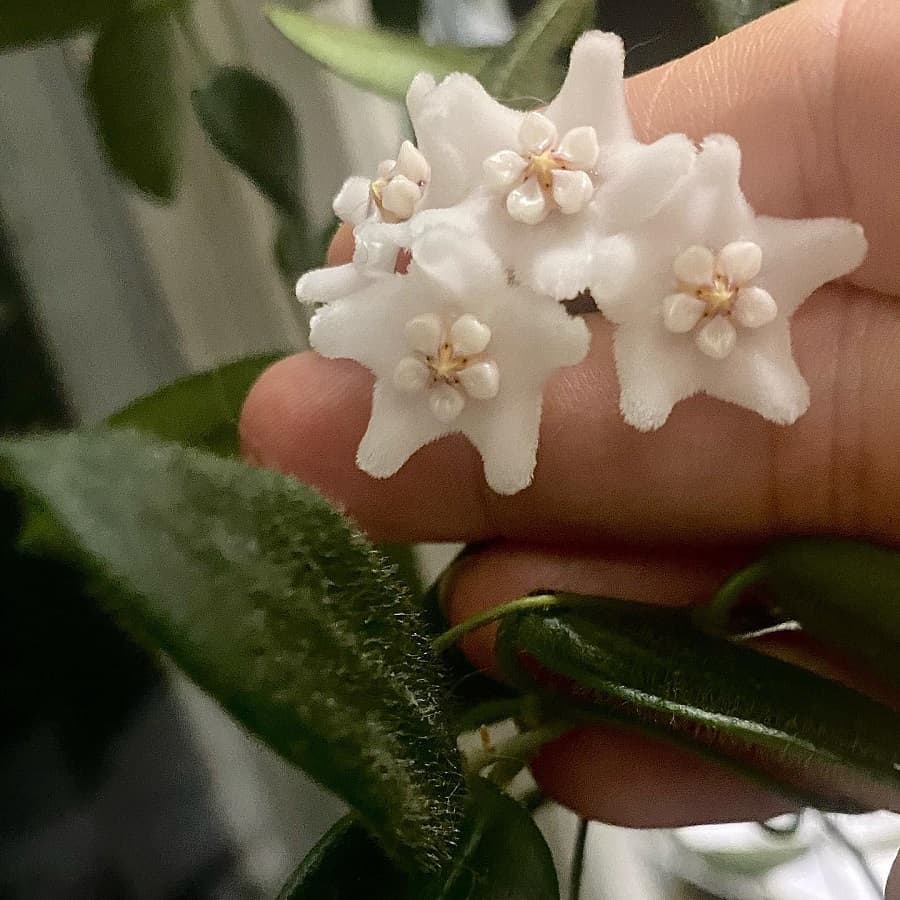
Hoya yuennanensis is a unique and stunning plant that thrives on rocky outcrops, either clinging to its surface as a lithophyte or climbing up. With its distinctive oval or oblanceolate leaves measuring 6-13 cm in length and 4-5 cm in width, it stands out with its intricate network of 7 pairs of secondary veins extending from the main vein.
In the summer, Hoya yuennanensis puts on a stunning show with its convex flower umbrellas, showcasing up to 8 individual flowers with a diameter of 1.7 – 1.9 cm. The corolla of the flowers are stellate, slightly convex and have a beautiful color transition from white to pale pink. The corolla blades are covered in soft hairs, and the ivory crown adds to the beauty of the flower. Overall, Hoya yuennanensis is a must-see for any plant enthusiast or collector.
Hoya yvesrocheri

Hoya yvesrocheri is a rare and unique species of Hoya native to the Morobe region of Papua New Guinea. This species is a thin vine that produces white latex in all its plant parts and has greenish-brown cylindrical lashes. The leaves are linear and leathery, with a pinnate venation that is barely visible. The inflorescences produce 1-8 flowers at different stages of development, with only 1 or 2 flowers opening at the same time. The corolla of the flowers is white and slightly tinged with pink or purple, and has triangular, pubescent blades.
Hoya yvesrocheri is named after the Yves Rocher Foundation, which supported the authors’ first Hoya Project for five years. This species is limited to altitudes between 700 and 1300 meters and its habitat has been largely destroyed by deforestation for expanding orchards, making it unlikely to thrive in its former range.
Hoya Zambales

Hoya Zambales, also known as Hoya wayetti mini, Hoya kentiana mini, PG04, and Hoya sp. EPC-319, is a rare and remarkable plant native to the lush Zambales region of Luzon Island, Philippines. This petite species is prized by collectors for its thick, elongated, and slightly oval leaves with darker margins, making it a charming addition to any indoor garden. It produces beautiful clusters of star-shaped flowers that emit a subtle caramel fragrance, enhancing its aesthetic appeal. Its rarity and elusiveness make it a highly sought-after gem for plant enthusiasts.
